This document provides an overview of preliminary topological concepts needed for applied mathematics. It defines topological spaces and metric spaces, and introduces key topological notions like open and closed sets, bases for topologies, convergence of sequences, accumulation points, interior and closure of sets, and dense sets. Metric spaces are shown to induce a natural topological structure, though not all topologies come from a metric. Examples are provided to illustrate various definitions and properties.
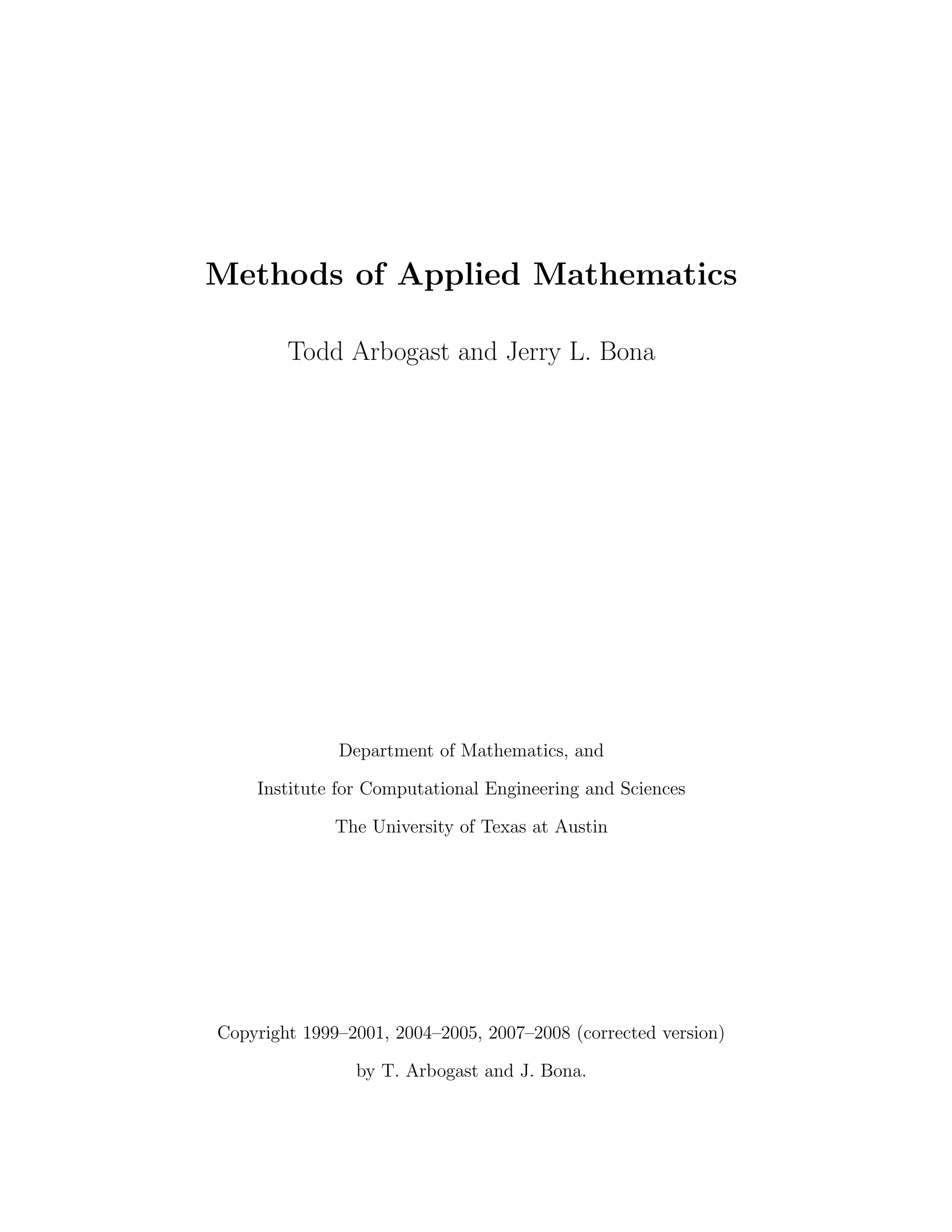



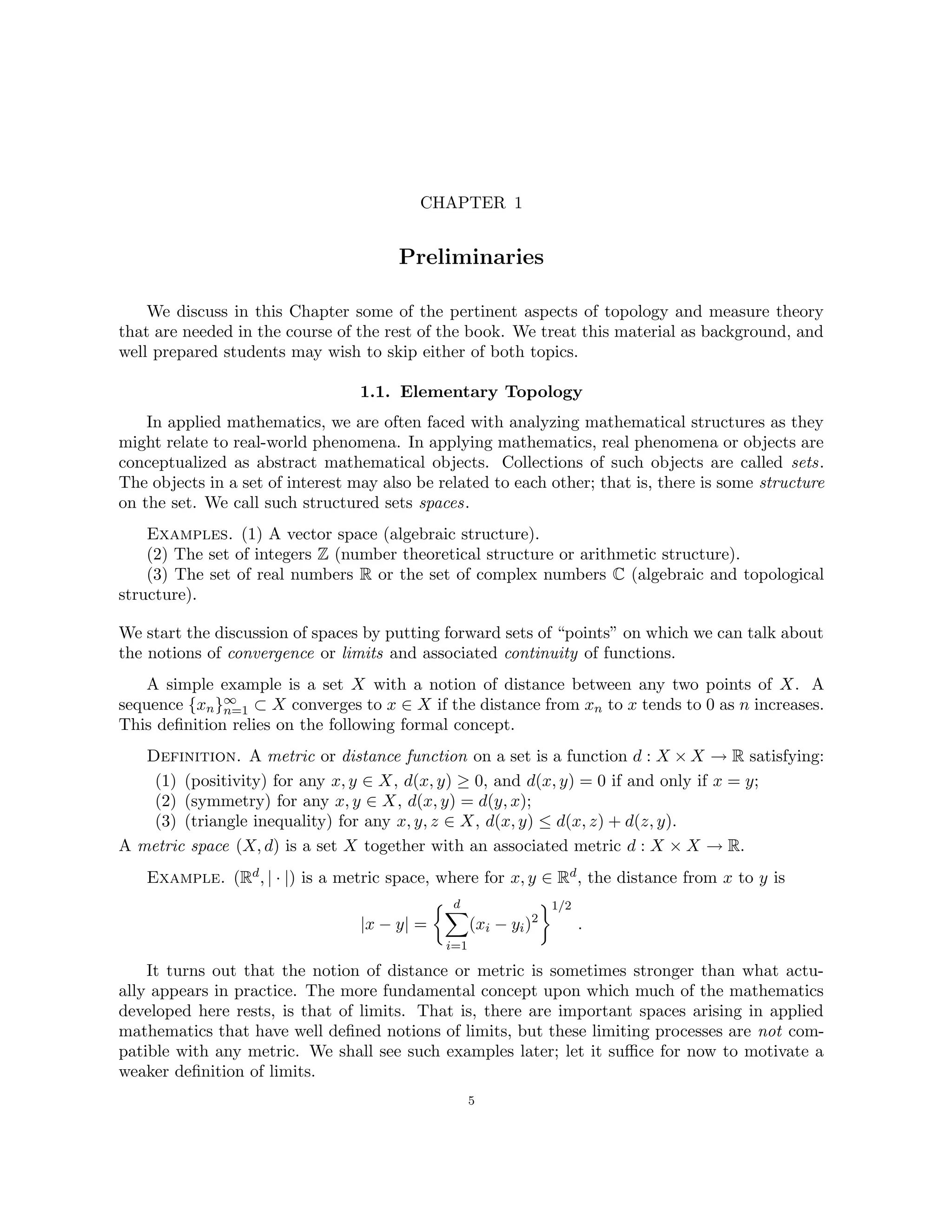
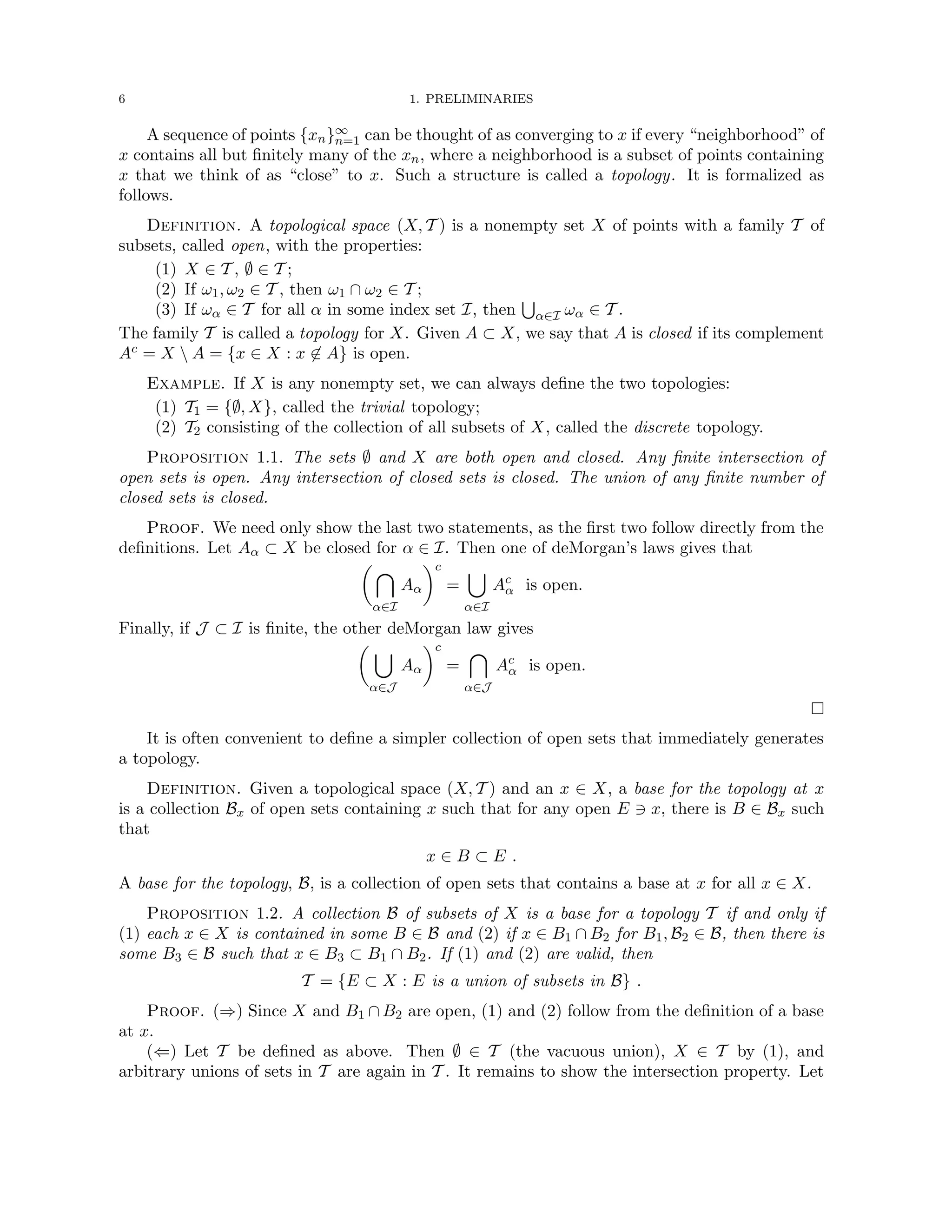
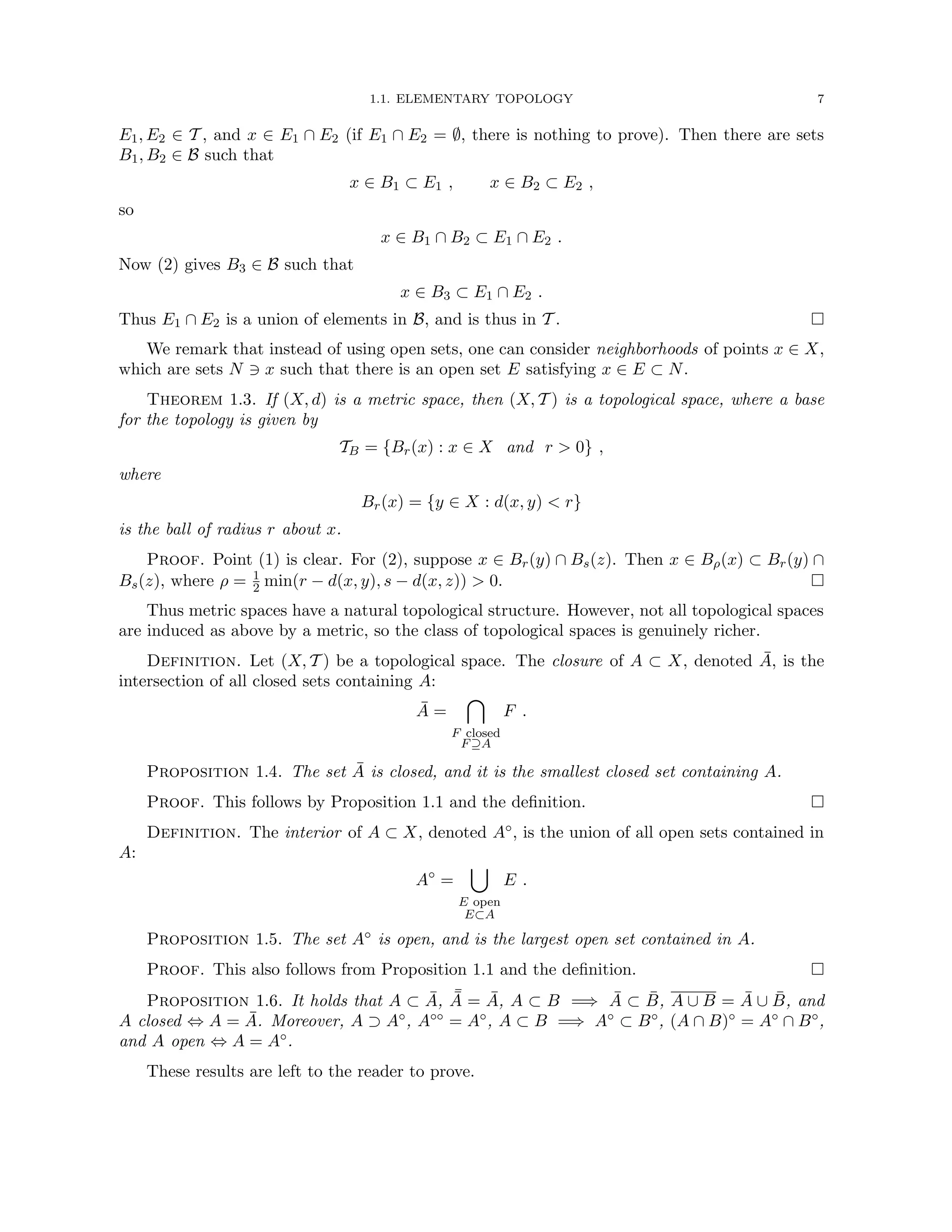
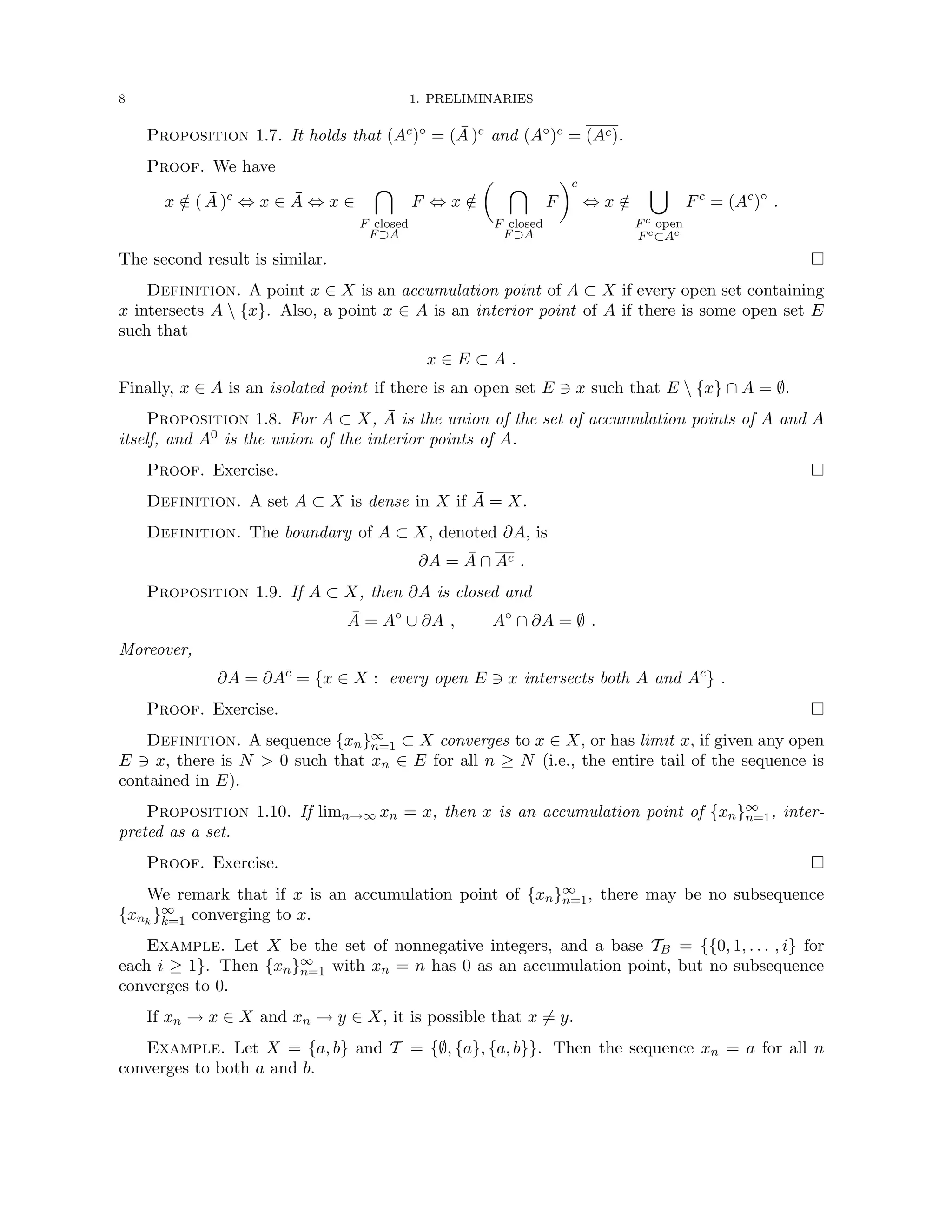
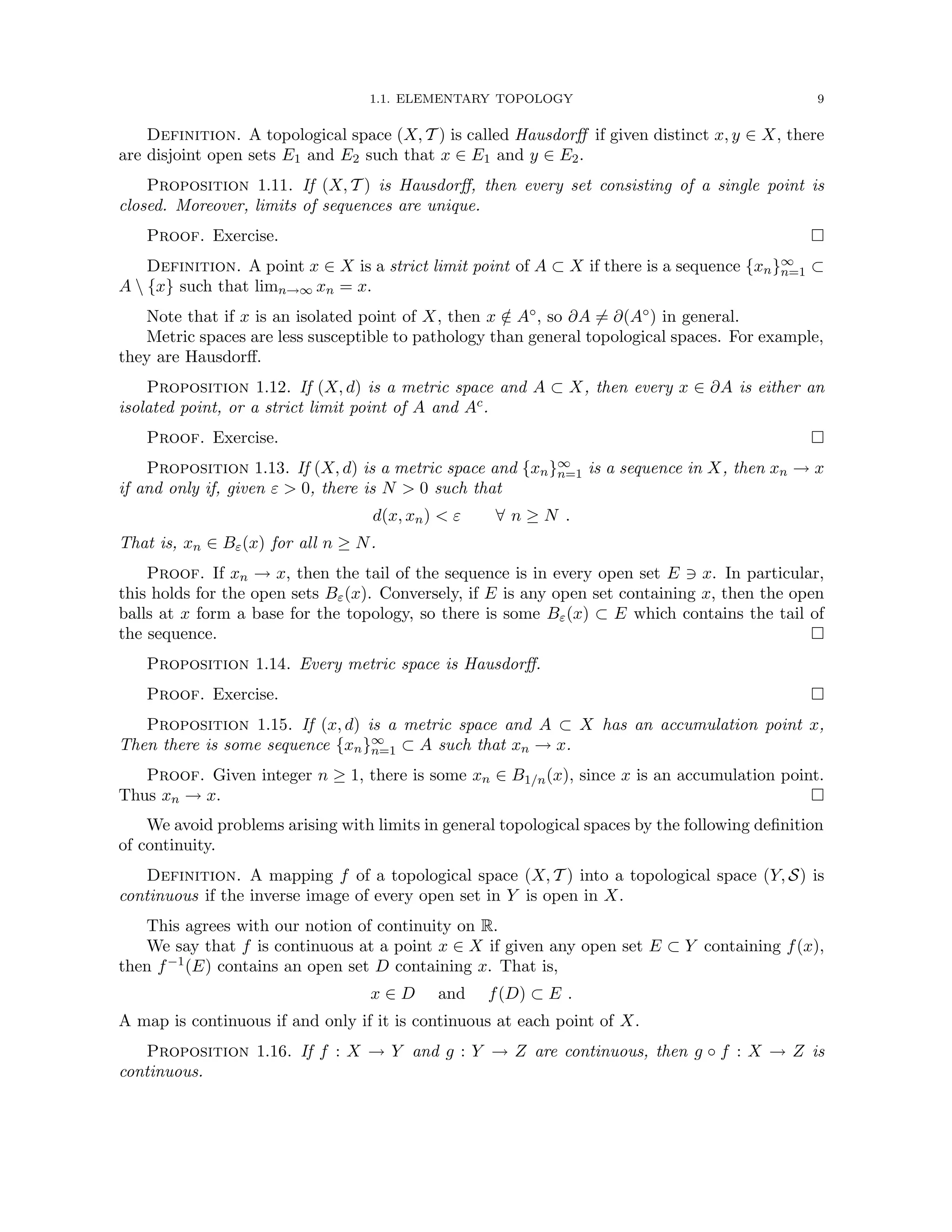

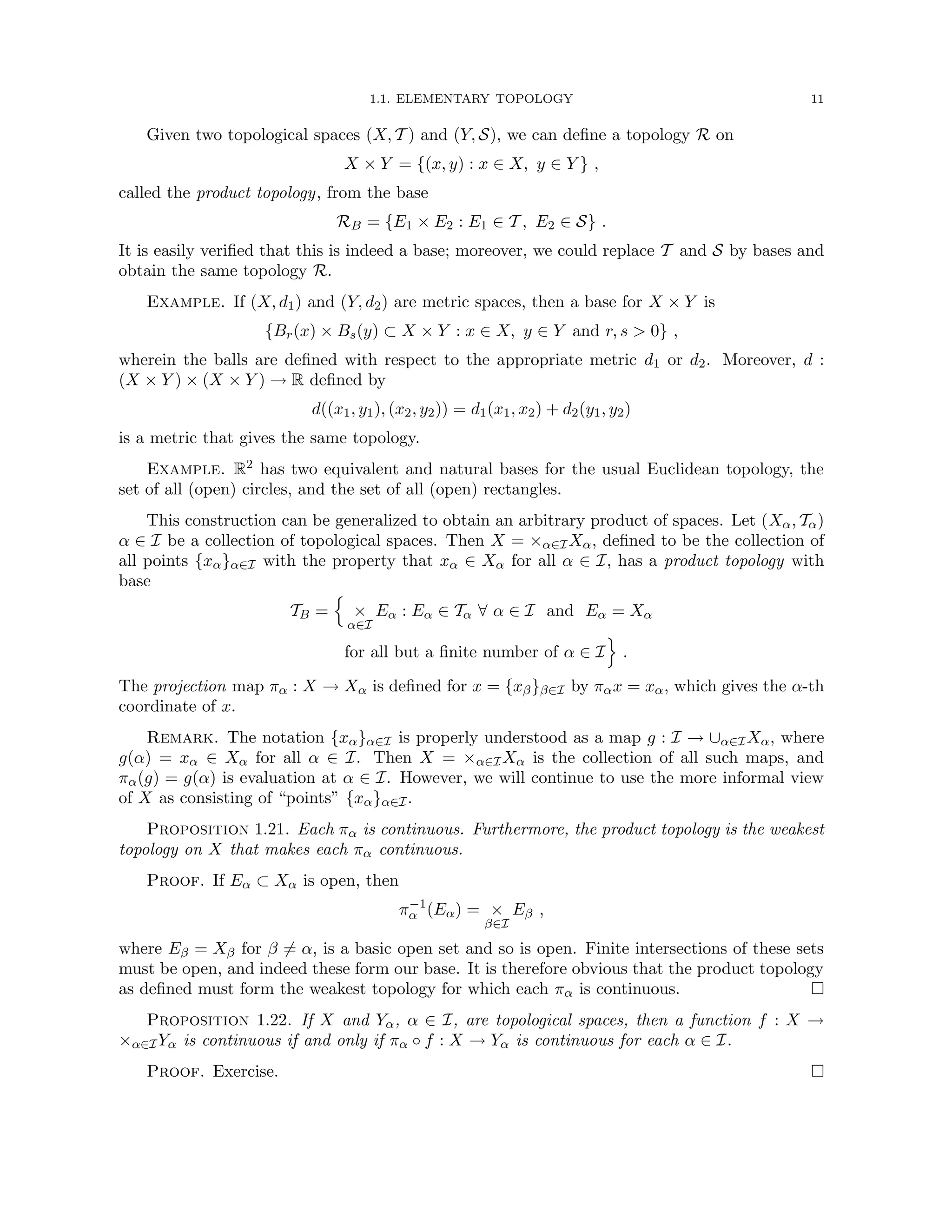
![12 1. PRELIMINARIES
Proposition 1.23. If X is Hausdorff and A ⊂ X, then A is Hausdorff (in the inherited
topology). If {Xα}α∈I are Hausdorff, then ×α∈IXα is Hausdorff (in the product topology).
Proof. Exercise.
Most topologies of interest have an infinite number of open sets. For such spaces, it is often
difficult to draw conclusions. However, there is an important class of topological space with a
finiteness property.
Definition. Let (X, T ) be a topological space and A ⊂ X. A collection {Eα}α∈I ⊂ T is
called an open cover of A if A ⊂
S
α∈I Eα. If every open cover of A contains a finite subcover
(i.e., the collection {Eα} can be reduced to a finite number of open sets that still cover A), then
A is called compact.
An interesting point arises right away: Does the compactness of A depend upon the way it is
a subset of X? Another way to ask this is, if A $ X is compact, is A compact when it is viewed
as a subset of itself? That is, (A, T ∩A) is a topological space, and A ⊂ A, so is A also compact
in this context? What about the converse? If A is compact in itself, is A compact in X? It is
easy to verify that both these questions are answered in the affirmative. Thus compactness is a
property of a set, independent of some larger space in which it may live.
The Heine-Borel Theorem states that every closed and bounded subset of Rd is compact,
and conversely. The proof is technical and can be found in most introductory books on real
analysis (such as the one by Royden [Roy] or Rudin [Ru0]).
Proposition 1.24. A closed subset of a compact space is compact. A compact subset of a
Hausdorff space is closed.
Proof. Let X be compact, and F ⊂ X closed. If {Eα}α∈I is an open cover of F, then
{Eα}α∈I ∪ Fc is an open cover of X. By compactness, there is a finite subcover {Eα}α∈J ∪ Fc.
But then {Eα}α∈J covers F, so F is compact.
Suppose X is Hausdorff and K ⊂ X is compact. (We write K ⊂⊂ X in this case, and read
it as “K compactly contained in X.”) We claim that Kc is open. Fix y ∈ Kc. For each x ∈ K,
there are open sets Ex and Gx such that x ∈ Ex, y ∈ Gx, and Ex ∩Gx = ∅, since X is Hausdorff.
The sets {Ex}x∈K form an open cover of K, so a finite subcollection {Ex}x∈A still covers K.
Thus
G =
x∈A
Gx
is open, contains y, and does not intersect K. Since y is arbitrary, Kc is open and therefore K
closed.
Proposition 1.25. The continuous image of a compact set is compact.
Proof. Exercise.
An amazing fact about compact spaces is contained in the following theorem. Its proof can
be found in most introductory texts in analysis or topology (see [Roy], [Ru1]).
Theorem 1.26 (Tychonoff). Let {Xα}α∈I be an indexed family of compact topological spaces.
Then the product space X = ×α∈IXα is compact in the product topology.
A common way to use compactness in metric spaces is contained in the following result,
which also characterizes compactness.](https://image.slidesharecdn.com/appliedmathematicsmethods-230215152718-28efe5ed/75/applied-mathematics-methods-pdf-12-2048.jpg)
![1.2. LEBESGUE MEASURE AND INTEGRATION 13
Proposition 1.27. Suppose (X, d) is a metric space. Then X is compact if and only if
every sequence {xn}∞
n=1 ⊂ X has a subsequence {xnk
}∞
k=1 which converges in X.
Proof. Suppose X is compact, but that there is a sequence with no convergent subsequence.
For each n, let
δn = inf
m6=n
d(xn, xm) .
If, for some n, δn = 0, then there are xmk
such that
d(xn, xmk
)
1
k
,
that is, xmk
→ xn as k → ∞, a contradiction. So δn 0 ∀ n, and
n
Bδn (xn)
o∞
n=1
∪
∞
[
n=1
Bδn/2
(xn)
c
is an open cover of X with no finite subcover, contradicting the compactness of X and estab-
lishing the forward implication.
Suppose now that every sequence in X has a convergent subsequence. Let {Uα}α∈I be a
minimal open cover of X. By this we mean that no Uα may be removed from the collection if
it is to remain a cover of X. Thus for each α ∈ I, ∃ xα ∈ X such that xα ∈ Uα but xα /
∈ Uβ
∀ β 6= α. If I is infinite, we can choose αn ∈ I for n = 1, 2, . . . and a subsequence that converges:
xαnk
→ x ∈ X as k → ∞ .
Now x ∈ Uγ for some γ ∈ I. But then ∃ N 0 such that for all k ≥ N, xαnk
∈ Uγ, a
contradiction. Thus any minimal open cover is finite, and so X is compact.
1.2. Lebesgue Measure and Integration
The Riemann integral is quite satisfactory for continuous functions, or functions with not
too many discontinuities, defined on bounded subsets of Rd; however, it is not so satisfactory
for discontinuous functions, nor can it be easily generalized to functions defined on sets outside
Rd, such as probability spaces. Measure theory resolves these difficulties. It seeks to measure
the size of relatively arbitrary subsets of some set X. From such a well defined notion of size,
the integral can be defined. We summarize the basic theory here, but omit most of the proofs.
They can be found in most texts in real analysis (see e.g., [Roy], [Ru0], [Ru2]).
It turns out that a consistent measure of subset size cannot be defined for all subsets of a
set X. We must either modify our notion of size or restrict to only certain types of subsets. The
latter course appears a good one since, as we will see, the subsets of Rd that can be measured
include any set that can be approximated well via rectangles.
Definition. A collection A of subsets of a set X is called a σ-algebra on X if
i) X ∈ A;
ii) whenever A ∈ A, Ac ∈ A;
iii) whenever An ∈ A for n = 1, 2, 3, . . . (i.e., countably many An), then also
S∞
n=1 An ∈ A.
Proposition 1.28.
i) ∅ ∈ A.
ii) If An ∈ A for n = 1, 2, . . . , then
T∞
n=1 An ∈ A.
iii) If A, B ∈ A, then A B = A ∩ Bc ∈ A.](https://image.slidesharecdn.com/appliedmathematicsmethods-230215152718-28efe5ed/75/applied-mathematics-methods-pdf-13-2048.jpg)
![14 1. PRELIMINARIES
Proof. Exercise.
Definition. By a measure on A, we mean a countable additive function µ : A → R, where
either R = [0, +∞], giving a positive measure (as long as µ 6≡ +∞), or R = C, giving a complex
measure. Countably additive means that if An ∈ A for n = 1, 2, . . . , and Ai ∩ Aj = ∅ for i 6= j,
then
µ
∞
[
n=1
An
=
∞
X
n=1
µ(An) .
That is, the size or measure of a set is the sum of the measures of countably many disjoint pieces
of the set that fill it up.
Proposition 1.29.
i) µ(∅) = 0.
ii) If An ∈ A, n = 1, 2, . . . , N are pairwise disjoint, then
µ
N
[
n=1
An
=
N
X
n=1
µ(An) .
iii) If µ is a positive measure and A, B ∈ A with A ⊂ B, then
µ(A) ≤ µ(B) .
iv) If An ∈ A, n = 1, 2, . . . , and An ⊂ An+1 for all n, then
µ
∞
[
n=1
An
= lim
n→∞
µ(An) .
v) If An ∈ A, n = 1, 2, . . . , µ(A1) ∞, and An ⊇ An+1 for all n, then
µ
∞
n=1
An
= lim
n→∞
µ(An) .
Proof. i) Since µ 6≡ +∞, there is A ∈ A such that µ(A) is finite. Now A = A ∪
S∞
i=1 ∅,
and these sets are pairwise disjoint, so µ(A) = µ(A) +
P∞
i=1 µ(∅). Thus µ(∅) = 0.
ii) Let An = ∅ for n N. Then
µ
N
[
n=1
An
= µ
∞
[
n=1
An
=
∞
X
n=1
µ(An) =
N
X
n=1
µ(An) .
iii) Let C = B A. Then C ∩ A = ∅, so
µ(A) + µ(C) = µ(C ∪ A) = µ(B) ,
and µ(C) ≥ 0 gives the result.
iv) Let B1 = A1 and Bn = An An−1 for n ≥ 2. Then the {Bn} are pairwise disjoint, and,
for any N ≤ ∞,
AN =
N
[
n=1
An =
N
[
n=1
Bn ,](https://image.slidesharecdn.com/appliedmathematicsmethods-230215152718-28efe5ed/75/applied-mathematics-methods-pdf-14-2048.jpg)
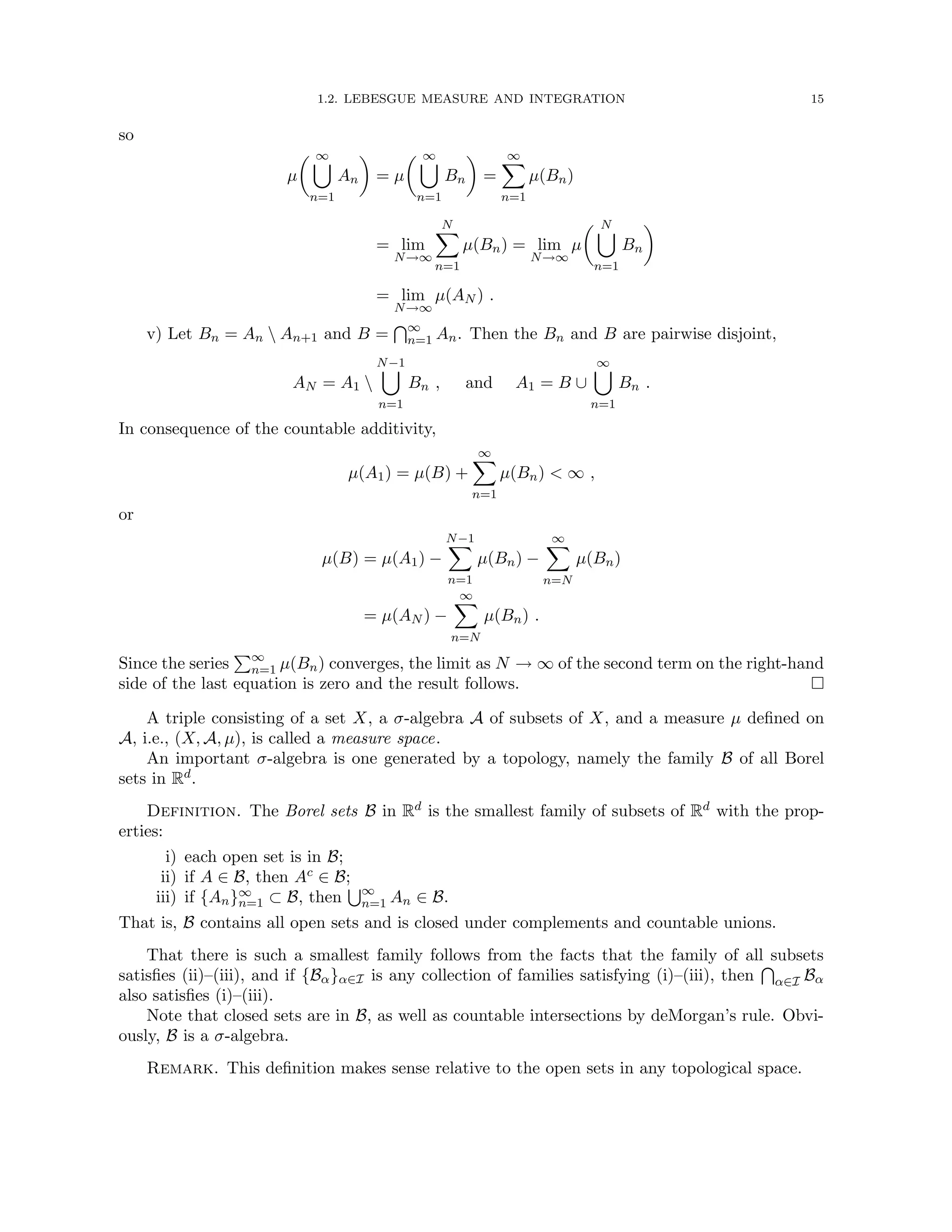
![16 1. PRELIMINARIES
Theorem 1.30. There exists a unique positive measure µ, called Lebesgue measure, defined
on the Borel sets B of Rd, having the properties that if A ⊂ B is a rectangle, i.e., there are
numbers ai and bi such that
A = {x ∈ Rd
: ai xi or ai ≤ xi and xi bi or xi ≤ bi ∀ i} ,
then µ(A) =
Qd
i=1(bi −ai) and µ is translation invariant, which means that if x ∈ Rd and A ∈ B,
then
µ(x + A) = µ(A) ,
where x + A = {y ∈ Rd : y = x + z for some z ∈ A} ∈ B.
The construction of Lebesgue measure is somewhat tedious, and can be found in most texts
in real analysis (see, e.g., [Roy], [Ru0], [Ru2]). Note that an interesting point arising in this
theorem is to determine why x + A ∈ B if A ∈ B. This follows since the mapping f(y) = y + x
is a homeomorphism of Rd onto Rd, and hence preserves the open sets which generate the Borel
sets.
A dilemma arises. If A ∈ B is such that µ(A) = 0, we say A is a set of measure zero. As
an example, a (d − 1)-dimensional hyperplane has d-dimensional measure zero. If we intersect
the hyperplane with A ⊂ Rd, the measure should be zero; however, such an intersection may
not be a Borel set. We would like to say that if µ(A) = 0 and B ⊂ A, then µ applies to B and
µ(B) = 0.
Let the sets of measure zero be
Z = {A ⊂ Rd
: ∃ B ∈ B with µ(B) = 0 and A ⊂ B} ,
and define the Lebesgue measurable sets M to be
M = {A ⊂ Rd
: ∃ B ∈ B, Z1, Z2 ∈ Z such that A = (B ∪ Z1) Z2} .
We leave it to the reader to verify that M is a σ-algebra.
Next extend µ : M → [0, ∞] by
µ(A) = µ(B)
where A = (B ∪ Z1) Z2 for some B ∈ B and Z1, Z2 ∈ Z. That this definition is independent
of the decomposition is easily verified, since µ|Z = 0.
Thus we have
Theorem 1.31. There exists a σ-algebra M of subsets of Rd and a positive measure µ :
M → [0, ∞] satisfying the following.
i) Every open set in Rd is in M.
ii) If A ⊂ B ∈ M and µ(B) = 0, then A ∈ M and µ(A) = 0.
iii) If A is a rectangle with xi bounded between ai and bi, then µ(A) =
Qd
i=1(bi − ai).
iv) µ is translation invariant: if x ∈ Rd, A ∈ M, then x + A ∈ M and µ(A) = µ(x + A).
Sets outside M exist, and are called unmeasurable or non-measurable sets. We shall not
meet any in this course. Moreover, for practical purposes, we might simply restrict M to B in
the following theory with only minor technical differences.
We now consider functions defined on measure spaces, taking values in the extended real
number system R ≡ R ∪ {−∞, +∞}, or in C.](https://image.slidesharecdn.com/appliedmathematicsmethods-230215152718-28efe5ed/75/applied-mathematics-methods-pdf-16-2048.jpg)
![1.2. LEBESGUE MEASURE AND INTEGRATION 17
Definition. Suppose Ω ⊂ Rd is measurable. A function f : Ω → R is measurable if the
inverse image of every open set in R is measurable. A function g : Ω → C is measurable if its
real and imaginary parts are measurable.
We remark that measurability depends on M, but not on µ! It would be enough to verify
that the sets
Eα = {x ∈ Ω : f(x) α}
are measurable for all α ∈ R to conclude that f is measurable.
Theorem 1.32.
i) If f and g are measurable, so are f + g, f − g, fg, max(f, g), and min(f, g).
ii) If f is measurable and g : R → R is continuous, then g ◦ f is measurable.
iii) If f is defined on Ω ⊂ Rd, f continuous, and Ω measurable, then f is measurable.
iv) If {fn}∞
n=1 is a sequence of real, measurable functions, then
inf
n
fn , sup
n
fn , lim inf
n→∞
fn , and lim sup
n→∞
fn
are measurable functions.
The last statement above uses some important terminology. Given a nonempty set S ⊂ R
(such as S = {fn(x)}∞
n=1 for x ∈ Ω fixed), the infimum of S, denoted inf S, is the greatest
number α ∈ [−∞, +∞) such that s ≥ α for all s ∈ S. The supremum of S, sup S, is the least
number α ∈ (−∞, +∞] such that s ≤ α for all s ∈ S. Given a sequence {yn}∞
n=1 (such as
yn = fn(x) for x ∈ Ω fixed),
lim inf
n→∞
yn = sup
n≥1
inf
m≥n
ym = lim
n→∞
inf
m≥n
ym
.
Similarly,
lim sup
n→∞
yn = inf
n≥1
sup
m≥n
ym = lim
n→∞
sup
m≥n
ym
.
Corollary 1.33. If f is measurable, then so are
f+
= max(f, 0) , f−
= − min(f, 0) , and |f| .
Moreover, if {fn}∞
n=1 are measurable and converge pointwise, the limit function is measurable.
Remark. With these definitions, f = f+ − f− and |f| = f+ + f−.
Definition. If X is a set and E ⊂ X, then the function XE : X → R given by
XE(x) =
(
1 if x ∈ E ,
0 if x /
∈ E ,
is called the characteristic function of E. If s : X → R has finite range, then s is called a simple
function.
Of course, if the range of s is {c1, . . . , cn} and
Ei = {x ∈ X : s(x) = ci} ,
then
s(x) =
n
X
i=1
ciXEi (x) ,](https://image.slidesharecdn.com/appliedmathematicsmethods-230215152718-28efe5ed/75/applied-mathematics-methods-pdf-17-2048.jpg)
![18 1. PRELIMINARIES
and s is measurable if and only if each Ei is measurable.
Every function can be approximated by simple functions.
Theorem 1.34. Given any function f : Ω ⊂ Rd → R, there is a sequence {sn}∞
n=1 of simple
functions such that
lim
n→∞
sn(x) = f(x) for any x ∈ Ω
(i.e., sn converges pointwise to f). If f is measurable, the {sn} can be chosen measurable.
Moreover, if f is bounded, {sn} can be chosen so that the convergence is uniform. If f ≥ 0, then
the {sn} may be chosen to be monotonically increasing at each point.
Proof. If f ≥ 0, define for n = 1, 2, . . . and i = 1, 2, . . . , n2n,
En,i =
x ∈ Ω :
i − 1
2n
≤ f(x)
i
2n
,
Fn = {x ∈ Ω : f(x) ≥ n} .
Then
sn(x) =
n2n
X
i=1
i − 1
2n
XEn,i (x) + nXFn
has the desired properties. In the general case, let f = f+ − f− and approximate f+ and f− as
above.
It is now straightforward to define the Lebesgue integral. Let Ω ⊂ Rd be measurable and
s : Ω → R be a measurable simple function given as
s(x) =
n
X
i=1
ciXEi (x) .
Then we define the Lebesgue integral of s over Ω to be
Z
Ω
s(x) dx =
n
X
i=1
ciµ(Ei) .
If f : Ω → [0, ∞] is measurable, we define
Z
Ω
f(x) dx = sup
s
Z
Ω
s(x) dx ,
where the supremum is taken over all measurable functions satisfying 0 ≤ s(x) ≤ f(x) for x ∈ Ω.
Note that the integral of f may be +∞.
If f is measurable and real-valued, then f = f+ − f−, where f+ ≥ 0 and f− ≥ 0. In this
case, define
Z
Ω
f(x) dx =
Z
Ω
f+
(x) dx −
Z
Ω
f−
(x) dx ,
provided at least one of the two integrals on the right is finite.
Finally, if f is complex-valued, apply the above construction to the real and imaginary parts
of f, provided the integrals of these parts are finite.
Definition. We say that a real-valued measurable function f is integrable if the integrals
of f+ and f− are both finite. If only one is finite, then f is not integrable; however, in that case
we assign +∞ or −∞ to the integral.](https://image.slidesharecdn.com/appliedmathematicsmethods-230215152718-28efe5ed/75/applied-mathematics-methods-pdf-18-2048.jpg)
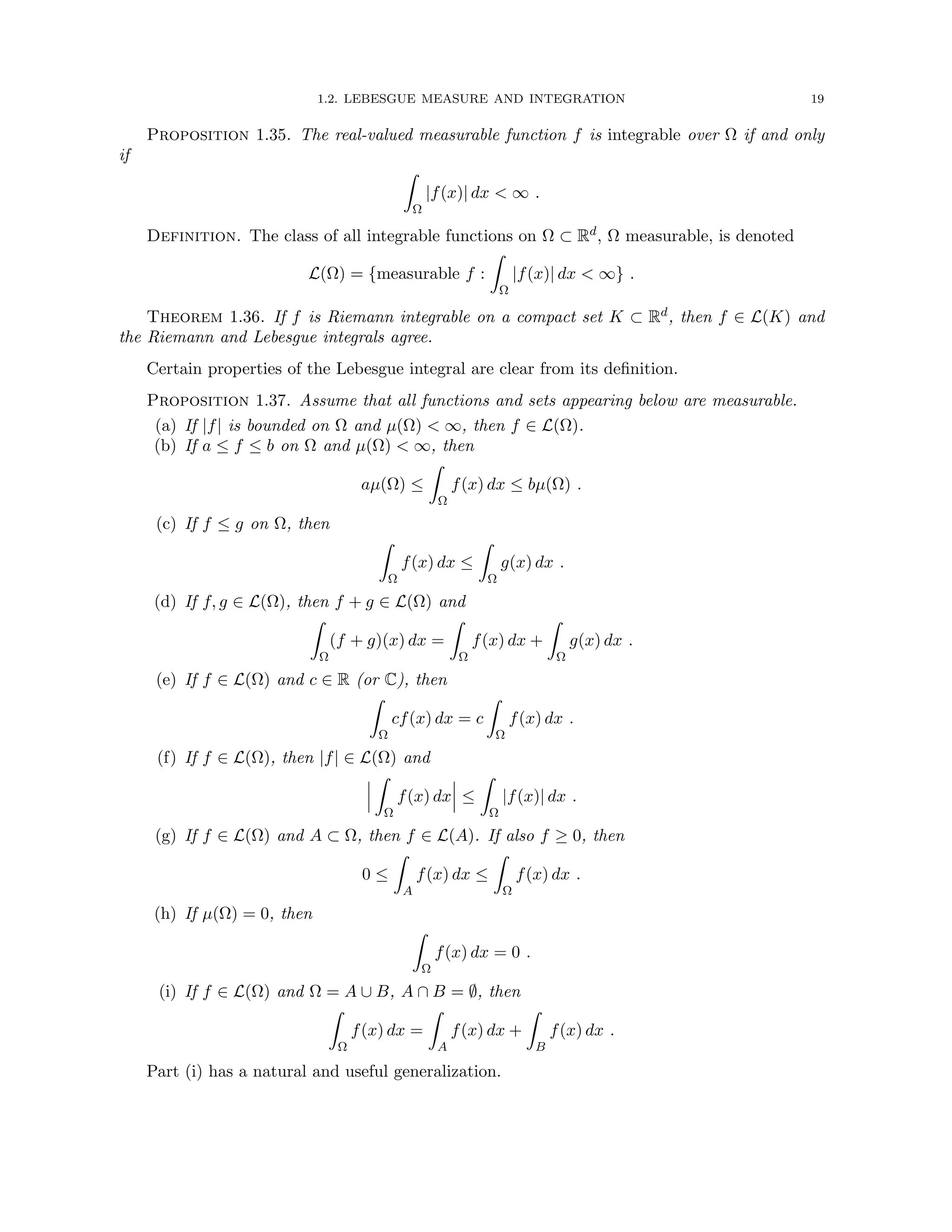
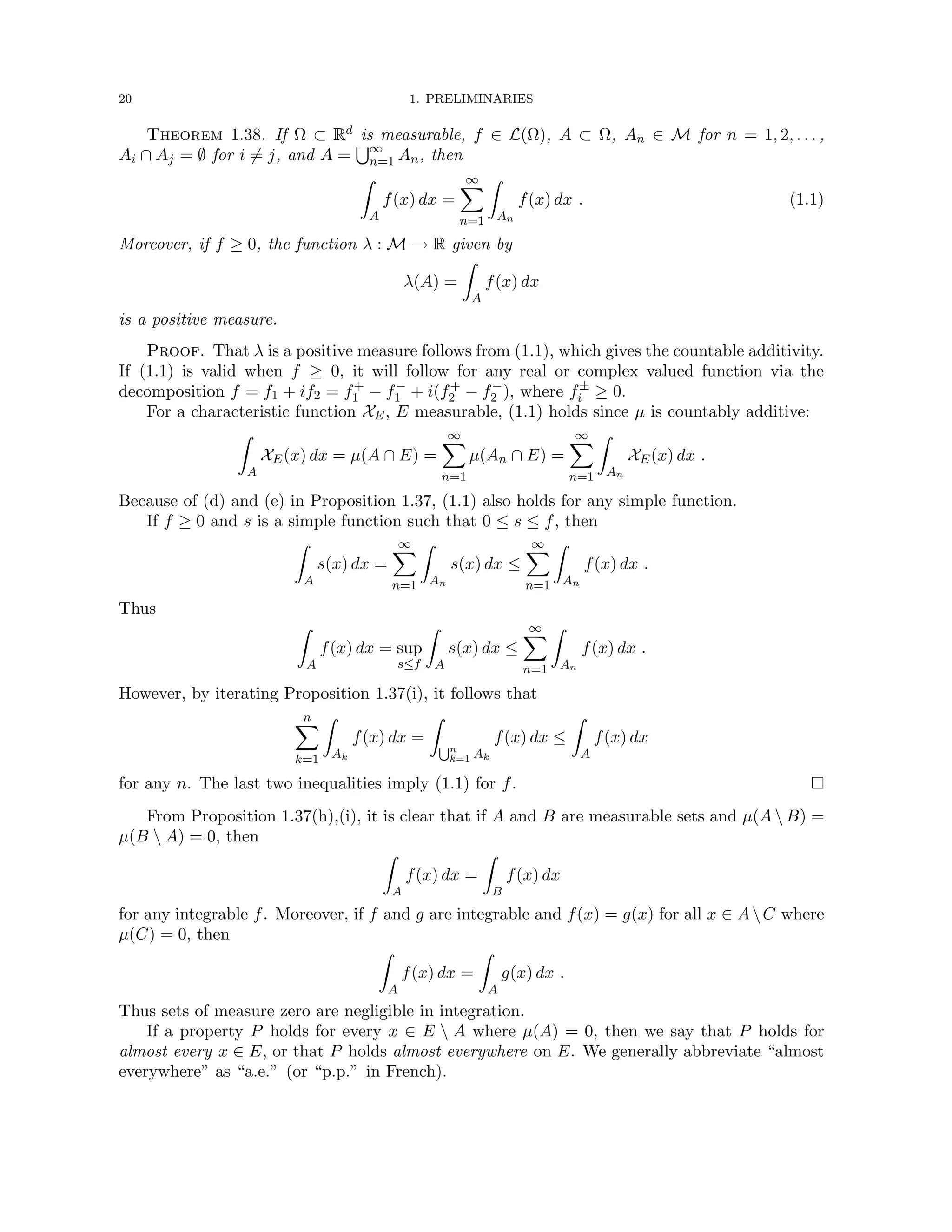
![1.2. LEBESGUE MEASURE AND INTEGRATION 21
Proposition 1.39. If f ∈ L(Ω), where Ω is measurable, and if
Z
A
f(x) dx = 0
for every measurable A ⊂ Ω, then f = 0 a.e. on Ω.
Proof. Suppose not. Decompose f as f = f1 + if2 = f+
1 − f−
1 + i(f+
2 − f−
2 ). At least one
of f±
1 , f±
2 is not zero a.e. Let g denote one such component of f. Thus g ≥ 0 and g is not zero
a.e. on Ω. However,
R
A g(x) dx = 0 for every measurable A ⊂ Ω. Let
An = {x ∈ Ω : g(x) 1/n} .
Then µ(An) = 0 ∀ n and A0 =
S∞
n=1 An = {x ∈ Ω : g(x) 0}. But µ(A0) = µ(
S∞
n=1 An) ≤
P∞
n=1 µ(An) = 0, contradicting the fact that g is not zero a.e.
We will not use the following, but it is interesting. It shows that Riemann integration is
restricted to a very narrow class of functions, whereas Lebesgue integration is much more general.
Proposition 1.40. If f is bounded on a compact set [a, b] ⊂ R, then f is Riemann integrable
on [a, b] if and only if f is continuous at a.e. point of [a, b].
The Lebesgue integral is absolutely continuous in the following sense.
Theorem 1.41. If f ∈ L(Ω), then
R
A |f| dx → 0 as µ(A) → 0, where A ⊂ Ω is measurable.
That is, given 0, there is δ 0 such that
Z
A
|f(x)| dx ≤
whenever µ(A) δ.
Proof. Given 0, there is a simple function s(x) such that
Z
A
|f(x) − s(x)| dx ≤ /2 ,
by the definitionn of the Lebesgue integral. Moreover, by the proof of the existance of s(x), we
know that we can take s(x) bounded:
|s(x)| ≤ M()
for some M(). Then on A ⊂ Ω measurable,
Z
A
|s(x)| dx ≤ µ(A)M(),
so if µ(A) δ ≡ /2M(), then
Z
A
|f(x)| dx ≤
Z
A
|f(x) − s(x)| dx +
Z
A
|s(x)| dx ≤ /2 + /2 = .
Theorem 1.34 states that we can approximate a measurable f by a sequence of simple
functions. We can go further, and approximate by a sequence of continuous functions, at least
when we control things near infinity. Let C0(Ω) be the set of continuous functions with compact
support, i.e., continuous functions that vanish outside a bounded set.](https://image.slidesharecdn.com/appliedmathematicsmethods-230215152718-28efe5ed/75/applied-mathematics-methods-pdf-21-2048.jpg)
![22 1. PRELIMINARIES
Theorem 1.42 (Lusin’s Theorem). Suppose that f is measurable on Ω is such that f(x) = 0
for x 6∈ A, where A has finite measure. Given 0, there is g ∈ C0(Ω) such that the measure
of the set where f and g differ is less than . Moreover,
sup
x∈Ω
|g(x)| ≤ sup
x∈Ω
|f(x)| .
A proof can be found in, e.g., [Ru2]. The following lemma is easily demonstrated (and left
to the reader), but it turns out to be quite useful.
Lemma 1.43 (Chebyshev’s Inequality). If f ≥ 0 and Ω ⊂ Rd are measurable, then
µ({x ∈ Ω : f(x) α}) ≤
1
α
Z
Ω
f(x) dx
for any α 0.
We conclude our overview of Lebesgue measure and integration with the three basic con-
vergence theorems, Fubini’s Theorem on integration over product spaces, and the Fundamental
Theorem of Calculus, each without proof. For the first three results, assume that Ω ⊂ Rd is
measurable.
Theorem 1.44 (Lebesgue’s Monotone Convergence Theorem). If {fn}∞
n=1 is a sequence of
measurable functions satisfying 0 ≤ f1(x) ≤ f2(x) ≤ · · · for a.e. x ∈ Ω, then
lim
n→∞
Z
Ω
fn(x) dx =
Z
Ω
lim
n→∞
fn(x)
dx .
Theorem 1.45 (Fatou’s Lemma). If {fn}∞
n=1 is a sequence of nonnegative, measurable func-
tions, then
Z
Ω
lim inf
x→∞
fn(x)
dx ≤ lim inf
n→∞
Z
Ω
fn(x) dx .
Theorem 1.46 (Lebesgue’s Dominated Convergence Theorem). Let {fn}∞
n=1 be a sequence
of measurable functions that converge pointwise for a.e. x ∈ Ω. If there is a function g ∈ L(Ω)
such that
|fn(x)| ≤ g(x) for every n and a.e. x ∈ Ω,
then
lim
n→∞
Z
Ω
fn(x) dx =
Z
Ω
lim
n→∞
fn(x)
dx .
Theorem 1.47 (Fubini’s Theorem). Let f be measurable on Rn+m. If at least one of the
integrals
I1 =
Z
Rn+m
f(x, y) dx dy ,
I2 =
Z
Rm
Z
Rn
f(x, y) dx
dy ,
I3 =
Z
Rn
Z
Rm
f(x, y) dy
dx
exists in the Lebesgue sense (i.e., when f is replaced by |f|) and is finite, then each exists and
I1 = I2 = I3.](https://image.slidesharecdn.com/appliedmathematicsmethods-230215152718-28efe5ed/75/applied-mathematics-methods-pdf-22-2048.jpg)
![1.3. EXERCISES 23
Note that in Fubini’s Theorem, the claim is that the following are equivalent:
(i) f ∈ L(Rn+m),
(ii) f(·, y) ∈ L(Rn) for a.e. y ∈ Rm and
R
Rn f(x, ·) dx ∈ L(Rm),
(iii) f(x, ·) ∈ L(Rm) for a.e. x ∈ Rn and
R
Rm f(·, y) dy ∈ L(Rn),
and the three full integrals agree. Among other things, f being measurable on Rn+m implies
that f(·, y) is measurable for a.e. y ∈ Rm and f(x, ·) is measurable for a.e. x ∈ Rn. Note also
that we cannot possibly claim anything about every x ∈ Rn and/or y ∈ Rm, but only about
almost every point.
Theorem 1.48 (Fundamental Theorem of Calculus). If f ∈ L([a, b]) and
F(x) =
Z x
a
f(t) dt ,
then F0(x) = f(x) for a.e. x ∈ [a, b]. Conversely, if F is differentiable everywhere (not a.e.!) on
[a, b] and F0 ∈ L([a, b]), then
F(x) − F(a) =
Z x
a
F0
(t) dt
for any x ∈ [a, b].
1.3. Exercises
1. Show that the following define a topology T on X, where X is any nonempty set.
(a) T = {∅, X}. This is called the trivial topology on X.
(b) TB = {{x} : x ∈ X} is a base. This is called the discrete topology on X.
(c) Let T consist of ∅ and all subsets of X with finite complements. If X is finite, what
topology is this?
2. Let X = {a, b} and T = {∅, {a}, X}. Show directly that there is no metric d : X × X → R
that is compatible with the topology. Thus not every topological space is metrizable.
3. Prove that if A ⊂ X, then ∂A is closed and
Ā = A◦
∪ ∂A , A◦
∩ ∂A = ∅ .
Moreover,
∂A = ∂Ac
= {x ∈ X : every open E containing x intersects both A and Ac
} .
4. Prove that if (X, T ) is Hausdorff, then every set consisting of a single point is closed. More-
over, limits of sequences are unique.
5. Prove that a set A ⊂ X is open if and only if, given x ∈ A, there is an open E such that
x ∈ E ⊂ A.
6. Prove that a mapping of X into Y is continuous if and only if the inverse image of every
closed set is closed.
7. Prove that if f is continuous and lim
n→∞
xn = x, then lim
n→∞
f(xn) = f(x).
8. Suppose that f(x) = y. Let Bx be a base at x ∈ X, and C a base at y ∈ Y . Prove that f is
continuous at x if and only if for each C ∈ Cy there is a B ∈ Bx such that B ⊂ f−1(C).
9. Show that every metric space is Hausdorff.](https://image.slidesharecdn.com/appliedmathematicsmethods-230215152718-28efe5ed/75/applied-mathematics-methods-pdf-23-2048.jpg)
![24 1. PRELIMINARIES
10. Suppose that F : X → R. Characterize all topologies T on X that make f continuous.
Which is the weakest? Which is the strongest?
11. Construct an infinite open cover of (0, 1] that has no finite subcover. Find a sequence in
(0, 1] that does not have a convergent subsequence.
12. Prove that the continuous image of a compact set is compact.
13. Prove that a one-to-one continuous map of a compact space X onto a Hausdorff space Y is
necessarily a homeomorphism.
14. Prove that if f : X → R is continuous and X compact, then f takes on its maximum and
minimum values.
15. Show that the Borel sets B is the collection of all sets that can be constructed by a countable
number of basic set operations, starting from open sets. The basic set operations consist of
taking unions, intersections, or complements.
16. Prove each of the following.
(a) If f : Rd → R is measurable and g : R → R is continuous, then g ◦ f is measurable.
(b) If Ω ⊂ Rd is measurable and f : Ω → R is continuous, than f is measurable.
17. Let x ∈ Rd be fixed. Define dx for any A ⊂ Rd by
dx(A) =
(
1 if x ∈ A ,
0 if x 6∈ A .
Show that dx is a measure on the Borel sets B. This measure is called the Dirac or point
measure at x.
18. The Divergence Theorem from advanced calculus says that if Ω ⊂ Rd has a smooth boundary
and v ∈ (C1(Ω̄))d is a vector-valued function, then
Z
Ω
∇ · v(x) dx =
Z
∂Ω
v(x) · ν(x) ds(x) ,
where ν(x) is the outward pointing unit normal vector to Ω for any x ∈ ∂Ω, and ds(x) is
the surface differential (i.e., measure) on ∂Ω. Note that here dx is a d-dimensional measure,
and ds is a (d − 1)-dimensional measure.
(a) Interpret the formula when d = 1 in terms of the Dirac measure.
(b) Show that for φ ∈ C1(Ω̄),
∇ · (φv) = ∇φ · v + φ∇ · v .
(c) Let φ ∈ C1(Ω̄) and apply the Divergence Theorem to the vector φv in place of v. We
call this new formula integration by parts. Show that it reduces to ordinary integration by
parts when d = 1.
19. Prove that if f ∈ L(Ω) and g : Ω → R, where g and Ω are measurable and g is bounded,
then fg ∈ L(Ω).
20. Construct an example of a sequence of nonnegative measurable functions from R to R that
shows that strict inequality can result in Fatou’s Lemma.](https://image.slidesharecdn.com/appliedmathematicsmethods-230215152718-28efe5ed/75/applied-mathematics-methods-pdf-24-2048.jpg)
![1.3. EXERCISES 25
21. Let
fn(x) =
1
n
, |x| ≤ n ,
0 , |x| n .
Show that fn(x) → 0 uniformly on R, but
Z ∞
−∞
fn(x) dx = 2 .
Comment on the applicability of the Dominated Convergence Theorem.
22. Let
f(x, y) =
1 , 0 ≤ x − y ≤ 1 ,
−1 , 0 ≤ y − x ≤ 1 ,
0 , otherwise.
Show that Z ∞
0
Z ∞
0
f(x, y) dx
dy 6=
Z ∞
0
Z ∞
0
f(x, y) dy
dx .
Comment on the applicability of Fubini’s Theorem.
23. Suppose that f is integrable on [a, b], and define
F(x) =
Z x
a
f(t) dt .
Prove that F is continuous on [a, b]. (In fact, F0 = f a.e., but it is more involved to prove
this.)](https://image.slidesharecdn.com/appliedmathematicsmethods-230215152718-28efe5ed/75/applied-mathematics-methods-pdf-25-2048.jpg)

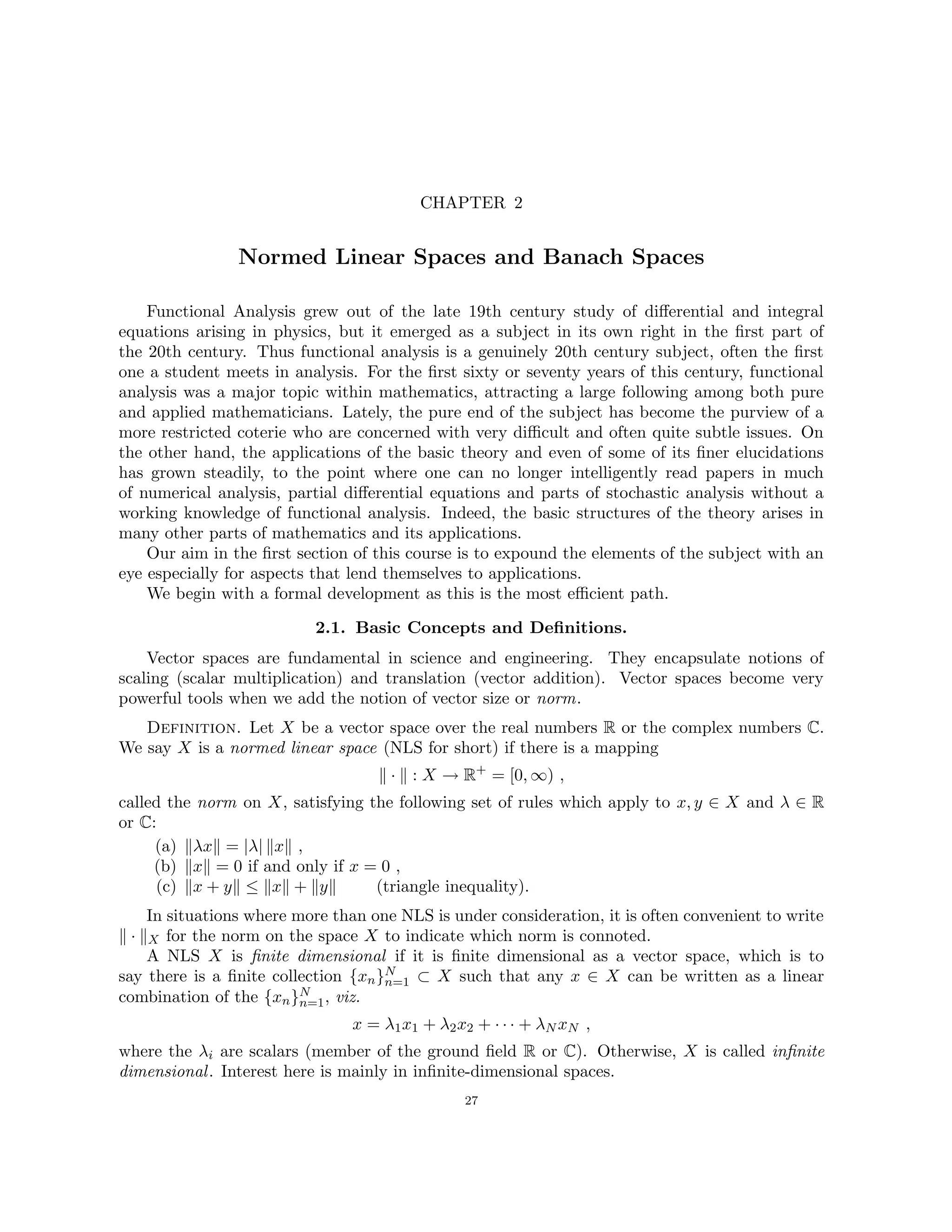
![28 2. NORMED LINEAR SPACES AND BANACH SPACES
Remark. In a good deal of the theory developed here, it will not matter for the outcome
whether the NLS’s are real or complex vector spaces. When this point is moot, we will often
write F rather than R or C. The reader should understand when the symbol F appears that it
stands for either R or for C, and the discussion at that juncture holds for both.
Examples. (a) Consider Fd with the usual Euclidean length of a vector x = (x1, ..., xd)
denoted |x| =
Pd
n=1 |xn|2
1/2
. If we define, for x ∈ Fd, kxk = |x|, then (Fd, k · k) is a finite
dimensional NLS.
(b) Let a and b be real numbers, a b, with a = −∞ or b = +∞ allowed as possible values.
Then
C([a, b]) =
f : [a, b] → F : f is continuous and sup
x∈[a,b]
|f(x)| ∞
.
We impose a vector space structure by pointwise multiplication and addition; that is, for x ∈ [a, b]
and λ ∈ F, we define
(f + g)(x) = f(x) + g(x) and (λf)(x) = λf(x) .
For f ∈ C([a, b]), let
kfkC([a,b]) = sup
x∈[a,b]
|f(x)| ,
which is easily shown to be a norm. Thus, C([a, b]), k · kC([a,b])
is a NLS, which is also infinite
dimensional. (To see this latter fact, the reader can consider the impossibility of finding a finite
basis for the periodic base functions of Fourier series on a bounded interval.)
(c) We can impose a different norm on the space C([a, b]) defined by
kfkL1([a,b]) =
Z b
a
|f(x)| dx .
Again, it is easy to verify that C([a, b]), k·kL1([a,b])
is a NLS, but it is different from C([a, b]), k·
kC([a,b])
. These two NLS’s have the same set objects and the same vector space structure, but
different norms, i.e., they measure sizes differently.
Further examples arise as subspaces of NLS’s. This fact follows directly from the definitions,
and is stated formally below.
Proposition 2.1. If (X, k · k) is a NLS and V ⊂ X is a linear subspace, then (V, k · k) is a
NLS.
Let (X, k · k) be a NLS. Then X is a metric space if we define a metric d on X by
d(x, y) = kx − yk .
To see this, just note the following: for x, y, z ∈ X,
d(x, x) = kx − xk = k0k = 0 ,
0 = d(x, y) = kx − yk =⇒ x − y = 0 =⇒ x = y ,
d(x, y) = kx − yk = k − (y − x)k = | − 1| ky − xk = d(y, x) ,
d(x, y) = kx − yk = kx − z + z − yk
≤ kx − zk + kz − yk = d(x, z) + d(z, y) .
Consequently, the concepts of elementary topology are available in any NLS. In particular, we
may talk about open sets and closed sets in a NLS.](https://image.slidesharecdn.com/appliedmathematicsmethods-230215152718-28efe5ed/75/applied-mathematics-methods-pdf-28-2048.jpg)
![2.1. BASIC CONCEPTS AND DEFINITIONS. 29
A set U ⊂ X is open if for each x ∈ U, there is an r 0 (depending on x in general) such
that
Br(x) = {y ∈ X : d(y, x) r} ⊂ U .
The set Br(x) is referred to as the (open) ball of radius r about x. A set F ⊂ X is closed if
Fc = X r F = {y ∈ X, y /
∈ F} is open. As with any metric space, F is closed if and only if
it is sequentially closed. That is, F is closed means that whenever {xn}∞
1 ⊂ F and xn → x as
n → ∞ for the metric, then it must be the case that x ∈ F.
Proposition 2.2. In a NLS X, the operations of addition, + : X × X → X and scalar
multiplication, · : F × X → X, and the norm, k · k : X → R, are continuous.
Proof. Let {xn}∞
n=1 and {yn}∞
n=1 be sequences in X converging to x, y ∈ X, respectively.
Then
k(xn + yn) − (x + y)k = k(xn − x) + (yn − y)k ≤ kxn − xk + kyn − yk → 0 .
We leave scalar multiplication for the reader, which requires the fact that a convergent sequence
of scalars is bounded.
For the norm,
kxk ≤ kx − xnk + kxnk ≤ 2kx − xnk + kxk ,
so we conclude that limn→∞ kxnk = kxk, i.e., the norm is continuous.
Recall that a sequence {xn}∞
n=1 in a metric space (X, d) is called a Cauchy sequence if
lim
n,m→∞
d(xn, xm) = 0 ;
or equivalently, given ε 0, there is an N = N(ε) such that if n, m ≥ N, then
d(xn, xm) ≤ ε .
A metric space is called complete if every Cauchy sequence converges to a point in X. A
NLS (X, k · k) that is complete as a metric space is called a Banach space after the Polish
mathematician Stefan Banach, who was a pioneer in the subject.
Examples. (a) The spaces Rd and Cd are complete as we learn in advanced calculus or
elementary analysis.
(b) For a and b in [−∞, ∞], a b, the space C([a, b]), k · kC([a,b])
is complete, since the
uniform limit of continuous functions is continuous. That is, a Cauchy sequence will converge
to a continuous function.
(c) The space C([a, b]), k · kL1([a,b])
is not complete. To see this, suppose that a = −1 and
b = 1 (we can translate and scale if this is not true) and define for n = 1, 2, 3, ...,
fn(x) =
1 if x ≤ 0 ,
1 − nx if 0 x 1/n ,
0 if x ≥ 1/n .
Each fn ∈ C([−1, 1]), and this is a Cauchy sequence for the given norm, since
Z 1
−1
|fn(x) − fm(x)| dx ≤
Z 1
0
(|fn(x)| + |fm(x)|) dx ≤
1
2n
+
1
2m](https://image.slidesharecdn.com/appliedmathematicsmethods-230215152718-28efe5ed/75/applied-mathematics-methods-pdf-29-2048.jpg)
![30 2. NORMED LINEAR SPACES AND BANACH SPACES
can be made as small as we like for n and m large enough (note that the sequence is not Cauchy
using the norm k·kC([−1,1])!). However, fn does not converge in C([−1, 1]), since it must converge
to 1 for x 0 and to 0 for x 0, which is not a continuous function.
By convention, unless otherwise specified, we use the norm k · k = k · kC([a,b]) on C([a, b]),
which makes it a Banach space.
If X is a linear space over F and d is a metric on X induced from a norm on X, then for all
x, y, a ∈ X and λ ∈ F,
d(x + a, y + a) = d(x, y) and d(λx, λy) = |λ|d(x, y) . (2.1)
Suppose now that X is a linear space over F and d is a metric on X satisfying (2.1). Is it
necessarily the case that there is a norm k · k on X such that d(x, y) = kx − yk? We leave this
question for the reader to ponder.
If X is a vector space and k·k1 and k · k2 are two norms on X, they are said to be equivalent
norms if there exist constants c, d 0 such that
ckxk1 ≤ kxk2 ≤ dkxk1 (2.2)
for all x ∈ X. Equivalent norms do not measure size in the same way, but, up to the constants
c and d, they agree when something is “small” or “large.”
It is a fundamental fact, as we will see later, that on a finite-dimensional NLS, any pair of
norms is equivalent, whereas this is not the case in infinite dimensional spaces. For example, if
f ∈ C([0, 1]), then
kfkL1([0,1]) ≤ kfkC([0,1]) ,
but the opposite bound is lacking. To see this, consider the sequence
fn(x) =
n2x if x ≤ 1/n ,
2n − n2x if 1/n x 2/n ,
0 if x ≥ 2/n ,
for which
kfnkC([0,1]) = n but kfkL1([0,1]) = 1 .
If k · k1 and k · k2 are two equivalent norms on a NLS X as in (2.2), then the collections O1
and O2 of open sets induced by these two norms as just outlined are the same. To see this, let
Bi
r(x) be the ball about x ∈ X of radius r measured using norm k · ki. Then
B1
r/c(x) ⊂ B2
r (x) ⊂ B1
r/d(x)
shows that our open balls are nested. Thus topologically, (X, k · k1) and (X, k · k2) are indis-
tinguishable. Moreover, finite dimensional NLS’s have a unique topological structure, whereas
infinite dimensional NLS’s may have many distinct topologies.
Convexity is an important property in vector spaces.
Definition. A set C in a linear space X over F is convex if whenever x, y ∈ C, then
tx + (1 − t)y ∈ C
whenever 0 ≤ t ≤ 1.
Proposition 2.3. Suppose (X, k · k) is a NLS and r 0. For any x ∈ X, Br(x) is convex.](https://image.slidesharecdn.com/appliedmathematicsmethods-230215152718-28efe5ed/75/applied-mathematics-methods-pdf-30-2048.jpg)
![2.1. BASIC CONCEPTS AND DEFINITIONS. 31
Proof. Let y, z ∈ Br(x) and t ∈ [0, 1] and compute as follows:
kty + (1 − t)z − xk = kt(y − x) + (1 − t)(z − x)k
≤ kt(y − x)k + k(1 − t)(z − x)k
= |t| ky − xk + |1 − t| kz − xk
tr + (1 − t)r = r .
Thus, Br(x) is convex.
One reason vector spaces are so important and ubiquitous is that they are the natural
domain of definition for linear maps, and the latter pervade mathematics and its applications.
Remember, a linear map is one that commutes with addition and scalar multiplication, so that
T(x + y) = T(x) + T(y) ,
T(λx) = λT(x) ,
for x, y ∈ X, λ ∈ F. For linear maps, we often write Tx for T(x), leaving out the parentheses.
The scaling property requires that T(0) = 0 for every linear map.
A set M ⊂ X of a NLS X is said to be bounded if there is R 0 such that M ⊂ BR(0);
that is,
kxk ≤ R ∞ for all x ∈ M .
An operator T : X → Y , X and Y NLS’s, is bounded if it takes bounded sets to bounded sets.
(Note that this does not require that the entire image of T be bounded!)
Proposition 2.4. If X and Y are NLS’s and T : X → Y is linear, then T is bounded if
and only if there is C 0 such that
kTxkY ≤ CkxkX for all x ∈ X .
Proof. The result follows from scaling considerations. Suppose first that T is bounded.
For M = B1(0), there is R 0 such that
kTykY ≤ R for all y ∈ M .
Now let x ∈ X be given. If x = 0, the conclusion holds trivially. Otherwise, let y = x/2kxkX ∈
M. Then
kTxkY = T(2kxkXy) Y
= 2kxkXTy Y
= 2kxkXkTykY ≤ 2RkxkX ,
which is the conclusion with C = 2R.
Conversely, suppose that there is C 0 such that
kTxkY ≤ CkxkX for all x ∈ X .
Let M ⊂ BR(0) be bounded and fix x ∈ M. Then
kTxkY ≤ CkxkX ≤ CR ∞,
so T takes a bounded set to a bounded set.
On the one hand, the linear maps are the natural (i.e., structure preserving) maps on a
vector space. On the other hand, the natural mappings between topological spaces, and metric
spaces in particular, are the continuous maps. If (X, d) and (Y, ρ) are two metric spaces and](https://image.slidesharecdn.com/appliedmathematicsmethods-230215152718-28efe5ed/75/applied-mathematics-methods-pdf-31-2048.jpg)

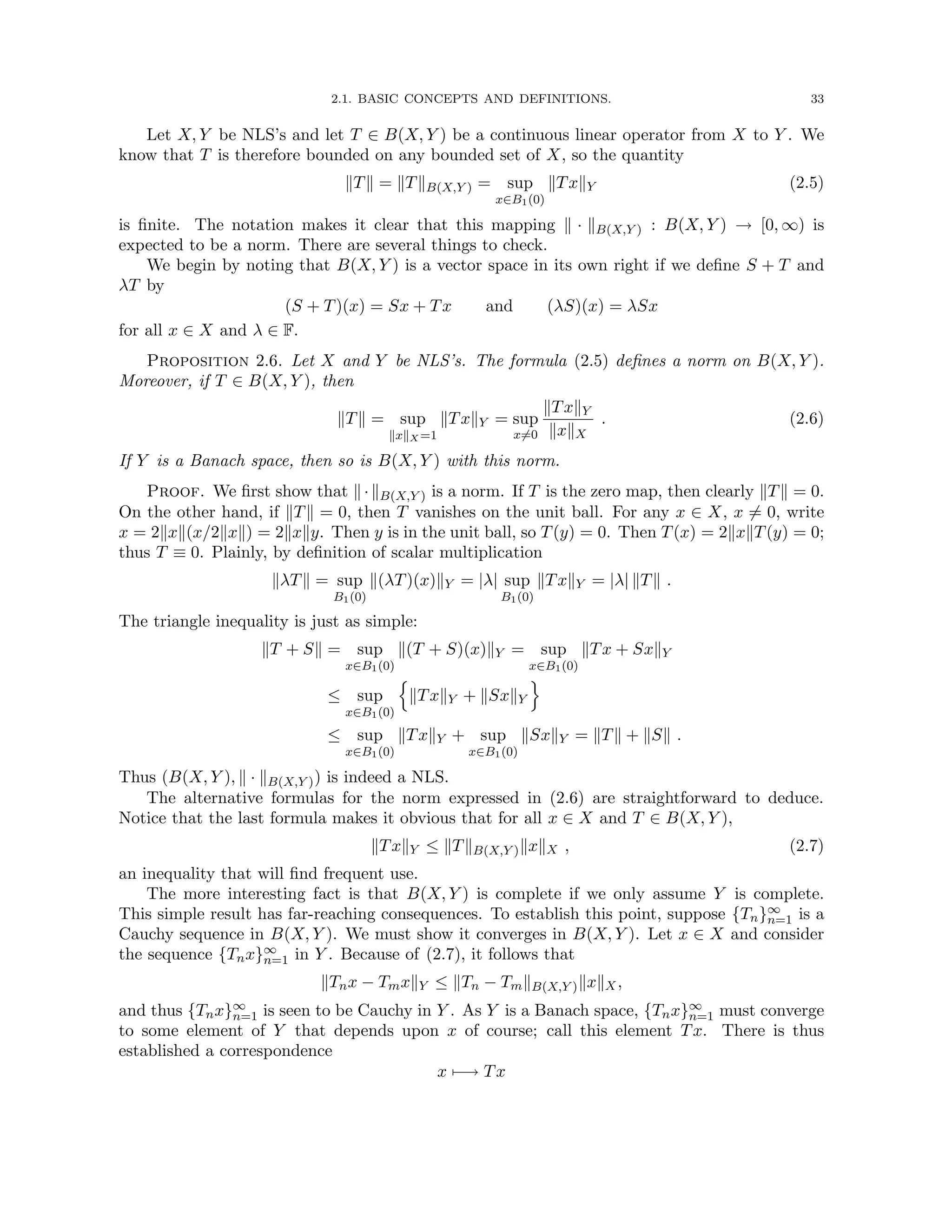
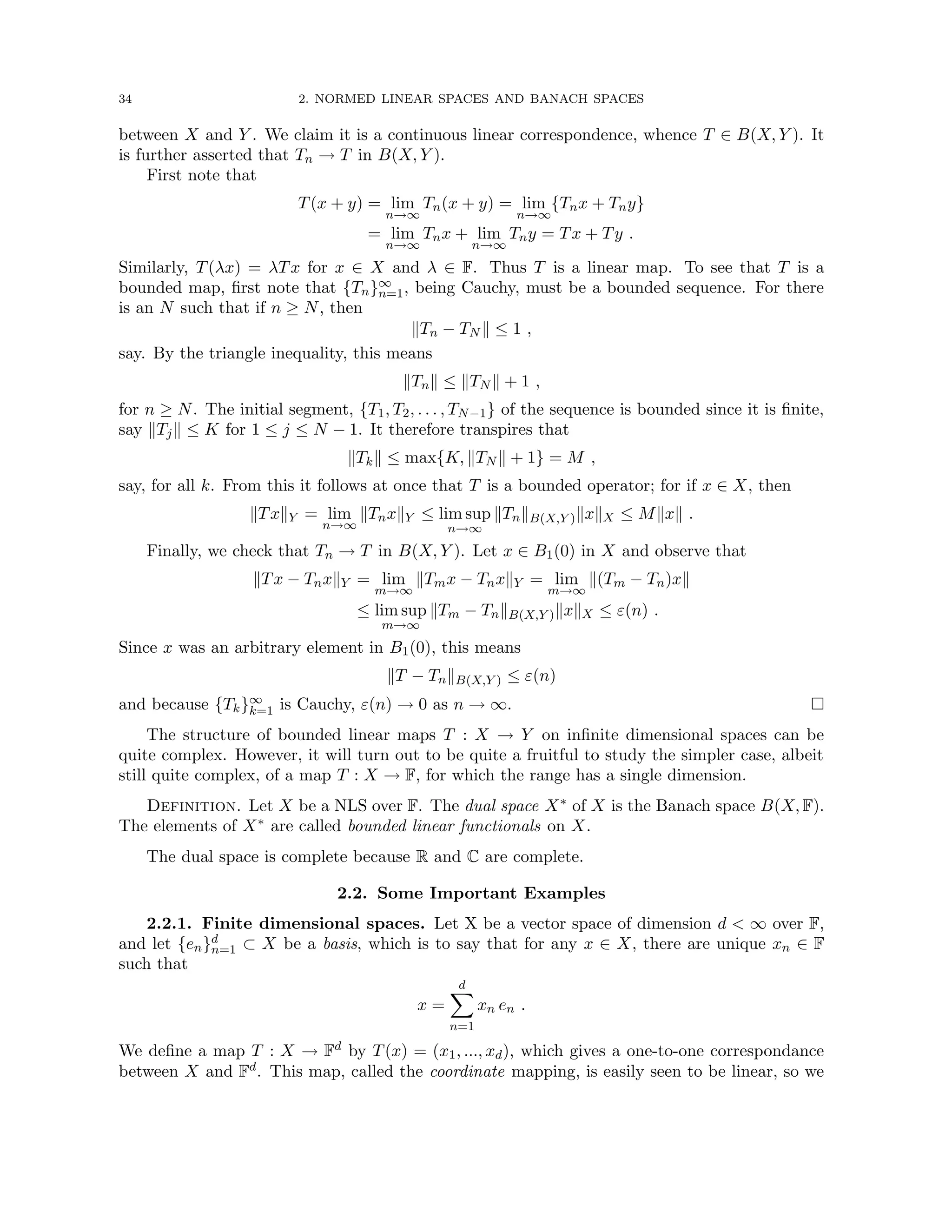
![2.2. SOME IMPORTANT EXAMPLES 35
have a vector space isomorphism between the spaces. Consequently, X and Fd have the same
vector space structure. That is, given a dimension d, there is only one vector space structure of
the given dimension (for the field F).
Define for 1 ≤ p ≤ ∞ the map k · k`p : Fd → [0, ∞) by
kxk`p =
d
X
n=1
|xn|p
1/p
for p ∞ ,
maxn=1,...,d |xn| for p = ∞ .
It is easy to verify that kxk`1 and kxk`∞ are norms on Fd. In fact, the zero and scaling properties
of a norm are easily verified for k · k`p , but we need a few facts before we can verify the triangle
inequality. Once done, note that then also kT(·)k`p is a norm on X.
The following simple inequality turns out to be quite useful in practice.
Lemma 2.7. Let 1 p ∞ and let q denote the conjugate exponent to p defined by
1
p
+
1
q
= 1 .
If a and b are nonnegative real numbers, then
ab ≤
ap
p
+
bq
q
, (2.8)
with equality if and only if ap/bq = 1. Moreover, for any 0, then there is C = C(p, ) 0
such that
ab ≤ ap
+ Cbq
.
Proof. The function u : [0, ∞) → R given by
u(t) =
tp
p
+
1
q
− t
has minimum value 0, attained only with t = 1. Apply this fact to t = ab−q/p to obtain main
result. Replace ab by [(p)1/pa][(p)−1/pb] to obtain the final result.
This leads us immediately to Hölder’s Inequality. When p = 2, the inequality is also called
the Cauchy-Schwarz Inequality.
Theorem 2.8 (Hölder’s Inequality). Let 1 ≤ p ≤ ∞ and let q denote the conjugate exponent
(i.e., 1/p + 1/q = 1, with the convention that q = ∞ if p = 1 and q = 1 if p = ∞). If x, y ∈ Fd,
then
d
X
n=1
|xnyn| ≤ kxk`p kyk`q .
Proof. The result is trivial if either p or q is infinity. Otherwise, simply apply (2.8) to
a = |xn|/kxk`p and b = |yn|/kyk`q and sum on n to see that
d
X
n=1
|xn|
kxk`p
|yn|
kyk`q
≤
d
X
n=1
|xn|p
pkxkp
`p
+
d
X
n=1
|yn|q
qkykq
`q
=
1
p
+
1
q
= 1 .
Thus the conclusion follows.](https://image.slidesharecdn.com/appliedmathematicsmethods-230215152718-28efe5ed/75/applied-mathematics-methods-pdf-35-2048.jpg)
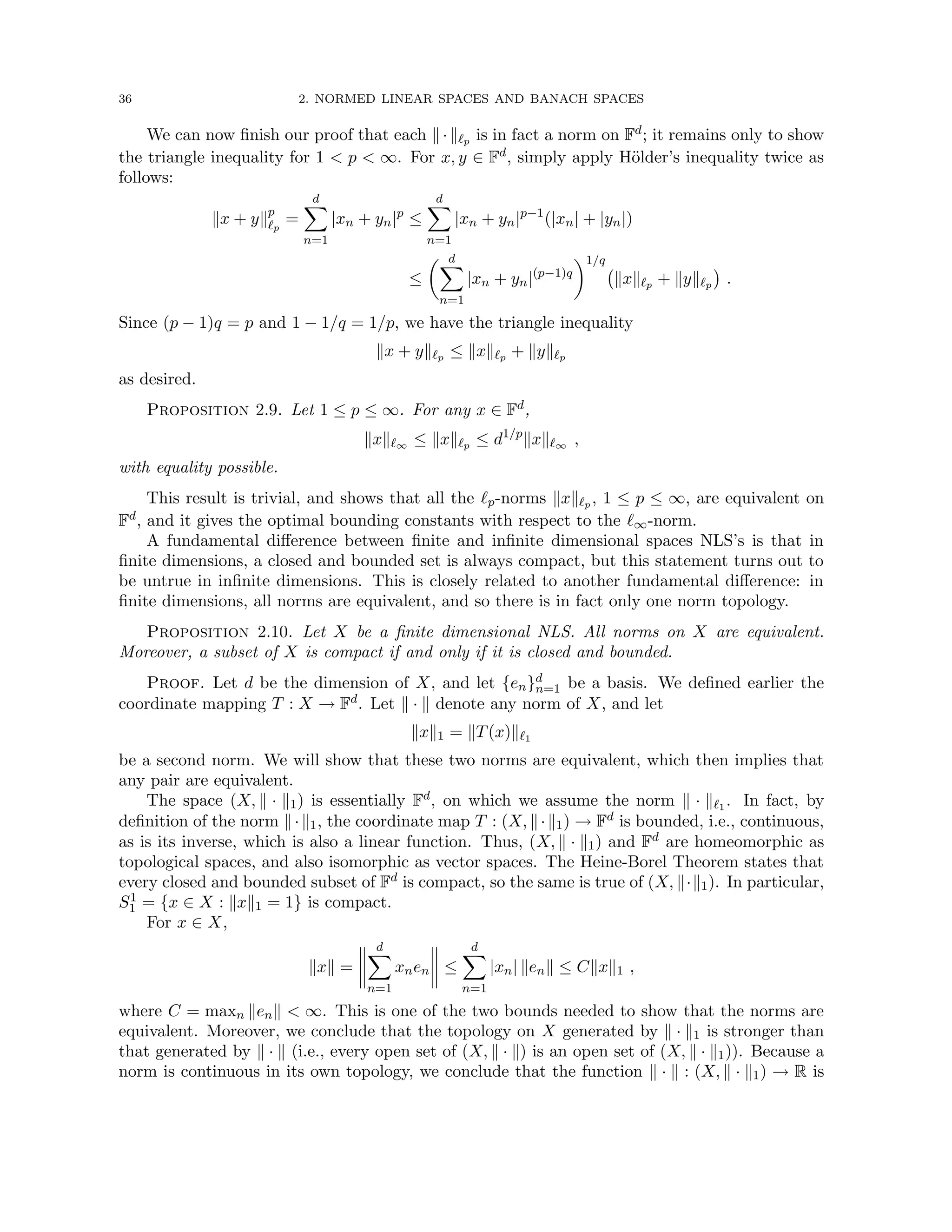
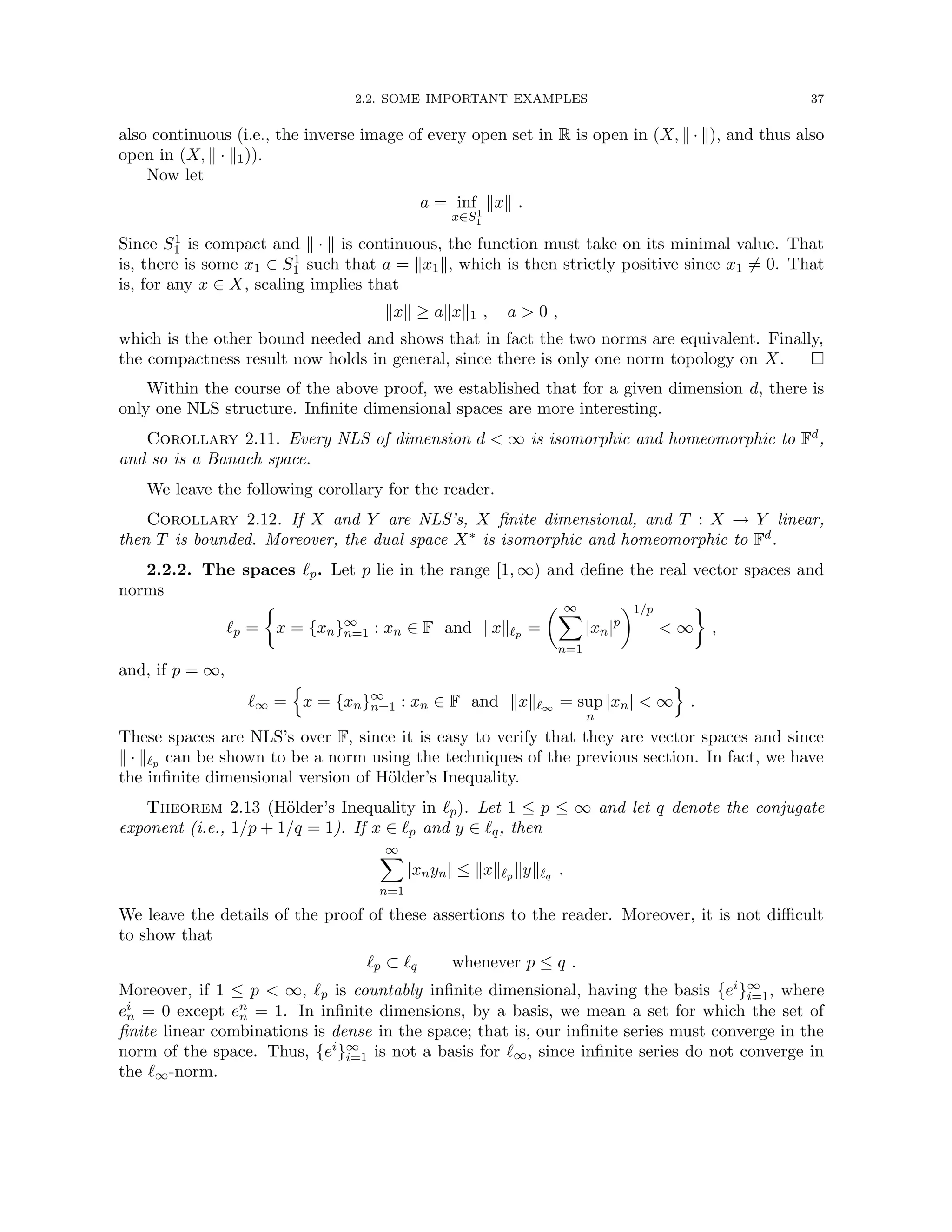
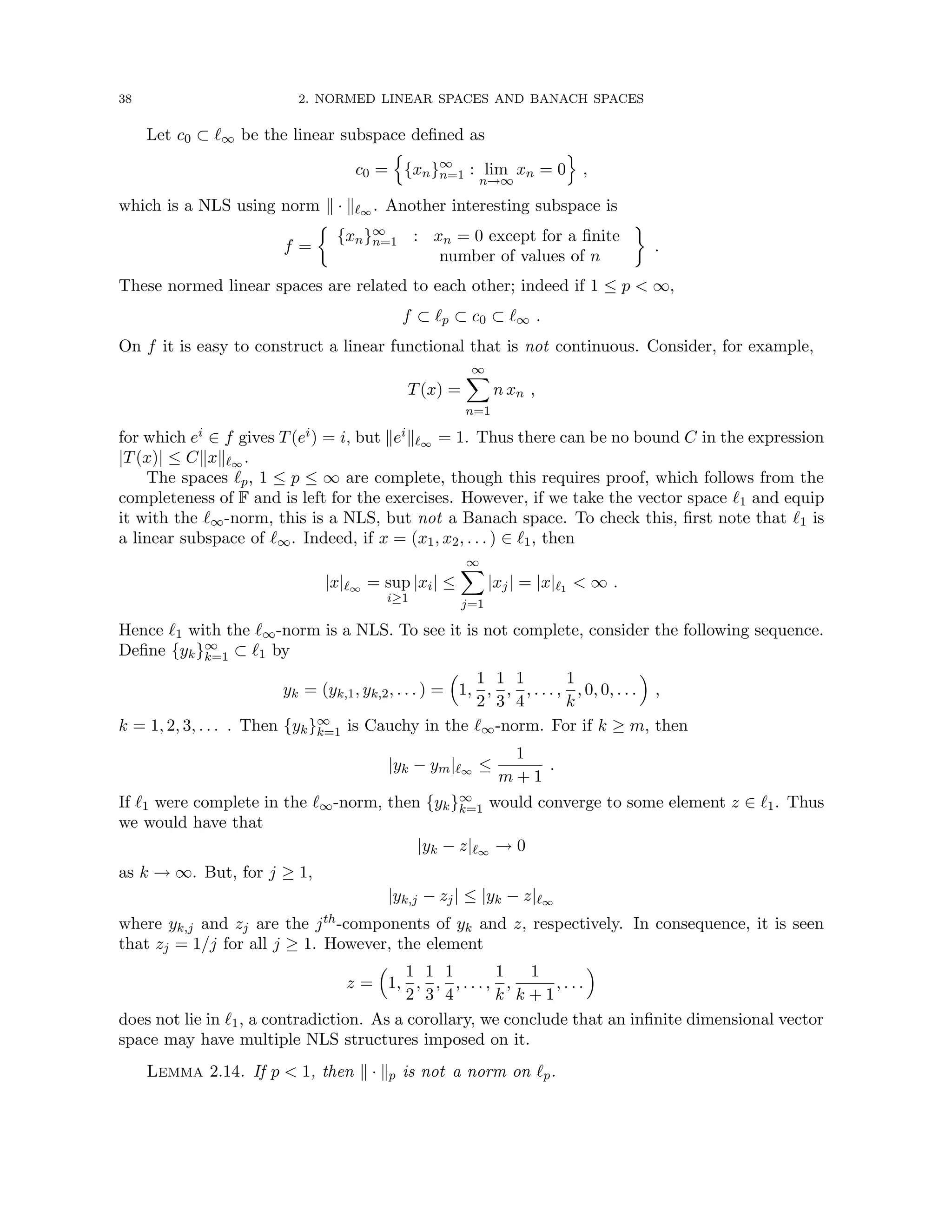
![2.2. SOME IMPORTANT EXAMPLES 39
To prove this, show the unit ball B1(0) is not convex, which would otherwise contradict
Prop. 2.3. It is also easy to see directly that the triangle inequality does not always hold. We
leave the details to the reader.
The Hölder inequality implies the existence of continuous linear functionals. Let 1 ≤ p ≤ ∞
and q be conjugate to p. Then any y ∈ `q can be viewed as a function Y : `p → F by
Y (x) =
∞
X
n=1
xn yn for all x ∈ `p . (2.9)
This is clearly a linear functional, and it is bounded, since
|Y (x)| ≤ (kyk`q )kxk`p .
In fact, we leave it to the reader to show that
kY k = kyk`q .
The converse is also true for 1 ≤ p ∞: for any continuous linear functional Y on `p, there
is y ∈ `q such that (2.9) holds. That is, we can identify the dual of `p as `q under the action
defined by (2.9). Again, we leave the details to the exercises, but it should be clear that we need
to define yn = Y (en), where en is from the standard basis. The main concern is justifying that
y ∈ `p. We also have that c∗
0 = `1, but the dual of `∞ is larger that `1.
2.2.3. The Lebesgue spaces Lp(Ω). Let Ω ⊂ Rd be measurable and let 0 p ∞. We
denote by Lp(Ω) the class of all measurable functions f : Ω → F such that
Z
Ω
|f(x)|p
dx ∞ . (2.10)
An interesting point arises here. Suppose f and g lie in Lp(Ω) and that f(x) = g(x) for a.e.
x ∈ Ω. Then as far as integration is concerned, one really cannot distinguish f from g. For
example, if A ⊂ Ω is measurable, then
Z
A
|f|p
dx =
Z
A
|g|p
dx .
Thus within the class of Lp(Ω), f and g are equivalent. This is formalized by modifying the
definition of the elements of Lp(Ω). We declare two measurable functions that are equal a.e. to
be equivalent, and define the elements of Lp(Ω) to be the equivalence classes
[f] = {g : Ω → F : g = f a.e. on Ω}
such that one (and hence all) representative function satisfies (2.10). However, for convenience,
we continue to speak of and denote elements of Lp(Ω) as “functions” which may be modified on
a set of measure zero without consequence. For example, f = 0 in Lp(Ω) means only that f = 0
a.e. in Ω.
The integral (2.10) arises frequently, so we denote it as
kfkp =
Z
Ω
|f(x)|p
dx
1/p
,
and call it the Lp(Ω)-norm. We will indeed show it to be a norm.
A function f(x) is said to be bounded on Ω by K ∈ R if |f(x)| ≤ K for every x ∈ Ω. We
modify this for measurable functions.](https://image.slidesharecdn.com/appliedmathematicsmethods-230215152718-28efe5ed/75/applied-mathematics-methods-pdf-39-2048.jpg)


![42 2. NORMED LINEAR SPACES AND BANACH SPACES
so f ∈ Lp(Ω) follows immediately for p = ∞, and, for p ∞, from Lebesgue’s Dominated
Convergence Theorem 1.46, since Fp ∈ L gives a bounding function for |f|p.
We finally claim that kfnj − fkp → 0. When p ∞, the Dominated Convergence Theorem
applies again with the bounding function
|fnj (x) − f(x)| ≤ F(x) + |f(x)| ∈ Lp(Ω) .
If p = ∞, let Bnj,nk
be a set of measure zero such that
|fnj (x) − fnk
(x)| ≤ kfnj − fnk
k∞ for x 6∈ Bnj,nk
,
and let B be the union of the A and Bnj,nk
, which continues to have measure zero. The right
side can be made as small as we please, say to 0, provided nj and nk are large enough.
Taking the limit on nk → ∞, we obtain that
|fnj (x) − f(x)| ≤ for x ∈ Ω B ,
which demonstrates the desired convergence.
It remains to consider the entire sequence. Given 0, we can choose N 0 such that for
n, nj N, kfn − fnj kp ≤ /2 and also kfnj − fkp ≤ /2. Thus
kfn − fkp ≤ kfn − fnj kp + kfnj − fkp ≤ ,
end the entire sequence converges to f in Lp(Ω).
A consequence of Hölder’s Inequality is that we can define linear functionals. Let 1 ≤ p ≤ ∞
and let q be the conjugate exponent. For g ∈ Lq(Ω), we define Tg : Lp(Ω) → F for f ∈ Lp(Ω) by
Tg(f) =
Z
Ω
f(x) g(x) dx .
Hölder shows that this is well defined (i.e., finite), and further that
|Tg(f)| ≤ kgkqkfkp ,
so Tg is bounded, since it is easy to veryfy that Tg is linear; that is, Tg ∈ (Lp(Ω))∗. Moreover,
we leave it to the reader to verify that in fact
kTgk(Lp(Ω))∗ = kgkq .
It is natural to ask if these are all the continuous linear functionals. The answer is “yes”
when 1 ≤ p ∞, but “no” for p = ∞. To present the details of the proof here would take us
far afield of functional analysis, so we state the following without proof (see, e.g., [Ru2] for the
proof, which uses the important measure theoretic Radon-Nikodym Theorem).
Proposition 2.20. Suppose that 1 ≤ p ∞ and Ω ∈ Rd is measurable. Then
(Lp(Ω))∗
= {Tg : g ∈ Lq(Ω)} .
Moreover, kTgk(Lp(Ω))∗ = kgkq.
Functions in Lp(Ω) can be quite complex. Fortunately, each is arbitrarily close to a simple
function s(x) with compact support, i.e., s(x) = 0 outside some ball, but only when p ∞.
Proposition 2.21. The set S of all measurable simple functions with compact support is
dense in Lp(Ω) when 1 ≤ p ∞.](https://image.slidesharecdn.com/appliedmathematicsmethods-230215152718-28efe5ed/75/applied-mathematics-methods-pdf-42-2048.jpg)

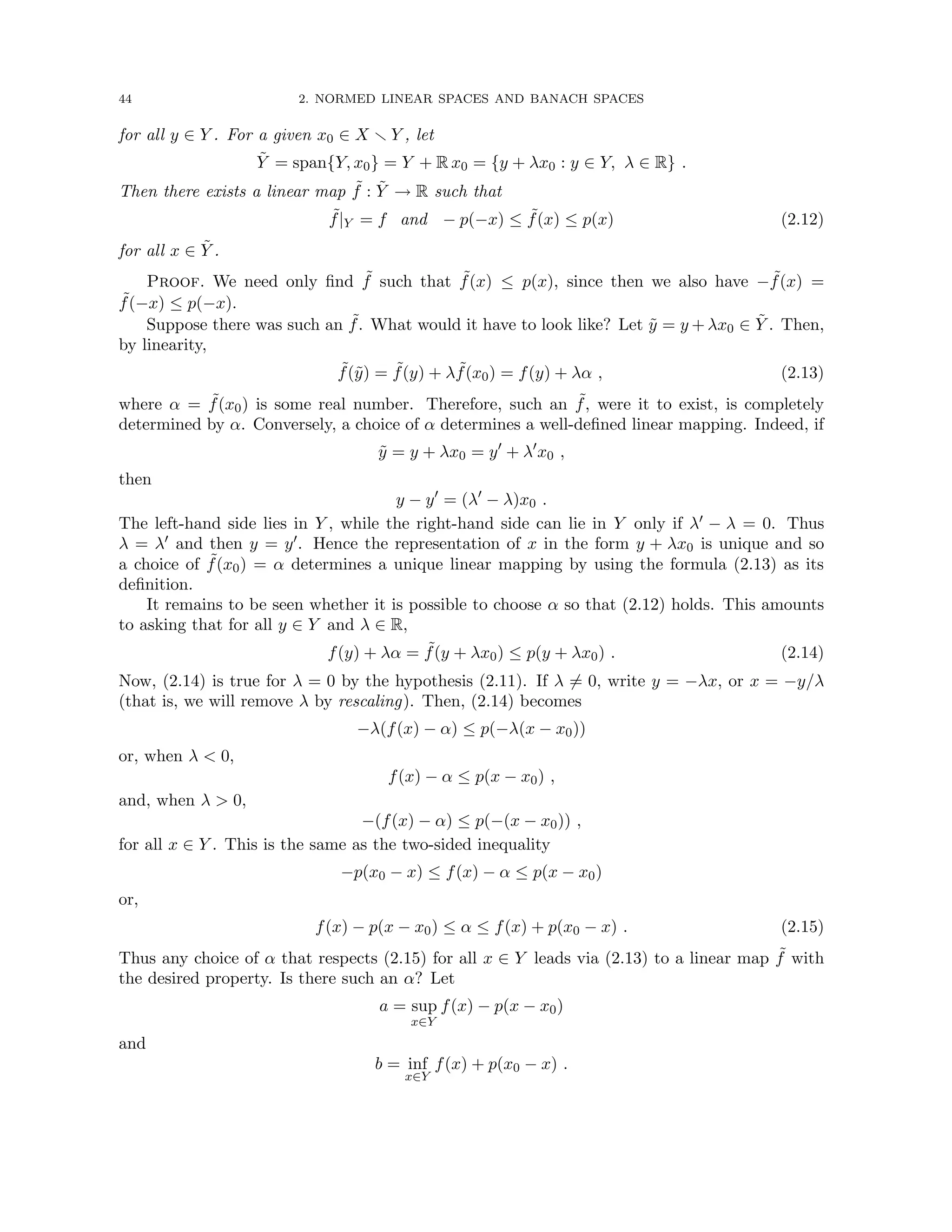
![2.3. HAHN-BANACH THEOREMS 45
If it is demonstrated that a ≤ b, then there certainly is such an α and any choice in the non-empty
interval [a, b] will do. But, a calculation shows that for x, y ∈ Y ,
f(x) − f(y) = f(x − y) ≤ p(x − y) ≤ p(x − x0) + p(x0 − y) ,
on account of (2.11) and the triangle inequality. In consequence, we have
f(x) − p(x − x0) ≤ f(y) + p(x0 − y) ,
and this holds for any x, y ∈ Y . Fixing y, we see that
sup
x∈Y
f(x) − p(x − x0) ≤ f(y) + p(x0 − y) .
As this is valid for every y ∈ Y , it must be the case that
a = sup
x∈Y
f(x) − p(x − x0) ≤ inf
y∈Y
f(y) + p(x0 − y) = b .
The result is thereby established.
We now want to successively extend f to all of X, one dimension at a time. We can do this
trivially if X r Y is finite dimensional. If X r Y were to have a countable vector space basis,
we could use ordinary induction. However, not many interesting NLS’s have a countable vector
space basis. We therefore need to consider the most general case of a possibly uncountable
vector space basis, and this requires that we use what is known as transfinite induction.
We begin with some terminology.
Definition. For a set S, an ordering, denoted by , is a binary relation such that:
(a) x x for every x ∈ S (reflexivity);
(b) If x y and y x, then x = y (antisymmetry);
(c) If x y and y z, then x z (transitivity).
A set S is partially ordered if S has an ordering that may apply only to certain pairs of elements
of S, that is, there may be x and y in S such that neither x y nor y x holds. In that case,
x and y are said to be incomparable; otherwise they are comparable. A totally ordered set or
chain C is a partially ordered set such that every pair of elements in C are comparable.
Lemma 2.24 (Zorn’s Lemma). Suppose S is a nonempty, partially ordered set. Suppose that
every chain C ⊂ S has an upper bound; that is, there is some u ∈ S such that
x u for all x ∈ C .
Then S has at least one maximal element; that is, there is some m ∈ S such that for any x ∈ S,
m x =⇒ m = x .
This lemma follows from the Axiom of Choice, which states that given any set S and any
collection of its subsets, we can choose a single element from each subset. In fact, Zorn’s lemma
implies the Axiom of Choice, and is therefore equivalent to it. Since the proof takes us deeply
into logic and far afield from Functional Analysis, we accept Zorn’s lemma as an Axiom of set
theory and proceed.
Theorem 2.25 (Hahn-Banach Theorem for Real Vector Spaces). Suppose that X is a vector
space over R, Y is a linear subspace, and p is sublinear on X. If f is a linear functional on Y
such that
f(x) ≤ p(x) (2.16)](https://image.slidesharecdn.com/appliedmathematicsmethods-230215152718-28efe5ed/75/applied-mathematics-methods-pdf-45-2048.jpg)
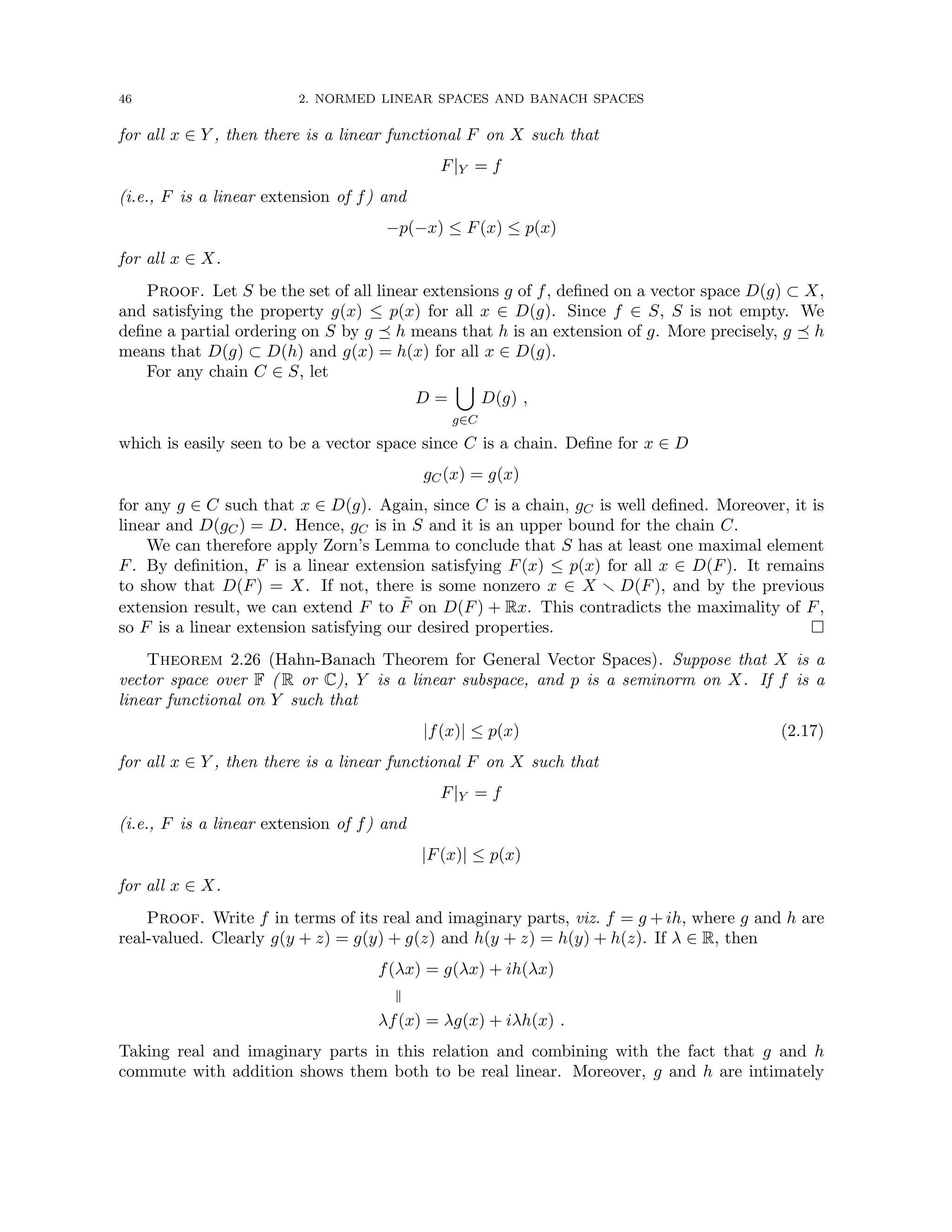
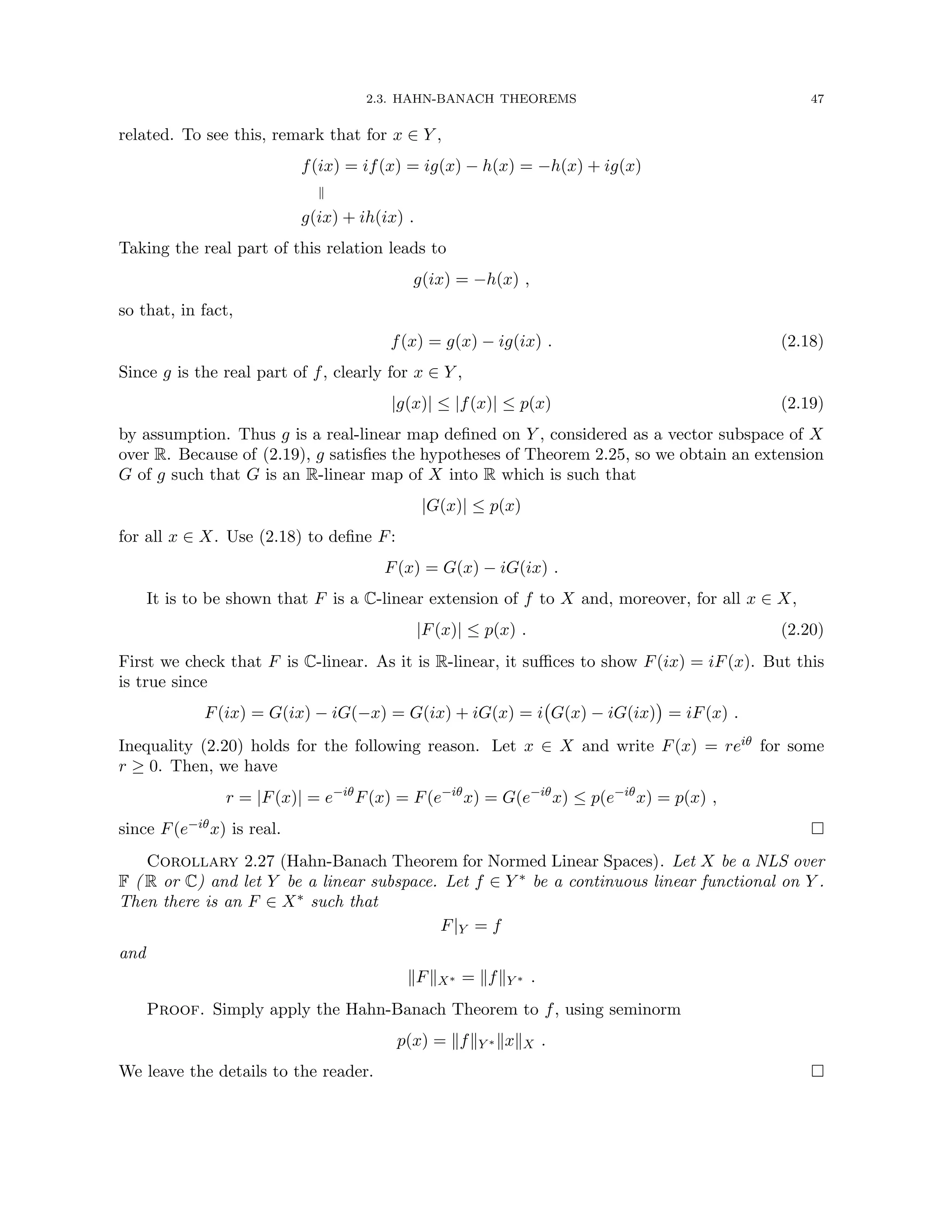
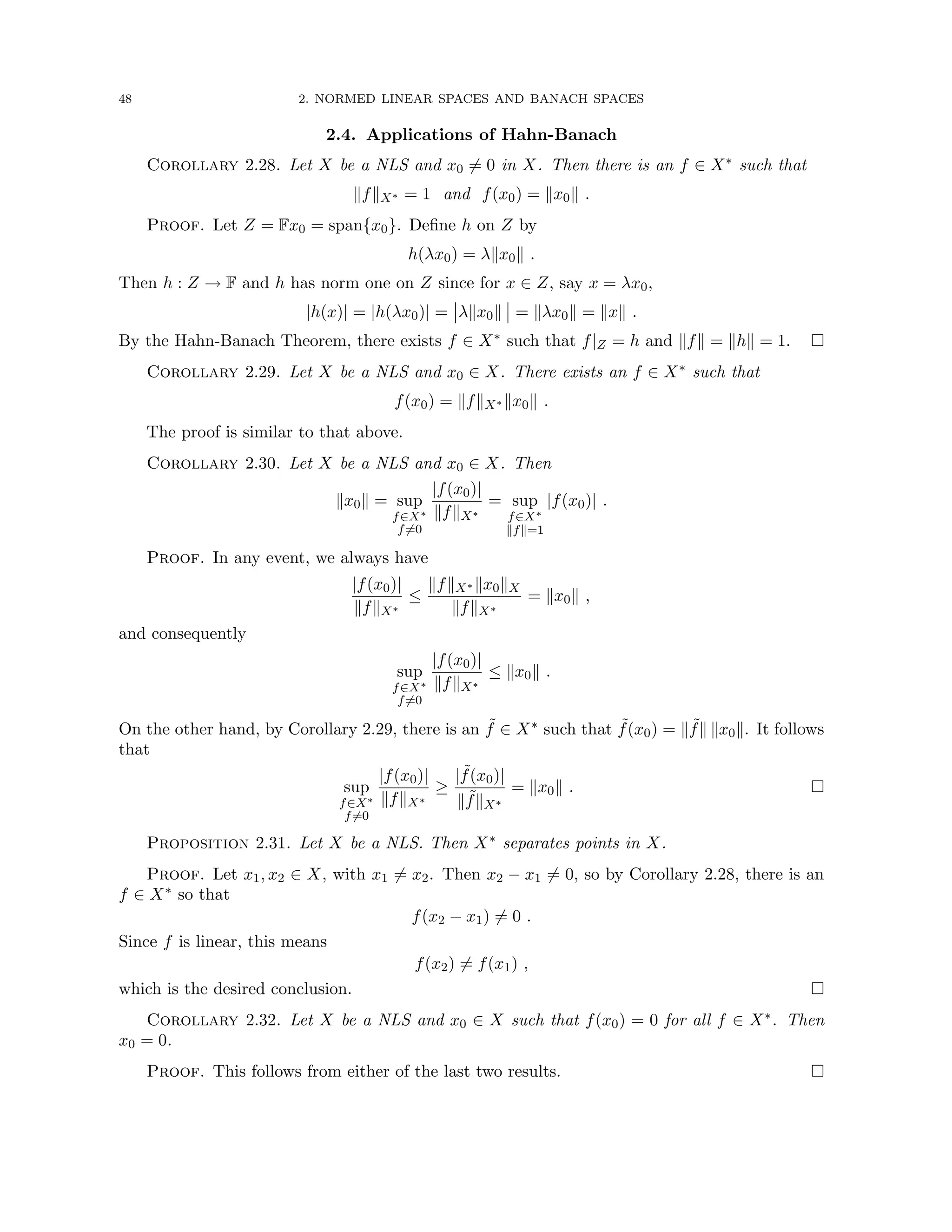
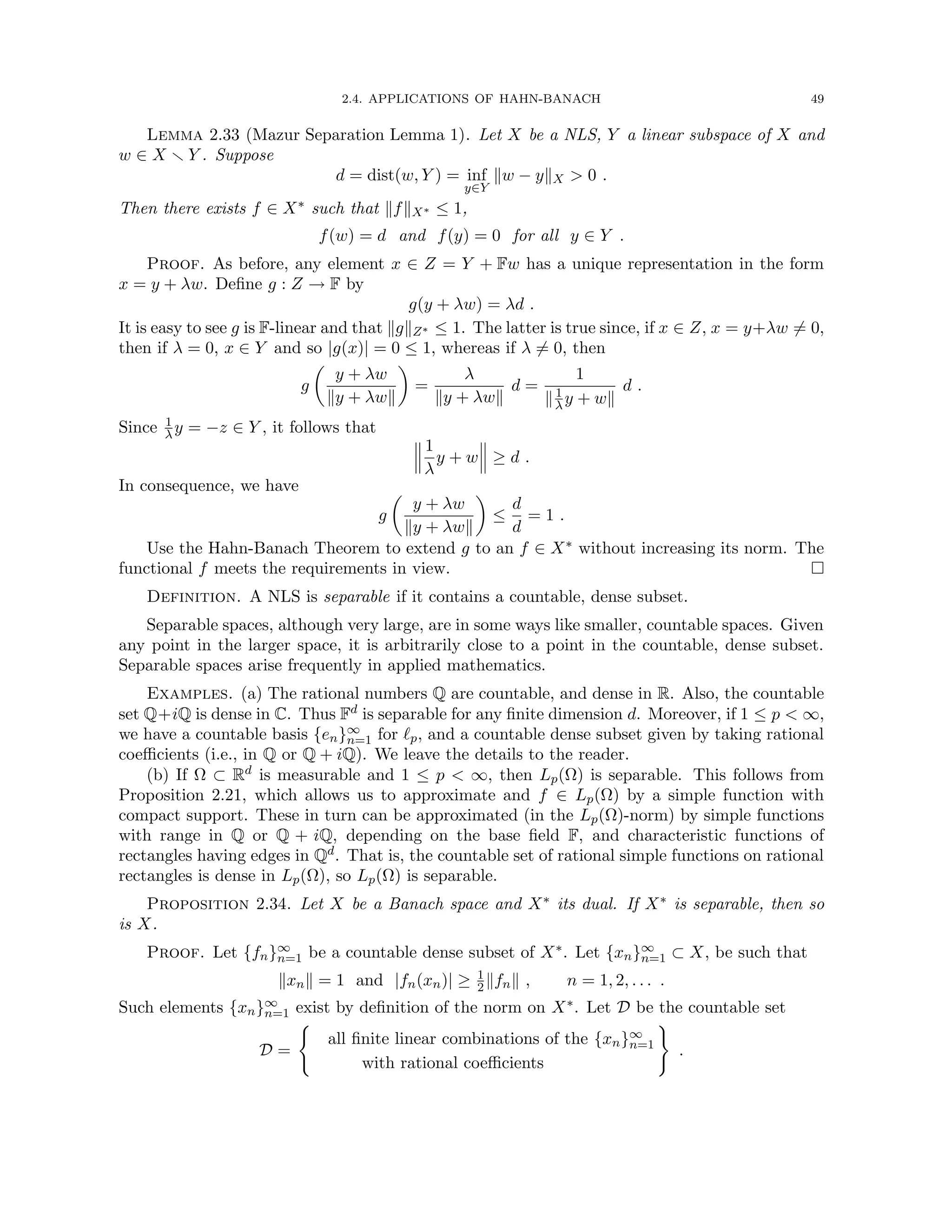
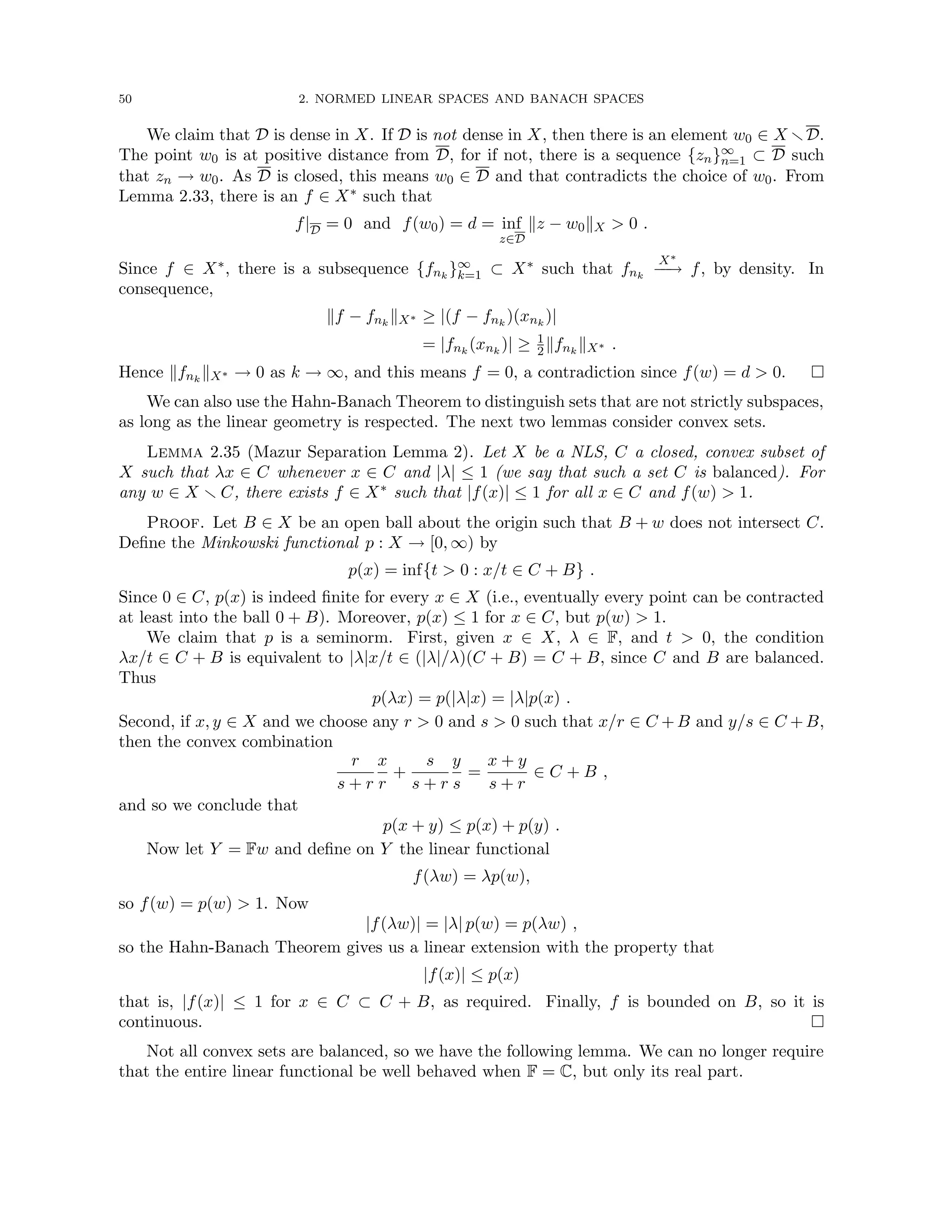
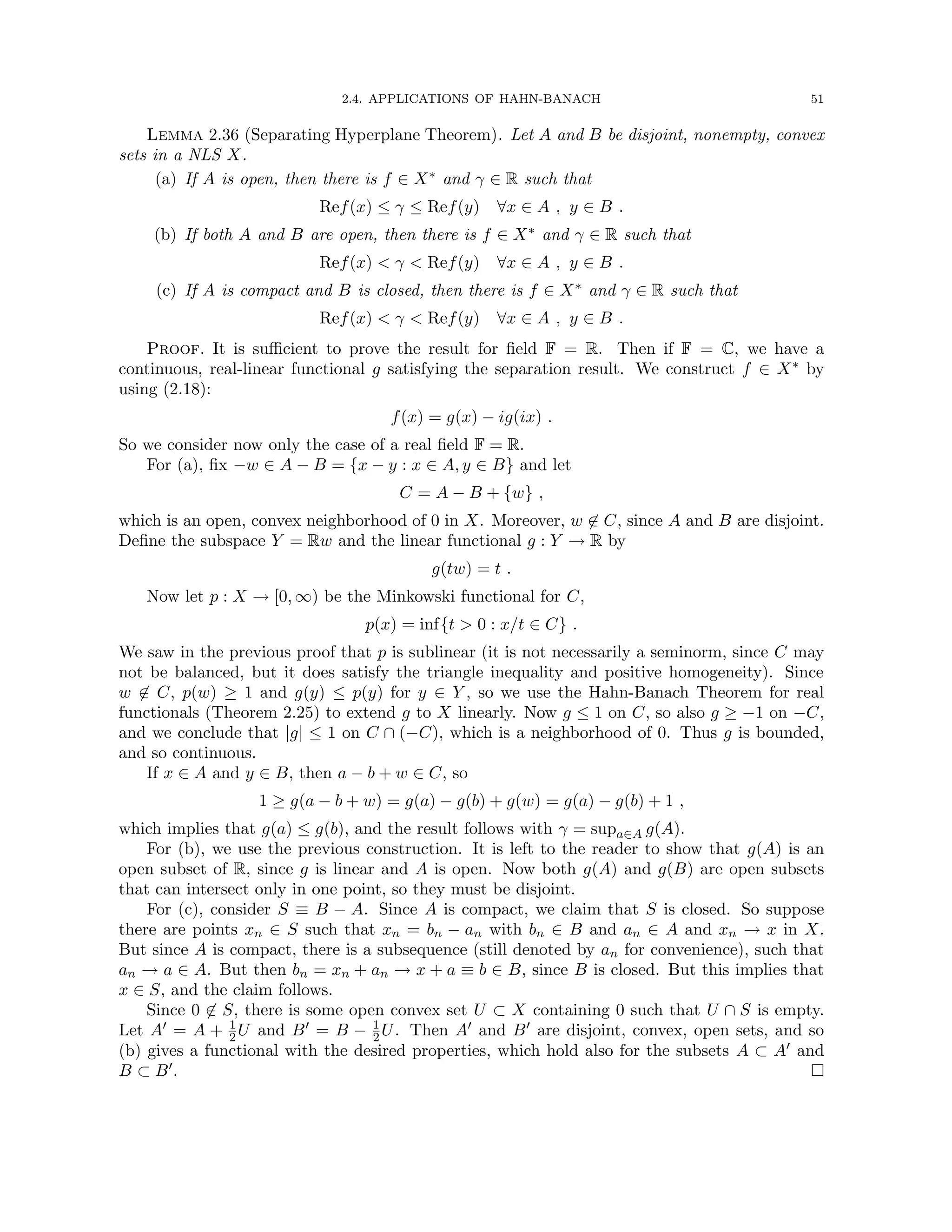

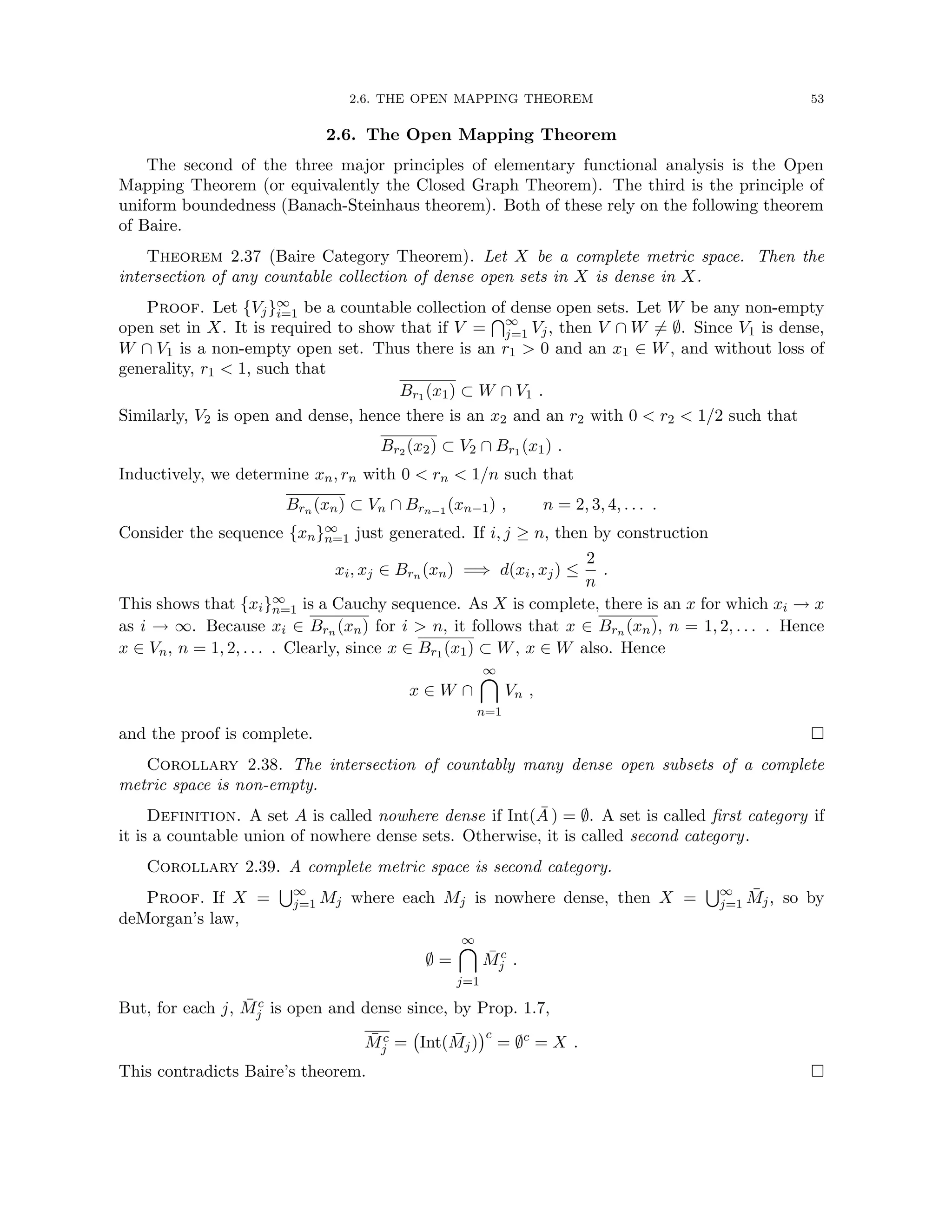
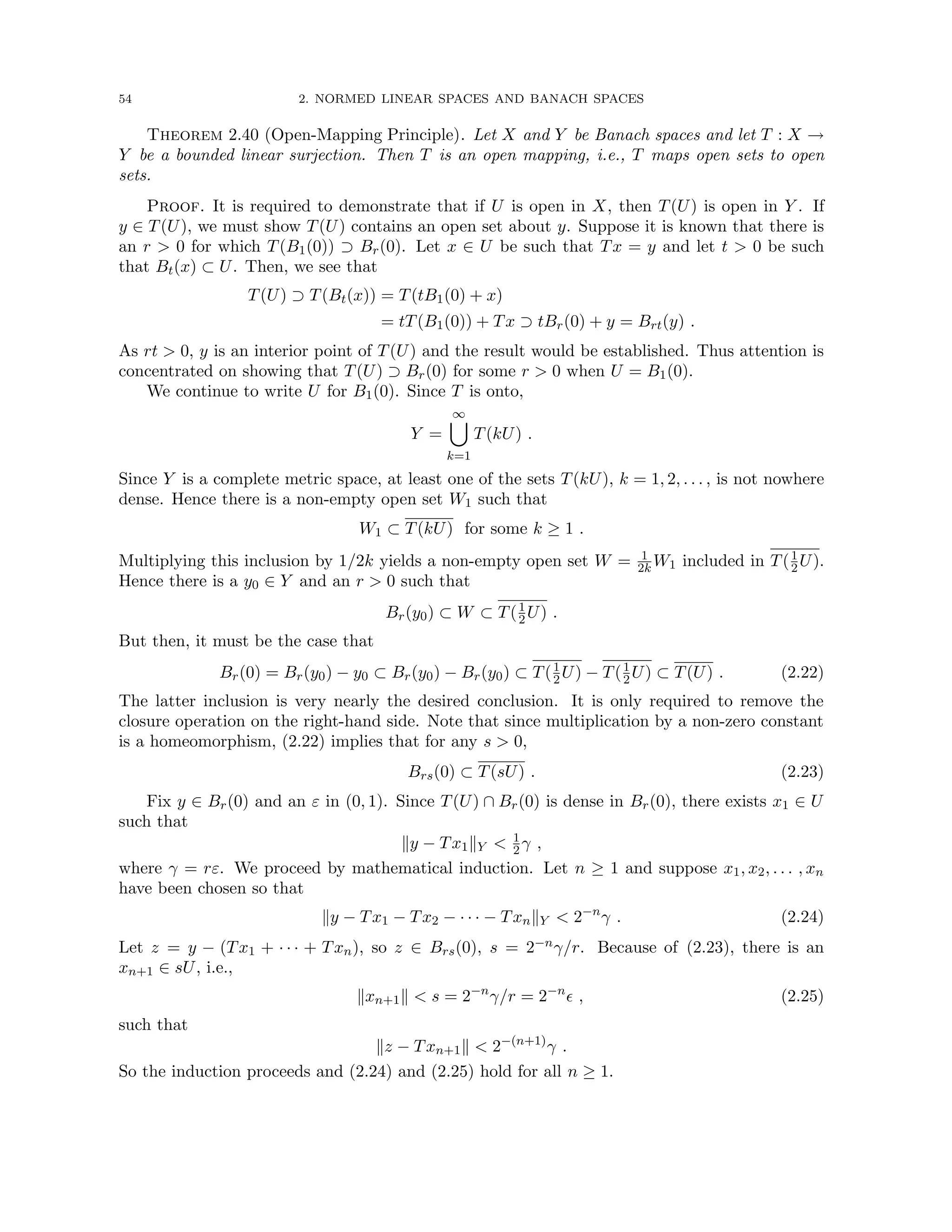
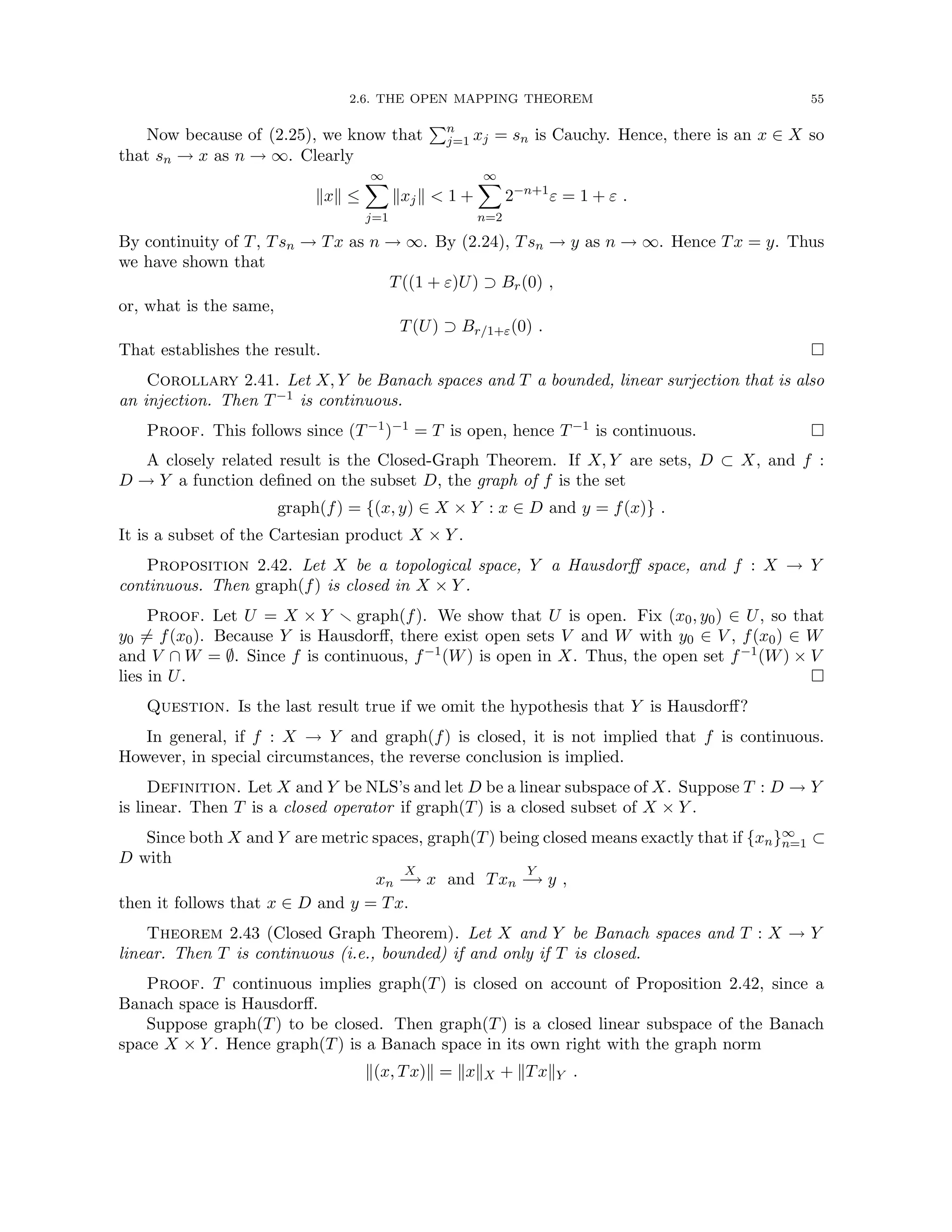
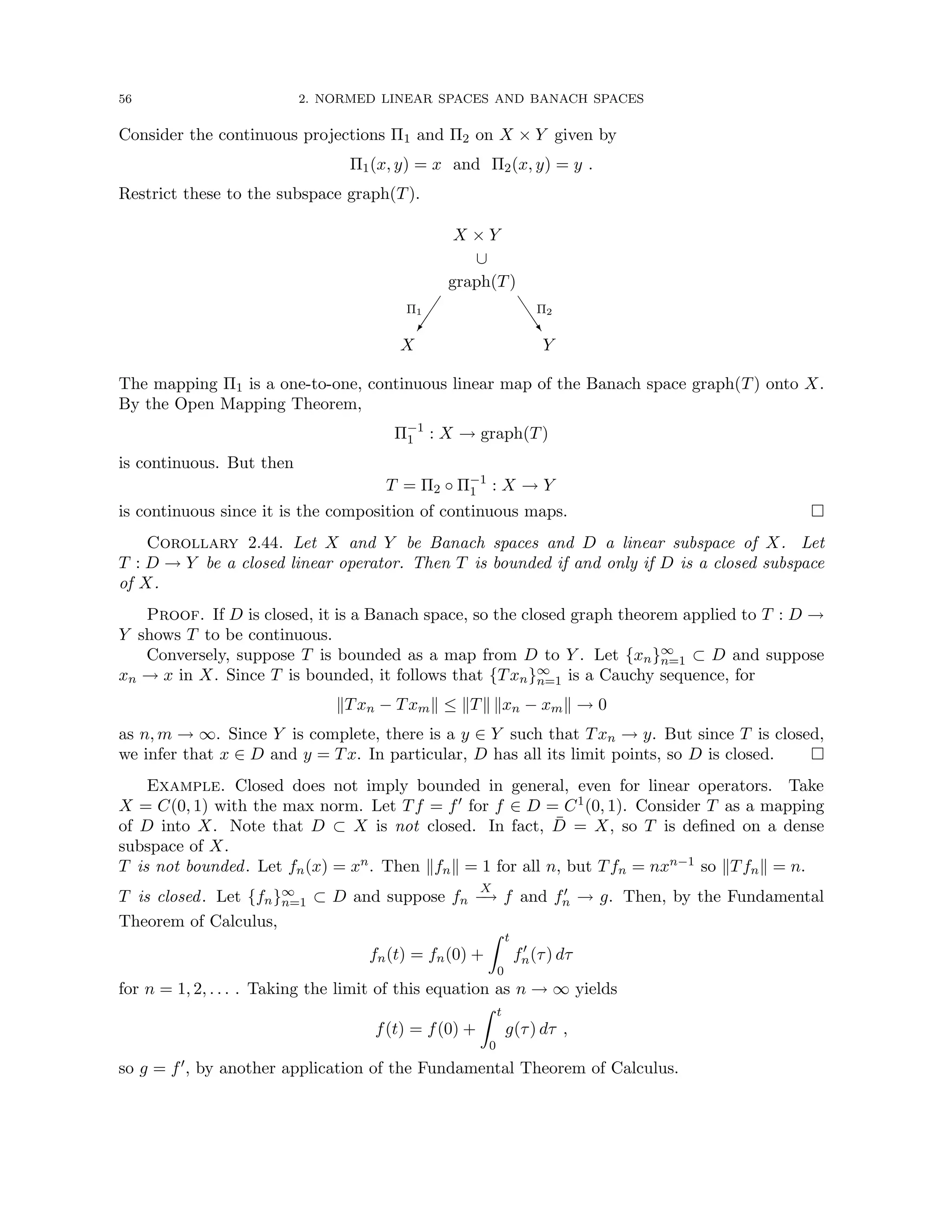
![2.7. UNIFORM BOUNDEDNESS PRINCIPLE 57
2.7. Uniform Boundedness Principle
The third basic result in Banach space theory is the Banach-Steinhauss Theorem, also known
as the Principle of Uniform Boundedness.
Theorem 2.45 (Uniform Boundedness Principle). Let X be a Banach space, Y a NLS and
{Tα}α∈I ⊂ B(X, Y ) a collection of bounded linear operators from X to Y . Then one of the
following two conclusions must obtain: either
(a) there is a constant M such that for all α ∈ I,
kTαkB(X,Y ) ≤ M ,
i.e., the Tα are uniformly bounded, or
(b) there is an x ∈ X such that
sup
α∈I
kTαxk = +∞ ,
i.e., there is a single fixed x ∈ X at which the Tαx are unbounded.
Proof. Define the function ϕ : X → [0, ∞] by
ϕ(x) = sup
α∈I
kTαxk ,
for x ∈ X. For n = 1, 2, 3, . . . , let
Vn = {x ∈ X : ϕ(x) n} .
For each α ∈ I, the map ϕα defined by
ϕα(x) = kTαxk
is continuous on X since it is the composition of two continuous maps. Thus the sets
{x : kTαxk n} = ϕ−1
α ((n, ∞))
are open, and consequently,
Vn =
[
α∈I
ϕ−1
α ((n, ∞))
is a union of open sets, so is itself open. Each Vn is either dense in X or it is not. If for some
N, VN is not dense in X, then there is an r 0 and an x0 ∈ X such that
Br(x0) ∩ VN = ∅ .
Therefore, if x ∈ Br(x0), then ϕ(x) ≤ N; thus, if kzk r, then for all α ∈ I,
kTα(x0 + z)k ≤ N .
Hence if kzk r, then for all α ∈ I,
kTα(z)k ≤ kTα(z + x0)k + kTα(x0)k ≤ N + kTαx0k ≤ 2N .
In consequence, we have
sup
α∈I
kTαk ≤
4N
r
,
and so condition (a) holds.
On the other hand, if all the Vn are dense, then they are all dense and open. By Baire’s
Theorem,
∞
n=1
Vn](https://image.slidesharecdn.com/appliedmathematicsmethods-230215152718-28efe5ed/75/applied-mathematics-methods-pdf-57-2048.jpg)
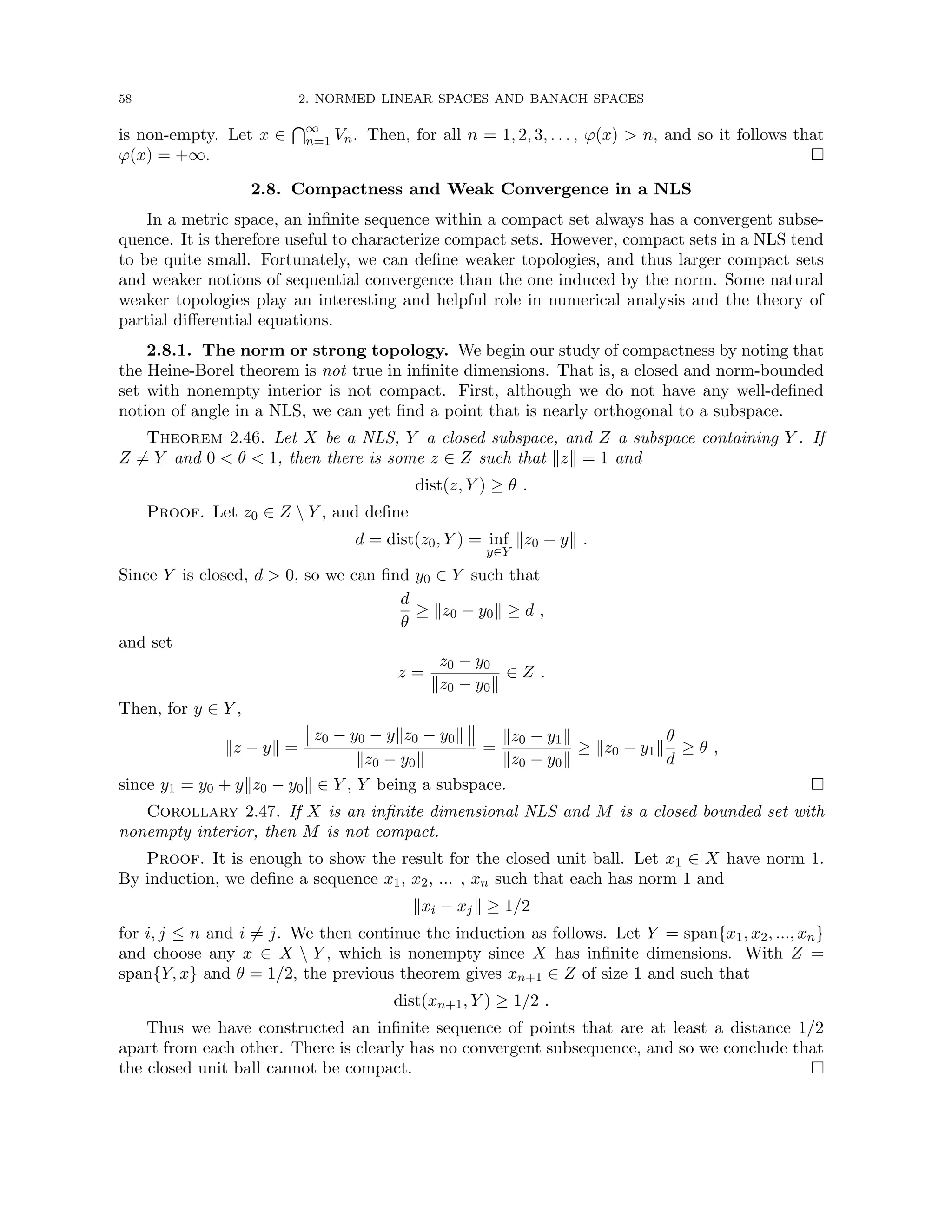
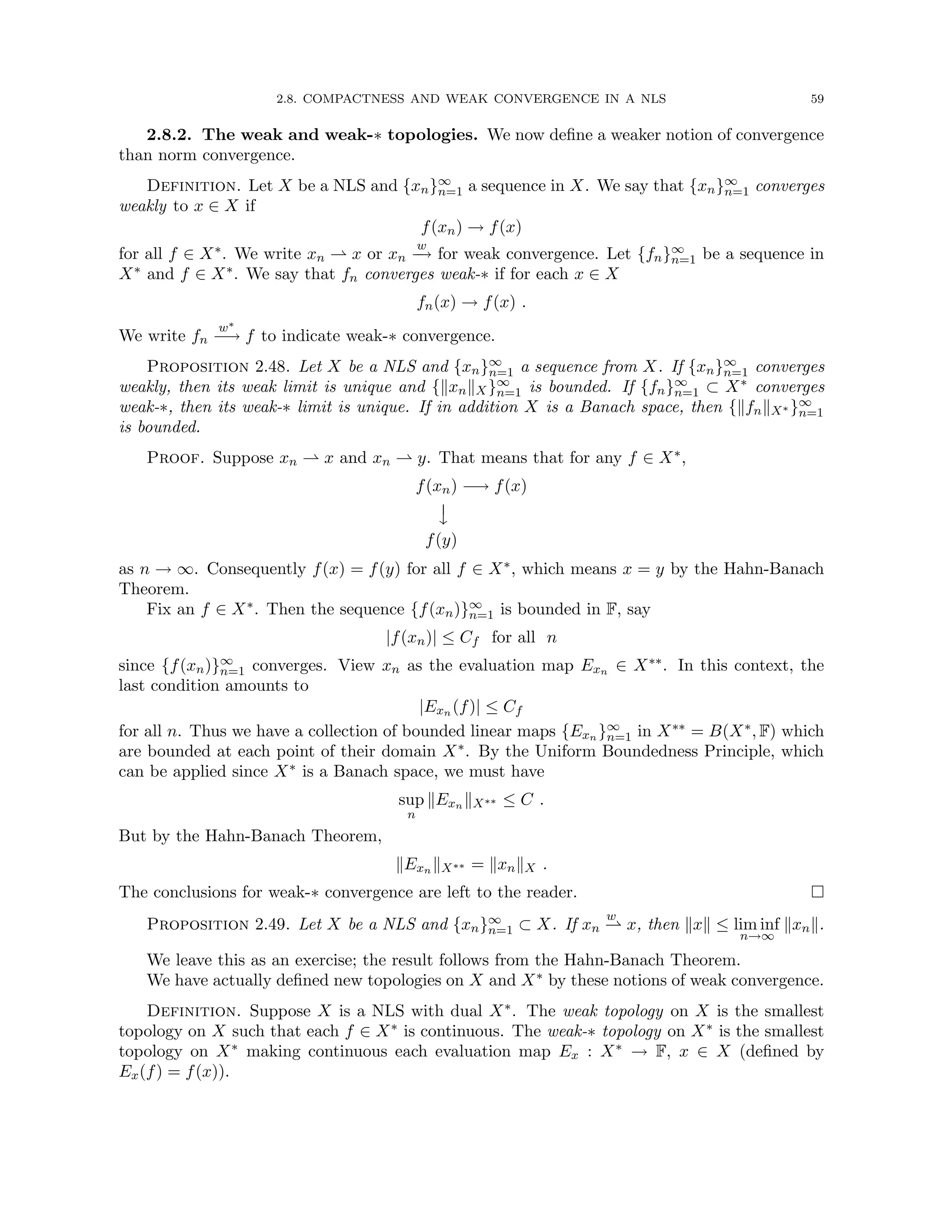
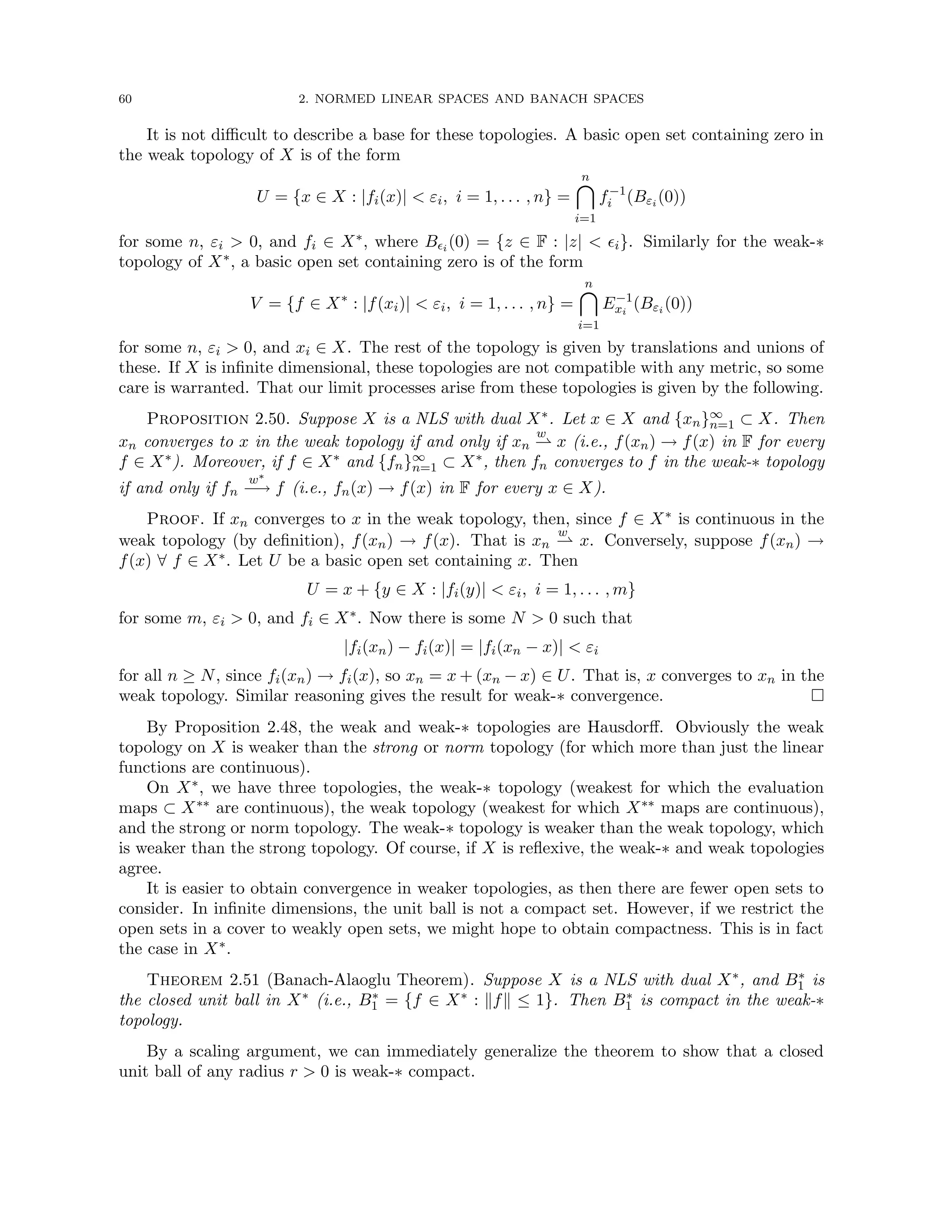
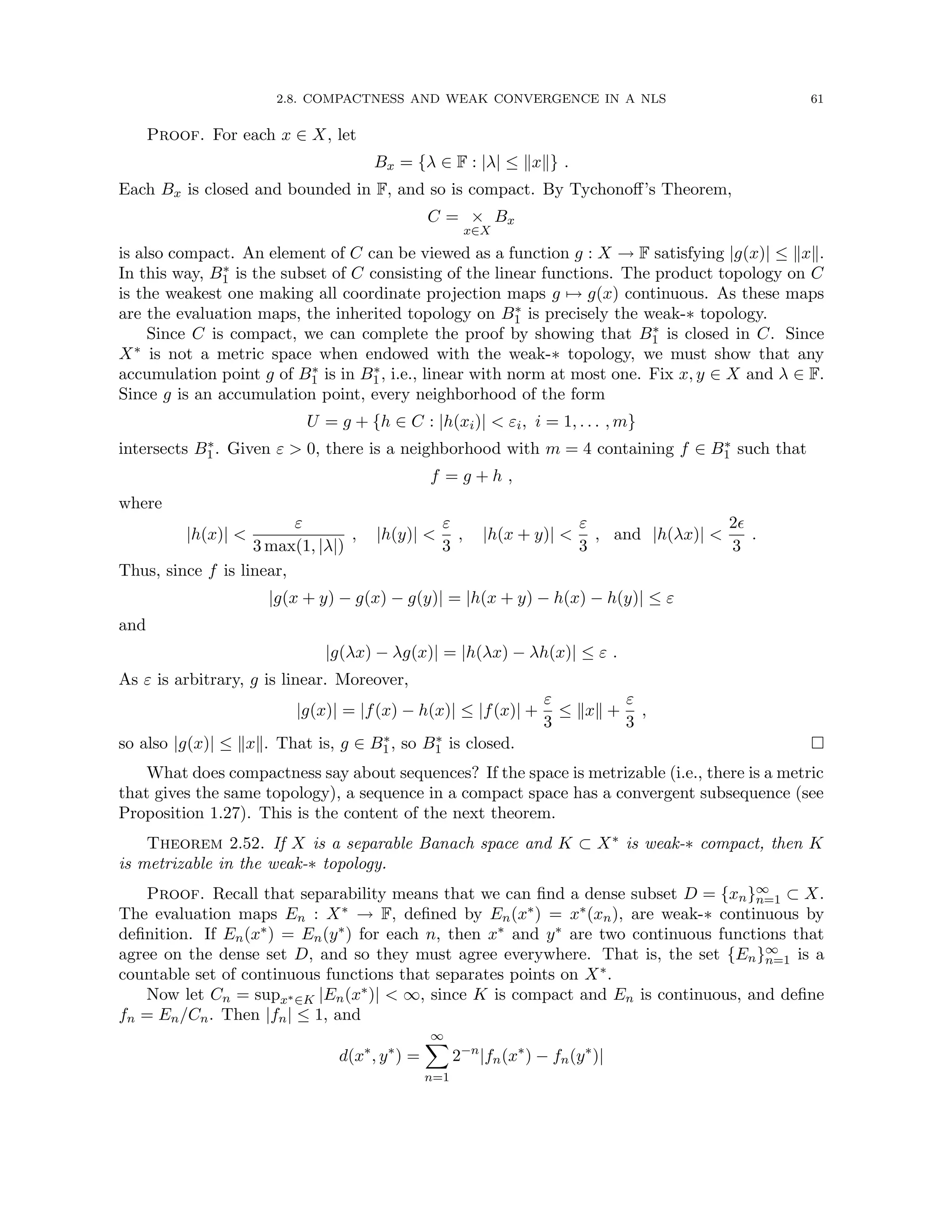


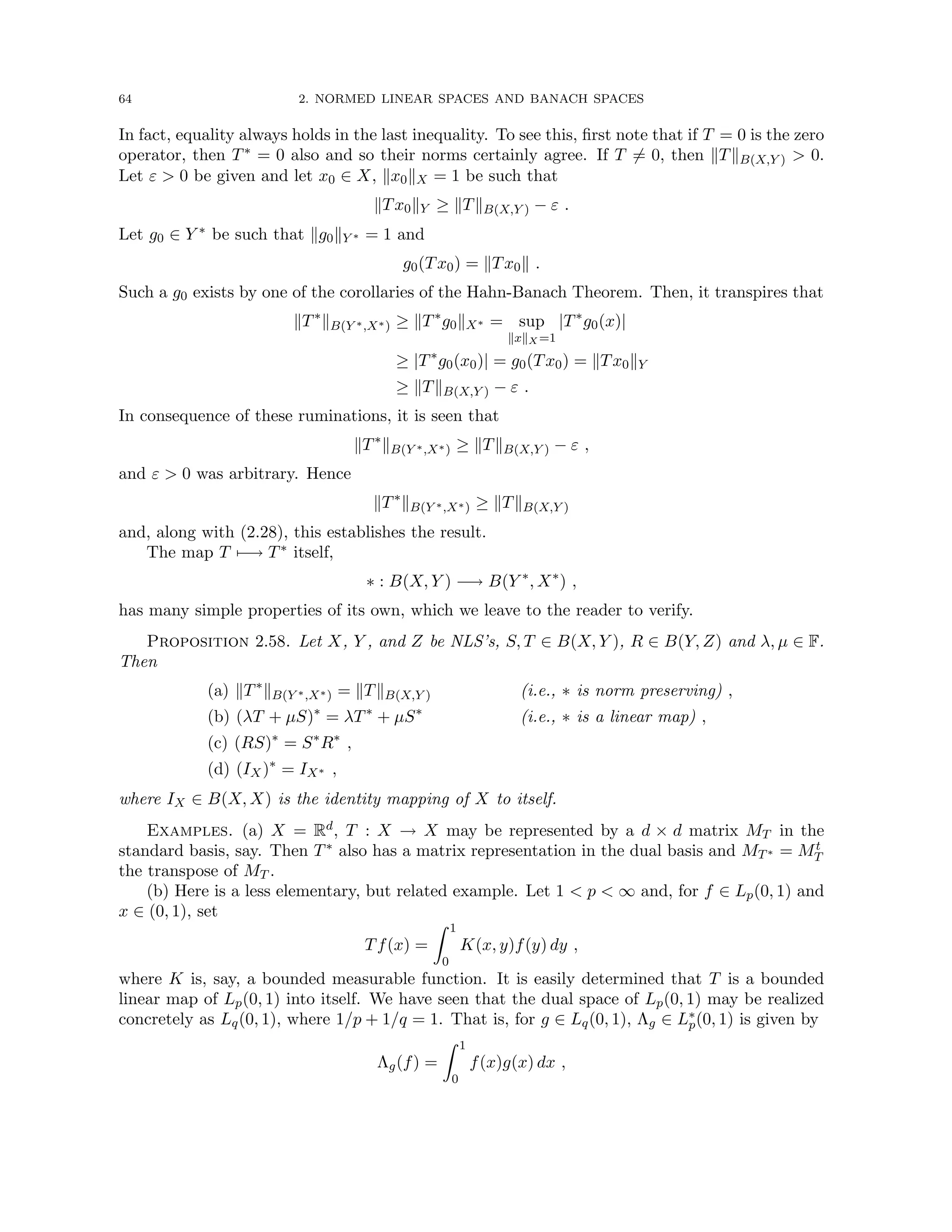
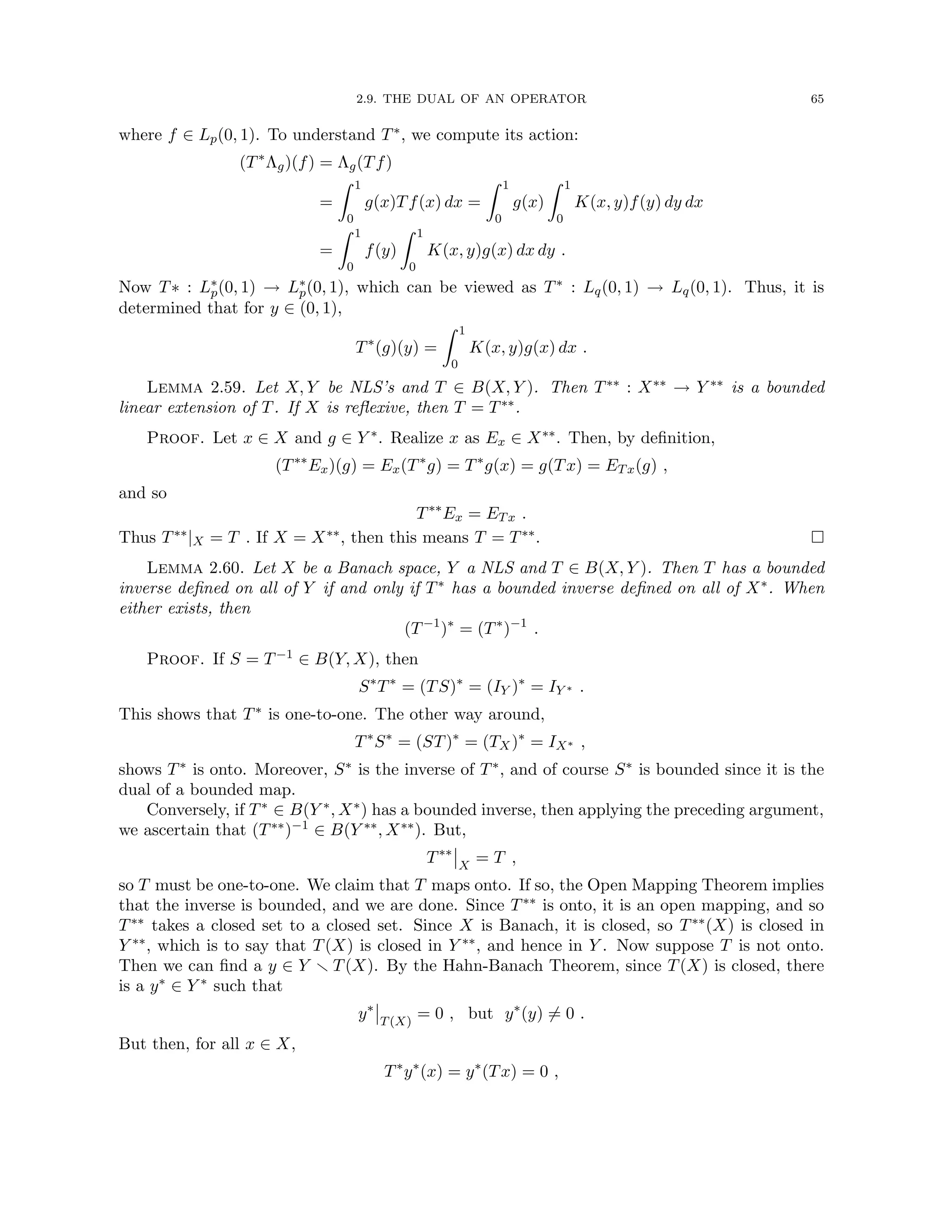
![66 2. NORMED LINEAR SPACES AND BANACH SPACES
whence T∗y∗ = 0, and y∗ = 0, since T∗ is one-to-one. But y∗ 6= 0 in Y ∗, and so we have our
contradiction, and T maps onto Y .
2.10. Exercises
1. Suppose that X is a vector space.
(a) If A, B ⊂ X are convex, show that A + B and A ∩ B are convex. What about A ∪ B and
A B?
(b) Show that 2A ⊂ A + A. When is it true that 2A = A + A?
2. Let (X, d) be a metric space.
(a) Show that
ρ(x, y) = min(1, d(x, y))
is also a metric.
(b) Show that U ⊂ X is open in (X, d) if and only if U is open in (X, ρ).
(c) Repeat the above for
σ(x, y) =
d(x, y)
1 + d(x, y)
.
3. Let X be a NLS, x0 be a fixed vector in X, and α 6= 0 a fixed scalar. Show that the mappings
x 7→ x + x0 and x 7→ αx are homeomorphisms of X onto itself.
4. Show that if X is a NLS, then X is homeomorphic to Br(0) for fixed r. [Hint: consider the
mapping x 7→
xr
1 + kxk
.]
5. In Rd, show that any two norms are equivalent. Hint: Consider the unit sphere, which is
compact.
6. Let X and Y be NLS over the same field, both having the same finite dimension n. Then
prove that X and Y are topologically isomorphic, where a topological isomorphism is defined
to be a mapping that is simultaneously an isomorphism and a homeomorphism.
7. Show that C([a, b]), | · |
, the set of real-valued continuous functions in the interval [a, b]
with the sup-norm (L∞-norm), is a Banach space.
8. If f ∈ Lp(Ω) show that
kfkp = sup
Z
Ω
f g dx = sup
Z
Ω
|f g| dx
where the supremum is taken over all g ∈ Lq(Ω) such that kgkq ≤ 1 and 1/p + 1/q = 1,
where 1 ≤ p, q ≤ ∞.
9. Suppose that Ω ⊂ Rd has finite measure and 1 ≤ p ≤ q ≤ ∞.
(a) Prove that if f ∈ Lq(Ω), then f ∈ Lp(Ω) and
kfkp ≤ (µ(Ω))1/p−1/q
kfkq .
(b) Prove that if f ∈ L∞(Ω), then
lim
p→∞
kfkp = kfk∞ .](https://image.slidesharecdn.com/appliedmathematicsmethods-230215152718-28efe5ed/75/applied-mathematics-methods-pdf-66-2048.jpg)
![2.10. EXERCISES 67
(c) Prove that if f ∈ Lp(Ω) for all 1 ≤ p ∞, and there is K 0 such that kfkp ≤ K, then
f ∈ L∞(Ω) and kfk∞ ≤ K.
10. Finite dimensional matrices.
(a) Let Mn×m be the set of matrices with real valued coefficients aij, for 1 ≤ i ≤ n and
1 ≤ j ≤ m. For every A ∈ Mn×m, define
kAk = max
x∈Rm
|Ax|Rn
|x|Rm
.
Show that Mn×m, k · k
is a NLS.
(b) Each A ∈ Mn×n defines a linear map of Rn into itself. Show that
kAk = max
|x|=|y|=1
yT
Ax ,
where yT is the transpose of y.
(c) Show that each A ∈ Mn×n is continuous.
(d) Prove that the convex hull is convex, and that it is the intersection of all convex subsets
of X containing A.
(e) If X is a normed linear space, prove that the convex hull of an open set is open.
(f) If X is a normed linear space, is the convex hull of a closed set always closed?
(g) Prove that if X is a normed linear space, then the convex hull of a bounded set is
bounded.
11. Prove that if X is a normed linear space and B = B1(0) is the unit ball, then X is infi-
nite dimensional if and only if B contains an infinite collection of non-overlapping balls of
diameter 1/2.
12. Prove that a subset A of a metric space (X, d) is bounded if and only if every countable
subset of A is bounded.
13. Consider (`p, | · |p).
(a) Prove that `p is a Banach space for 1 ≤ p ≤ ∞. Hint: Use that R is complete.
(b) Show that | · |p is not a norm for 0 p 1. Hint: First show the result on R2.
14. If an infinite dimensional vector space X is also a NLS and contains a sequence {en}∞
n=1
with the property that for every x ∈ X there is a unique sequence of scalars {αn}∞
n=1 such
that
kx − (α1e1 + ... + αnen)k → 0 as n → ∞ ,
then {en}∞
n=1 is called a Schauder basis for X, and we have the expansion of x
x =
∞
X
n=1
αnen .
(a) Find a Schauder basis for `p, 1 ≤ p ∞.
(b) Show that if a NLS has a Schauder basis, then it is separable. [Remark: The converse is
not true.]](https://image.slidesharecdn.com/appliedmathematicsmethods-230215152718-28efe5ed/75/applied-mathematics-methods-pdf-67-2048.jpg)
![68 2. NORMED LINEAR SPACES AND BANACH SPACES
15. Let Y be a subspace of a vector space X. The coset of an element x ∈ X with respect to Y
is denoted by x + Y and is defined to be the set
x + Y = {z ∈ X : z = x + y for some y ∈ Y } .
Show that the distinct cosets form a partition of X. Show that under algebraic operations
defined by
(x1 + Y ) + (x2 + Y ) = (x1 + x2) + Y and λ(x + Y ) = λx + Y ,
for any x1, x2, x ∈ X and λ in the field, these cosets form a vector space. This space is called
the quotient space of X by (or modulo Y , and it is denoted X/Y .
16. Let Y be a closed subspace of a NLS X. Show that a norm on the quotient space X/Y is
given for x̂ ∈ X/Y by
kx̂kX/Y = inf
x∈x̂
kxkX .
17. If X and Y are NLS, then the product space X × Y is also a NLS with any of the norms
k(x, y)kX×Y = max(kxkX, kykY )
or, for any 1 ≤ p ∞,
k(x, y)kX×Y = (kxkp
X + kykp
Y )1/p
.
Why are these norms equivalent?
18. If X and Y are Banach spaces, prove that X × Y is a Banach space.
19. Let T : C([0, 1]) → C([0, 1]) be defined by
y(t) =
Z t
0
x(τ) dτ .
Find the range R(T) of T, and show that T is invertible on its range, T−1 : R(T) → C([0, 1]).
Is T−1 linear and bounded?
20. Show that on C([a, b]), for any y ∈ C([a, b]) and scalars α and β, the functionals
f1(x) =
Z b
a
x(t) y(t) dt and f2(x) = αx(a) + βx(b)
are linear and bounded.
21. Find the norm of the linear functional f defined on C([−1, 1]) by
f(x) =
Z 0
−1
x(t) dt −
Z 1
0
x(t) dt .
22. Recall that f = {{xn}∞
n=1 : only finitely many xn 6= 0} is a NLS with the sup-norm |{xn}| =
supn |xn|. Let T : f → f be defined by
T({xn}∞
n=1) = {nxn}∞
n=1 .
Show that T is linear but not continuous (i.e., not bounded).
23. The space C1([a, b]) is the NLS of all continuously differentiable functions defined on [a, b]
with the norm
kxk = sup
t∈[a,b]
|x(t)| + sup
t∈[a,b]
|x0
(t)| .](https://image.slidesharecdn.com/appliedmathematicsmethods-230215152718-28efe5ed/75/applied-mathematics-methods-pdf-68-2048.jpg)
![2.10. EXERCISES 69
(a) Show that k · k is indeed a norm.
(b) Show that f(x) = x0 (a + b)/2
defines a continuous linear functional on C1([a, b]).
(c) Show that f defined above is not bounded on the subspace of C([a, b]) consisting of all
continuously differentiable functions with the norm inherited from C([a, b]).
24. Suppose X is a vector space. The algebraic dual of X is the set of all linear functionals
on X, and is also a vector space. Suppose also that X is a NLS. Show that X has finite
dimension if and only if the algebraic dual and the dual space X∗ coincide.
25. Let X be a NLS and M a nonempty subset. The annihilator Ma of M is defined to be the
set of all bounded linear functionals f ∈ X∗ such that f restricted to M is zero. Show that
Ma is a closed subspace of X∗. What are Xa and {0}a?
26. Define the operator T by the formula
T(f)(x) =
Z b
a
K(x, y) f(y) dy .
Suppose that K ∈ Lq([a, b] × [a, b]), where q lies in the range 1 ≤ q ≤ ∞. Determine the
values of p for which T is necessarily a bounded linear operator from Lp(a, b) to Lq(a, b).
In particular, if a and b are both finite, show that K ∈ L∞([a, b] × [a, b]) implies T to be
bounded on all the Lp-spaces.
27. Let U = Br(0) = {x : kxk r} be an open ball about 0 in a real normed linear space, and
let y 6∈ Ū. Show that there is a bounded linear functional f that separates U from y. (That
is, U and y lie in opposite half spaces determined by f, which is to say there is an α such
that U lies in {x : f(x) α} and f(y) α.)
28. Prove that L2([0, 1]) is of the first category in L1([0, 1]). (Recall that a set is of first category
if it is a countable union of nowhere dense sets, and that a set is nowhere dense if its closure
has an empty interior.) Hint: Show that Ak = {f : kfkL2 ≤ k} is closed in L1 but has empty
interior.
29. If a Banach space X is reflexive, show that X∗ is also reflexive. (∗) Is the converse true?
Give a proof or a counterexample.
30. Let y = (y1, y2, y3, ...) ∈ C∞ be a vector of complex numbers such that
P∞
i=1 yixi converges
for every x = (x1, x2, x3, ...) ∈ C0, where C0 = {x ∈ C∞ : xi → 0 as i → ∞}. Prove that
∞
X
i=1
|yi| ∞ .
31. Let X and Y be normed linear spaces, T ∈ B(X, Y ), and {xn}∞
n=1 ⊂ X. If xn
w
* x, prove
that Txn
w
* Tx in Y . Thus a bounded linear operator is weakly sequentially continuous. Is
a weakly sequentially continuous linear operator necessarily bounded?
32. Suppose that X is a Banach space, M and N are linear subspaces, and that X = M ⊕ N,
which means that
X = M + N = {m + n : m ∈ M, n ∈ N}
and M ∩ N is the trivial linear subspace consisting only of the zero element. Let P denote
the projection of X onto M. That is, if x = m + n, then
P(x) = m](https://image.slidesharecdn.com/appliedmathematicsmethods-230215152718-28efe5ed/75/applied-mathematics-methods-pdf-69-2048.jpg)
![70 2. NORMED LINEAR SPACES AND BANACH SPACES
Show that P is well defined and linear. Prove that P is bounded if and only if both M and
N are closed.
33. Let X be a Banach space, Y a NLS, and Tn ∈ B(X, Y ) such that {Tnx}∞
n=1 is a Cauchy
sequence in Y . Show that {kTnk}∞
n=1 is bounded. If, in addition, Y is a Banach space, show
that if we define T by Tnx → Tx, then T ∈ B(X, Y ).
34. Let X be the normed space of sequences of complex numbers x = {xi}∞
i=1 with only finitely
many nonzero terms and norm defined by kxk = supi |xi|. Let T : X → X be defined by
y = Tx = {x1,
1
2
x2,
1
3
x3, ...} .
Show that T is a bounded linear map, but that T−1 is unbounded. Why does this not
contradict the Open Mapping Theorem?
35. Give an example of a function that is closed but not continuous.
36. For each α ∈ R, let Eα be the set of all continuous functions f on [−1, 1] such that f(0) = α.
Show that the Eα are convex, and that each is dense in L2([−1, 1]).
37. Suppose that X, Y , and Z are Banach spaces and that T : X × Y → Z is bilinear and
continuous. Prove that there is a constant M ∞ such that
kT(x, y)k ≤ Mkxk kyk for all x ∈ X, y ∈ Y .
Is completeness needed here?
38. Prove that a bilinear map is continuous if it is continuous at the origin (0, 0).
39. Consider X = C([a, b]), the continuous functions defined on [a, b] with the maximum norm.
Let {fn}∞
n=1 be a sequence in X and suppose that fn
w
* f. Prove that {fn}∞
n=1 is pointwise
convergent. That is,
fn(x) → f(x) for all x ∈ [a, b] .
Prove that a weakly convergent sequence in C1([a, b]) is convergent in C([a, b]). (∗) Is this
still true when [a, b] is replaced by R?
40. Let X be a normed linear space and Y a closed subspace. Show that Y is weakly sequentially
closed.
41. Let X be a normed linear space. We say that a sequence {xn}∞
n=1 ⊂ X is weakly Cauchy
if {Txn}∞
n=1 is Cauchy for all T ∈ X∗, and we say that X is weakly complete if each weak
Cauchy sequence converges weakly. If X is reflexive, prove that X is weakly complete.
42. Show that every finite dimensional vector space is reflexive.
43. Show that C([0, 1]) is not reflexive.
44. If X and Y are Banach spaces, show that E ⊂ B(X, Y ) is equicontinuous if, and only if,
there is an M ∞ such that kTk ≤ M for all T ∈ E.
45. Let X be a Banach space and T ∈ X∗ = B(X, F). Identify the range of T∗ ∈ B(F, X∗).
46. Let X be a Banach space, S, T ∈ B(X, X), and I be the identity map.
(a) Show by example that ST = I does not imply TS = I.
(b) If T is compact, show that S(I − T) = I if, and only if, (I − T)S = I.
(c) If S = (I − T)−1 exists for some T compact, show that I − S is compact.](https://image.slidesharecdn.com/appliedmathematicsmethods-230215152718-28efe5ed/75/applied-mathematics-methods-pdf-70-2048.jpg)
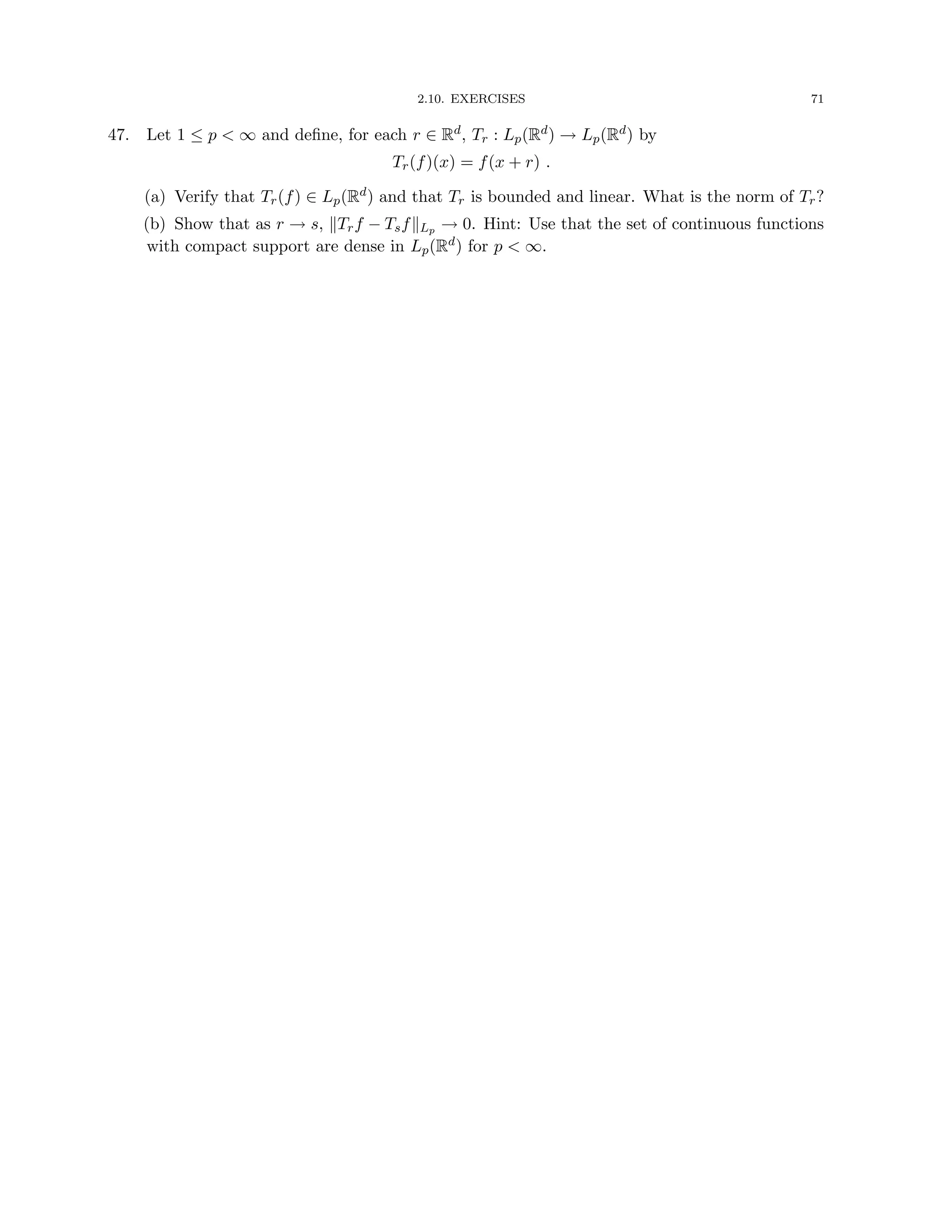

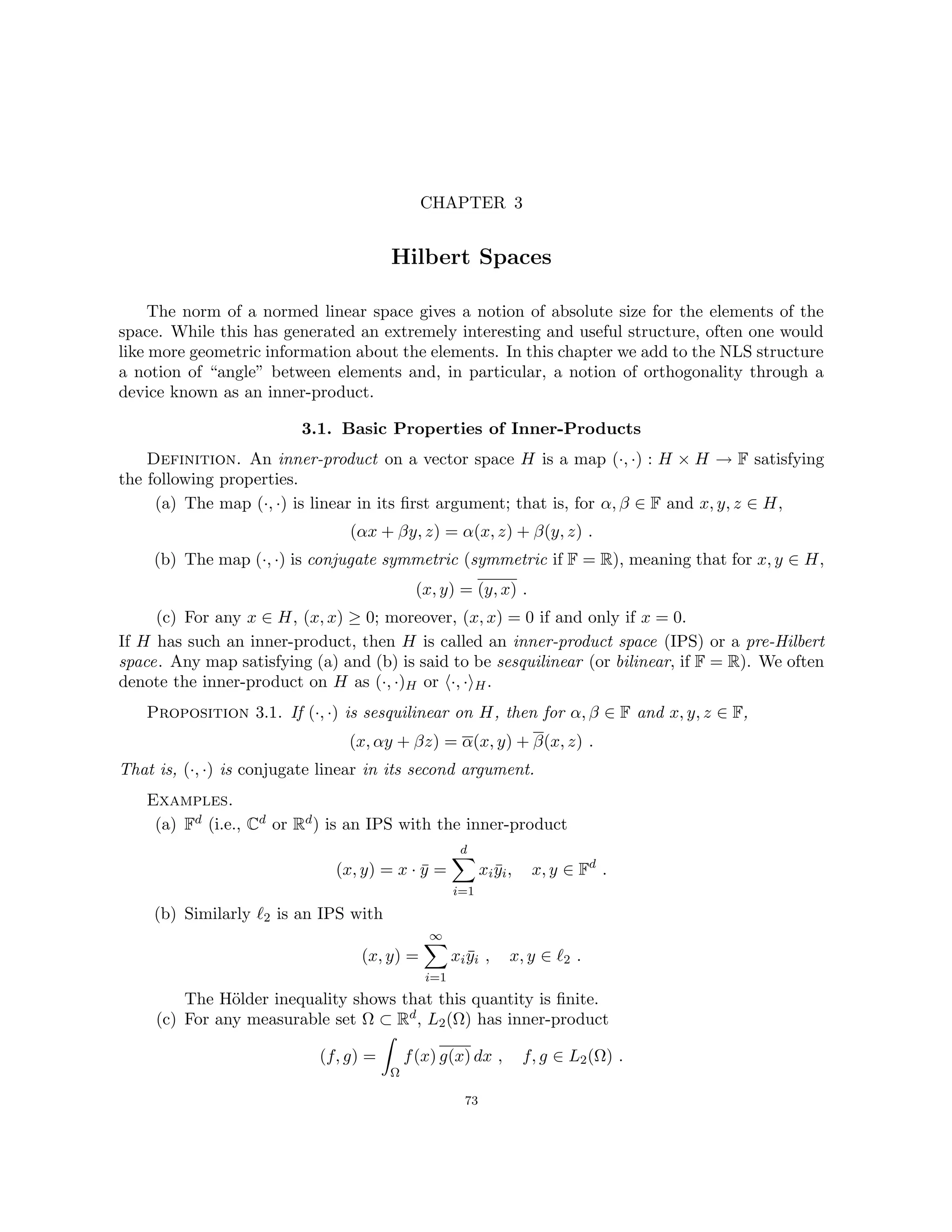
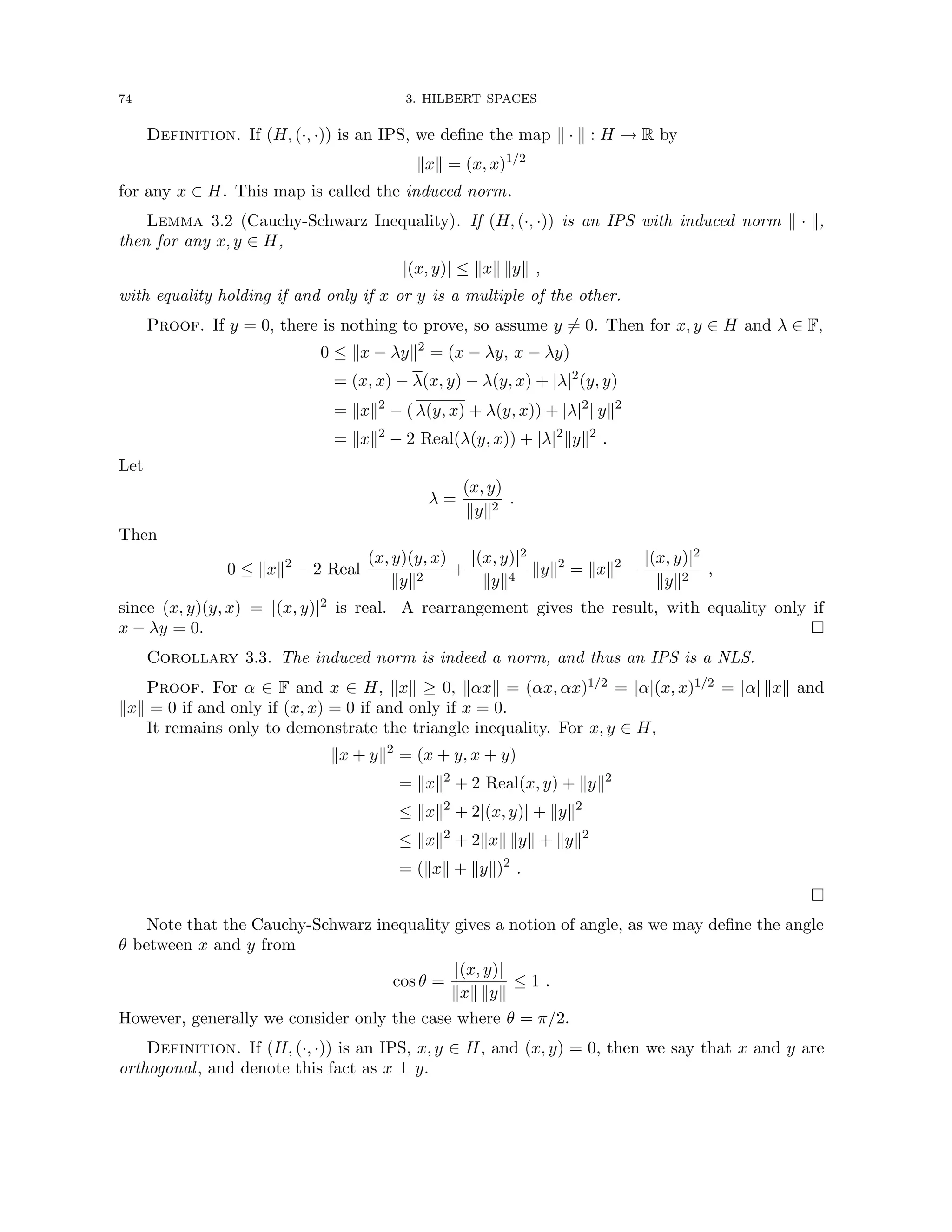
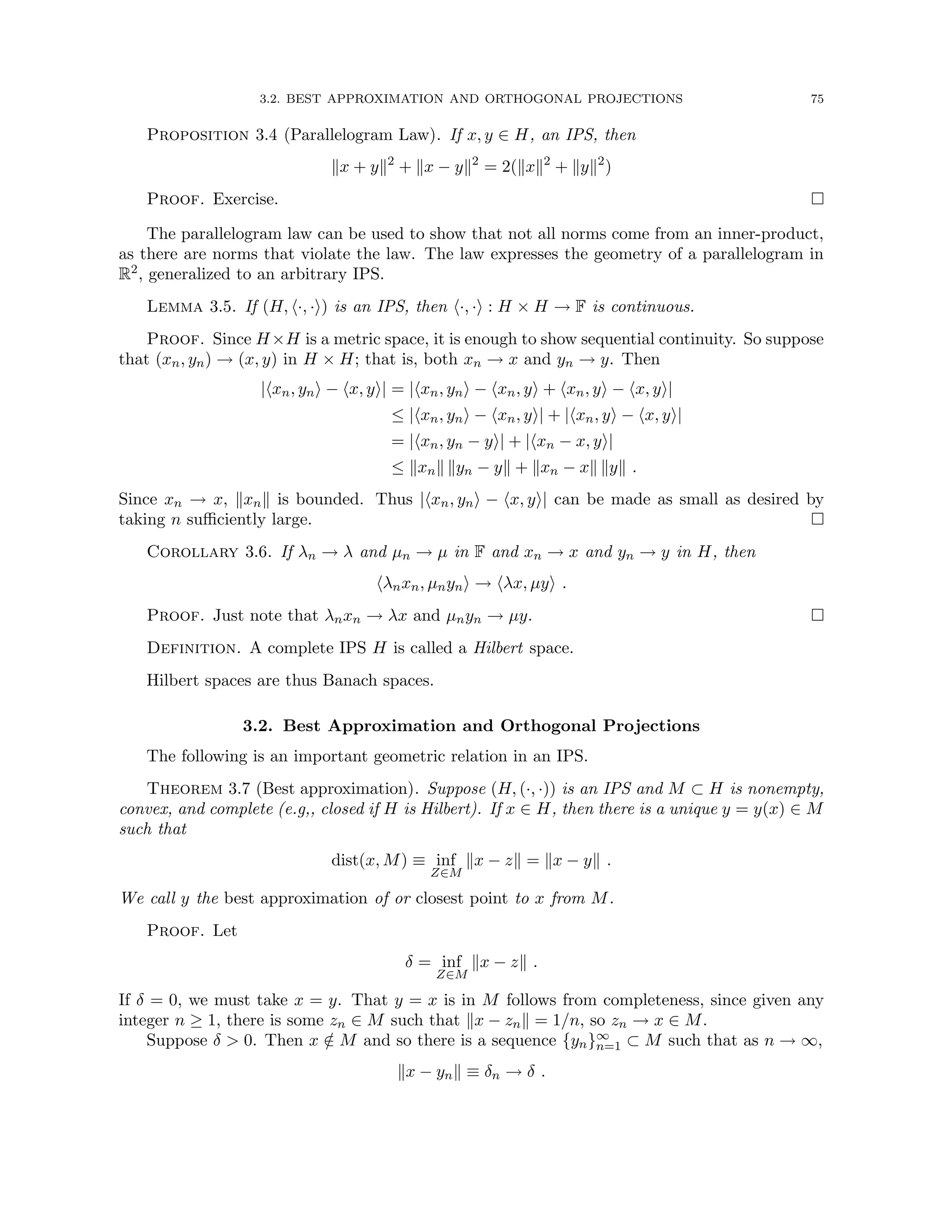

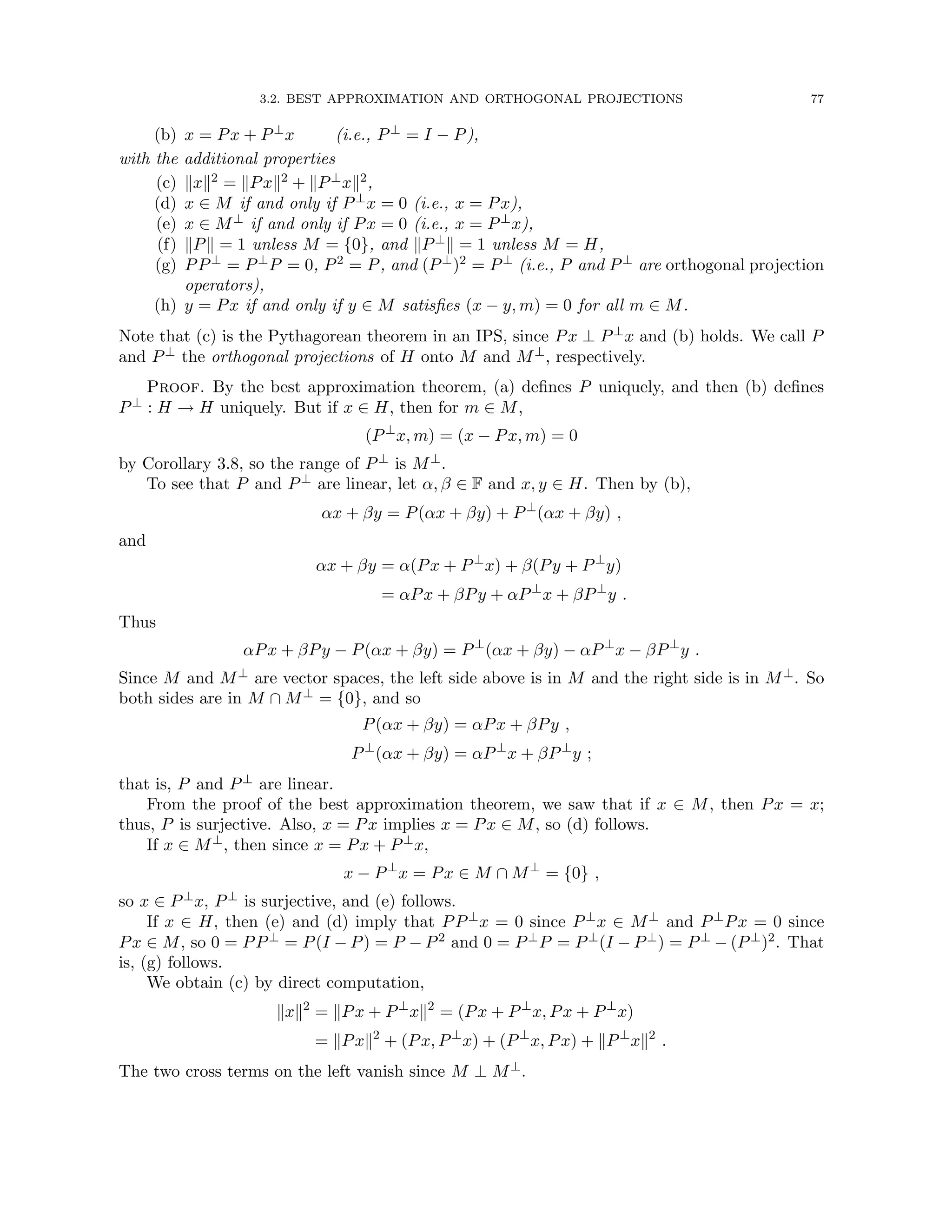
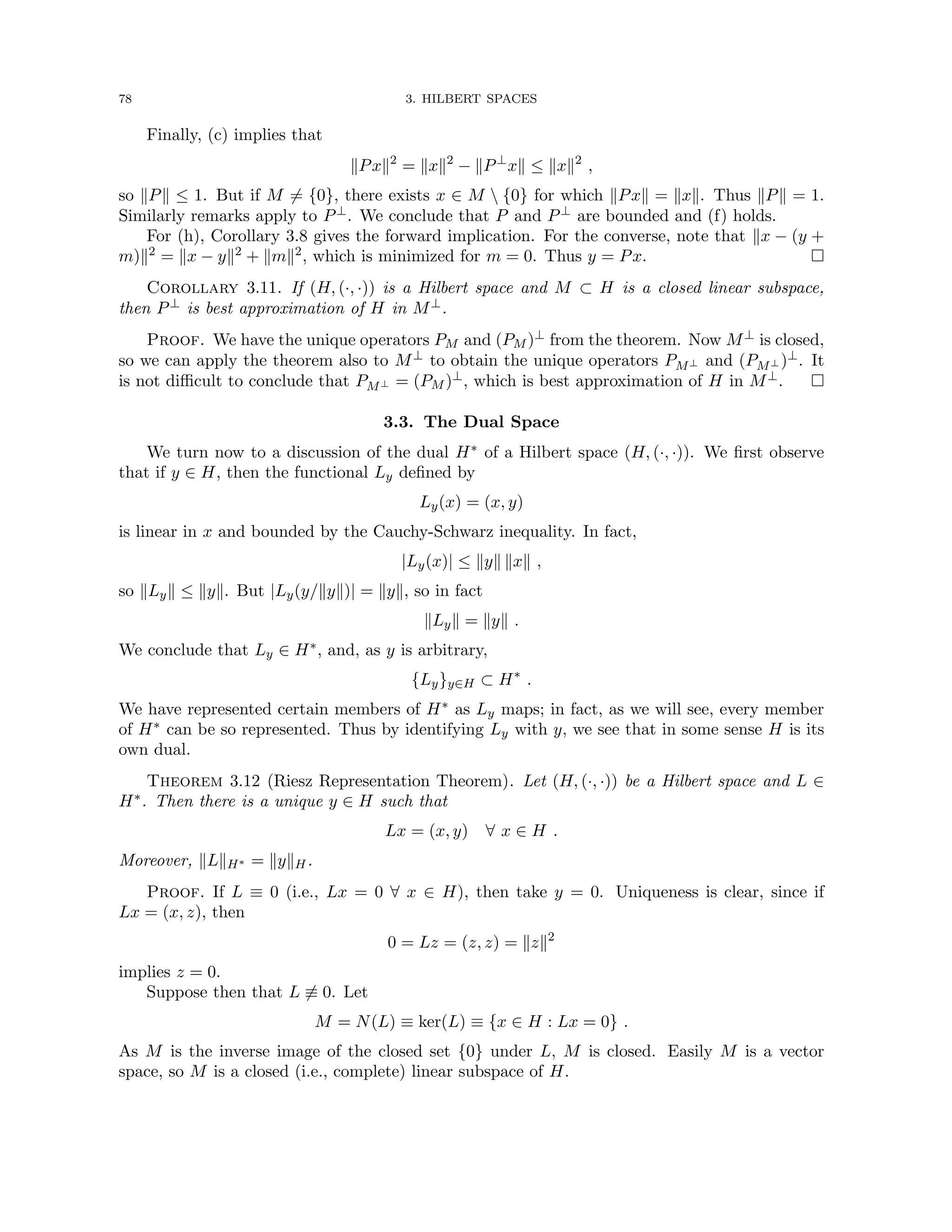
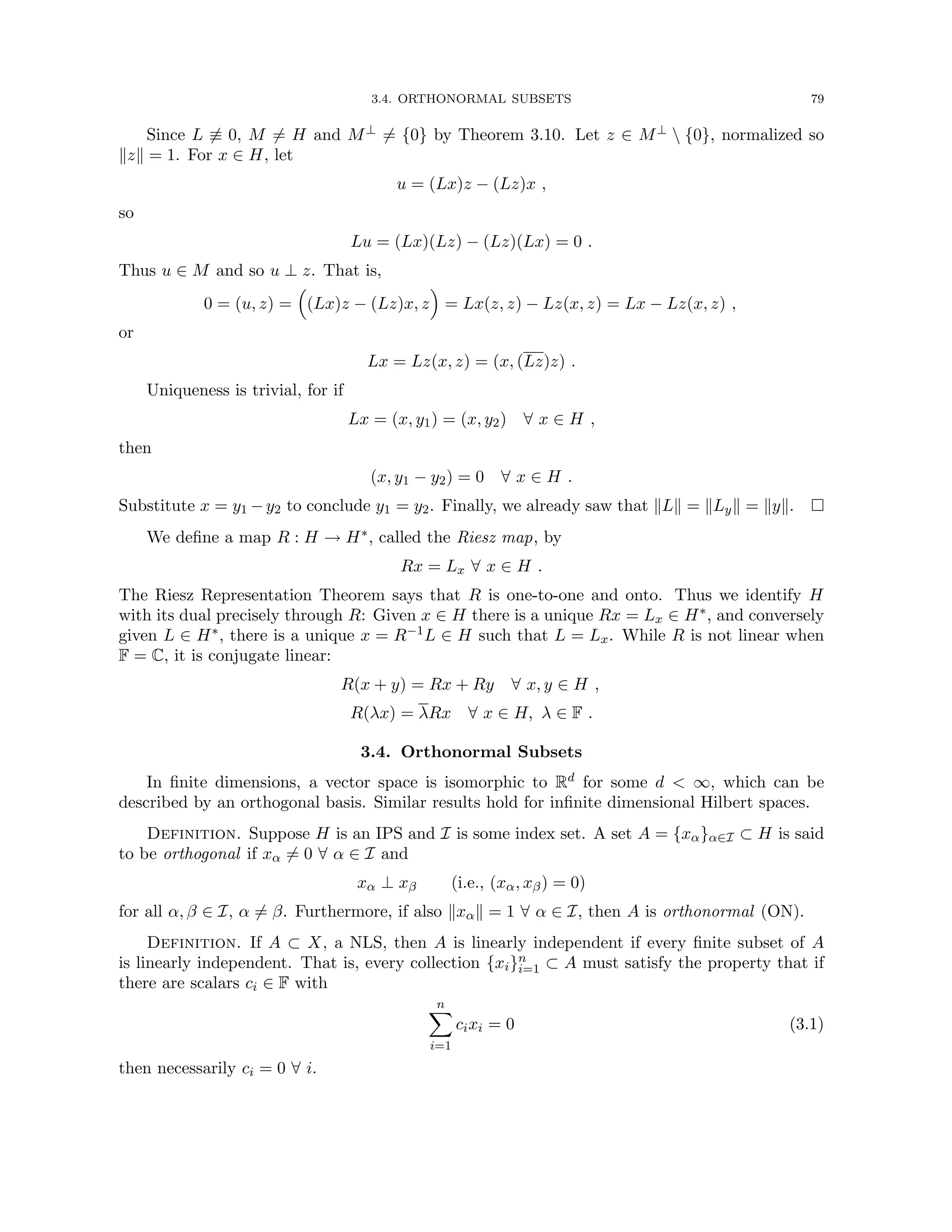

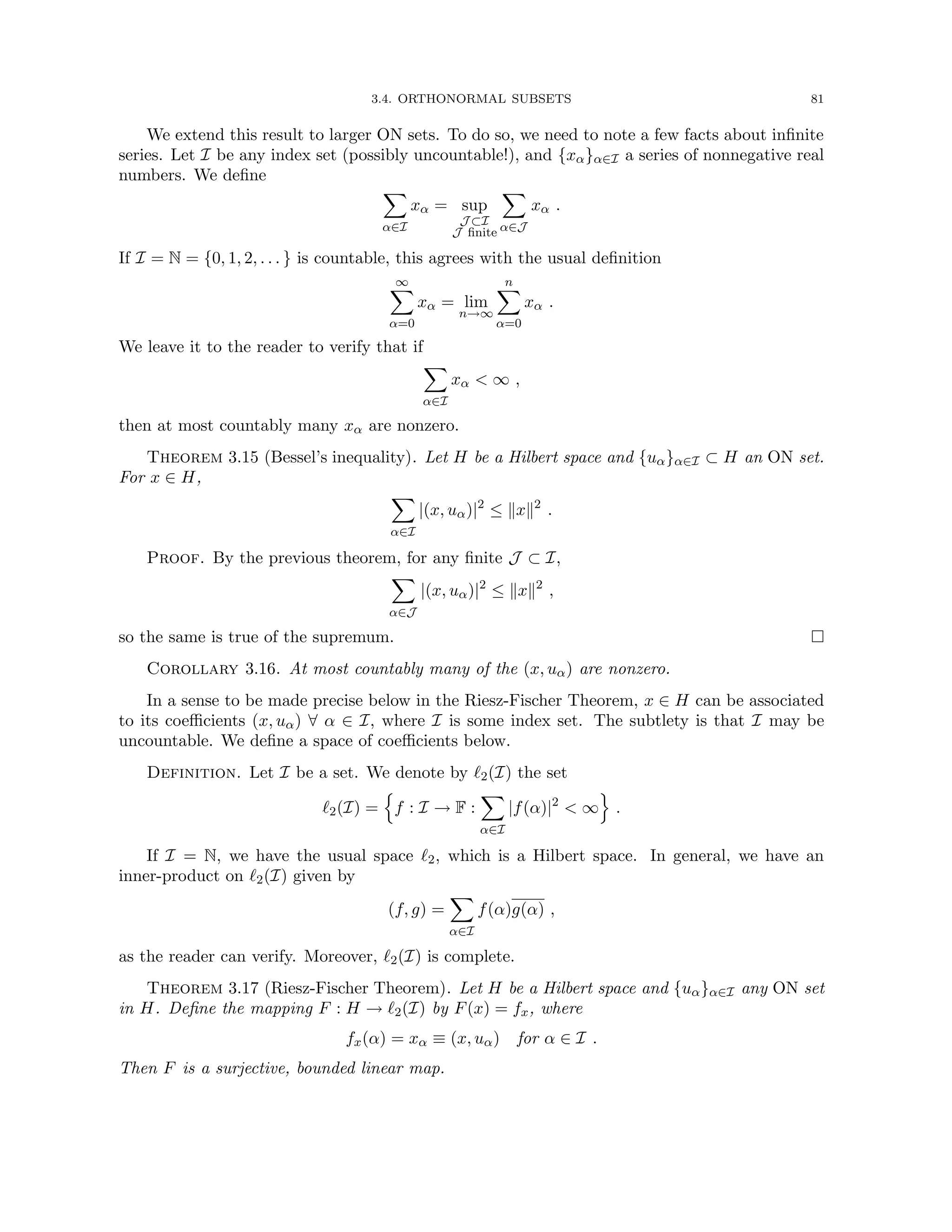
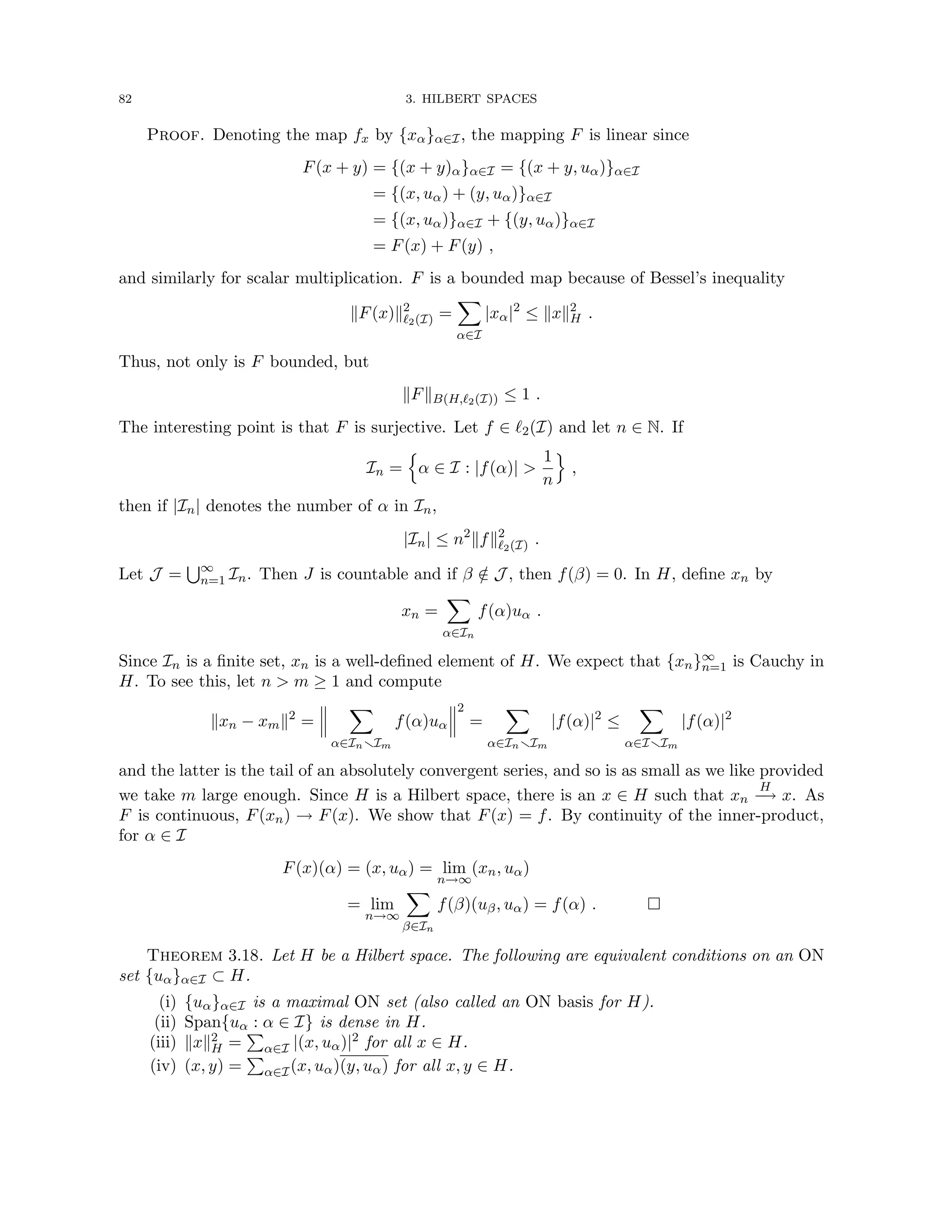
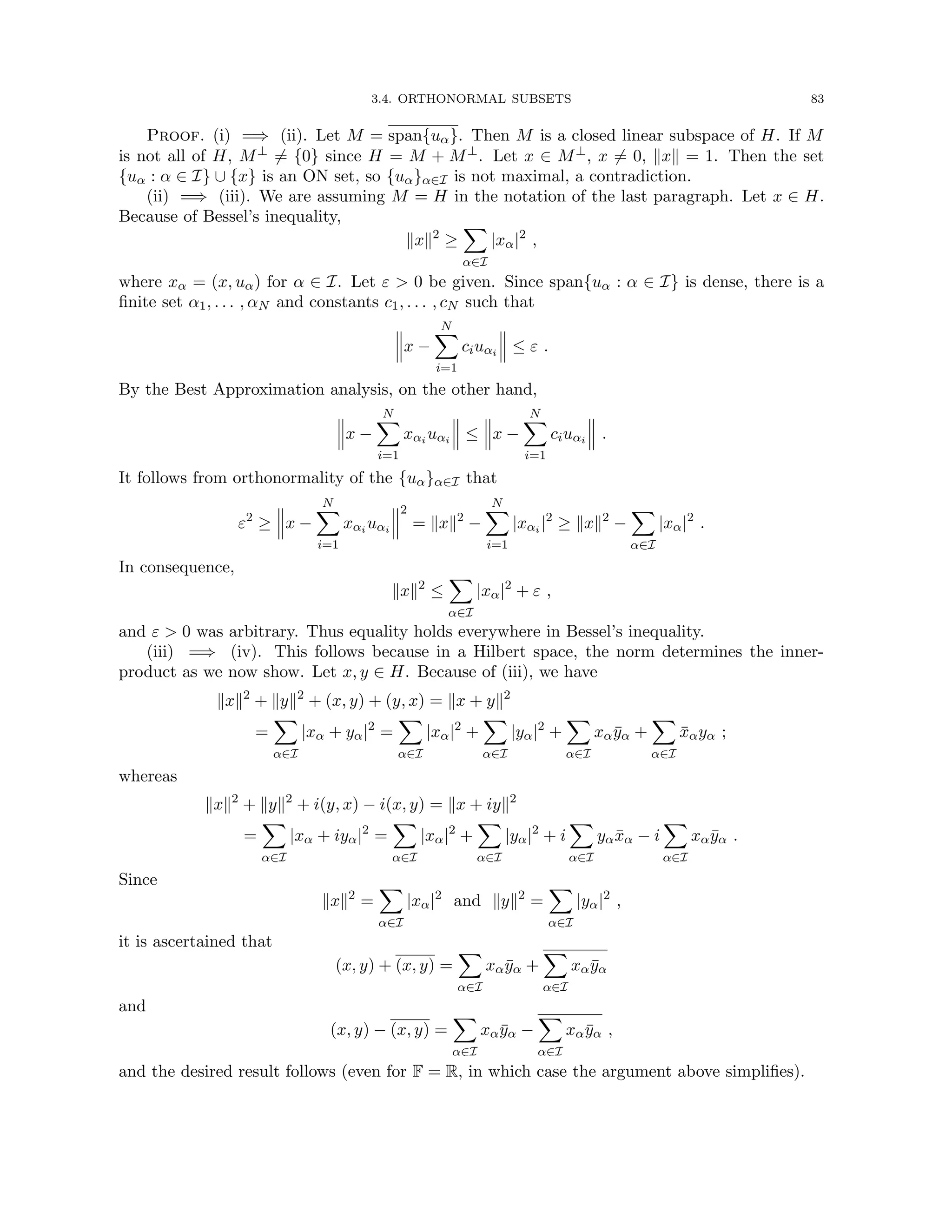
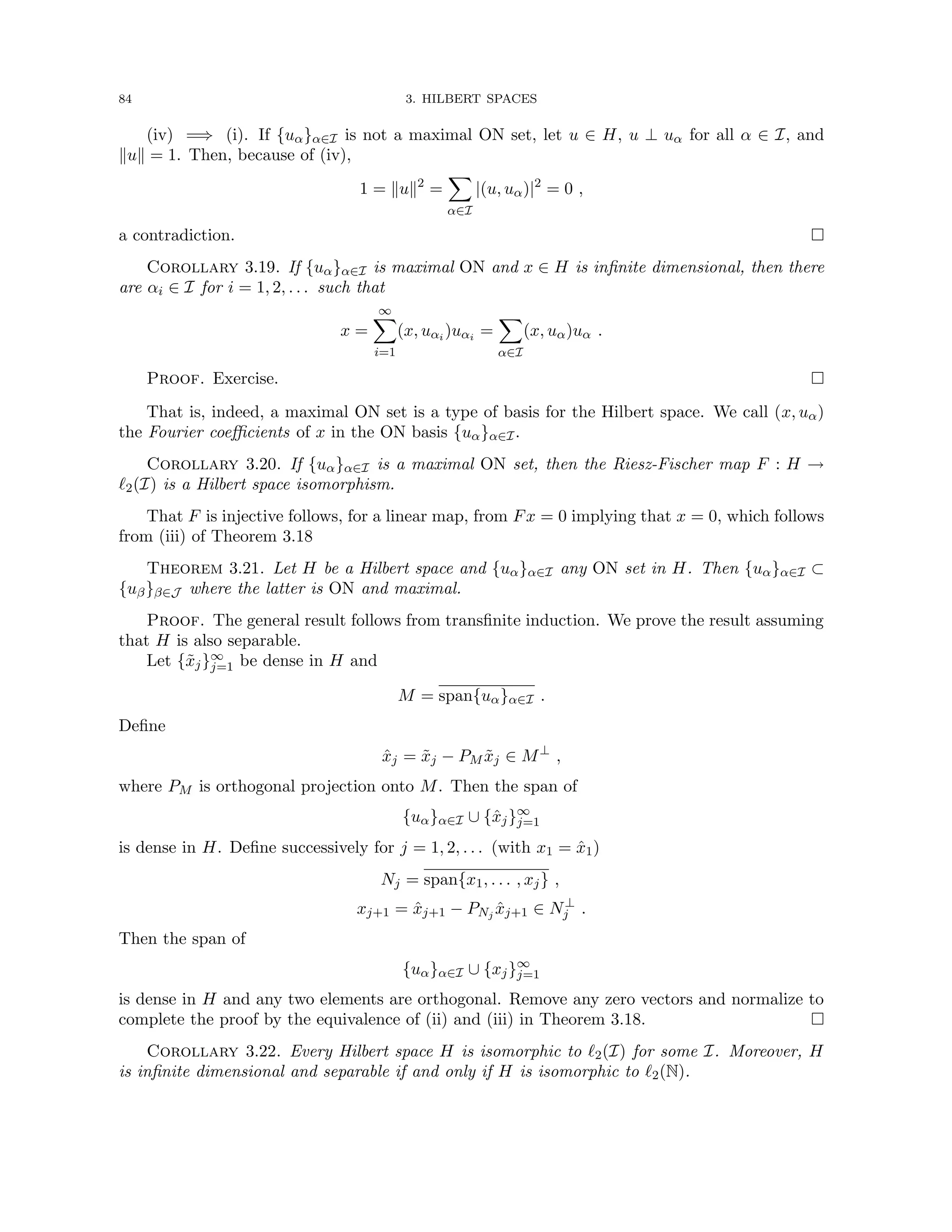
![3.4. ORTHONORMAL SUBSETS 85
We illustrate orthogonality in a Hilbert space by considering Fourier series. If f : R → C
is periodic of period T, then g : R → C defined by g(x) = f(λx) for some λ 6= 0 is periodic of
period T/λ. So when considering periodic functions, it is enough to restrict to the case T = 2π.
Let
L2,per(−π, π) = {f : R → C : f ∈ L2([−π, π)) and f(x + 2nπ) = f(x)
for a.e. x ∈ [−π, π) and integer n} .
With the inner-product
(f, g) =
1
2π
Z π
−π
f(x) g(x) dx ,
L2,per(−π, π) is a Hilbert space (it is left to the reader to verify these assertions). The set
{einx
}∞
n=−∞ ⊂ L2,per(−π, π)
is ON, as can be readily verified.
Theorem 3.23. The set span{einx}∞
n=−∞ is dense in L2,per(−π, π).
Proof. We first remark that Cper([−π, π]), the continuous functions defined on (−∞, ∞)
that are periodic, are dense in L2,per(−π, π). In fact, C0([−π, π]) is dense (Proposition 2.22) and
clearly periodic. Thus it is enough to show that a continuous and periodic function f of period
2π is the limit of functions in span{einx}∞
n=−∞.
For any integer m ≥ 0, on [−π, π] let
km(x) = cm
1 + cos x
2
m
≥ 0
where cm is defined so that
1
2π
Z π
−π
km(x) dx = 1 . (3.2)
As m → ∞, km(x) is concentrated about x = 0 but maintains total integral 2π (i.e., km/2π → δ0,
the Dirac distribution to be defined later). Now
km(x) = cm
2 + eix + e−ix
4
m
∈ span {einx
}m
n=−m ,
and so, for some λn ∈ C,
fm(x) ≡
1
2π
Z π
−π
km(x − y)f(y) dy
=
1
2π
Z π
−π
m
X
n=−m
λnein(x−y)
f(y) dy
=
m
X
n=−m
λn
2π
Z π
−π
e−iny
f(y) dy
einx
∈ span {einx
}m
n=−m .
We claim that in fact fm → f uniformly in the L∞ norm, so also in L2, and the proof will
be complete. By periodicity,
fm(x) =
1
2π
Z π
−π
f(x − y)km(y) dy ,](https://image.slidesharecdn.com/appliedmathematicsmethods-230215152718-28efe5ed/75/applied-mathematics-methods-pdf-85-2048.jpg)
![86 3. HILBERT SPACES
and, by (3.2),
f(x) =
1
2π
Z π
−π
f(x)km(y) dy .
Thus, for any δ 0,
|fm(x) − f(x)| =
1
2π
Z π
−π
f(x − y) − f(x)
km(y) dy
≤
1
2π
Z π
−π
|f(x − y) − f(x)|km(y) dy
=
1
2π
Z
δ|y|≤π
|f(x − y) − f(x)|km(y) dy
+
1
2π
Z
|y|≤δ
|f(x − y) − f(x)|km(y) dy .
Given ε 0, since f is continuous on [−π, π], it is uniformly continuous. Thus there is δ 0
such that |f(x − y) − f(x)| ε/2 for all |y| ≤ δ, and the last term on the right side above is
bounded by ε/2. For the next to last term, we note that from (3.2),
1 =
cm
π
Z π
0
1 + cos x
2
m
dx
≥
cm
π
Z π
0
1 + cos x
2
m
sin x dx
=
cm
(m + 1)π
,
which implies that
cm ≤ (m + 1)π .
Now f is continuous on [−π, π], so there is M ≥ 0 such that |f(x)| ≤ M. Thus for |y| δ,
km(y) ≤ (1 + m)π
1 + cos δ
2
m
ε
4M
for m large enough. Combining, we have that
|fm(x) − f(x)| ≤
1
2π
Z π
−π
2M
ε
4M
dy +
ε
2
= ε .
We conclude that fm
L∞
−
−
→ f uniformly.
Thus, given f ∈ L2,per(−π, π), we have the representation
f(x) =
∞
X
n=−∞
(f, e−in(·)
)e−inx
=
∞
X
n=−∞
1
2π
Z π
−π
f(y) einy
dy
e−inx
.
3.5. Weak Convergence in a Hilbert Space
Because of the Riesz Representation Theorem, a sequence {xn}∞
n=1 from a Hilbert space H
converges weakly to x if and only if
(xn, y) −→ (x, y) (3.3)
for all y ∈ H.](https://image.slidesharecdn.com/appliedmathematicsmethods-230215152718-28efe5ed/75/applied-mathematics-methods-pdf-86-2048.jpg)
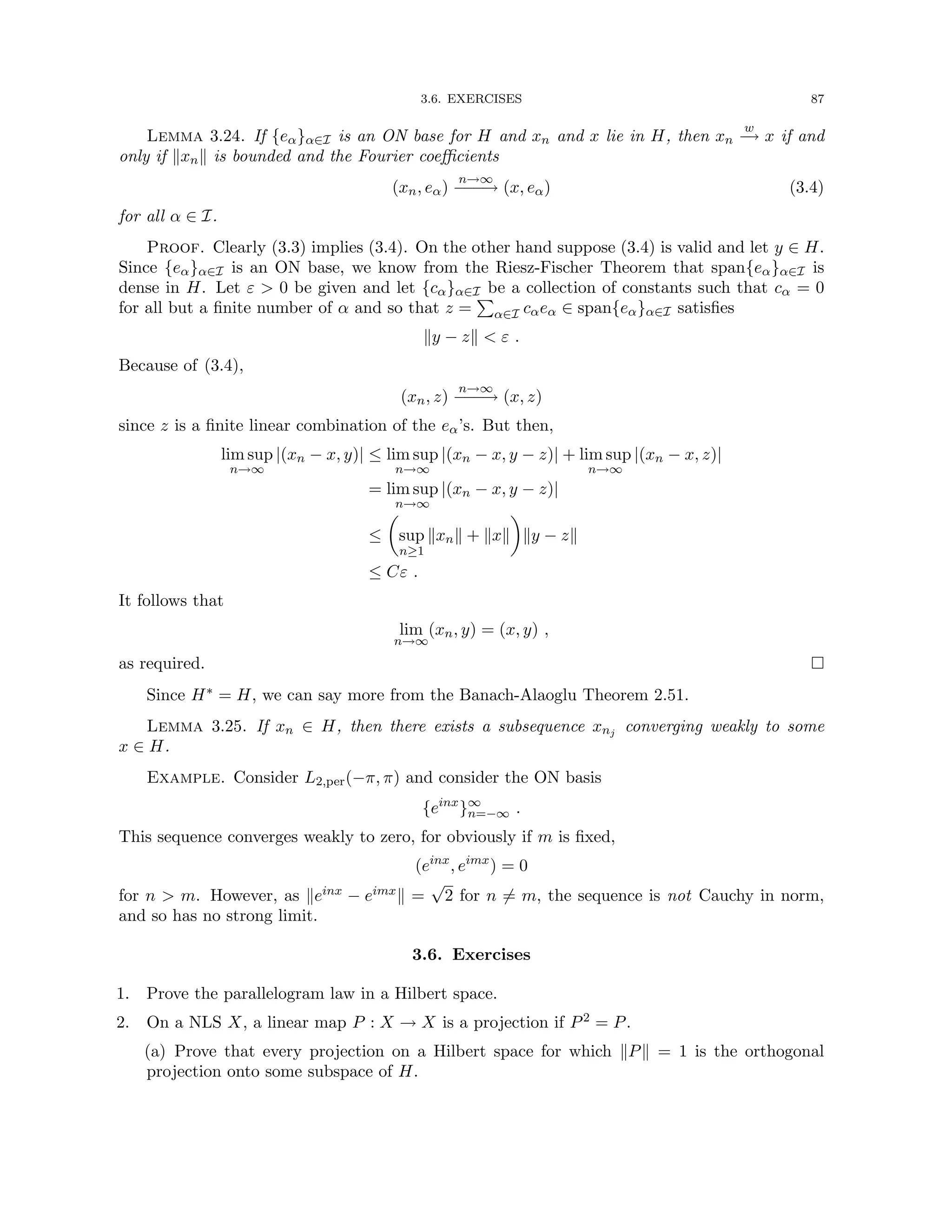
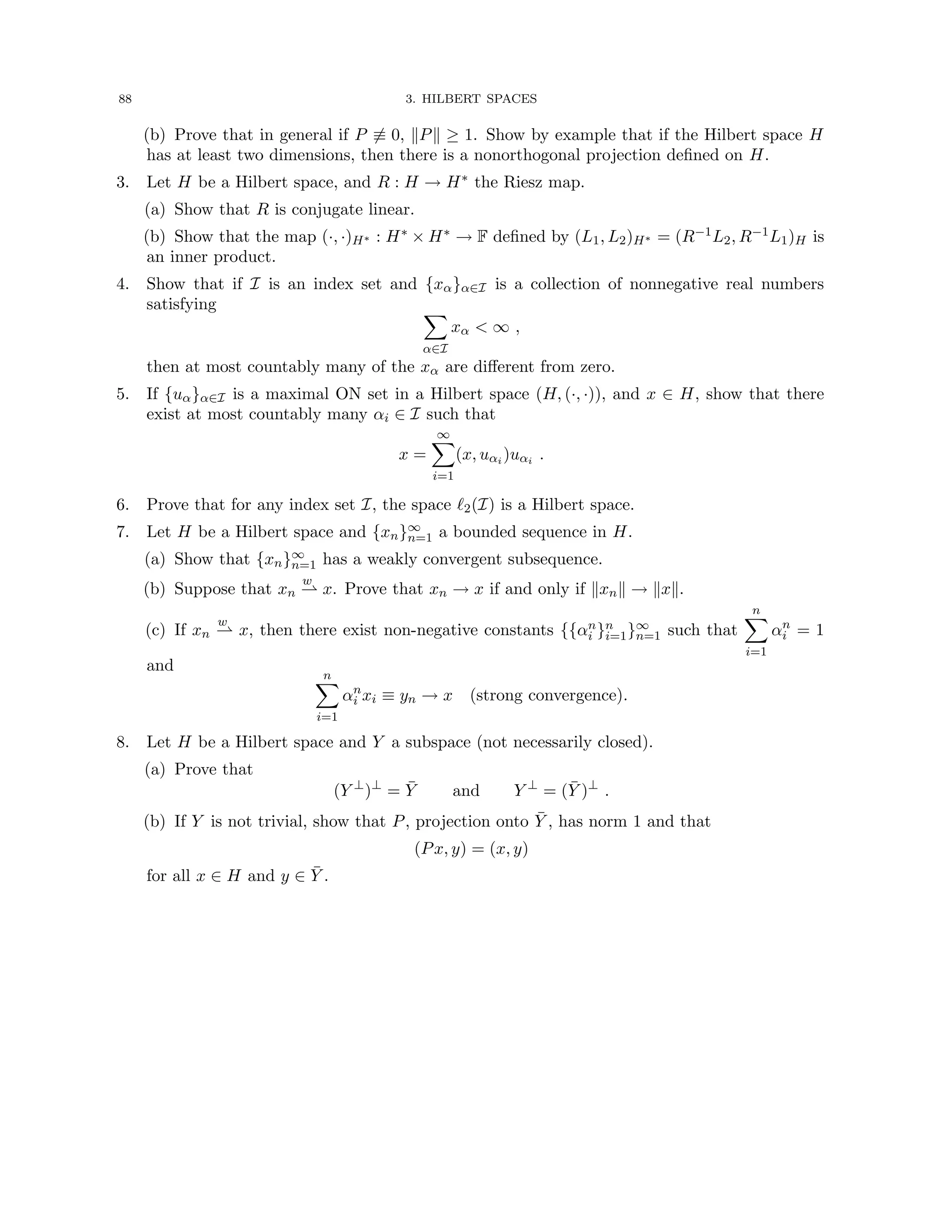
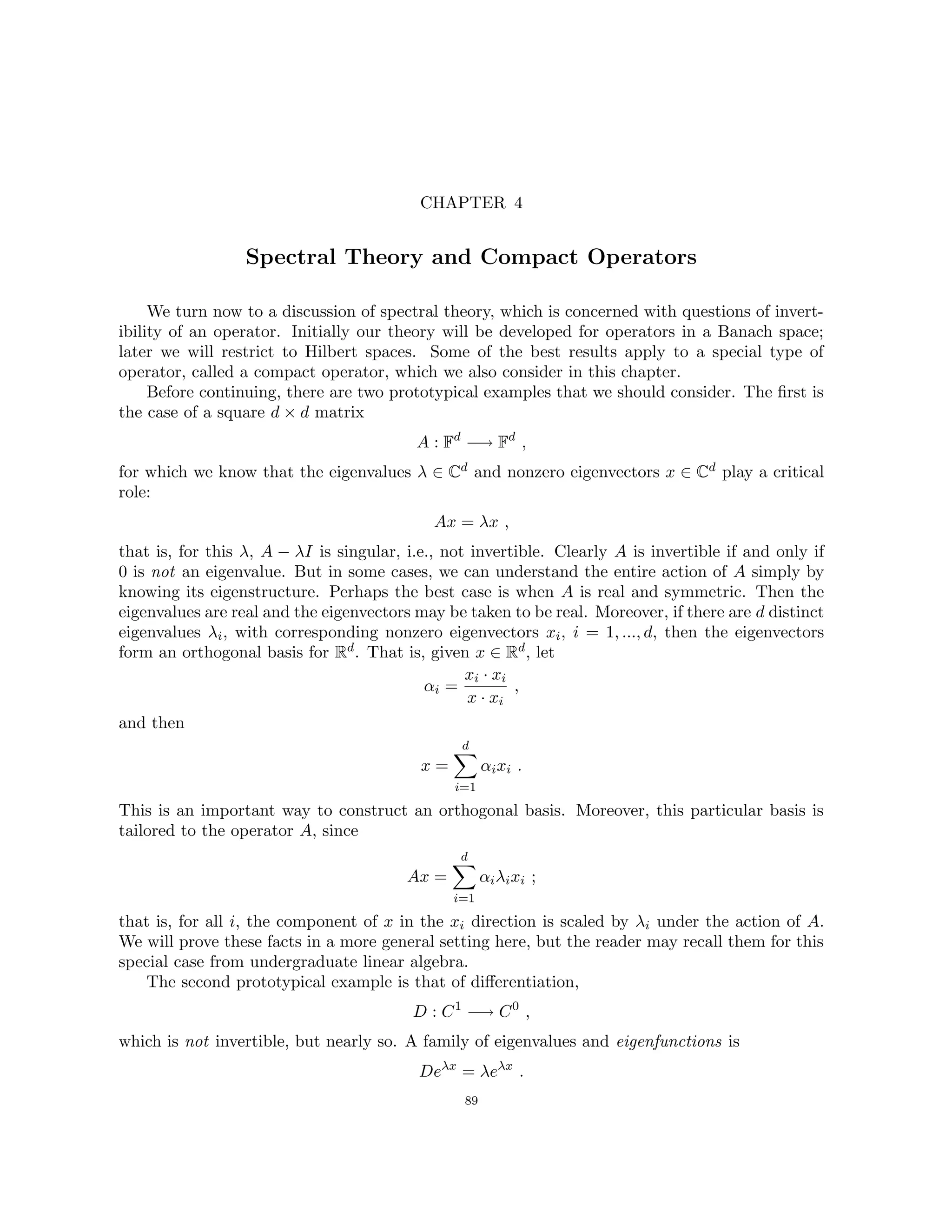

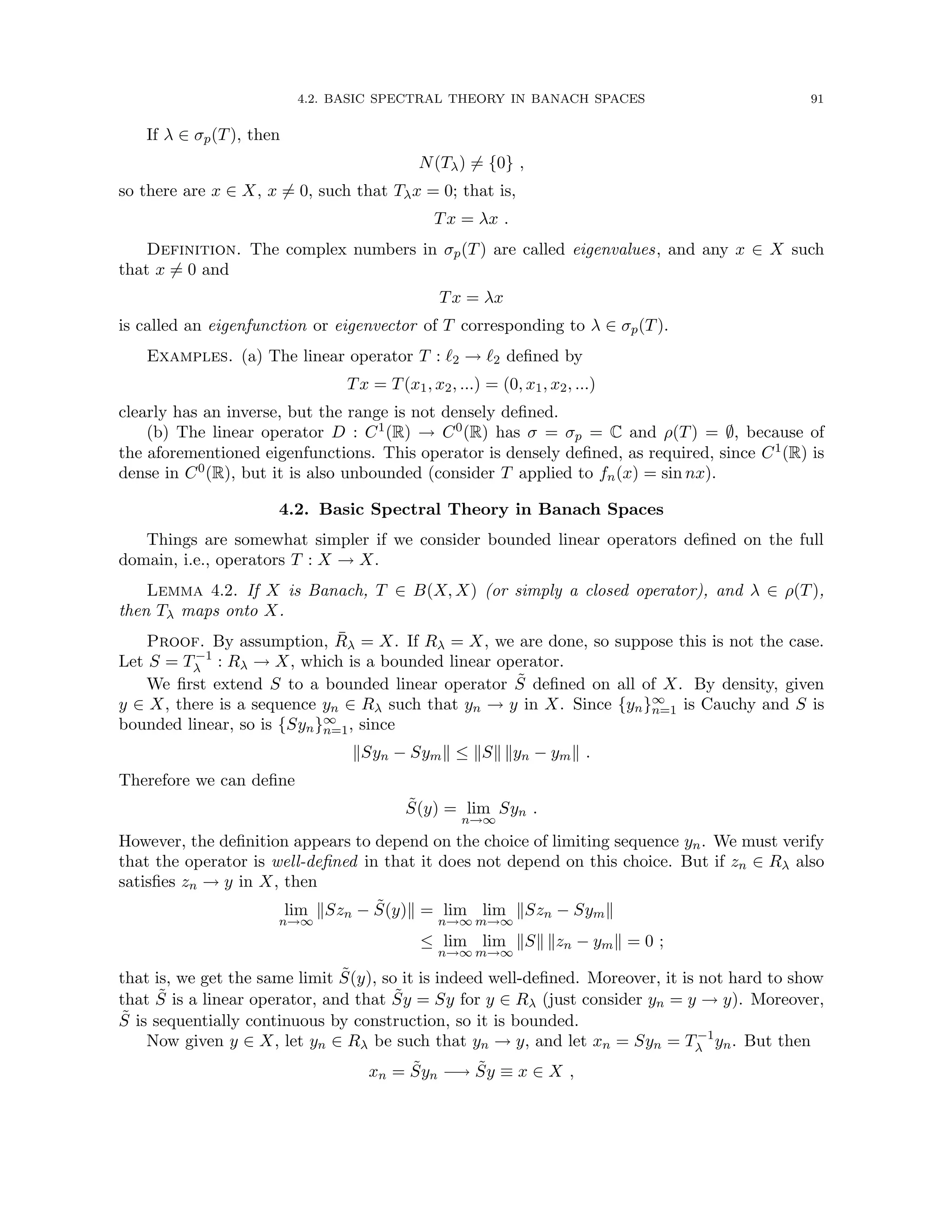
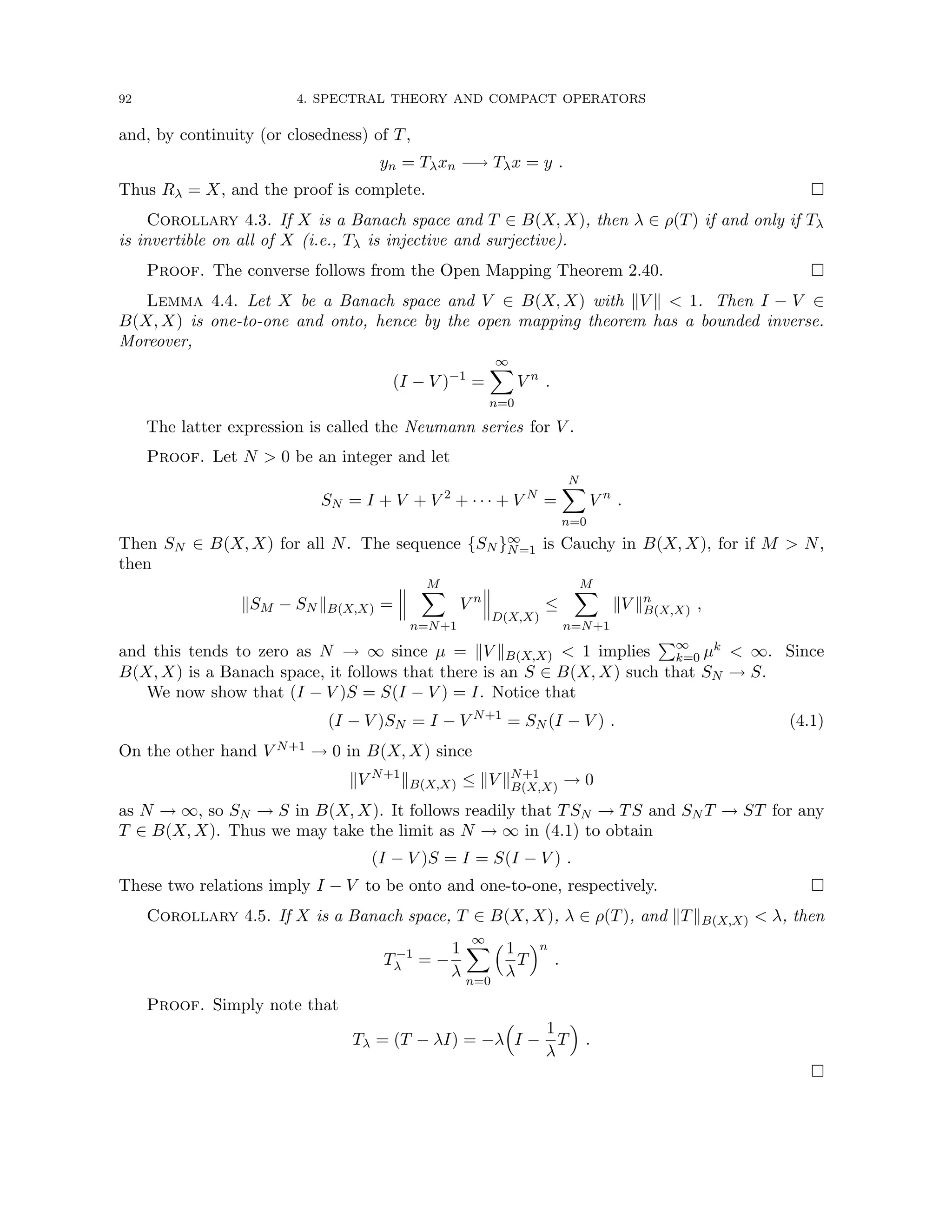
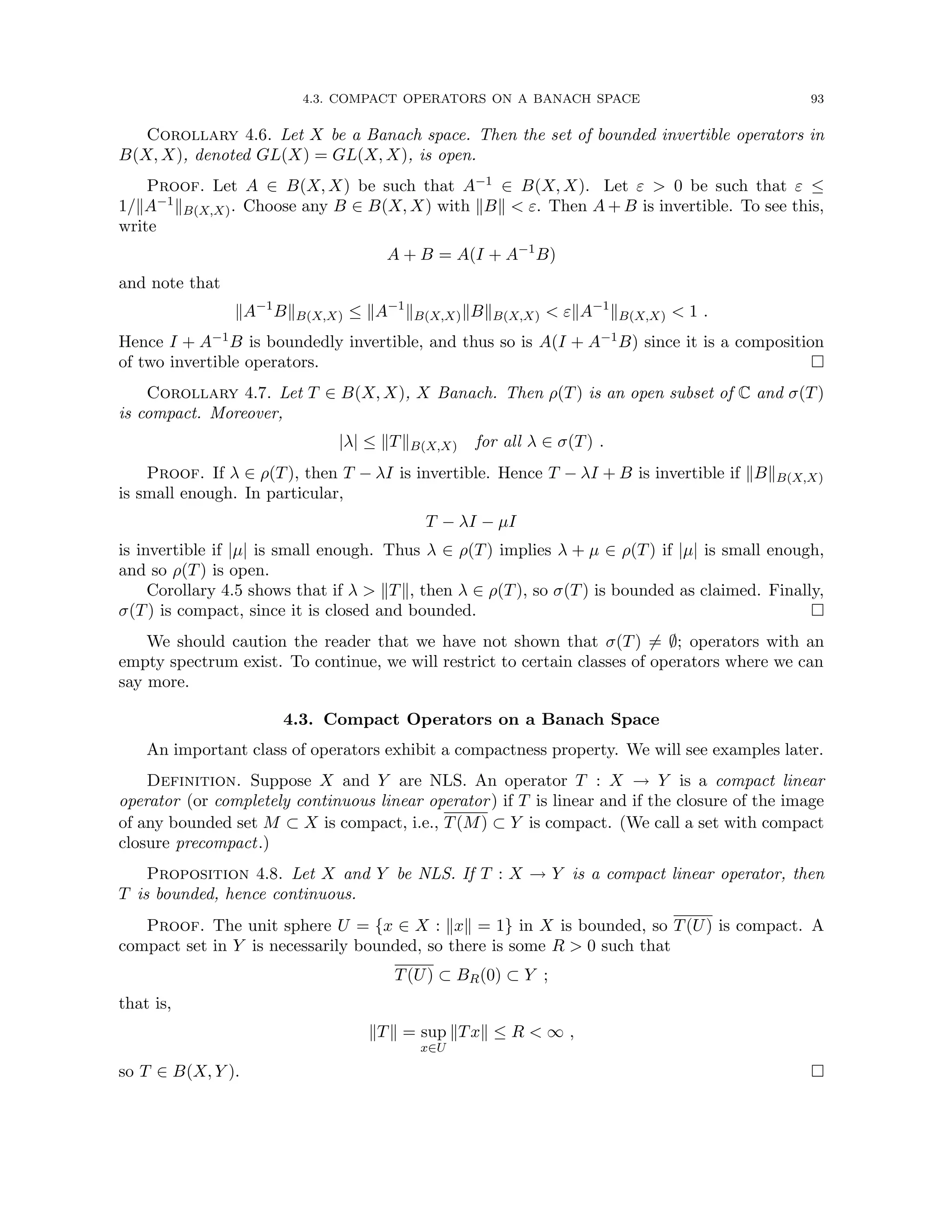
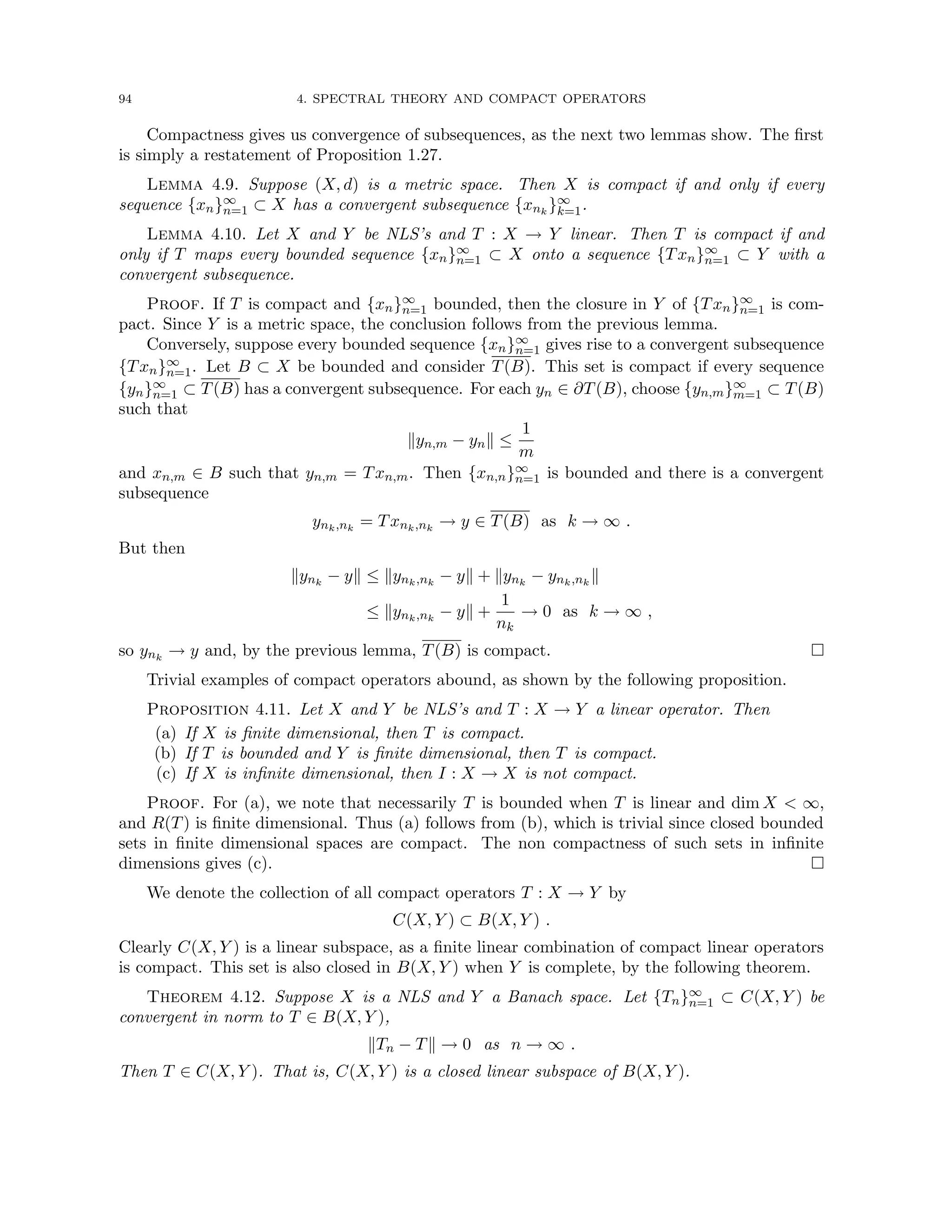

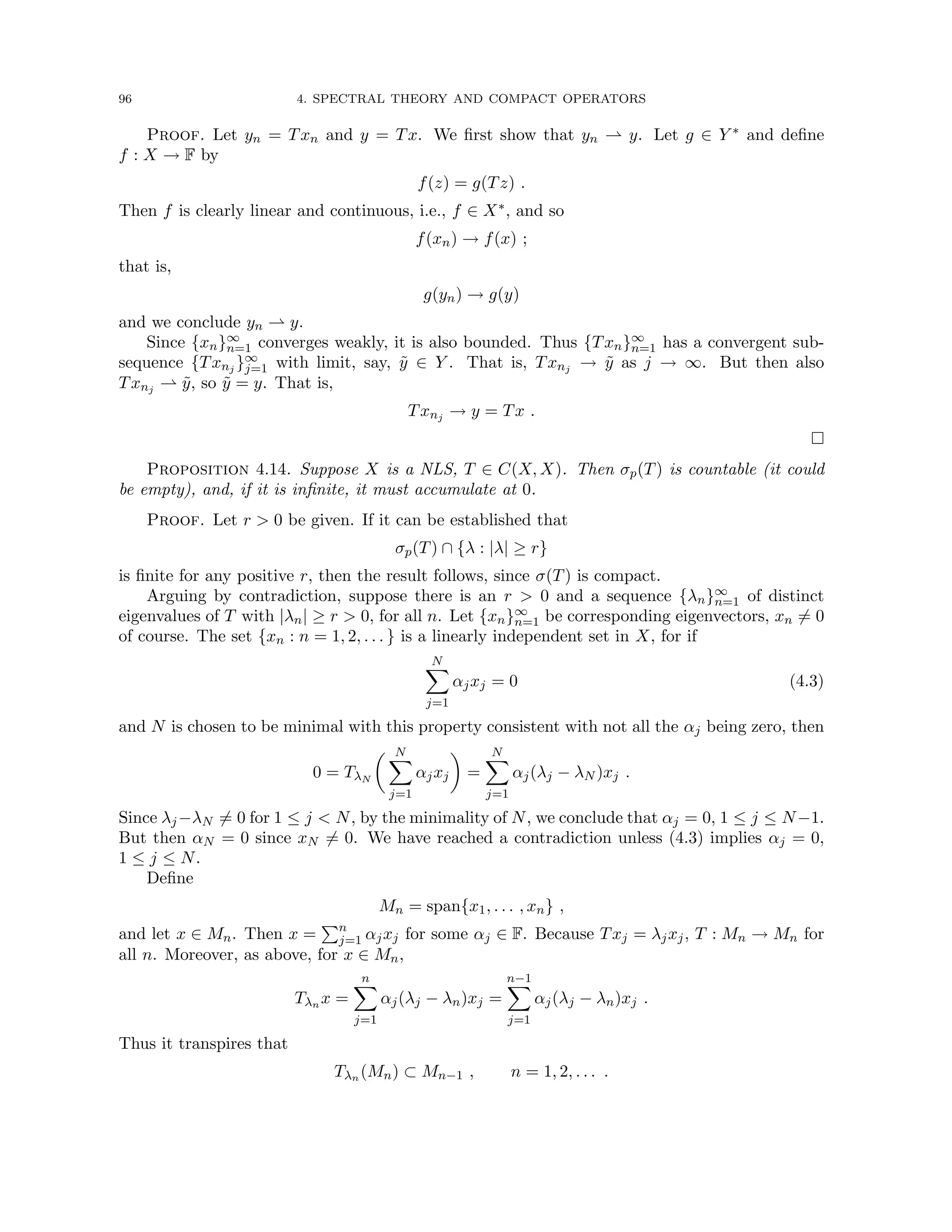
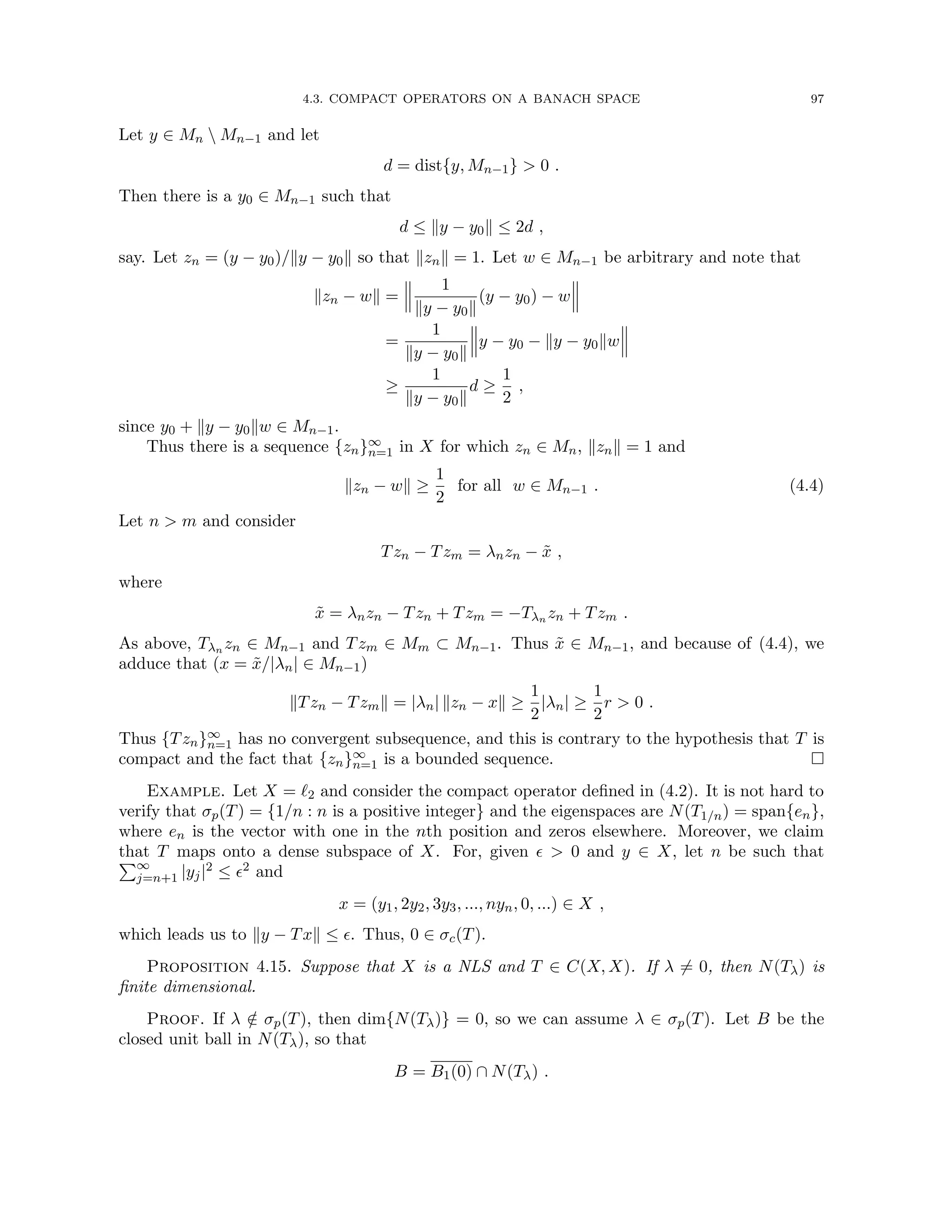
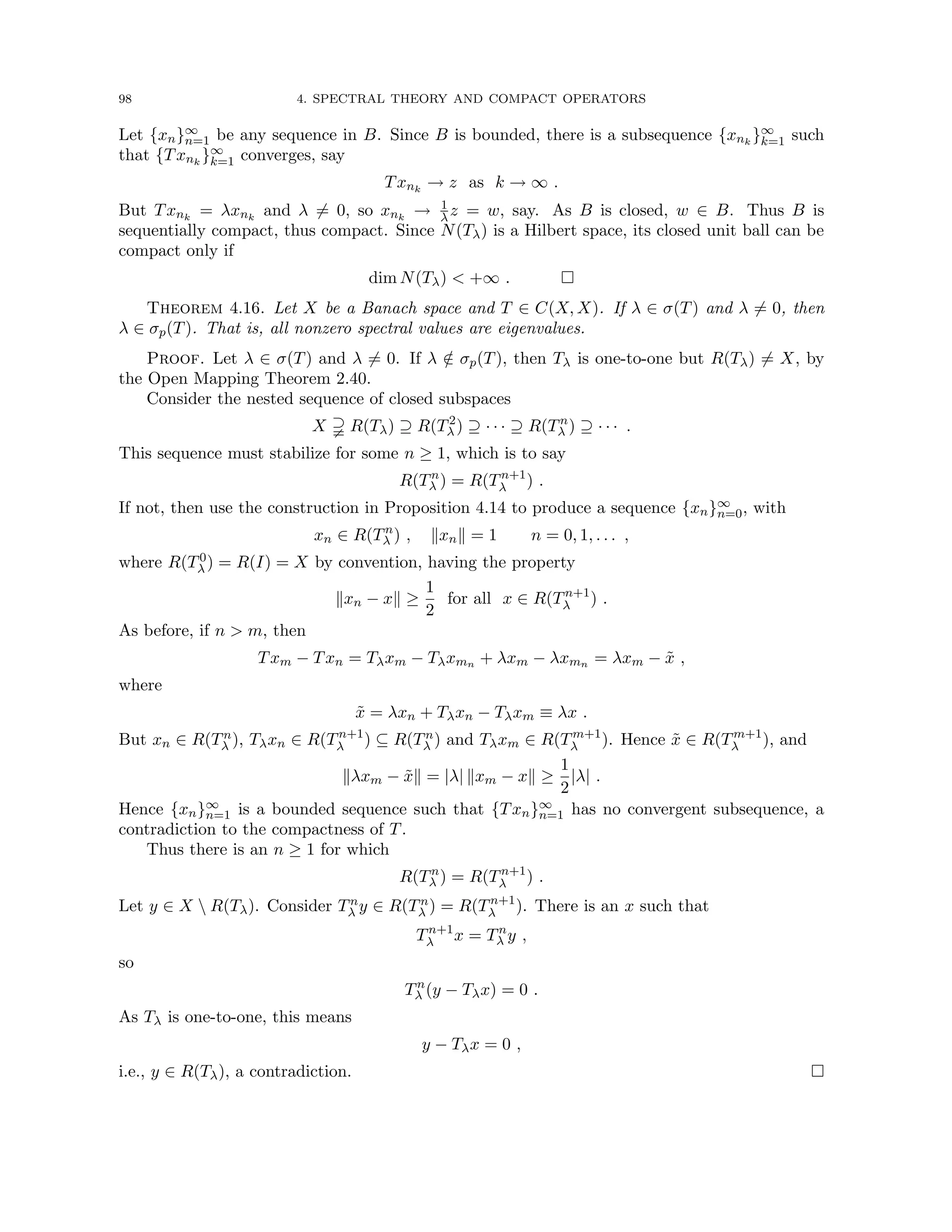
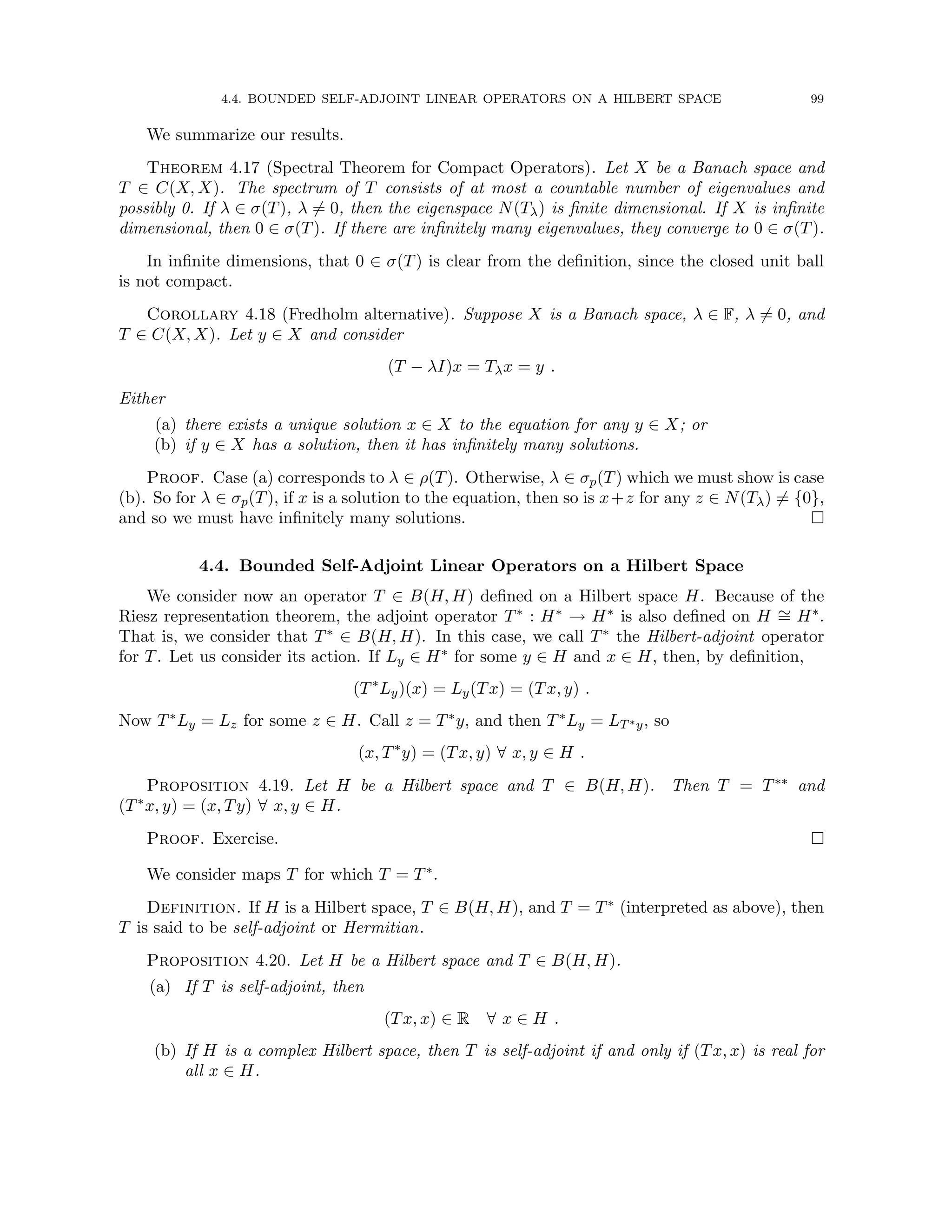
![100 4. SPECTRAL THEORY AND COMPACT OPERATORS
Proof. (a) We compute
(Tx, x) = (x, Tx) = (x, T∗x) = (Tx, x) ∈ R .
(b) By (a), we need only show the converse. This will follow if we can show that
(Tx, y) = (T∗
x, y) ∀ x, y ∈ H .
Let α ∈ C and compute
R 3
T(x + αy), x + αy
= (Tx, x) + |α|2
(Ty, y) + α(Ty, x) + ᾱ(Tx, y) .
The first two terms on the right are real, so also the sum of the latter two. Thus
R 3 ᾱ(Tx, y) + ᾱ(T∗x, y) .
If α = 1, we conclude that the complex parts of (Tx, y) and (T∗x, y) agree; if α = i, the real
parts agree.
We isolate an important result that is useful in other contexts.
Lemma 4.21. Suppose X and Y are Banach spaces and T ∈ B(X, Y ). Suppose that T is
bounded below, i.e., there is some γ 0 such that
kTxkY ≥ γkxkX ∀ x ∈ X .
Then T is one-to-one and R(T) is closed in Y .
Proof. That T is one-to-one is clear by linearity. Suppose for n = 1, 2, . . . , yn = Txn is a
sequence in R(T) and that yn → y ∈ Y . Then {yn}∞
n=1 is Cauchy, so also is {xn}∞
n=1. Since X is
complete, there is x ∈ X such that xn → x. Since T is continuous, yn = Txn → Tx = y ∈ R(T);
that is, R(T) is closed.
Theorem 4.22. Let H be a Hilbert space and T ∈ B(H, H) be a self-adjoint operator. Then
σr(T) = ∅ and
σ(T) ⊂ [r, R] ⊂ R ,
where
r = inf
kxk=1
(Tx, x) and R = sup
kxk=1
(Tx, x) .
Moreover, λ ∈ ρ(T) if and only if Tλ is bounded below.
Proof. If λ ∈ σp(T) and Tx = λx for x 6= 0, then λ(x, x) = (Tx, x) = (x, Tx) = (x, λx) =
λ̄(x, x); thus λ = λ̄ is real. If λ ∈ ρ(T), then the final conclusion follows from the boundedness
of T−1
λ ,
kxk = kT−1
λ Tλxk ≤ kT−1
λ k kTλxk ,
and the fact that T−1
λ 6≡ 0. Conversely, suppose Tλ is bounded below. By Lemma 4.21, Tλ is
one-to-one and R(Tλ) is closed. If R(Tλ) 6= H, then there is some x0 ∈ R(Tλ)⊥, and, ∀ x ∈ H,
0 = (Tλx, x0) = (Tx, x0) − λ(x, x0)
= (x, Tx0) − λ(x, x0)
= (x, Tλ̄x0) .](https://image.slidesharecdn.com/appliedmathematicsmethods-230215152718-28efe5ed/75/applied-mathematics-methods-pdf-100-2048.jpg)
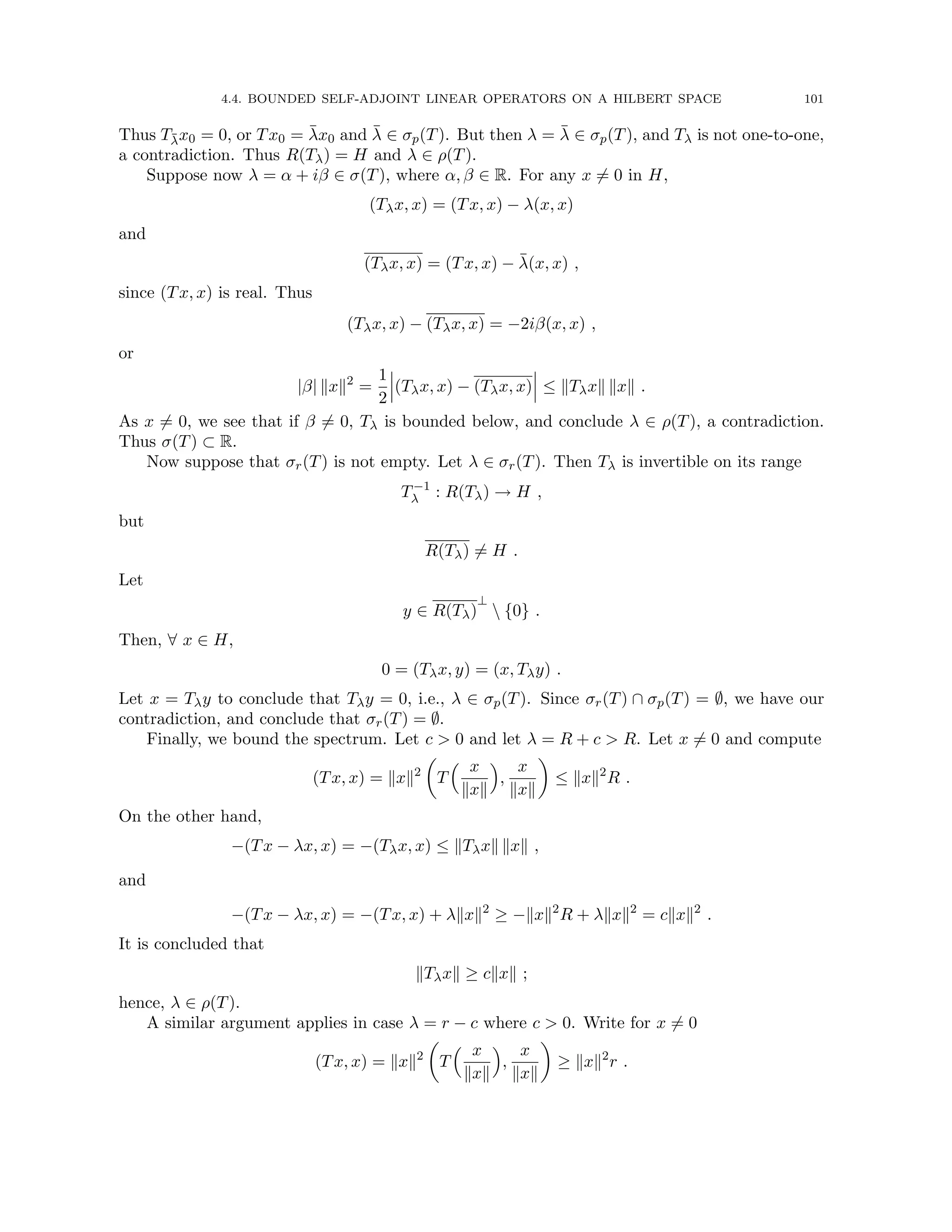
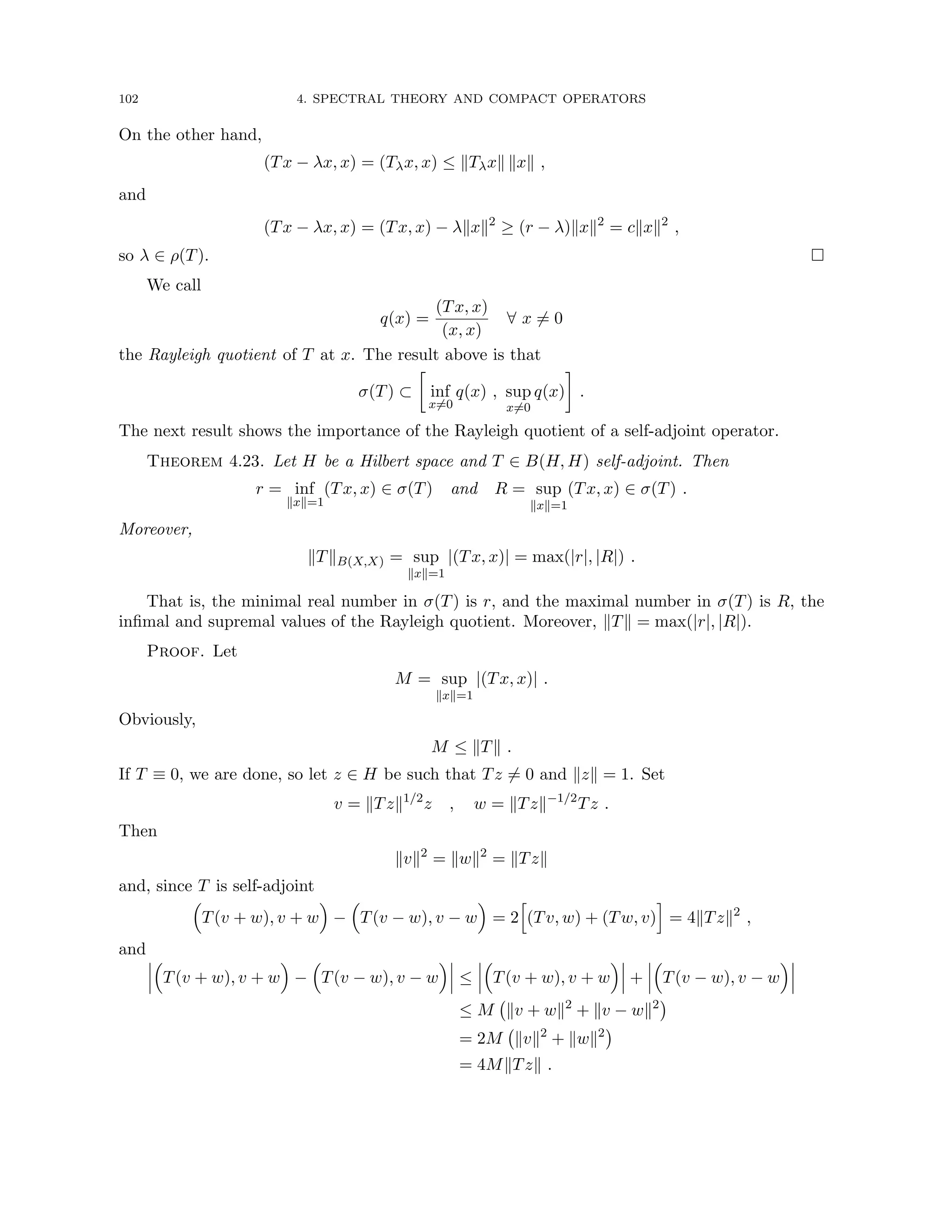
![4.4. BOUNDED SELF-ADJOINT LINEAR OPERATORS ON A HILBERT SPACE 103
We conclude that
kTzk ≤ M ,
and, taking the supremum over all such z,
kTk ≤ M .
Thus kTk = M.
Obviously, λ ∈ σ(T) if and only if λ + µ ∈ σ(Tµ), so by such a translation, we may assume
that 0 ≤ r ≤ R. Then kTk = R and there is a sequence {xn}∞
n=1 such that kxnk = 1 and
(Txn, xn) = R −
1
n
.
Now
kTRxnk2
= kTxn − Rxnk2
= kTxnk2
− 2R(Txn, xn) + R2
≤ 2R2
− 2R
R −
1
n
=
2R
n
→ 0 .
Thus TR is not bounded below, so R /
∈ ρ(T), i.e., R ∈ σ(T). Similar arguments show r ∈
σ(T).
We know that if T ∈ B(H, H) is self-adjoint, then (Tx, x) ∈ R for all x ∈ H.
Definition. If H is a Hilbert space and T ∈ B(H, H) satisfies
(Tx, x) ≥ 0 ∀ x ∈ H ,
then T is said to be a positive operator. We denote this fact by writing 0 ≤ T. Moreover, if
R, S ∈ B(H, H), then R ≤ S means that 0 ≤ S − R.
Proposition 4.24. Suppose H is a complex Hilbert space and T ∈ B(H, H). Then T is a
positive operator if and only if σ(T) ≥ 0. Moreover, if T is positive, then T is self-adjoint.
Proof. This follows from Proposition 4.20 and Theorem 4.22.
An interesting and useful fact about a positive operator is that it has a square root.
Definition. Let H be a Hilbert space and T ∈ B(H, H) be positive. An operator S ∈
B(H, H) is said to be a square root of T if
S2
= T .
If, in addition, S is positive, then S is called a positive square root of T, denoted by
S = T1/2
.
Theorem 4.25. Every positive operator T ∈ B(H, H), where H is a Hilbert space, has a
unique positive square root.
The proof is long but not difficult. We omit it and refer the interested reader to [Kr,
p. 473–479].](https://image.slidesharecdn.com/appliedmathematicsmethods-230215152718-28efe5ed/75/applied-mathematics-methods-pdf-103-2048.jpg)
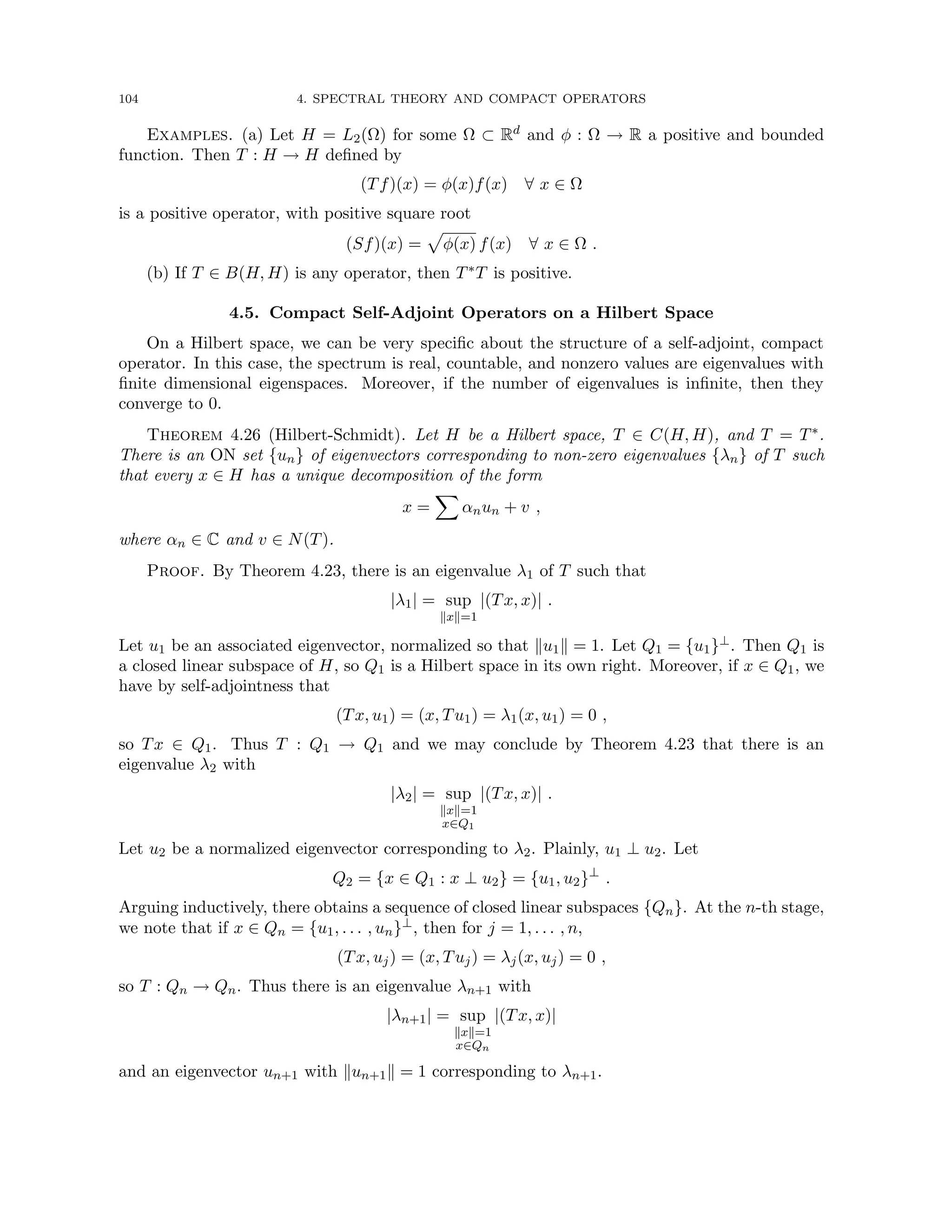
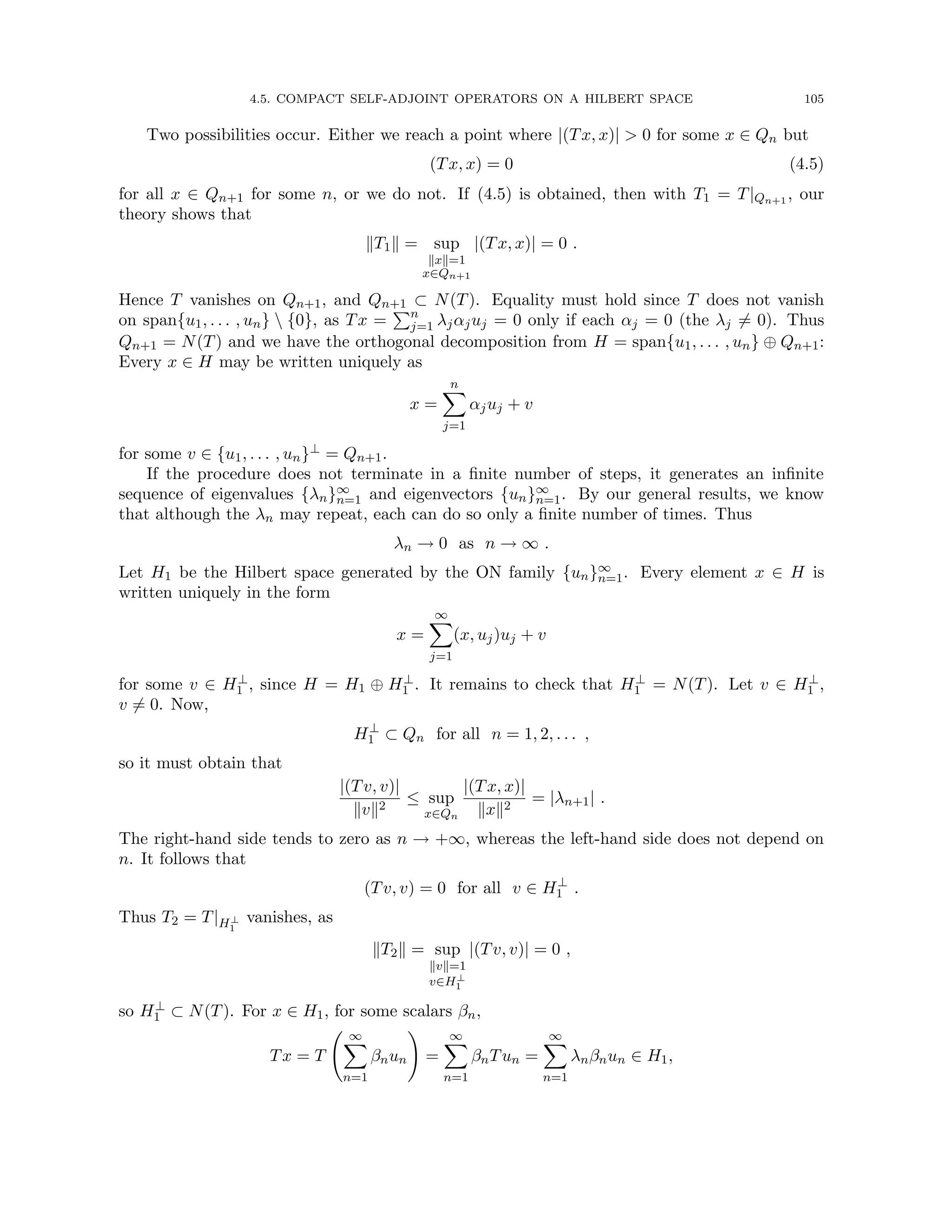
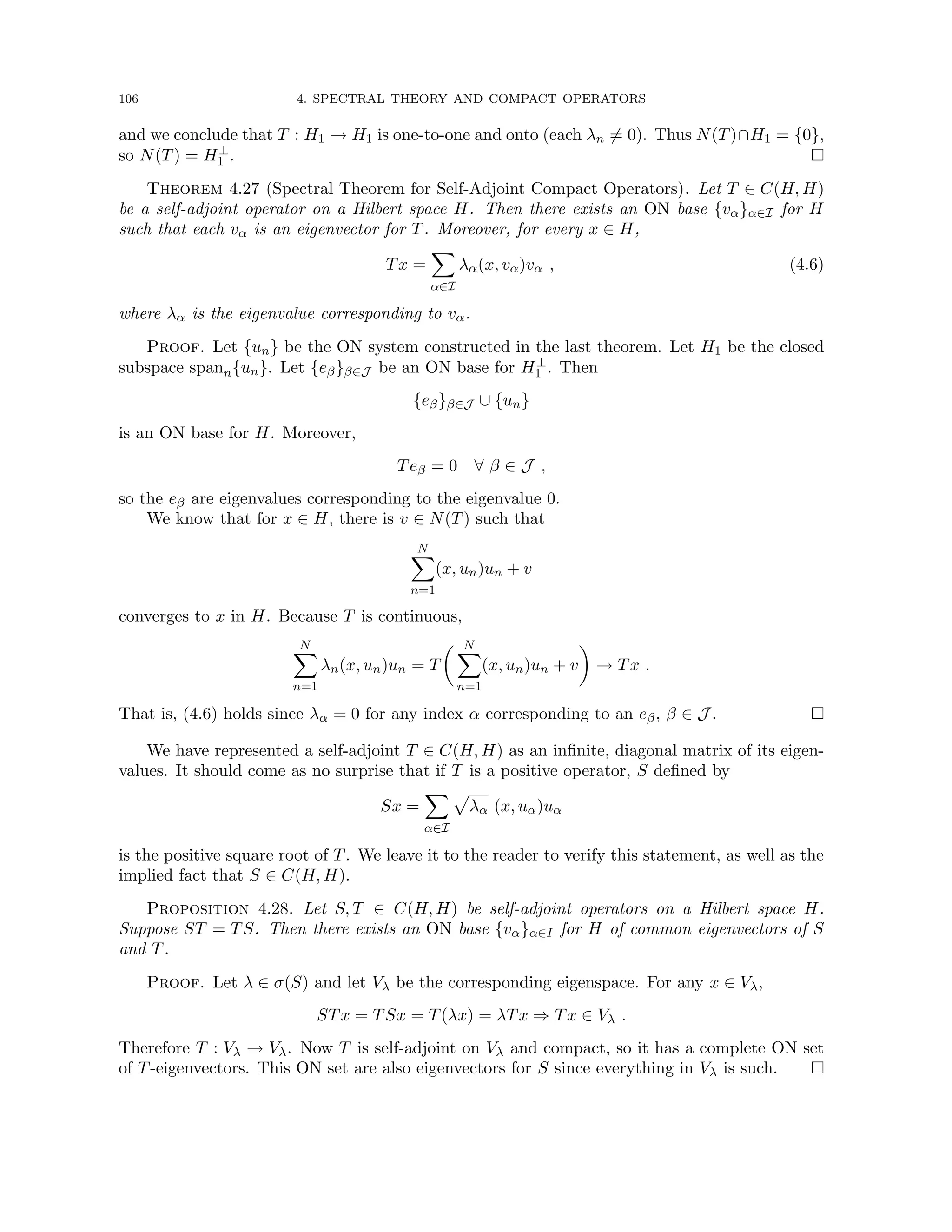
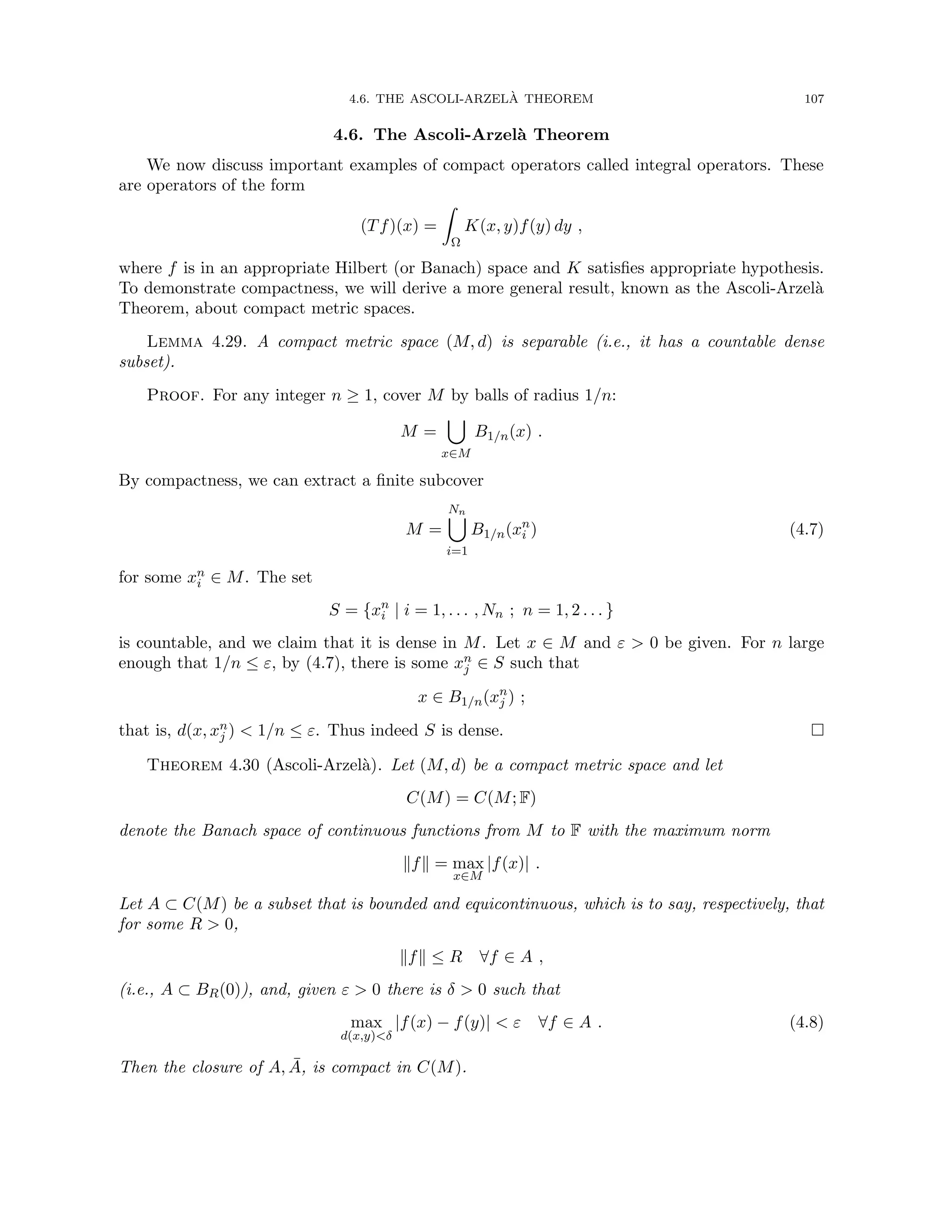

![4.7. STURM LIOUVILLE THEORY 109
is bounded independently of n. For equicontinuity, we compute
|Tfn(x) − Tfn(y)| =
Z
Ω
(K(x, z) − K(y, z))fn(z) dz
≤ kfnkL∞ sup
z∈Ω
|K(x, z) − K(y, z)|
Z
Ω
dx .
Since K is uniformly continuous on Ω × Ω, the right-side above can be made uniformly small
provided |x − y| is taken small enough.
By an argument based on the density of C( Ω ) in L2(Ω), and the fact that the limit of
compact operators is compact, we can extend this result to L2(Ω). The details are left to the
reader.
Corollary 4.32. Let Ω ⊂ Rd be bounded and open. Suppose K ∈ L2(Ω × Ω) and
T : L2(Ω) → L2(Ω) is defined as in the previous theorem. Then T is compact.
4.7. Sturm Liouville Theory
Suppose I = [a, b] ⊂ R, aj ∈ C2−j(I), j = 0, 1, 2 and a0 0. We consider the operator
L : C2(I) → C(I) defined by
(Lx)(t) = a0(t)x00
(t) + a1(t)x0
(t) + a2(t)x(t) .
Note that L is a bounded linear operator.
Theorem 4.33 (Picard). Given f ∈ C(I) and x0, x1 ∈ R, there exists a unique solution
x ∈ C2(I) to the initial value problem (IVP)
(
Lx = f ,
x(a) = x0 , x0(a) = x1 .
(4.10)
Consult a text on ordinary differential equations for a proof.
Corollary 4.34. The null space N(L) is two dimensional.
Proof. We construct a basis. Solve (4.10) with f = x1 = 0, x0 = 1. Call this solution
z0(t). Clearly z0 ∈ N(L). Now solve for z1(t) with f = x0 = 0, x1 = 1. Then any x ∈ N(L)
solves (4.10) with x0 = x(a) and x1 = x0(a), so
x(t) = x(a)z0(t) + x0
(a)z1(t) ,
by uniqueness.
Thus, to solve (4.10), we cannot find L−1 (it does not exist). Rather, the inverse operator
we desire concerns both L and the initial conditions. Ignoring these conditions for a moment,
we study the structure of L within the context of an inner-product space.
Definition. The formal adjoint of L is denoted L∗ and defined by L∗ : C2(I) → C(I)
where
(L∗
x)(t) = (ā0x)00
− (ā1x)0
+ ā2x
= ā0x00
+ (2ā0
0 − ā1)x0
+ (ā00
0 − ā0
1 + ā2)x .](https://image.slidesharecdn.com/appliedmathematicsmethods-230215152718-28efe5ed/75/applied-mathematics-methods-pdf-109-2048.jpg)
![110 4. SPECTRAL THEORY AND COMPACT OPERATORS
The motivation is the L2(I) inner-product. If x, y ∈ C2(I), then
(Lx, y) =
Z b
a
Lx(t)ȳ(t) dt
=
Z b
a
[a0x00
ȳ + a1x0
ȳ + a2xȳ ] dt
=
Z b
a
xL∗y dt + [a0x0
ȳ − x(a0ȳ )0
+ a1xȳ ]b
a
= (x, L∗
y) + Boundary terms.
Definition. If L = L∗, we say that L is formally self-adjoint. If a0, a1, and a2 are real-
valued functions, we say that L is real.
Proposition 4.35. The real operator L = a0D2 + a1D + a2 is formally self-adjoint if and
only if a0
0 = a1. In this case,
Lx = (a0x0
)0
+ a2x = D(a0D)x + a2x ,
i.e.,
L = Da0D + a2 .
Proof. Note that for a real operator,
L∗
= a0D2
+ (2a0
0 − a1)D + (a00
0 − a0
1 + a2) ,
so L = L∗ if and only if
a1 = 2a0
0 − a1 ,
a2 = a00
0 − a0
1 + a2 .
That is,
a1 = a0
0 and a0
1 = a00
0 ,
or simply the former condition. Then
Lx = a0D2
x + a0
0Dx + a2x = D(a0Dx) + a2x .
Remark. If L = a0D2 + a1D + a2 is real but not formally self-adjoint, we can render it so
by a small adjustment using the integrating factor
Q(t) =
1
a0(t)
P(t) ,
P(t) = exp
Z t
a
a1(τ)
a0(τ)
dτ
0 ,
for which P0 = a1P/a0. Then
Lx = f ⇐⇒ L̃x = ˜
f ,
where
L̃ = QL and ˜
f = Qf .](https://image.slidesharecdn.com/appliedmathematicsmethods-230215152718-28efe5ed/75/applied-mathematics-methods-pdf-110-2048.jpg)
![4.7. STURM LIOUVILLE THEORY 111
But L̃ is formally self-adjoint, since
L̃x = QLx = Px00
+
a1
a0
Px0
+ a2Qx
= Px00
+ P0
x0
+ a2Qx
= (Px0
) +
a2
a0
P
x .
Examples. The most important examples are posed for I = (a, b), a or b possibly infinite,
and aj ∈ C2−j( ¯
I ), where a0 0 on I (thus a0(a) and a0(b) may vanish — we have excluded
this case, but the theory is similar).
(a) Legendre:
Lx = ((1 − t2
)x0
)0
, −1 ≤ t ≤ 1 .
(b) Chebyshev:
Lx = (1 − t2
)1/2
((1 − t2
)1/2
x0
)0
, −1 ≤ t ≤ 1 .
(c) Laguerre:
Lx = et
(te−t
x0
)0
, 0 t ∞ .
(d) Bessel: for ν ∈ R,
Lx =
1
t
(tx0
)0
−
ν2
t2
x , 0 t 1 .
(e) Hermite:
Lx = et2
(e−t2
x0
)0
, t ∈ R .
We now include and generalize the initial conditions, which characterize N(L). Instead of
two conditions at t = a, we consider one condition at each end of I = [a, b], called boundary
conditions (BC’s).
Definition. Let p, q, and w be real-valued functions on I = [a, b], a b both finite, with
p 6= 0 and w 0. Let α1, α2, β1, and β2 ∈ R be such that
α2
1 + α2
2 6= 0 and β2
1 + β2
2 6= 0 .
Then the problem of finding x(t) ∈ C2(I) and λ ∈ C such that
Ax ≡ 1
w [(px0)0 + qx] = λx , t ∈ (a, b) ,
α1x(a) + α2x0(a) = 0 ,
β1x(b) + β2x0(b) = 0 ,
(4.11)
is called a regular Sturm-Liouville (regular SL) problem. It is the eigenvalue problem for A with
the BC’s.
We remark that if a or b are infinite or p vanishes at a or b, the corresponding BC is lost
and the problem is called a singular Sturm-Liouville problem.
Example. Let I = [0, 1] and
(
Ax = −x00 = λx , t ∈ (0, 1) ,
x(0) = x(1) = 0 .
(4.12)](https://image.slidesharecdn.com/appliedmathematicsmethods-230215152718-28efe5ed/75/applied-mathematics-methods-pdf-111-2048.jpg)

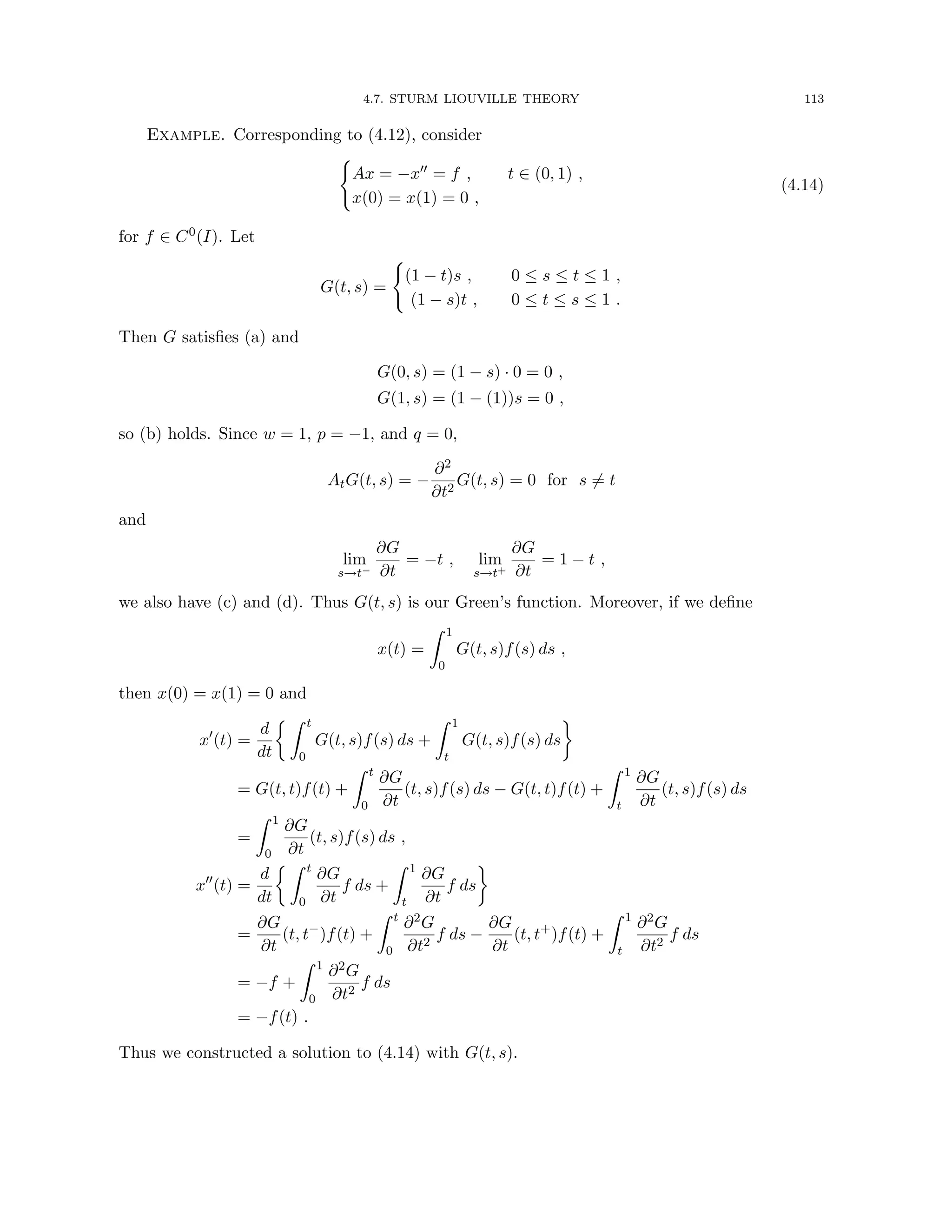
![114 4. SPECTRAL THEORY AND COMPACT OPERATORS
Theorem 4.36. Suppose that for the regular SL system (so α2
1 + α2
2 0 and β2
1 + β2
2 0)
Au ≡
1
w
Lu ≡
1
w
[(pu0
)0
+ qu] = f , t ∈ (a, b) ,
α1u(a) + α2u0(a) = 0 ,
β1u(b) + β2u0(b) = 0 ,
on the interval I = [a, b], p ∈ C1(I), w, q ∈ C0(I), and p, w 0. Suppose also that 0 is not
an eigenvalue (so Au = 0 with the BC’s implies u = 0). Let u1 and u2 be any nonzero real
solutions of Au = Lu = 0 such that for u1,
α1u1(a) + α2u0
1(a) = 0 ,
and for u2,
β1u2(b) + β2u0
2(b) = 0 .
Define G : I × I → R by
G(t, s) =
u2(t)u1(s)
pW
, a ≤ s ≤ t ≤ b ,
u1(t)u2(s)
pW
, a ≤ t ≤ s ≤ b ,
where p(t) W(t) is a nonzero constant and
W(s) = W(s; u1, u2) ≡ u1(s)u0
2(s) − u0
1(s)u2(s)
is the Wronskian of u1 and u2. Then G is a Green’s function for L. Moreover, if G is any
Green’s function for L and f ∈ C0(I), then
u(t) =
Z b
a
G(t, s)f(s) ds (4.15)
is the unique solution of Lu = f satisfying the BC’s.
To solve Au = f, just solve Lu = wf:
u(t) =
Z b
a
G(t, s)f(s)w(s) ds .
We first prove two lemmas concerning the Wronskian.
Lemma 4.37 (Abel). Let Lu = (pu0)0 +qu satisfy p ∈ C1(I) and q ∈ C0(I). For any positive
w ∈ C0(I) and λ ∈ C, if u1 and u2 solve
Lu = λwu ,
then
p(t)W(t; u1, u2)
is constant.](https://image.slidesharecdn.com/appliedmathematicsmethods-230215152718-28efe5ed/75/applied-mathematics-methods-pdf-114-2048.jpg)
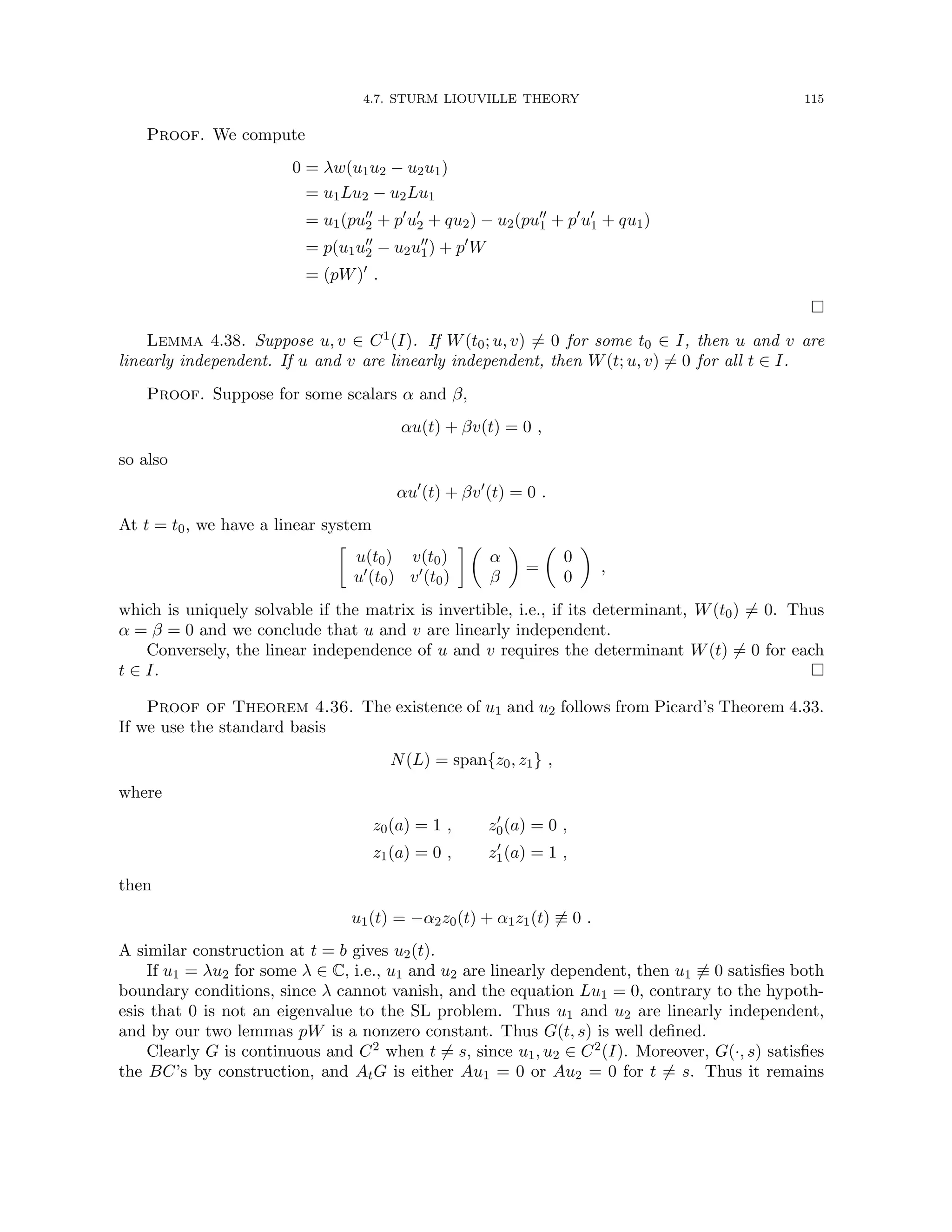
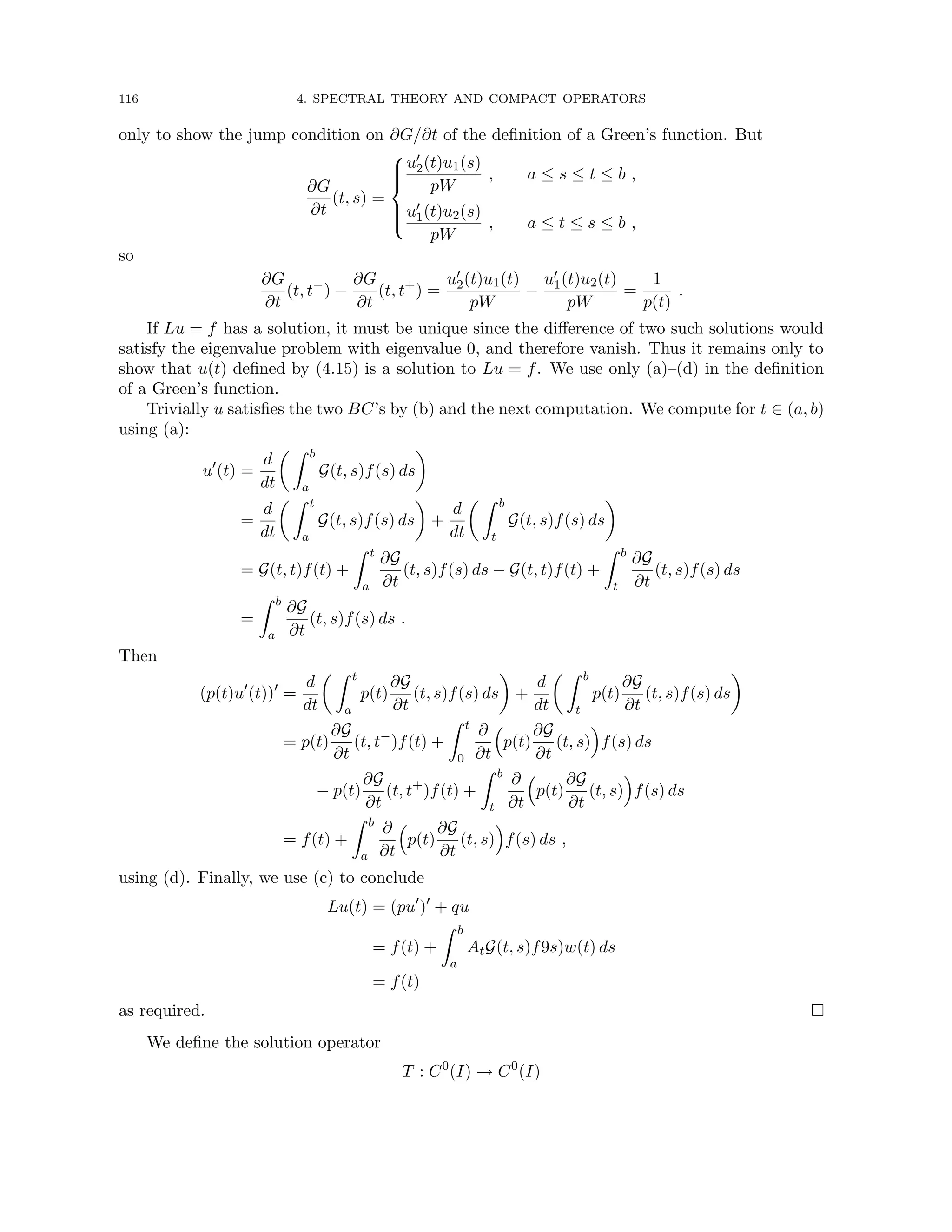
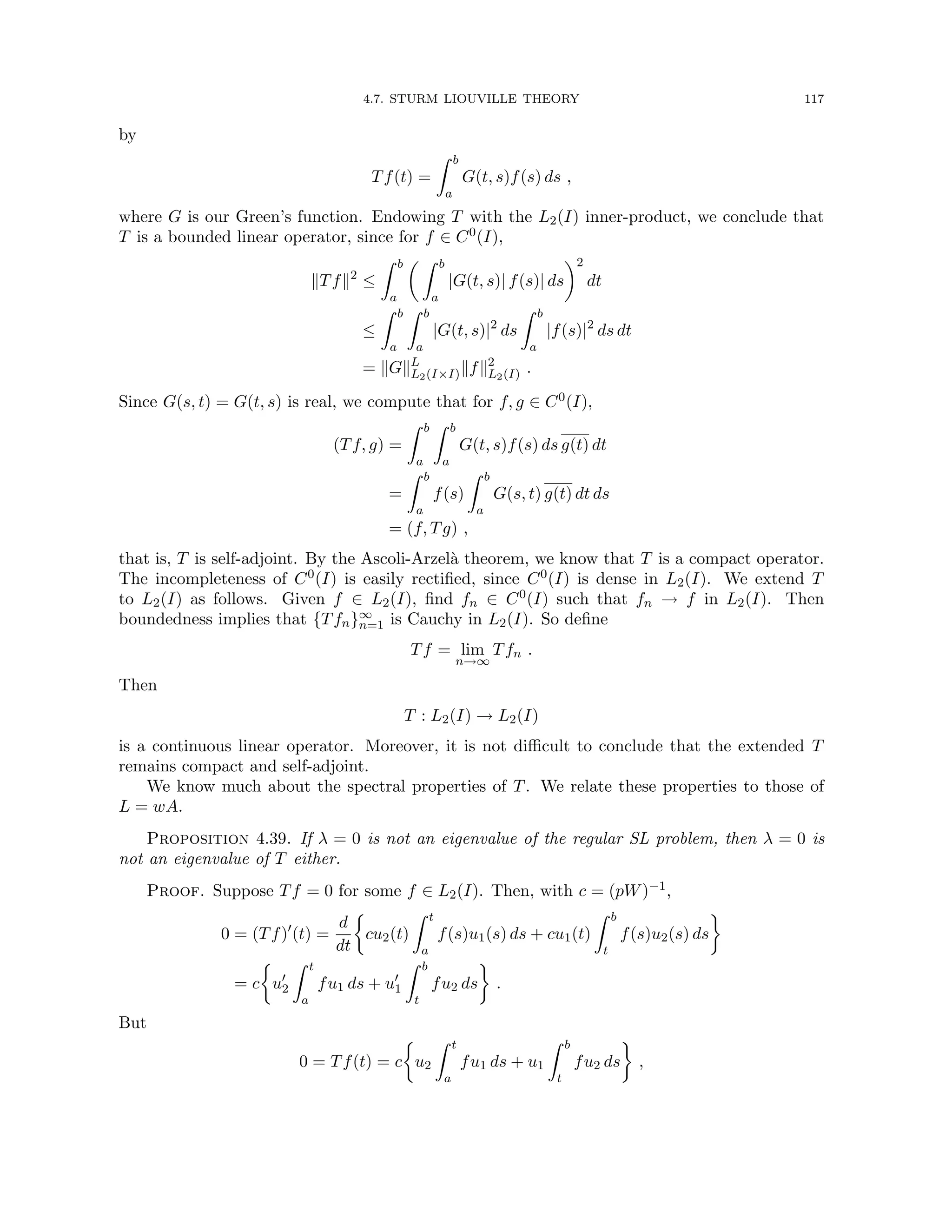
![118 4. SPECTRAL THEORY AND COMPACT OPERATORS
so, since W(t; u1, u2) 6= 0, the solution of this linear system is trivial; that is, for each t ∈ [a, b],
Z t
a
fu1 ds =
Z b
t
fu2 ds = 0 .
We conclude that
f(t)u1(t) = f(t)u2(t) = 0 ,
so f = 0, since u1 and u2 cannot both vanish at the same point (W 6= 0). Thus N(T) = {0}
and 0 /
∈ σp(T).
Proposition 4.40. Suppose λ 6= 0. Then λ is an eigenvalue of the regular SL problem if
and only if 1/λ is an eigenvalue of T. Moreover, the corresponding eigenspaces coincide.
Proof. If f ∈ C0(I) is an eigenfunction for L, then
Lf = λf ,
so
f = TLf = λTf
shows that
Tf =
1
λ
f .
Conversely, suppose f ∈ L2(I) is an eigenfunction for T:
Tf =
1
λ
f .
Since G is continuous, in fact R(T) ⊂ C0(I), so f ∈ C0(I) and
f = LTf =
1
λ
Lf .
We return to our original operator A = 1
w L. Define the inner-product on L2(I)
hf, giw =
Z b
a
f(t) g(t) w(t) dt .
This induces a norm equivalent to the usual L2(I)-norm, since
0 min
s∈I
w(s) ≤ w(t) ≤ max
s∈I
w(s) ∞
for all t ∈ I. Define K : L2(I) → L2(I) by
Kf(t) =
Z b
a
G(t, s)f(s)w(s) ds .
This is the solution operator for
Au = f .
With the usual inner-product on L2(I), K is not self-adjoint; however, with h·, ·iw, K is self-
adjoint. The proof of the following result is left as an exercise .](https://image.slidesharecdn.com/appliedmathematicsmethods-230215152718-28efe5ed/75/applied-mathematics-methods-pdf-118-2048.jpg)
![4.7. STURM LIOUVILLE THEORY 119
Proposition 4.41. The operator K is self-adjoint and compact on (L2(I), h·, ·iw), 0 /
∈
σp(K), and
σ(K) = {0} ∪ {λ 6= 0 : 1/λ is an eigenvalue of A} .
Moreover, the eigenspaces of K and A coincide.
We know that dim(N(Tλ)) = dim(N(Kλ)) is finite. However, we can conclude directly that
eigenfunctions of a regular SL problem are simple (i.e., one dimensional).
Proposition 4.42. The eigenvalues of a regular SL problem are simple.
Proof. Suppose u and v are eigenvectors for λ 6= 0 an eigenvalue. Lemma 4.37 tells us
that pW = c for some constant c. If c = 0, then as p 6= 0, W ≡ 0 and u and v are linearly
independent. So suppose W(t0) 6= 0 for some t0. By Lemma 4.38, W 6= 0 for all t ∈ [a, b].
However, W(a) = 0 by the boundary conditions:
α1u(a) + α2u0
(a) = 0 ,
α1v(a) + α2v0
(a) = 0 ,
is a linear system with a nontrivial solution (α1, α2), so W(a), the determinant of the corre-
sponding matrix, vanishes. Thus u and v are linearly independent and λ is simple.
We summarize what we know about the regular SL problem for A based on the Spectral
Theorem for Compact Self-adjoint operators as applied to K. The details of the proof are left
as an exercise.
Theorem 4.43. Let a, b ∈ R, a b, I = [a, b], p ∈ C1(I), p 6= 0, q ∈ C0(I), and w ∈ C0(I),
w 0. Let
A =
1
w
[DpD + q]
be a formally self-adjoint regular SL operator with boundary conditions
α1u(a) + α2u0
(a) = 0 ,
β1u(b) + β2u0
(b) = 0 ,
for u ∈ C2(I), where α2
1 + α2
2 6= 0 and β2
1 + β2
2 6= 0, αi, βi ∈ R. If 0 is not an eigenvalue of A,
then A has a countable collection of real eigenvalues {λn}∞
n=1 such that
|λn| → ∞ as n → ∞
and each eigenspace is one-dimensional. Let {un}∞
n=1 be the corresponding normalized eigen-
functions. These form an ON basis for (L2(I), h·, ·iw), so if u ∈ L2(I),
u =
∞
X
n=1
hu, uniwun
and, provided Au ∈ L2(I),
Au =
∞
X
n=1
λnhu, uniwun .](https://image.slidesharecdn.com/appliedmathematicsmethods-230215152718-28efe5ed/75/applied-mathematics-methods-pdf-119-2048.jpg)
![120 4. SPECTRAL THEORY AND COMPACT OPERATORS
We saw earlier that the regular SL problem
(
−x00 = λx , t ∈ (0, 1) ,
x(0) = x(1) = 0 ,
has eigenvalues
λn = n2
π2
, n = 1, 2, . . .
and corresponding (normalized) eigenfunctions
un(t) =
√
2 sin(nπt) .
Given any f ∈ L2(0, 1), we have its sine series
f(t) =
∞
X
n=1
2
Z 1
0
f(s) sin nπs ds
sin nπt ,
where equality holds for a.e. t ∈ [0, 1], i.e., in L2(0, 1). This shows that L2(0, 1) is separable.
By iterating our result, we can decompose any f ∈ L2(I × I), I = (0, 1). For a.e. x ∈ I,
f(x, y) =
∞
X
n=1
2
Z 1
0
f(x, t) sin nπt dt
sin nπy
= 4
∞
X
n=1
Z 1
0
∞
X
m=1
Z 1
0
f(s, t) sin mπs ds sin nπt dt sin nπy sin nπx
= 4
∞
X
n=1
∞
X
m=1
Z 1
0
Z 1
0
f(s, t) sin mπs sin nπt ds dt sin nπx sin nπy .
So L2(I × I) has the ON basis
{2 sin nπx sin nπy}∞,∞
m=1, n=1 ,
and again L2(I × I) is separable. Continuing, we can find a countable basis for any L2(R),
R = Id, d = 1, 2, . . . . By dilation and translation, we can replace R by any rectangle, and since
L2(Ω) ⊂ L2(R) whenever Ω ⊂ R (if we extend the domain of f ∈ L2(Ω) by defining f ≡ 0 on
R Ω), L2(Ω) is separable for any bounded Ω, but the construction of a basis is not so clear.
The regular SL problem
(
−x00 = λx , t ∈ (0, 1) ,
x0(0) = x0(1) = 0 ,
gives the eigenfunctions
un(t) =
√
2 cos(nπt) .
These are used to define cosine series expansions, similar to the development above. The
problem
−x00 = λx , t ∈ (0, 1) ,
x(0) = x(1) ,
x0(0) = x0(1) ,](https://image.slidesharecdn.com/appliedmathematicsmethods-230215152718-28efe5ed/75/applied-mathematics-methods-pdf-120-2048.jpg)
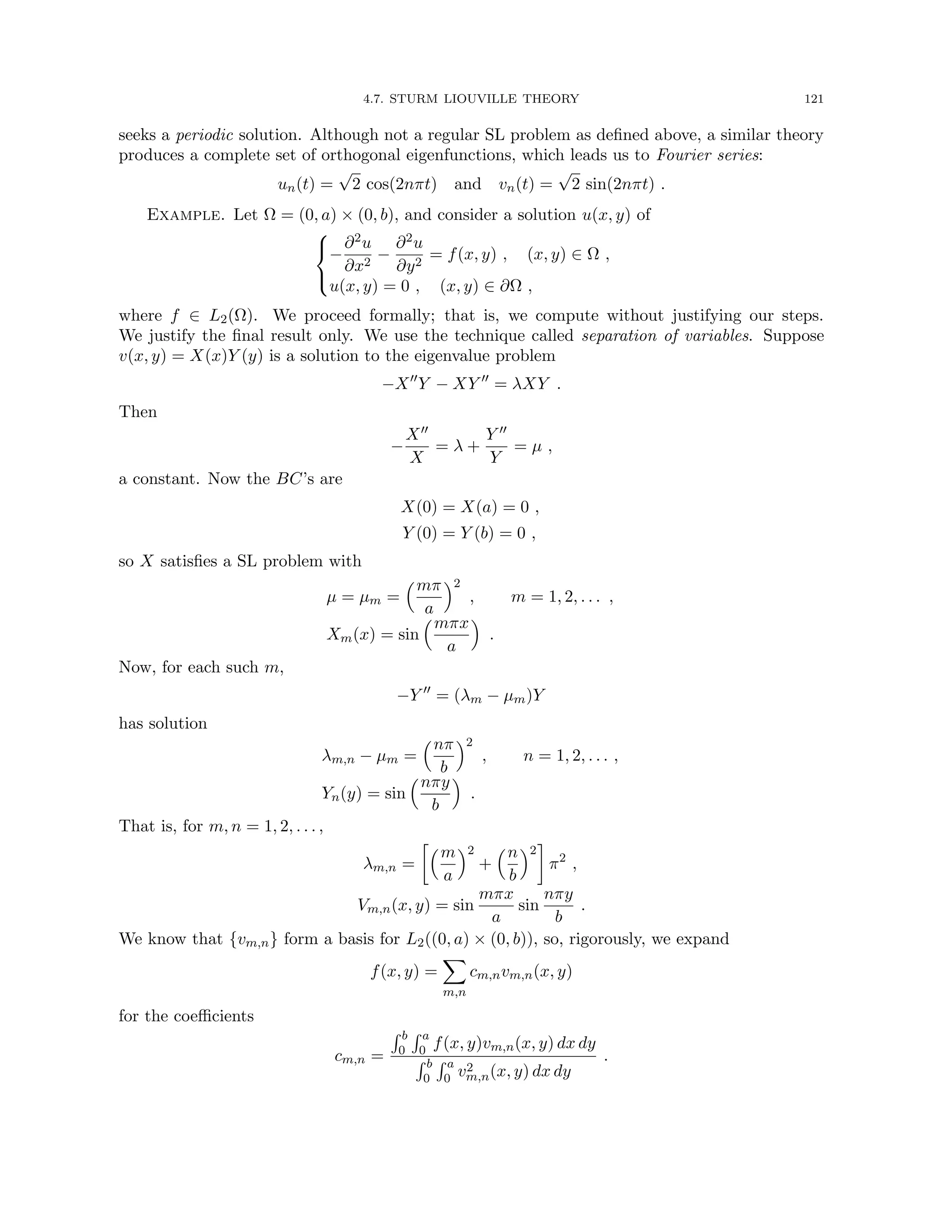
![122 4. SPECTRAL THEORY AND COMPACT OPERATORS
Forming
u(x, y) ≡
X
m,n
cm,n
p
λm,n
vm,n(x, y) ,
we verify that indeed u is a solution to the problem.
4.8. Exercises
1. Let {xn}∞
n=1 be an orthonormal set in a Hilbert space H. Let {an}∞
n=1 be a sequence of
non-negative numbers and let
S =
x ∈ H : x =
∞
X
n=1
bnxn and |bn| ≤ an for all n
.
Show that S is compact if and only if
P∞
n=1 a2
n ∞.
2. Let H be a Hilbert space and P ∈ B(H, H) a projection.
(a) Show that P is an orthogonal projection if and only if P = P∗.
(b) If P is an orthogonal projection, find σp(P), σc(P), and σr(P).
3. Let A be a self-adjoint, compact operator on a Hilbert space. Prove that there are positive
operators P and N such that A = P − N and PN = 0. (An operator T is positive if
(Tx, x) ≥ 0 for all x ∈ H.) Prove the conclusion if A is merely self-adjoint.
4. Let T be a compact, positive operator on a complex Hilbert space H. Show that there is a
unique positive operator S on H such that S2 = T. Moreover, show that S is compact.
5. Give an example of a self-adjoint operator on a Hilbert space that has no eigenvalues (see
[Kr], p. 464, no. 9).
6. Let H be a separable Hilbert space and T a positive operator on H. Let {en}∞
n=1 be an
orthonormal base for H and suppose that tr(T) is finite, where
tr(T) =
∞
X
n=1
(Ten, en) .
Show the same is true for any other orthonormal base, and that the sum is independent of
which base is chosen. Show that this is not necessarily true if we omit the assumption that
T is positive.
7. Let H be a Hilbert space and S ∈ B(H, H). Define |S| to be the square root of S∗S. Extend
the definition of trace class to non-positive operators by saying that S is of trace class if
T = |S| is such that tr(T) is finite. Show that the trace class operators form an ideal in
B(H, H).
8. Show that T ∈ B(H, H) is a trace class operator if and only if T = UV where U and V are
Hilbert-Schmidt operators.
9. Derive a spectral theorem for compact normal operators.
10. Define the operator T : L2(0, 1) → L2(0, 1) by
Tu(x) =
Z x
0
u(y) dy .](https://image.slidesharecdn.com/appliedmathematicsmethods-230215152718-28efe5ed/75/applied-mathematics-methods-pdf-122-2048.jpg)
![4.8. EXERCISES 123
Show that T is compact, and find the eigenvalues of the self-adjoint compact operator T∗T.
[Hint: T∗ involves integration, so differentiate twice to get a second order ODE with two
boundary conditions.]
11. For the differential operator
L = D2
+ xD ,
find a multiplying factor w so that wL is formally self adjoint. Find boundary conditions
on I = [0, 1] which make this operator into a regular Sturm-Liouville problem for which 0 is
not an eigenvalue.
12. Give conditions under which the Sturm-Liouville operator
L = DpD + q ,
defined over an interval I = [a, b], is a positive operator.
13. Write the Euler operator
L = x2
D2
+ xD
with the boundary conditions u(1) = u(e) = 0 on the interval [1, e] as a regular Sturm-
Liouville problem with an appropriate weight function w. Find the eigenvalues and eigen-
functions for this problem.
14. Prove that eigenfunctions of distinct eigenvalues are linearly independent.](https://image.slidesharecdn.com/appliedmathematicsmethods-230215152718-28efe5ed/75/applied-mathematics-methods-pdf-123-2048.jpg)

![CHAPTER 5
Distributions
The theory of distributions, of “generalized functions,” provides a general setting within
which differentiation may be understood and exploited. It underlies the modern study of differ-
ential equations, optimization, the calculus of variations, and any subject utilizing differentiation.
5.1. The Notion of Generalized Functions
The classic definition of the derivative is rather restrictive. For example, consider the function
defined by
f(x) =
x , x ≥ 0 ,
0 , x 0 .
Then f ∈ C0(−∞, ∞) and f is differentiable at every point except 0. The derivative of f is the
Heaviside function
H(x) =
1 , x 0 ,
0 , x 0 .
(5.1)
The nondifferentiability of f at 0 creates no particular problem, so should we consider f differ-
entiable on (−∞, ∞)? The derivative of H is also well defined, except at 0. However, it would
appear that
H0
(x) =
0 , x 6= 0 ,
+∞ , x = 0 ,
at least in some sense. Can we make a precise statement? That is, can we generalize the notion
of function so that H0 is well defined?
We can make a precise statement if we use integration by parts. Recall that if u, φ ∈
C1([a, b]), then
Z b
a
u0
φ dx = uφ
b
a
−
Z b
a
uφ0
dx .
If φ ∈ C1 but u ∈ C0 r C1, we can define “
R b
a u0v dx” by the expression
uφ
b
a
−
Z b
a
uφ0
dx .
If we have enough “test functions” φ ∈ C1, then we can determine properties of u0. In practice,
we take φ ∈ C∞
0 (−∞, ∞) = {ψ ∈ C∞(−∞, ∞) : ∃ R 0 such that ψ(x) = 0 ∀ |x| R} so that
the boundary terms vanish for a → −∞, b → ∞.
125](https://image.slidesharecdn.com/appliedmathematicsmethods-230215152718-28efe5ed/75/applied-mathematics-methods-pdf-125-2048.jpg)
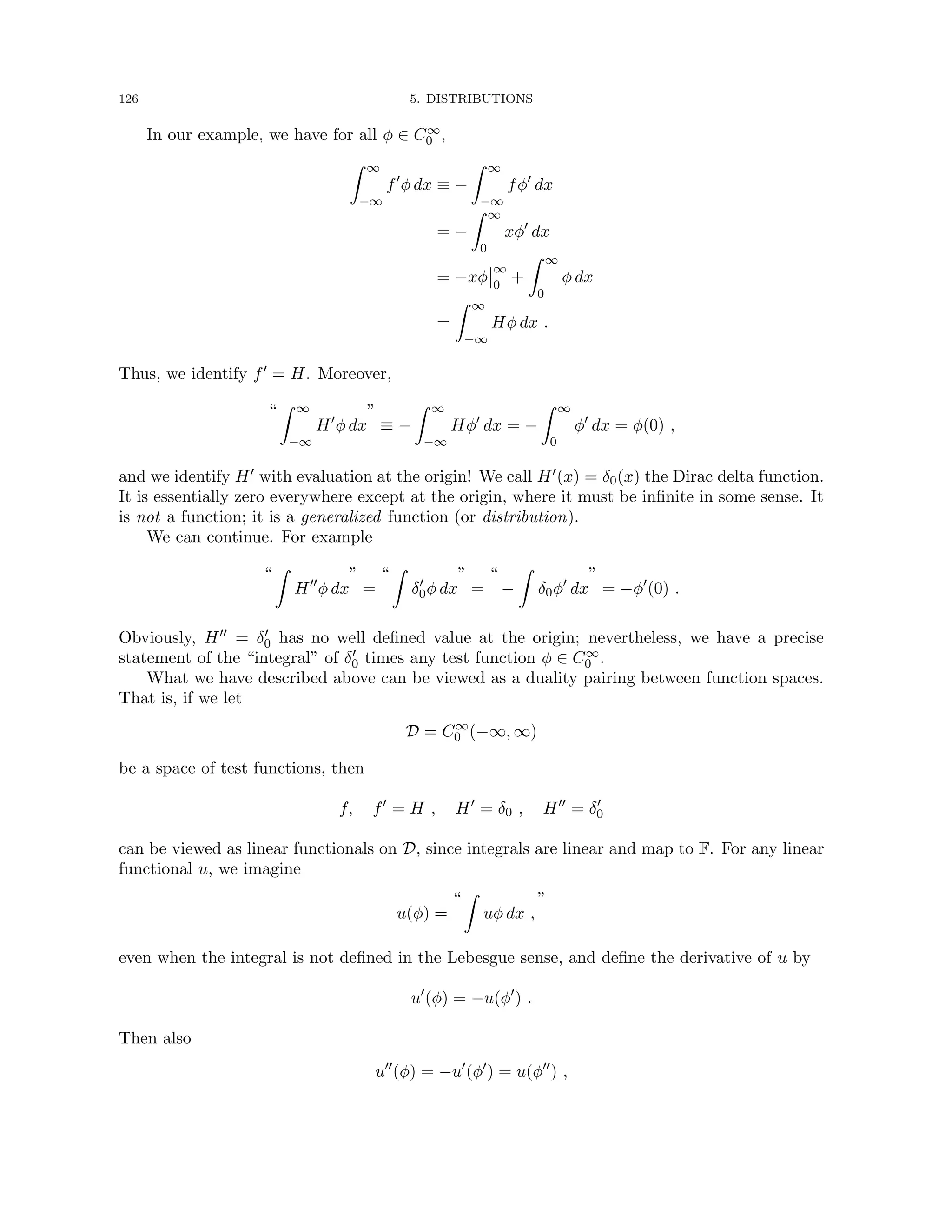
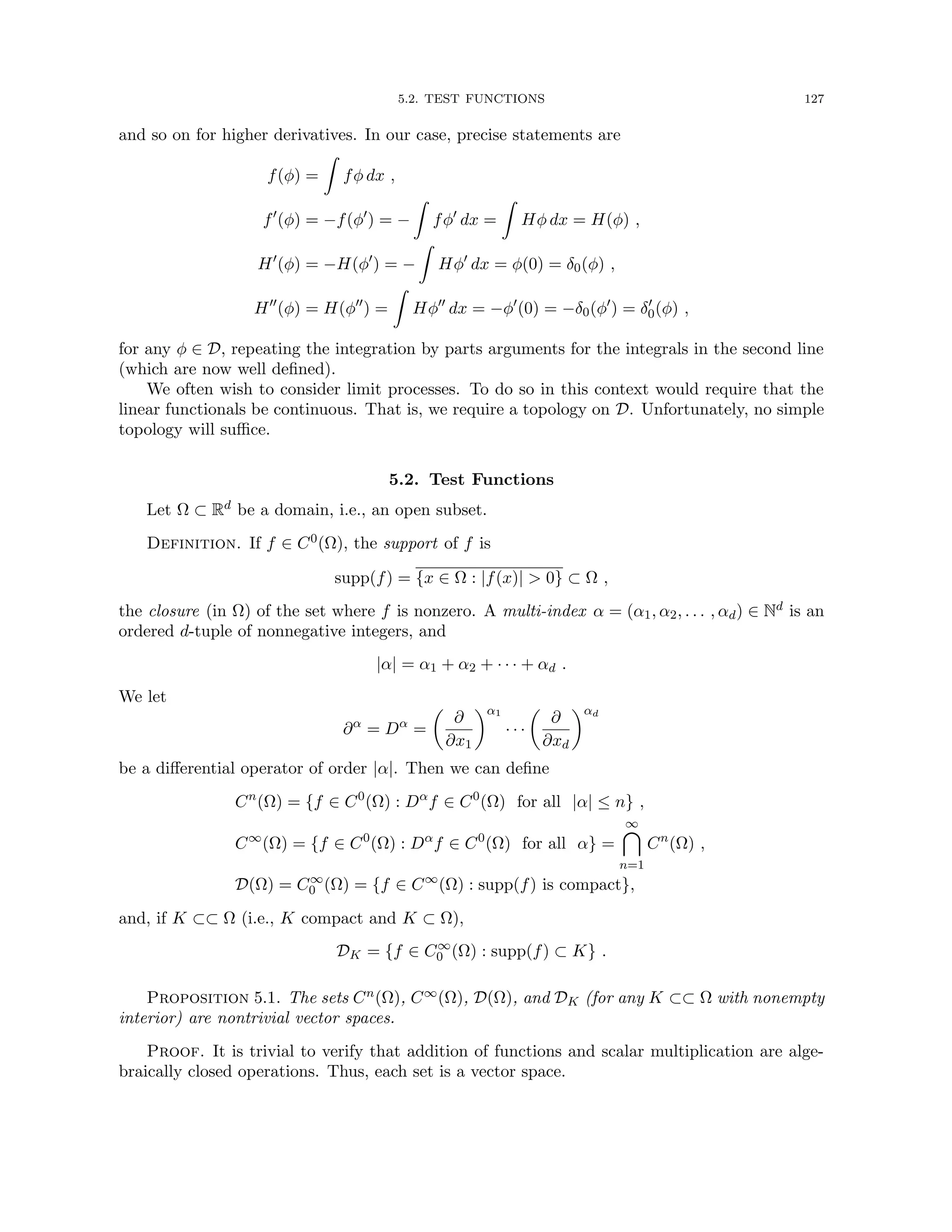
![128 5. DISTRIBUTIONS
To see that these spaces are nonempty, we construct an element of DK ⊂ D(Ω) ⊂ C∞(Ω) ⊂
Cn(Ω). Consider first Cauchy’s infinitely differentiable function ψ : R → R given by
ψ(x) =
e−1/x2
, x 0,
0 , x ≤ 0.
(5.2)
This function is clearly infinitely differentiable for x 6= 0, and its mth derivative takes the form
ψ(m)
(x) =
Rm(x)e−1/x2
, x 0,
0 , x 0,
for some polynomial divided by x to a power Rm(x). But L’Hôpital’s rule implies that
lim
x→0
Rm(x)e−1/x2
= 0 ,
so in fact ψ(m) is continuous at 0 for all m, and thus ψ is infinitely differentiable.
Now let φ(x) = ψ(1 − x)ψ(1 + x). Then φ ∈ C∞
0 (R) and supp(φ) = [−1, 1]. Finally, for
x ∈ Rd,
Φ(x) = φ(x1)φ(x2) . . . φ(xd) ∈ C∞
(Rd
)
has support [−1, 1]d. By translation and dilation, we can construct an element of DK.
Corollary 5.2. There exist nonanalytic functions.
That is, there are functions not given by their Taylor series, since the Taylor series of ψ(x)
about 0 is 0, but ψ(x) 6= 0 for x 0.
We define a norm on Cn(Ω) by
kφkn,∞,Ω =
X
|α|≤n
kDα
φkL∞(Ω) .
Then Cn(Ω) is a Banach space, since completeness follows from the fact that, on compact
subsets, the uniform limit of continuous functions is continuous. Note that if m ≥ n, then
kφkm,∞,Ω ≥ kφkn,∞,Ω, so we have a nested sequence of norms. We will use these to define
convergence in D(Ω), but we must be careful, as the following example shows.
Example. Take any φ ∈ C∞
0 (R) such that supp(φ) = [0, 1] and φ(x) 0 for x ∈ (0, 1)
(for example, we can construct such a function using Cauchy’s infinitely differentiable function
(5.2)). Define for any integer n ≥ 1
ψn(x) =
n
X
j=1
1
j
φ(x − j) ∈ C∞
0 (R) ,
for which supp(ψn) = [1, n + 1]. Define also
ψ(x) =
∞
X
j=1
1
j
φ(x − j) ∈ C∞
(R) r C∞
0 (R) .
Now it is easy to verify that for any m ≥ 0,
Dm
ψn
L∞
−→ Dm
ψ ;
that is,
kψn − ψkm,∞,R → 0](https://image.slidesharecdn.com/appliedmathematicsmethods-230215152718-28efe5ed/75/applied-mathematics-methods-pdf-128-2048.jpg)
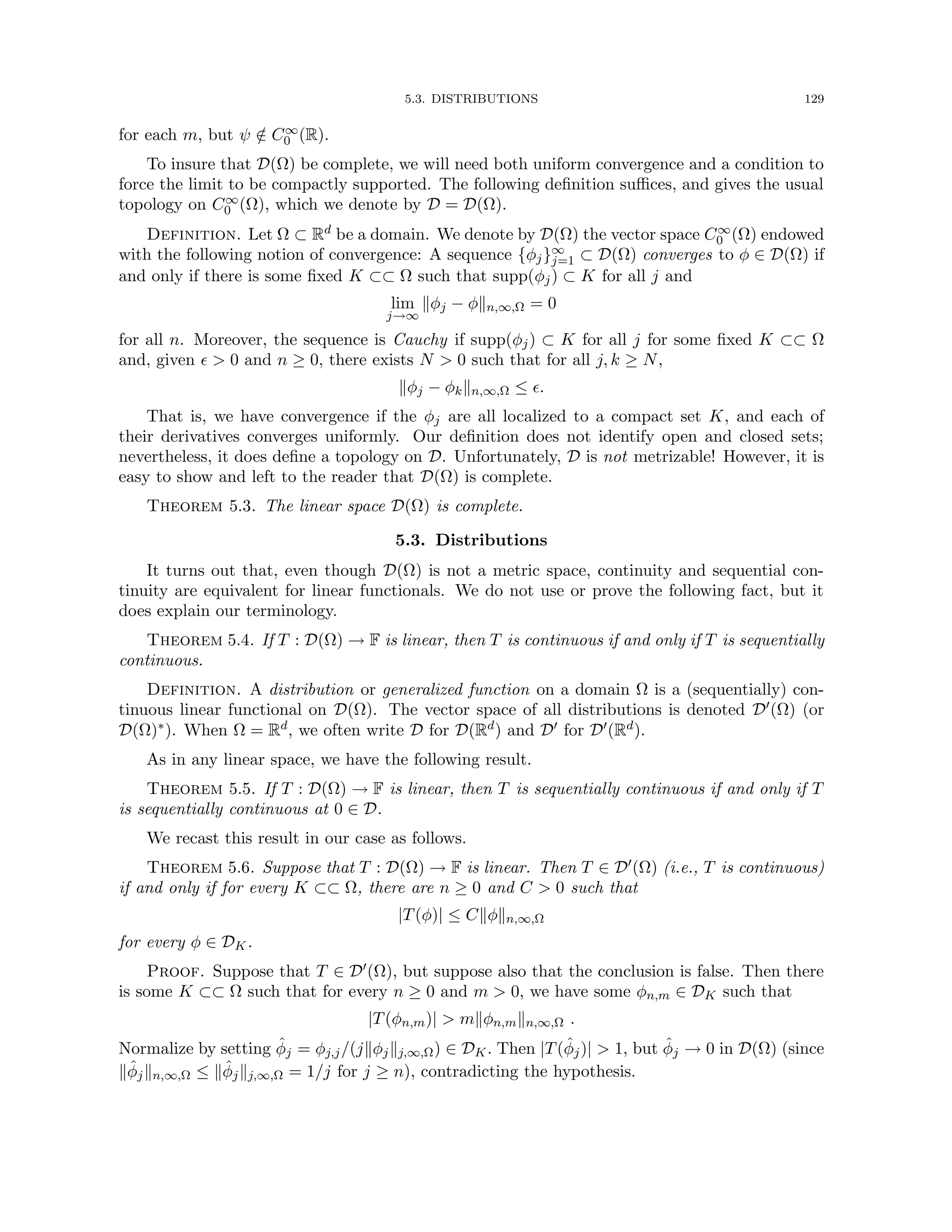
![130 5. DISTRIBUTIONS
For the converse, suppose that φj → 0 in D(Ω). Then there is some K ⊂⊂ Ω such that
supp(φj) ⊂ K for all j, and, by hypothesis, some n and C such that
|T(φj)| ≤ Ckφjkn,∞,Ω → 0.
That is, T is (sequentially) continuous at 0.
We proceed by giving some important examples.
Definition.
L1,loc(Ω) =
n
f : Ω → F | f is measurable and for every K ⊂⊂ Ω ,
Z
K
|f(x)| dx ∞
o
.
Note that L1(Ω) ⊂ L1,loc(Ω). Any polynomial is in L1,loc(Ω) but not in L1(Ω), if Ω is
unbounded. Elements of L1,loc(Ω) may not be too singular at a point, but they may grow at
infinity.
Example. If f ∈ L1,loc(Ω), we define Λf ∈ D0(Ω) by
Λf (φ) =
Z
Ω
f(x)φ(x) dx
for every φ ∈ D(Ω). Now Λf is obviously a linear functional; it is also continuous, since for
φ ∈ DK,
|Λf (φ)| ≤
Z
K
|f(x)| |φ(x)| dx ≤
Z
K
|f(x)| dx
kφk0,∞,Ω
satisfies the requirement of Theorem 5.6.
The mapping f 7→ Λf is one to one in the following sense.
Proposition 5.7 (Lebesgue Lemma). Let f, g ∈ L1,loc(Ω). Then Λf = Λg if and only if
f = g almost everywhere.
Proof. If f = g a.e., then obviously Λf = Λg. Conversely, suppose Λf = Λg. Then
Λf−g = 0 by linearity. Let
R = {x ∈ Rd
: ai ≤ x ≤ bi, i = 1, . . . , d} ⊂ Ω
be an arbitrary closed rectangle, and let ψ(x) be Cauchy’s infinitely differentiable function on
R given by (5.2). For ε 0, let
φε(x) = ψ(ε − x)ψ(x) ≥ 0
and
Φε(x) =
Z x
−∞
φε(ξ) dξ
Z ∞
−∞
φε(ξ) dξ
.
Then supp(φε) = [0, ε], 0 ≤ Φε(x) ≤ 1, Φε(x) = 0 for x ≤ 0, and Φε(x) = 1 for x ≥ ε.
Now let
Ψε(x) =
d
Y
i=1
Φε(xi − ai)Φε(bi − xi) ∈ DR .](https://image.slidesharecdn.com/appliedmathematicsmethods-230215152718-28efe5ed/75/applied-mathematics-methods-pdf-130-2048.jpg)
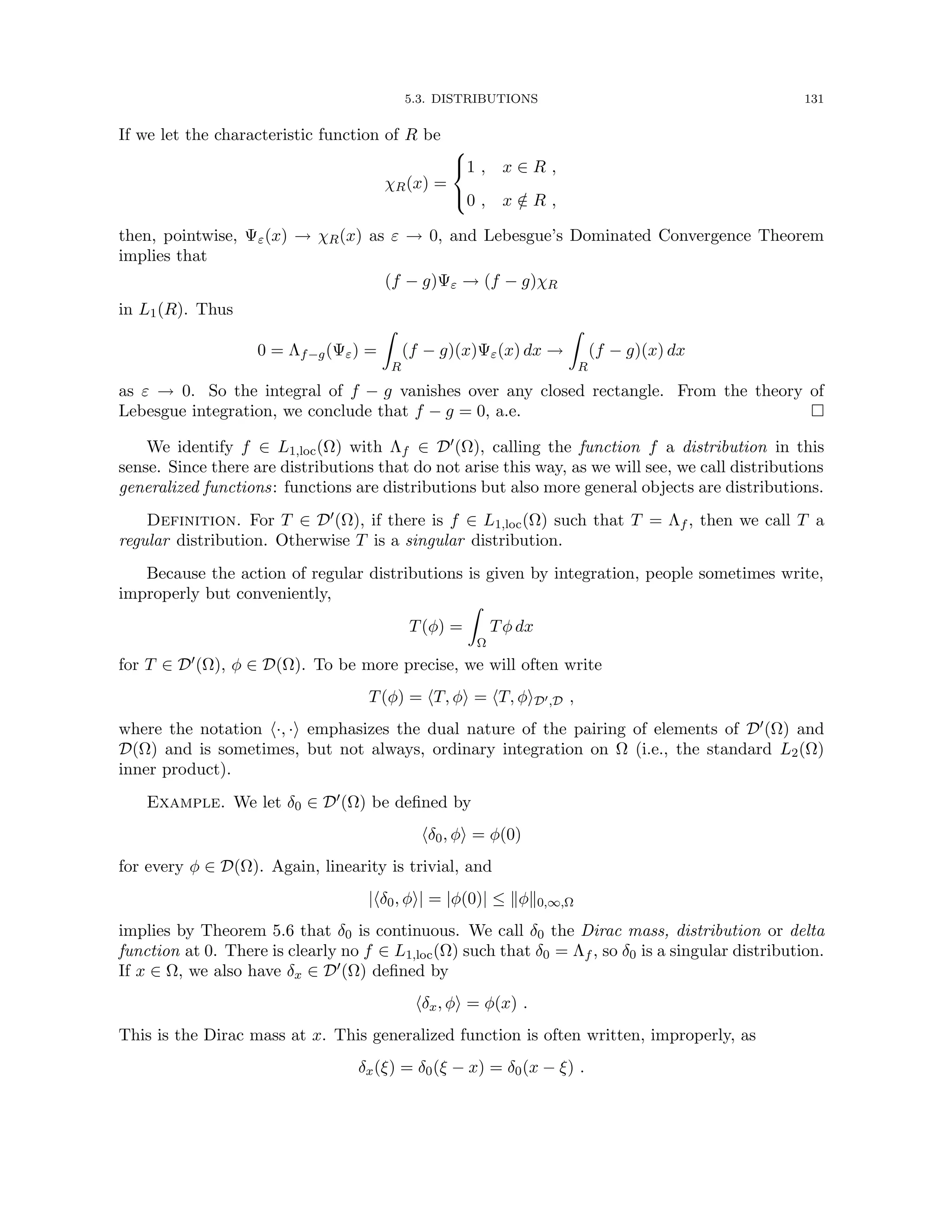
![132 5. DISTRIBUTIONS
Remark. We sketch a proof that D(Ω) is not metrizable. The details are left to the reader.
For K ⊂⊂ Ω,
DK =
x∈ΩrK
ker(δx) .
Since ker(δx) is closed, so is DK (in D(Ω)). It is easy to show that DK has empty interior in D.
But for a sequence K1 ⊂ K2 ⊂ · · · ⊂ Ω of compact sets such that
∞
[
n=1
Kn = Ω ,
we have
D(Ω) =
∞
[
n=1
DKn .
Apply the Baire Theorem to conclude that D(Ω) is not metrizable.
Example. If µ is either a complex Borel measure on Ω or a positive measure on Ω such that
µ(K) ∞ for every K ⊂⊂ Ω, then
Λµ(φ) =
Z
Ω
φ(x) dµ(x)
defines a distribution, since
|Λµ(φ)| ≤ µ(supp(φ))kφk0,∞,Ω .
Example. We define a distribution PV 1
x ∈ D0(R) by
PV
1
x
, φ = PV
Z
1
x
φ(x) dx ≡ lim
ε↓0
Z
|x|ε
1
x
φ(x) dx ,
called Cauchy’s principle value of 1/x. Since 1/x /
∈ L1,loc(R), we must verify that the limit is
well defined. Fix φ ∈ D. Then integration by parts gives
Z
|x|ε
1
x
φ(x) dx = [φ(−ε) − φ(ε)] ln ε −
Z
|x|ε
ln |x|φ0
(x) dx .
The boundary terms tend to 0:
lim
ε↓0
[φ(−ε) − φ(ε)] ln ε = lim
ε↓0
2
φ(−ε) − φ(ε)
2ε
ε ln ε = −φ0
(0) lim
ε↓0
ε ln ε = 0 .
Thus, if supp(φ) ⊂ [−R, R] = K, then
PV
Z
1
x
φ(x) = − lim
ε↓0
Z
|x|ε
ln |x|φ0
(x) dx = −
Z R
−R
ln |x|φ0
(x) dx
exists, and
PV
Z
1
x
φ(x) dx ≤
Z R
−R
ln |x| dx
kφk1,∞,R
shows that PV (1/x) is a distribution, since the latter integral is finite.](https://image.slidesharecdn.com/appliedmathematicsmethods-230215152718-28efe5ed/75/applied-mathematics-methods-pdf-132-2048.jpg)

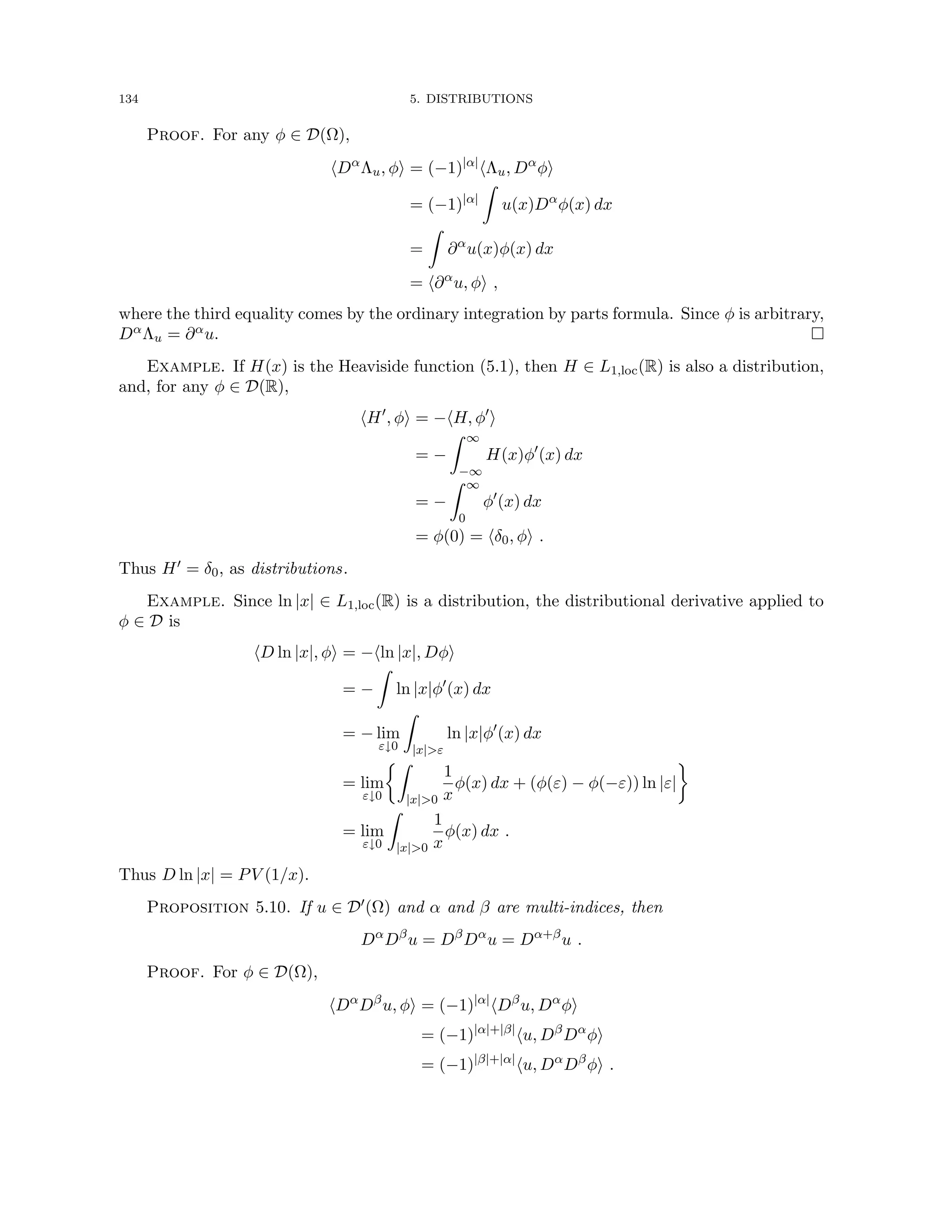
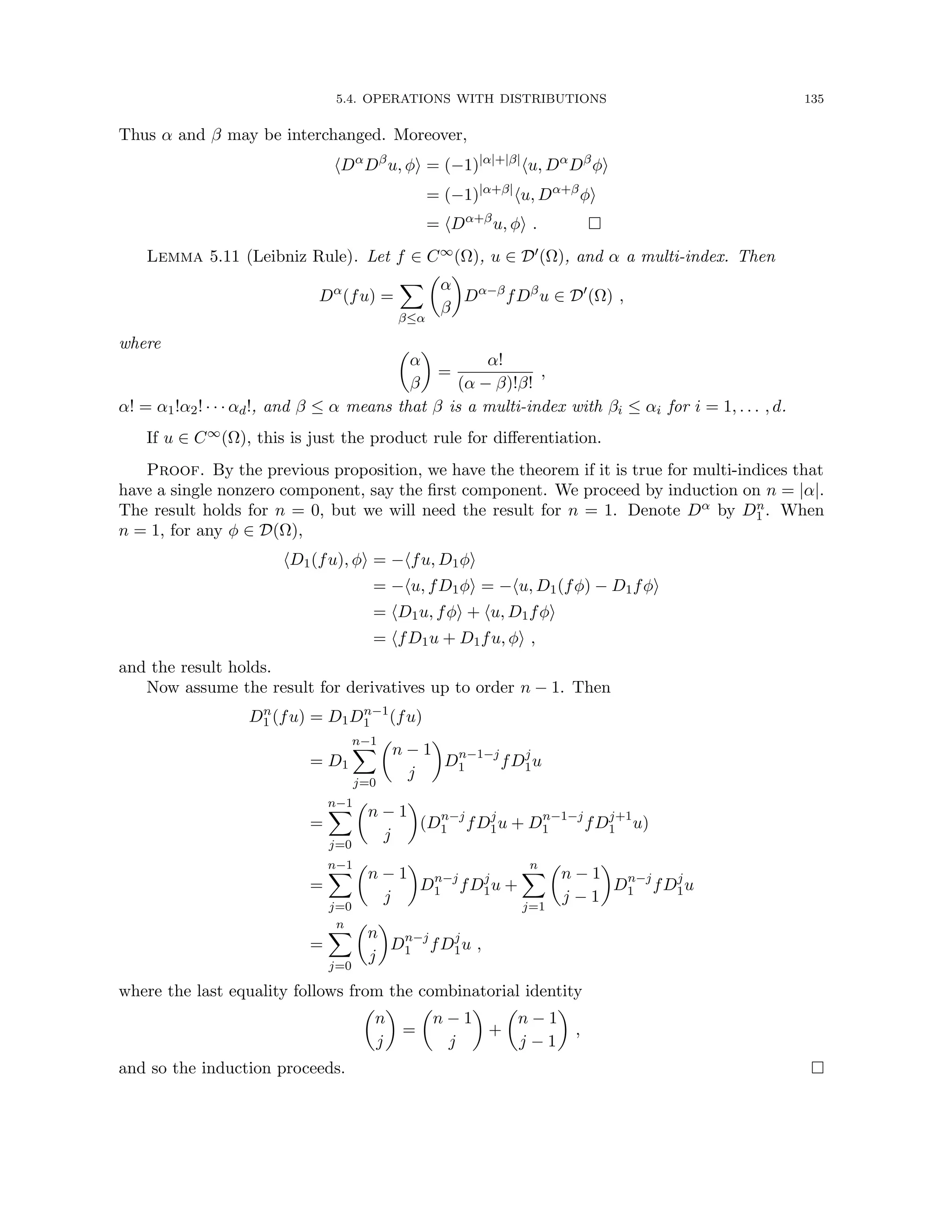
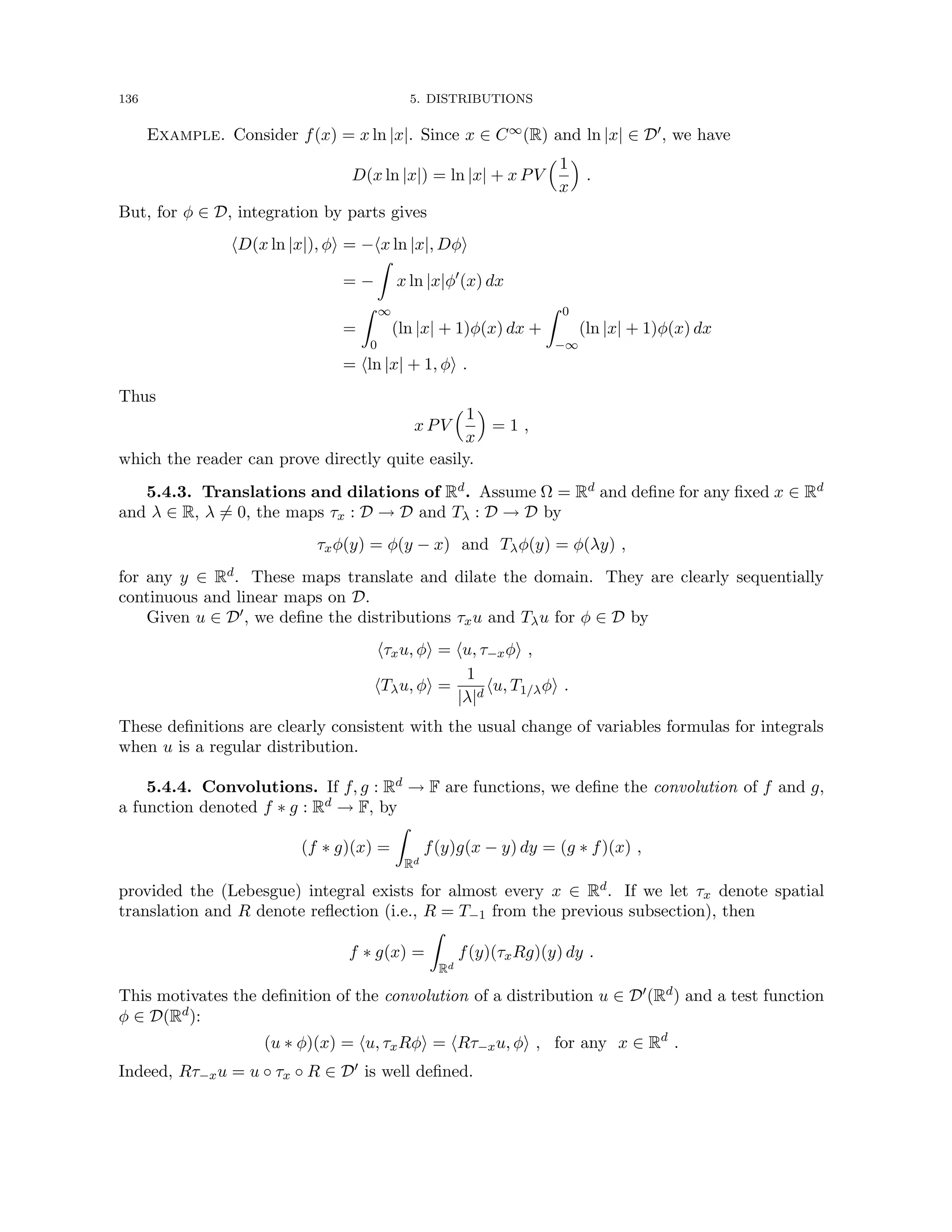
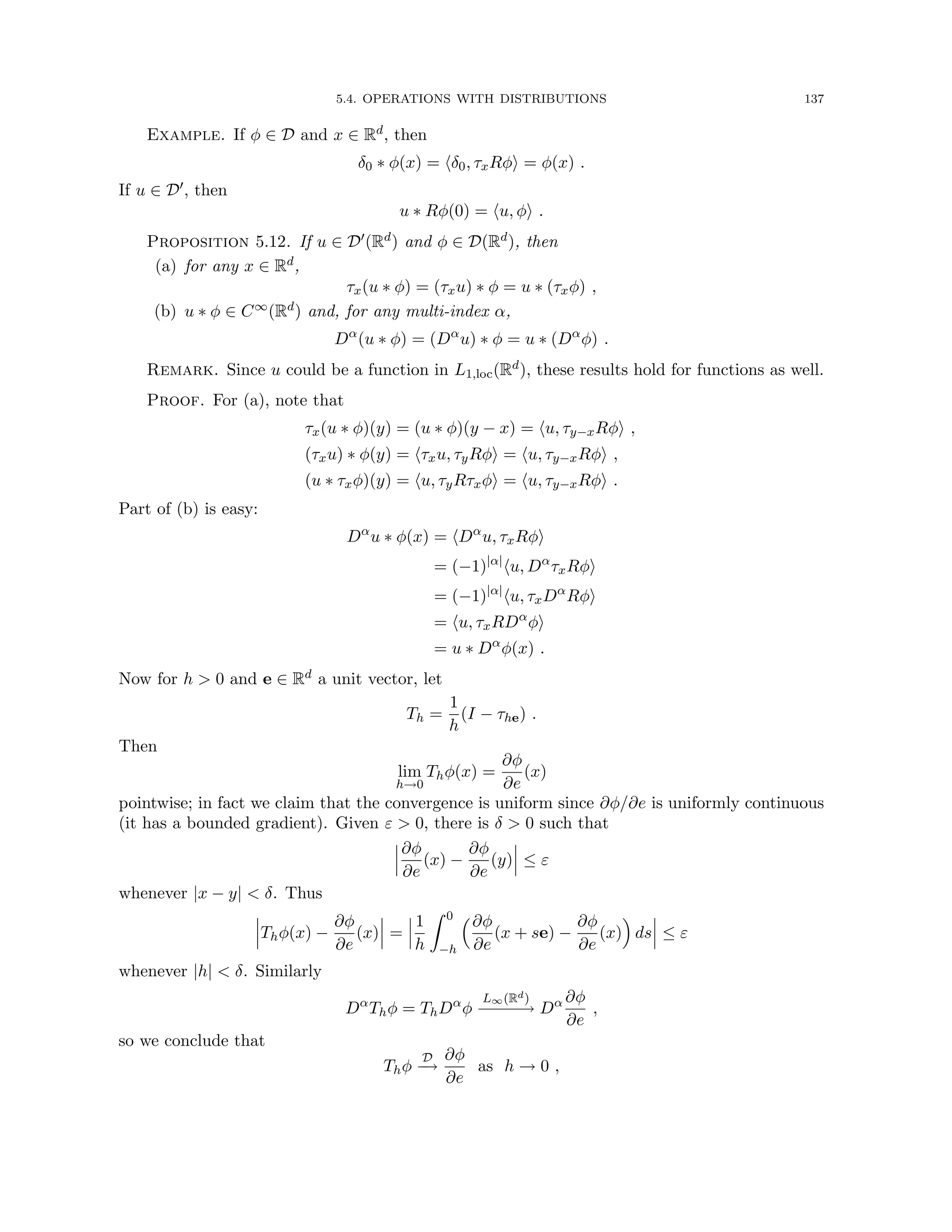
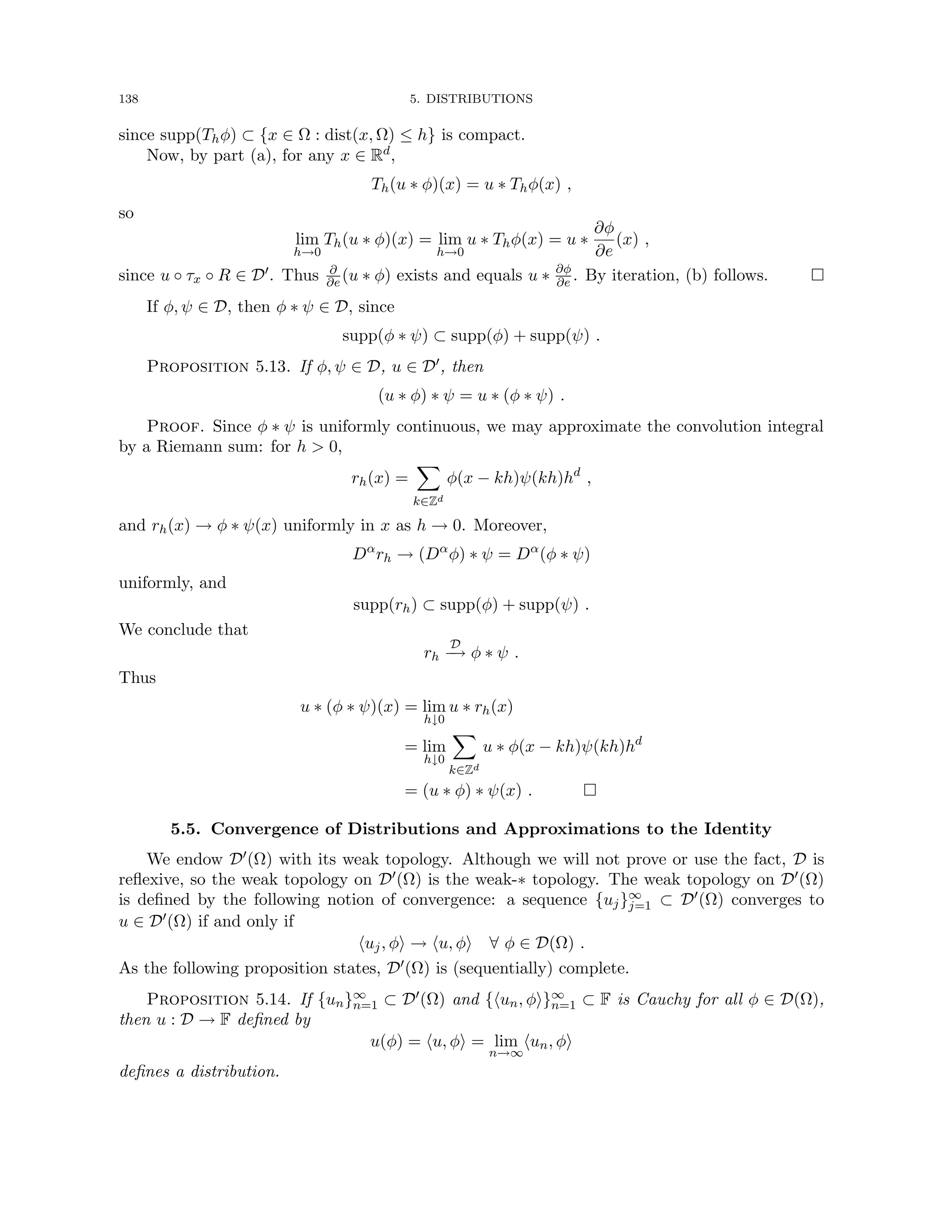
![5.5. CONVERGENCE OF DISTRIBUTIONS AND APPROXIMATIONS TO THE IDENTITY 139
The existence and linearity of u is clear. We hypothesize pointwise convergence, so the
continuity of u follows from a uniform boundedness principle, which we do not prove here (see,
e.g., [Yo] and [Ru1]).
Lemma 5.15. If T : D(Ω) → D(Ω) is continuous and linear, and if un → u in D0(Ω), then
T∗un → T∗u.
Proof. Simply compute, for φ ∈ D(Ω),
hT∗
un, φi = hun, Tφi → hu, Tφi = hT∗
u, φi .
Corollary 5.16. If un
D0(Ω)
−
−
−
→ u and α is any multi-index, then Dαun
D0(Ω)
−
−
−
→ Dαu.
Of course, we can also directly show the corollary: For any φ ∈ D,
hDα
un, φi = (−1)|α|
hun, Dα
φi → (−1)|α|
hu, Dα
φi = hDα
u, φi .
We leave the following two propositions as exercises.
Proposition 5.17. If u ∈ D0(Ω) and α is a multi-index with |α| = 1, then
lim
h→0
1
h
(u − τhαu)
D0(Ω)
−
−
−
→ Dα
u ,
wherein the first α is interpreted as a unit vector in Rd.
Proposition 5.18. Let χR(x) denote the characteristic function of R ⊂ R. For ε 0,
1
ε
χ[−ε/2,ε/2]
D0(R)
−
−
−
→ δ0
as ε → 0.
Definition. Let ϕ ∈ D(Rd) satisfy
(a) ϕ ≥ 0,
(b)
R
ϕ(x) dx = 1,
and define for ε 0
ϕε(x) =
1
εd
ϕ
x
ε
.
Then we call {ϕε}ε0 an approximation to the identity.
The following is easily verified.
Proposition 5.19. If {ϕε}ε0 is an approximation to the identity, then
Z
ϕε(x) dx = 1 ∀ ε 0
and supp(ϕε) → {0} as ε → 0.
Theorem 5.20. Let {ϕε}ε0 be an approximation to the identity.
(a) If ψ ∈ D, then ψ ∗ ϕε
D
−
→ ψ.
(b) If u ∈ D0, then u ∗ ϕε
D0
−
→ u.
Since u ∗ ϕε ∈ C∞, we see that C∞(Rd) ⊂ D0 is dense. Moreover, {ϕε}ε0 approximates the
convolution identity δ0.](https://image.slidesharecdn.com/appliedmathematicsmethods-230215152718-28efe5ed/75/applied-mathematics-methods-pdf-139-2048.jpg)
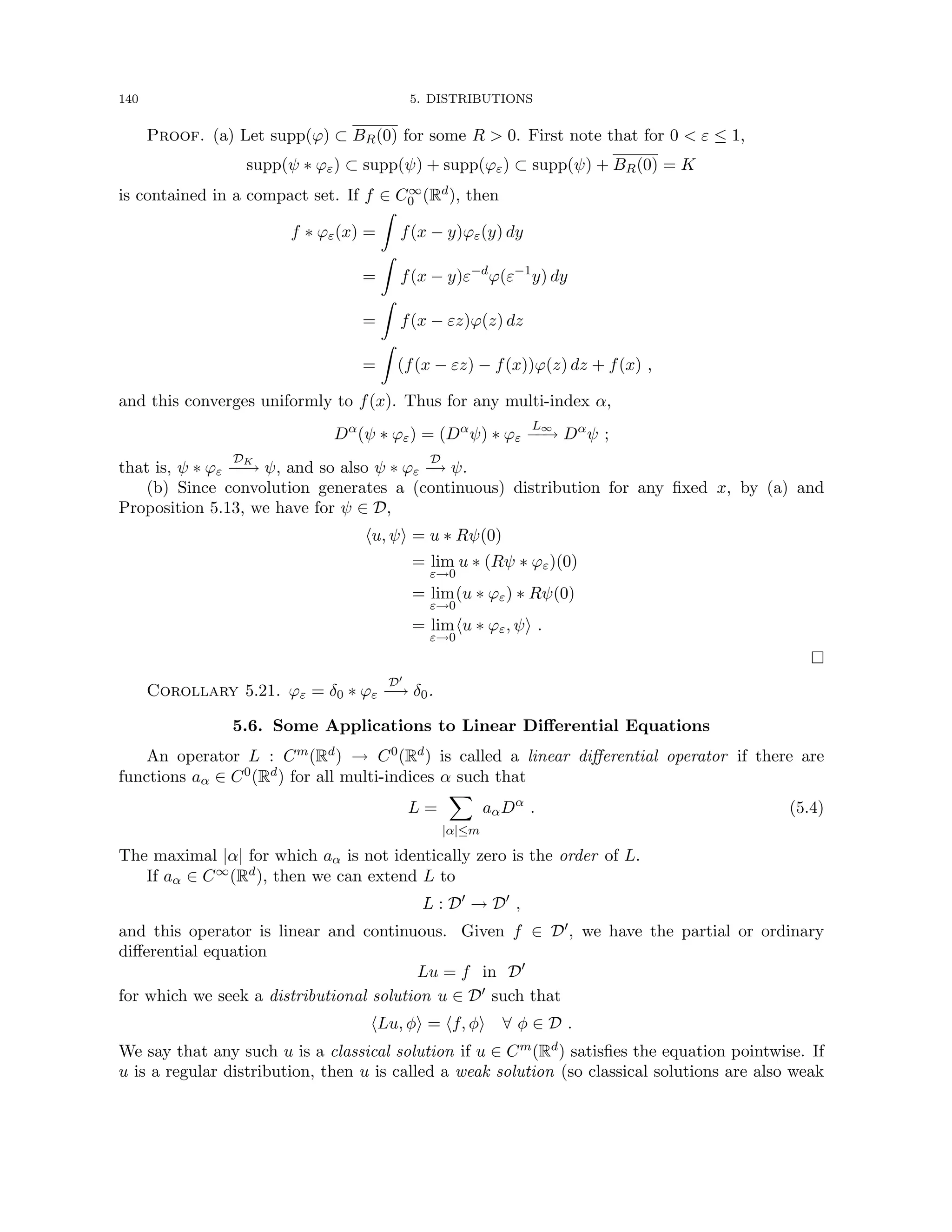
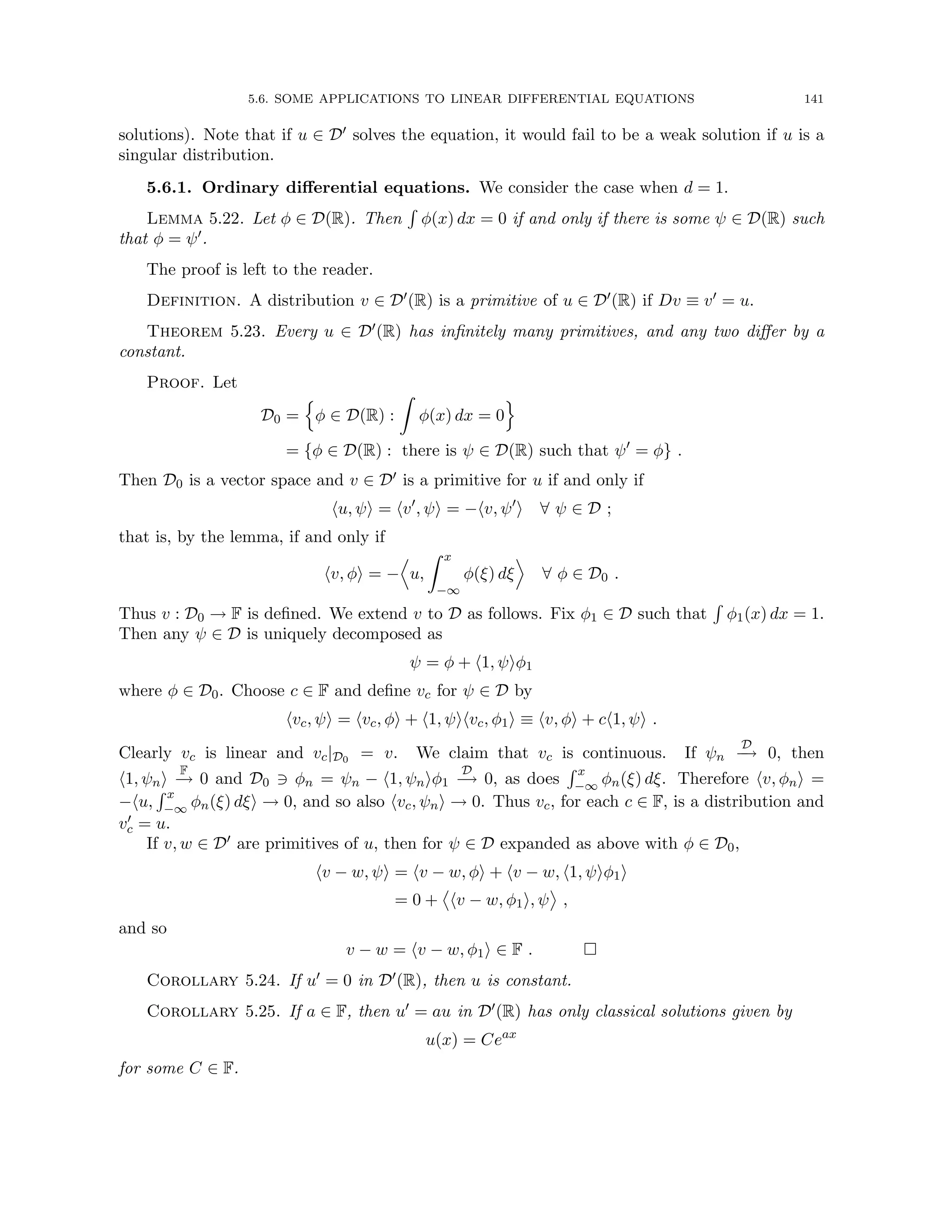
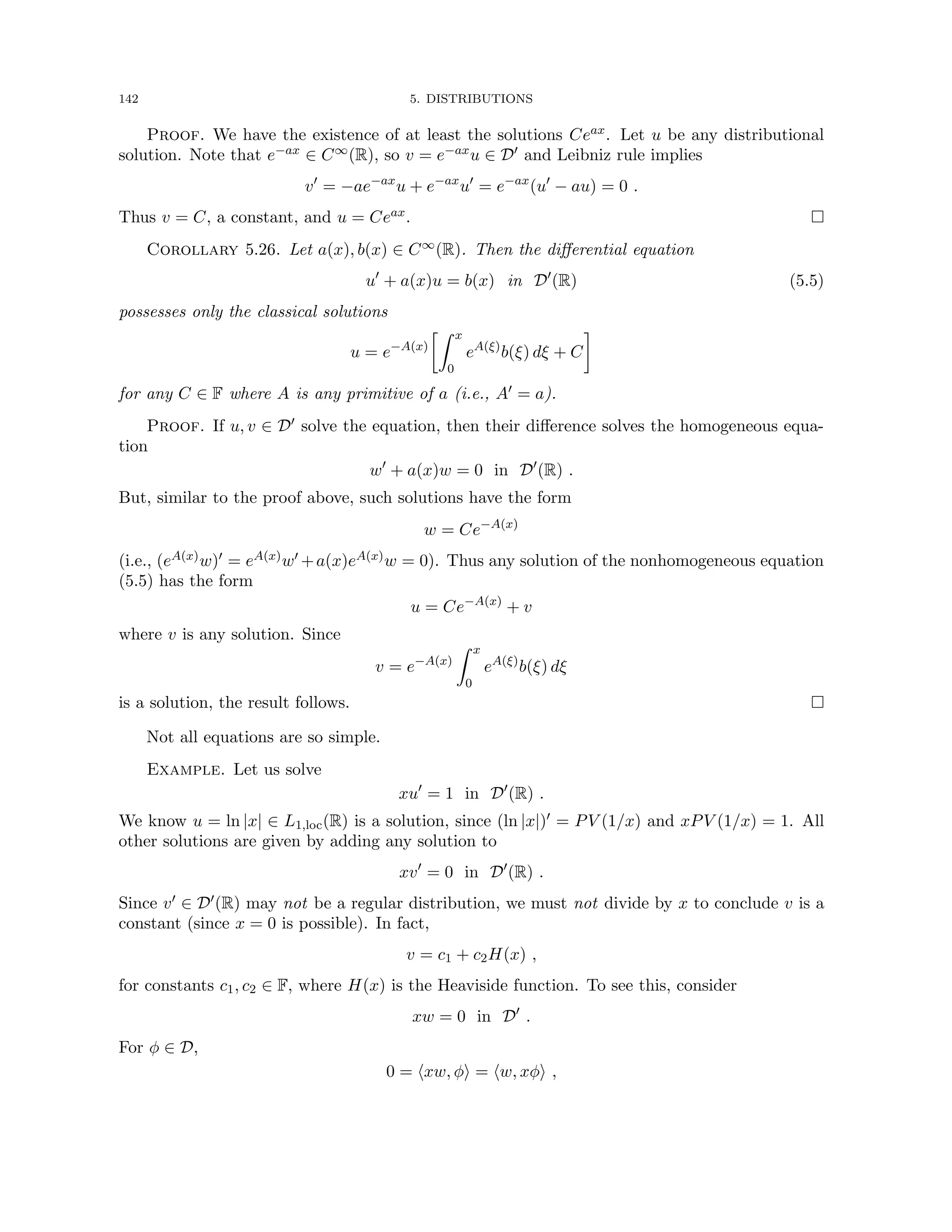

![144 5. DISTRIBUTIONS
(it is a simple exercise to verify that u is well defined in D0). Then
hLu, φi = hu, Lφi = hu, Lφi
=
u,
∂2
∂t2
− c2 ∂2
∂x2
φ
=
u,
∂
∂t
+ c
∂
∂x
∂
∂t
− c
∂
∂x
φ
=
u,
∂
∂t
+ c
∂
∂x
ψ
,
where ψ ∈ D. Continuing,
hLu, φi =
Z ∞
−∞
∂
∂t
+ c
∂
∂x
ψ(t, ct) dt =
Z ∞
−∞
d
dt
ψ(t, ct) dt = 0 .
Definition. If Lu = δ0 for some u ∈ D0, then u is called a fundamental solution of L.
If a fundamental solution u exists, it is not in general unique, since any solution to Lv = 0
gives another fundamental solution u + v. The reason for the name and its importance is given
by the following theorem.
Theorem 5.27. If f ∈ D and E ∈ D0 is a fundamental solution for L, then E ∗ f is a
solution to
Lu = f .
Proof. Since LE = δ0, then also
(LE) ∗ f = δ0 ∗ f = f .
But
(LE) ∗ f = L(E ∗ f) .
Theorem 5.28 (Malgrange and Ehrenpreis). Every constant coefficient linear partial differ-
ential operator on Rd has a fundamental solution.
A proof can be found in [Yo] and [Ru1]. The solution has a simple interpretation, referred
to as the Principle of Superposition. If we consider f as a source of disturbance to the system
described by the linear partial differential operator L, then E is the response to a unit point
disturbance at the origin (i.e., to δ0). By linearity, E(x − y) is the response to a unit point
disturbance at y (i.e., to δy = δ0(x−y)). If we multiply by the correct magnitude of disturbance,
f(y), we see that the responce to the actual point disturbance at y is E(x − y) f(y), again by
linearity of the operator L. We now “sum” these responses, in the sense of integration theory,
to obtain the entire response of the system:
u(x) =
Z
E(x − y) f(y) dy .
That is, we superimpose the point solutions to obtain the entire solution.
Example. A fundamental solution of
L =
∂2
∂t2
− c2 ∂2
∂x2
,
where c 0, is given by
E(t, x) =
1
2c
H(ct − |x|) =
1
2c
H(ct − x)H(ct + x) ,](https://image.slidesharecdn.com/appliedmathematicsmethods-230215152718-28efe5ed/75/applied-mathematics-methods-pdf-144-2048.jpg)


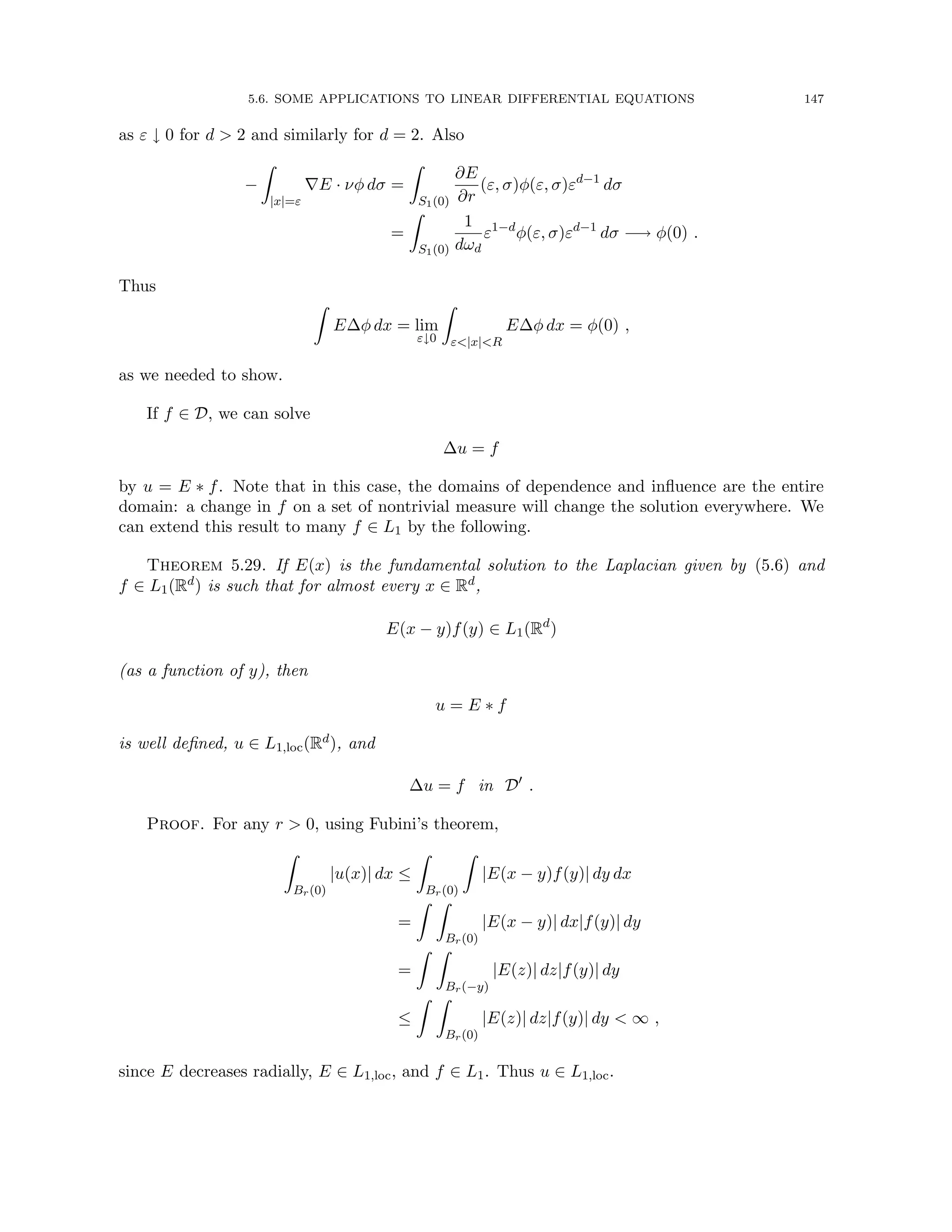
![148 5. DISTRIBUTIONS
For φ ∈ D, using again Fubini’s theorem,
h∆u, φi = hu, ∆φi
=
Z
u∆φ dx =
ZZ
E(x − y)f(y)∆φ(x) dy dx
=
ZZ
E(x − y)∆φ(x) dx f(y) dy
=
Z
E ∗ ∆φ(y)f(y) dy
=
Z
φ(y)f(y) dy = hf, φi ,
since E(x − y) = E(y − x) and
E ∗ ∆φ = ∆E ∗ φ = δ0 ∗ φ = φ .
Thus ∆u = f in D0 as claimed.
5.7. Local Structure of D0
We state without proof the following theorem. See [Ru1, p. 154] for a proof.
Theorem 5.30. If u ∈ D0(Ω), then there exist continuous functions gα, one for each multi-
index α, such that
(i) each K ⊂⊂ Ω intersects the supports of only finitely many of the gα
and
(ii) u =
X
α
Dα
gα.
Thus we see that D0(Ω) consists of nothing more than sums of derivatives of continuous
functions, such that locally on any compact set, the sum is finite. Surely we wanted D0(Ω) to
contain at least all such functions. The complicated definition of D0(Ω) we gave has included no
other objects.
5.8. Exercises
1. Let ψ ∈ D be fixed and define T : D → D by T(φ) =
R
φ(ξ) dξ ψ. Show that T is a continuous
linear map.
2. Show that if φ ∈ D(R), then
R
φ(x) dx = 0 if and only if there is ψ ∈ D(R) such that φ = ψ0.
3. Let Th be the translation operator on D(R): Thφ(x) = φ(x−h). Show that for any φ ∈ D(R),
lim
h→0
1
h
(φ − Thφ) = φ0
in D(R).
4. Prove that D(Ω) is not metrizable. [Hint: see the sketch of the proof given in Section 5.3.]
5. Prove directly that x PV(1/x) = 1.
6. Let T : D(R) → R.
(a) If T(φ) = |φ(0)|, show T is not a distribution.
(b) If T(φ) =
P∞
n=0 φ(n), show T is a distribution.](https://image.slidesharecdn.com/appliedmathematicsmethods-230215152718-28efe5ed/75/applied-mathematics-methods-pdf-148-2048.jpg)
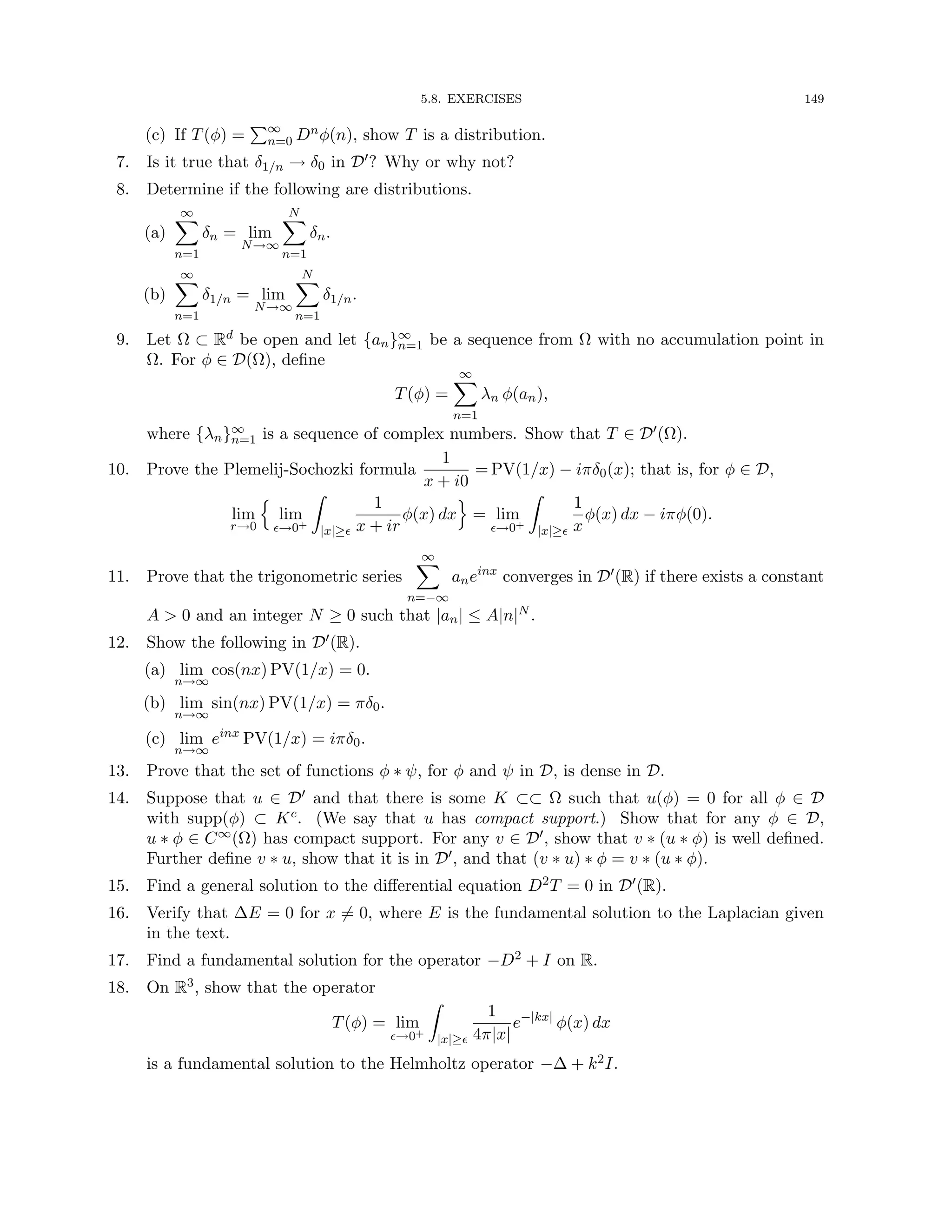

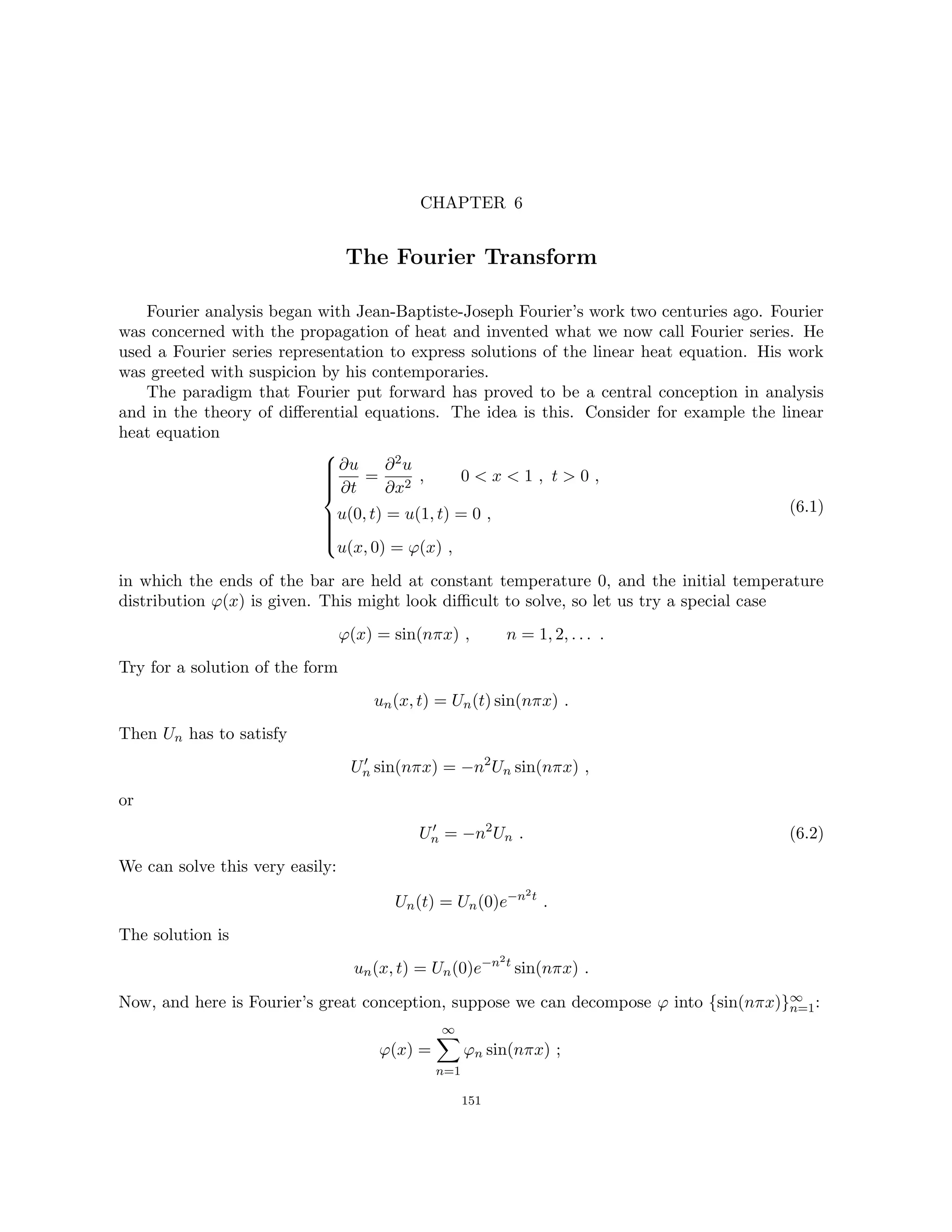
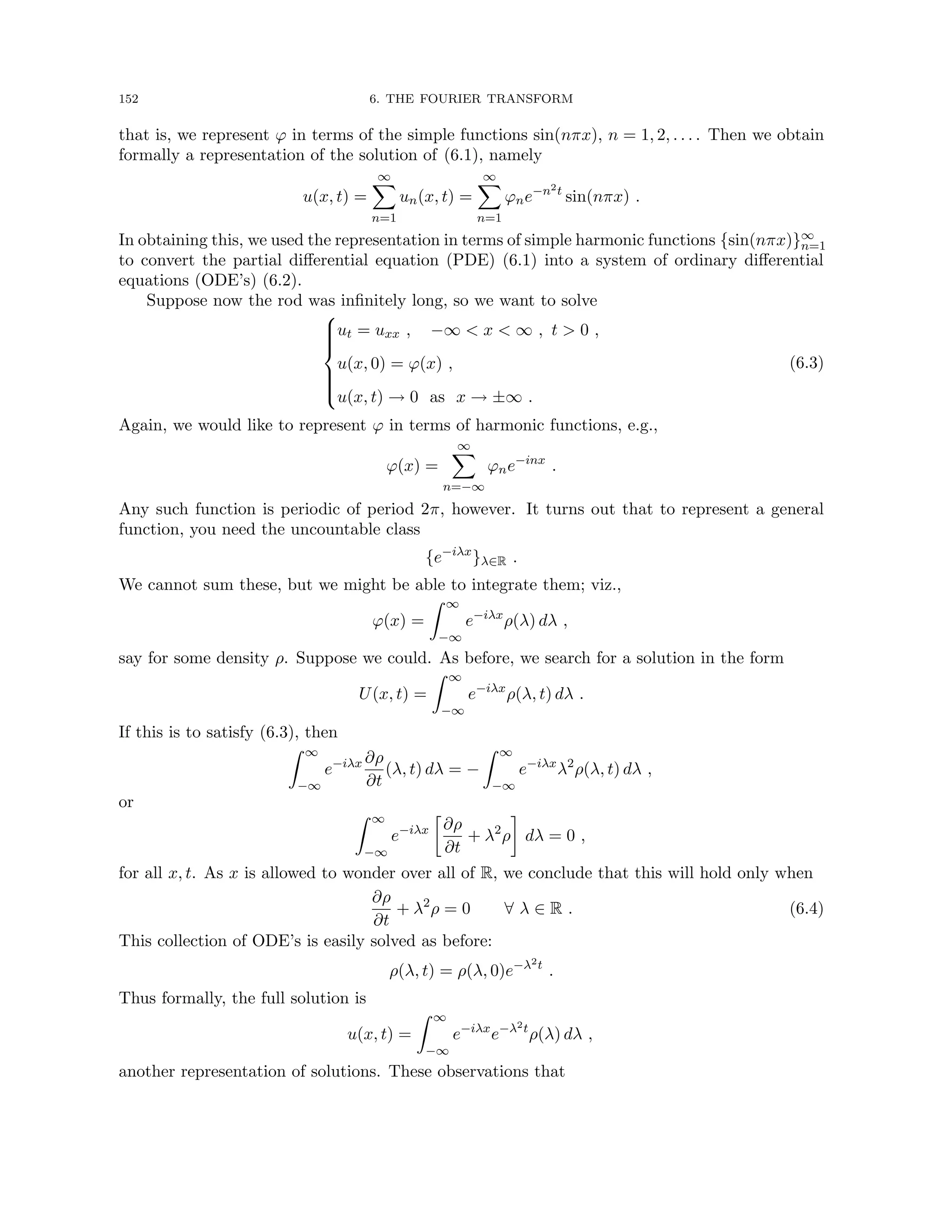
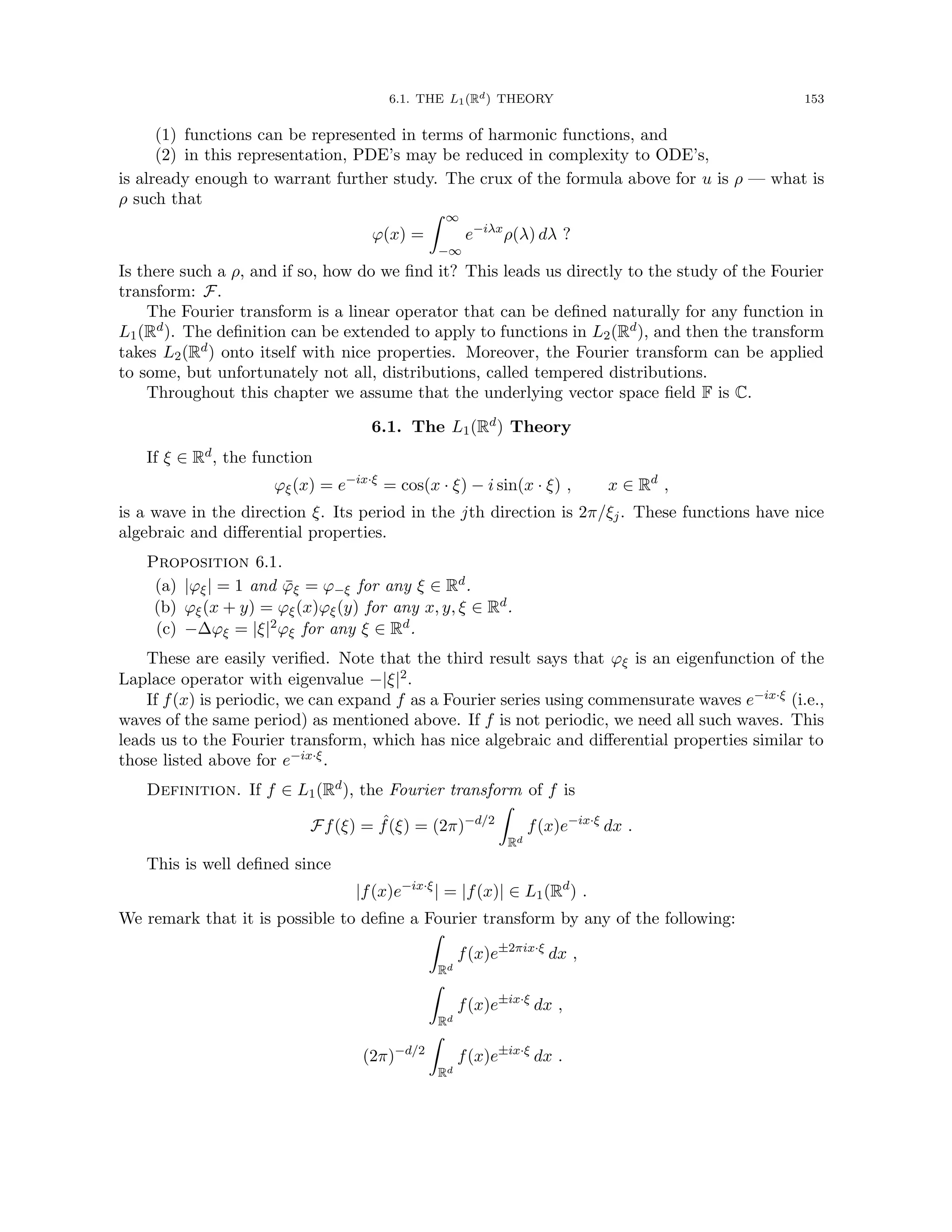
![154 6. THE FOURIER TRANSFORM
The choice here affects the form of the results that follow, but not their substance. Different
authors make different choices here, but it is easy to translate results for one definition into
another.
Proposition 6.2. The Fourier transform
F : L1(Rd
) → L∞(Rd
)
is a bounded linear operator, and
k ˆ
fkL∞(Rd) ≤ (2π)−d/2
kfkL1(Rd) .
The proof is an easy exercise of the definitions.
Example. Consider the characteristic function of [−1, 1]d:
f(x) =
(
1 if −1 xj 1, j = 1, . . . , d,
0 otherwise.
Then
ˆ
f(ξ) = (2π)−d/2
Z 1
−1
· · ·
Z 1
−1
e−ix·ξ
dx
=
d
Y
j=1
(2π)−1/2
Z 1
−1
e−ixjξj
dxj
=
d
Y
j=1
(2π)−1/2 −1
iξj
(e−iξj
− eiξj
)
=
d
Y
j=1
r
2
π
sin ξj
ξj
.
Proposition 6.3. If f ∈ L1(Rd) and τy is translation by y (i.e., τyϕ(x) = ϕ(x − y)), then
(a) (τyf)∧(ξ) = e−iy·ξ ˆ
f(ξ) ∀ y ∈ Rd;
(b) (eix·yf)∧(ξ) = τy
ˆ
f(ξ) ∀ y ∈ Rd;
(c) if r 0 is given,
f(rx)(ξ) = r−d ˆ
f(r−1
ξ) ;
(d) ˆ
¯
f(ξ) = ˆ
f(−ξ).
The proof is a simple exercise of change of variables.
While the Fourier transform maps L1(Rd) into L∞(Rd), it does not map onto. Its range is
poorly understood, but it is known to be contained in a set we will call Cv(Rd).
Definition. A continuous function f on Rd is said to vanish at infinity if for any ε 0
there is K ⊂⊂ Rd such that
|f(x)| ε ∀ x /
∈ K .
We define
Cv(Rd
) = {f ∈ C0
(Rd
) : f vanishes at ∞} .
Proposition 6.4. The space Cv(Rd) is a closed linear subspace of L∞(Rd).](https://image.slidesharecdn.com/appliedmathematicsmethods-230215152718-28efe5ed/75/applied-mathematics-methods-pdf-154-2048.jpg)
![6.1. THE L1(Rd) THEORY 155
Proof. Linearity is trivial. Suppose that {fn}∞
n=1 ⊂ Cv(Rd) and that
fn
L∞
−
−
→ f .
Then f is continuous (the uniform convergence of continuous functions is continuous). Now let
ε 0 be given and choose n such that kf − fnkL∞ ε/2 and K ⊂⊂ Rd such that |fn(x)| ε/2
for x /
∈ K. Then
|f(x)| ≤ |f(x) − fn(x)| + |fn(x)| ε
shows that f ∈ Cv(Rd).
Lemma 6.5 (Riemann-Lebesgue Lemma). The Fourier transform
F : L1(Rd
) → Cv(Rd
) L∞(Rd
) .
Thus for f ∈ L1(Rd),
lim
|ξ|→∞
| ˆ
f(ξ)| = 0 and ˆ
f ∈ C0
(Rd
) .
Proof. Let f ∈ L1(Rd). There is a sequence of simple functions {fn}∞
n=1 such that fn → f
in L1(Rd). Recall that a simple function is a finite linear combination of characteristic functions
of rectangles. If ˆ
fn ∈ Cv(Rd), we are done since
ˆ
fn
L∞
−
−
→ ˆ
f
and Cv(Rd) is a closed subspace. We know that the Fourier transform of the characteristic
function of [−1, 1]d is
d
Y
j=1
r
2
π
sin ξj
ξj
∈ Cv(Rd
) .
By Proposition 6.3, translation and dilation of this cube gives us that the characteristic function
of any rectangle is in Cv(Rd), and hence also any finite linear combination of these.
Some nice properties of the Fourier transform are given in the following.
Proposition 6.6. If f, g ∈ L1(Rd), then
(a)
Z
ˆ
f(x)g(x) dx =
Z
f(x)ĝ(x) dx ,
(b) f ∗ g ∈ L1(Rd) and [
f ∗ g = (2π)d/2 ˆ
fĝ ,
where the convolution of f and g is
f ∗ g(x) =
Z
f(x − y)g(y) dy ,
which is defined for almost every x ∈ Rd.](https://image.slidesharecdn.com/appliedmathematicsmethods-230215152718-28efe5ed/75/applied-mathematics-methods-pdf-155-2048.jpg)

![6.2. THE SCHWARTZ SPACE THEORY 157
by Hölder’s inequality. Thus
kTfkp
Lp
≤ Cp/q
ZZ
|K(x, y)| |f(y)|p
dy dx
= Cp/q
ZZ
|K(x, y)| dx|f(y)|p
dy
≤ Cp/q+1
Z
|f(y)|p
dy
= Cp
kfkp
Lp
,
and the theorem follows since T is clearly linear.
An unresolved question is: Given f, what does ˆ
f look like? We have the Riemann-Lebesgue
lemma, and the following theorem.
Theorem 6.10 (Paley-Wiener). If f ∈ C∞
0 (Rd), then ˆ
f extends to an entire holomorphic
function on Cd.
Proof. The function
ξ 7−→ e−ix·ξ
is an entire function for x ∈ Rd fixed. The Riemann sums approximating
ˆ
f(ξ) = (2π)−d/2
Z
f(x)e−ix·ξ
dx
are entire, and they converge uniformly on compact sets since f ∈ C∞
0 (Rd). Thus we conclude
that ˆ
f is entire.
See [Ru1] for the converse. Since holomorphic functions do not have compact support, we
see that functions which are localized in space are not localized in Fourier space (the converse
will follow after we develop the inverse Fourier transform).
6.2. The Schwartz Space Theory
Since L2(Rd) is not contained in L1(Rd), we restrict to a suitable subspace S ⊂ L2(Rd) ∩
L1(Rd) on which to define the Fourier transform before attempting the definition on L2(Rd).
Definition. The Schwartz space or space of functions of rapid decrease is
S = S(Rd
) =
n
φ ∈ C∞
(Rd
) : sup
x∈Rd
|xα
Dβ
φ(x)| ∞ for all multi-indices α and β
o
.
That is, φ and all its derivatives tend to 0 at infinity faster than any polynomial. As an
example, consider φ(x) = p(x)e−a|x|2
for any a 0 and any polynomial p(x).
Proposition 6.11. One has that
C∞
0 (Rd
) S L1(Rd
) ∩ L∞(Rd
) ;
thus also S(Rd) ⊂ Lp(Rd) ∀ 1 ≤ p ≤ ∞.](https://image.slidesharecdn.com/appliedmathematicsmethods-230215152718-28efe5ed/75/applied-mathematics-methods-pdf-157-2048.jpg)
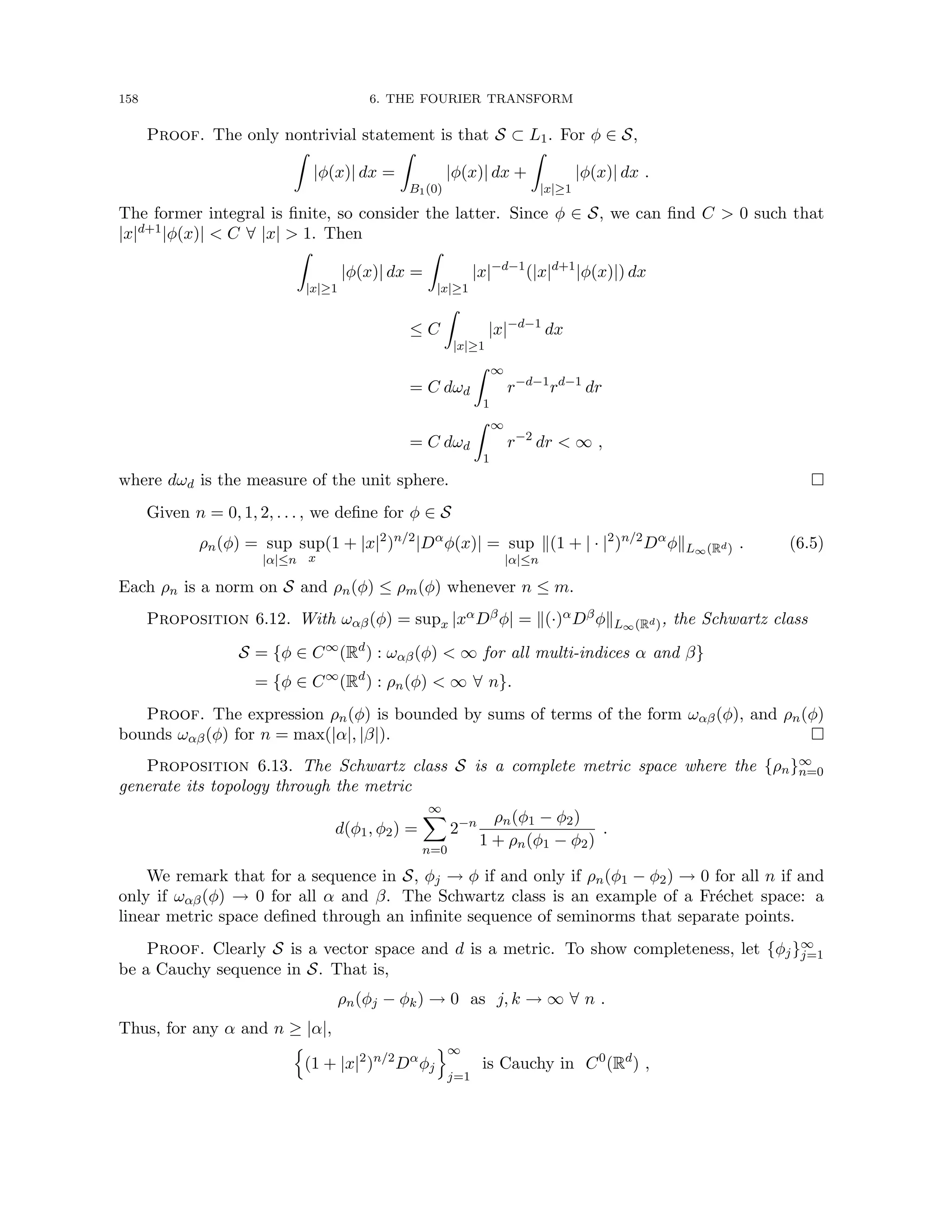
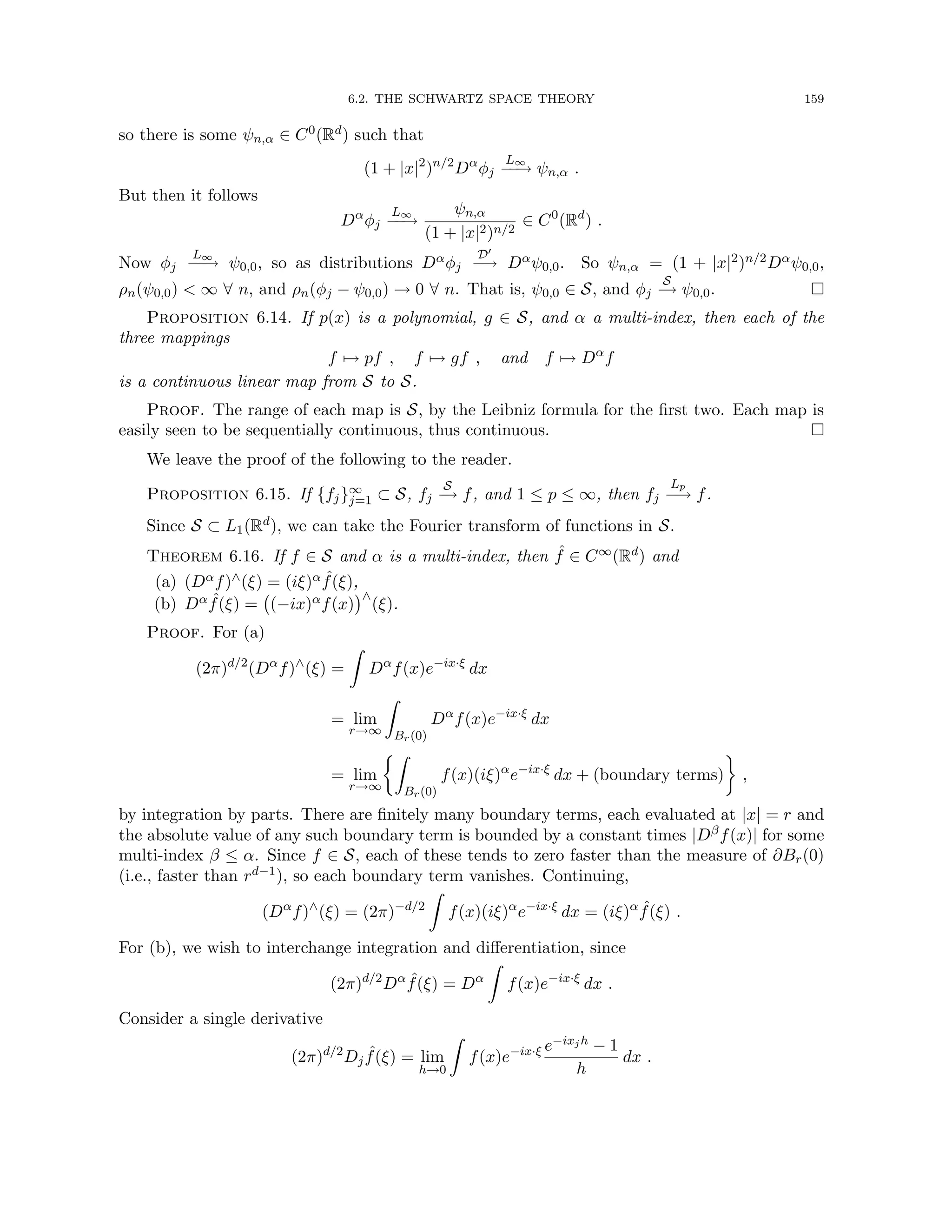
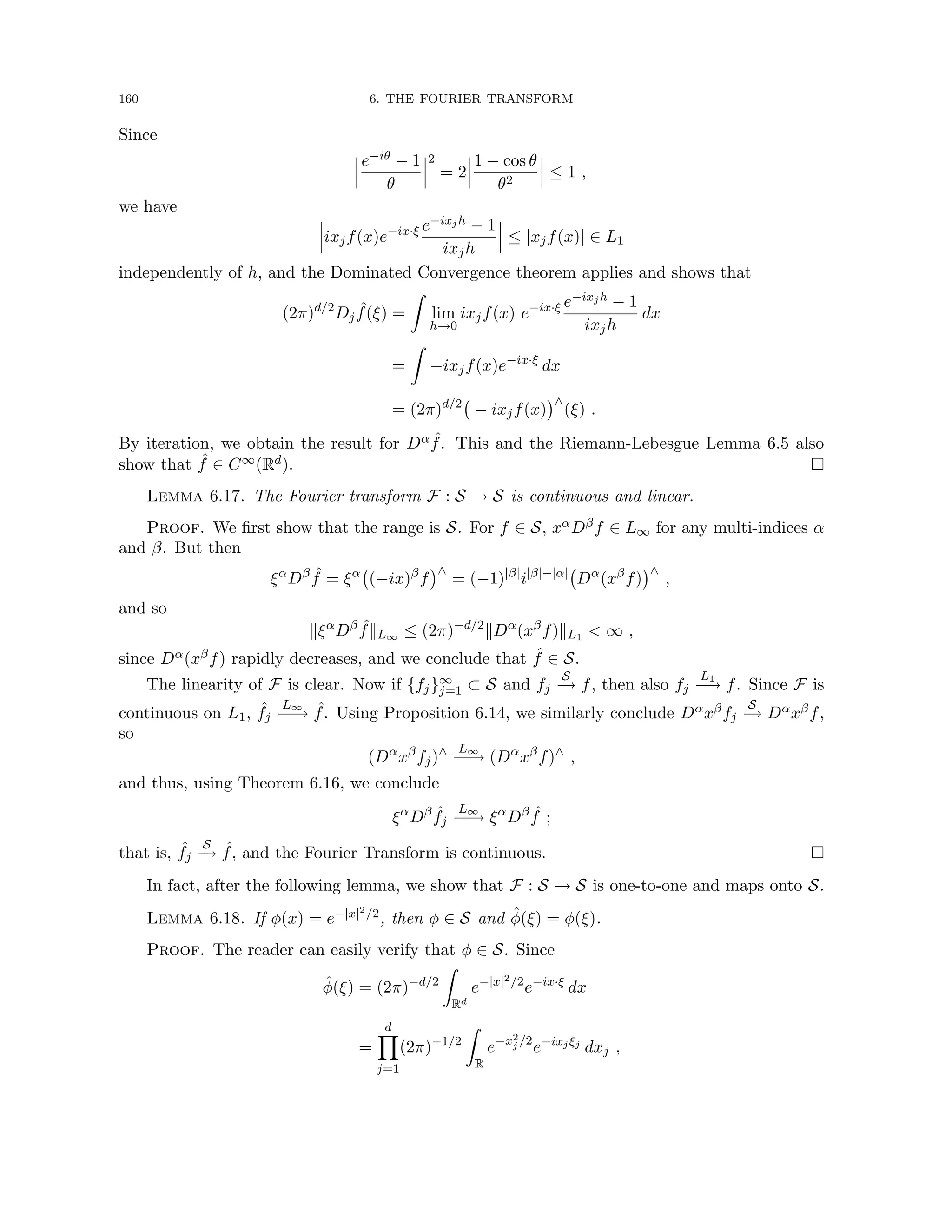
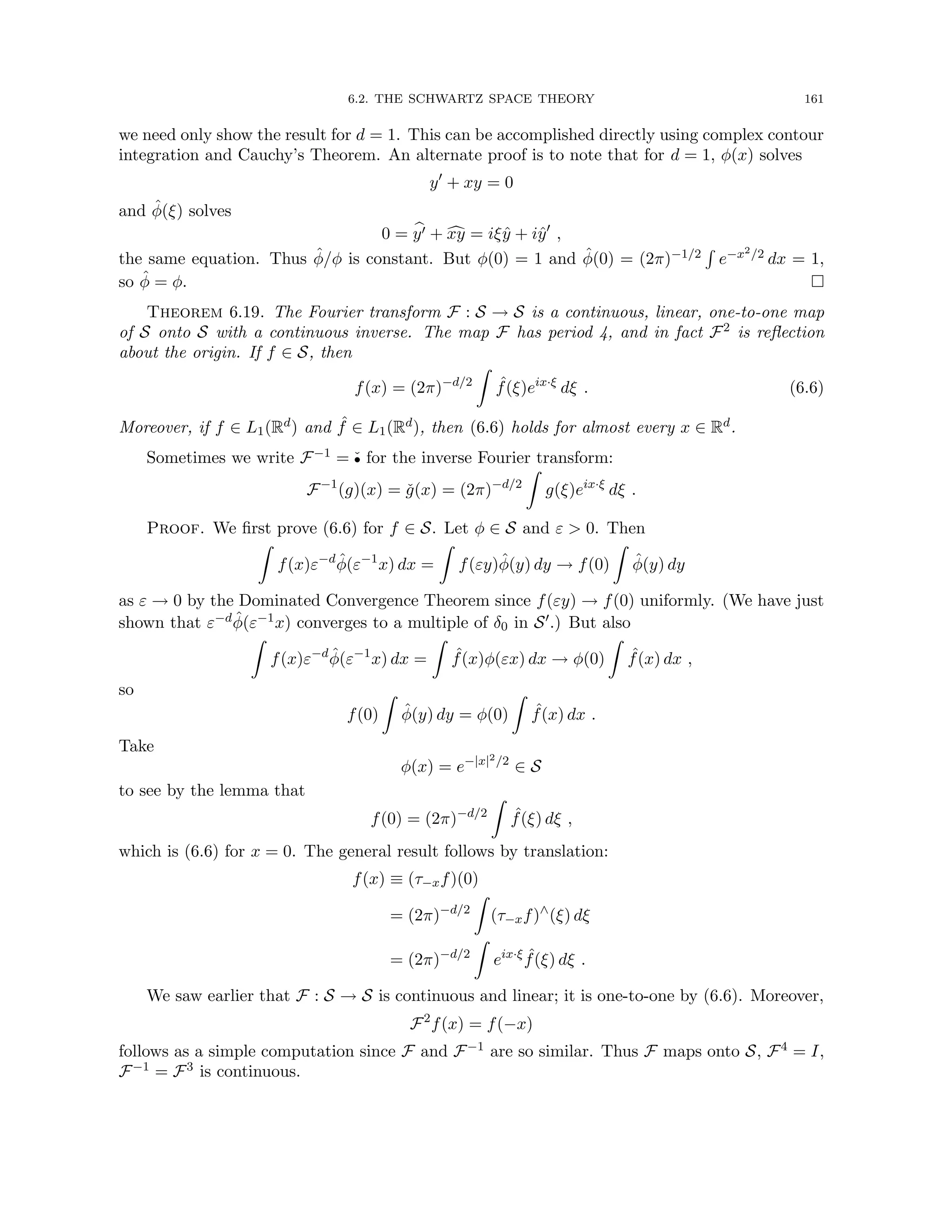
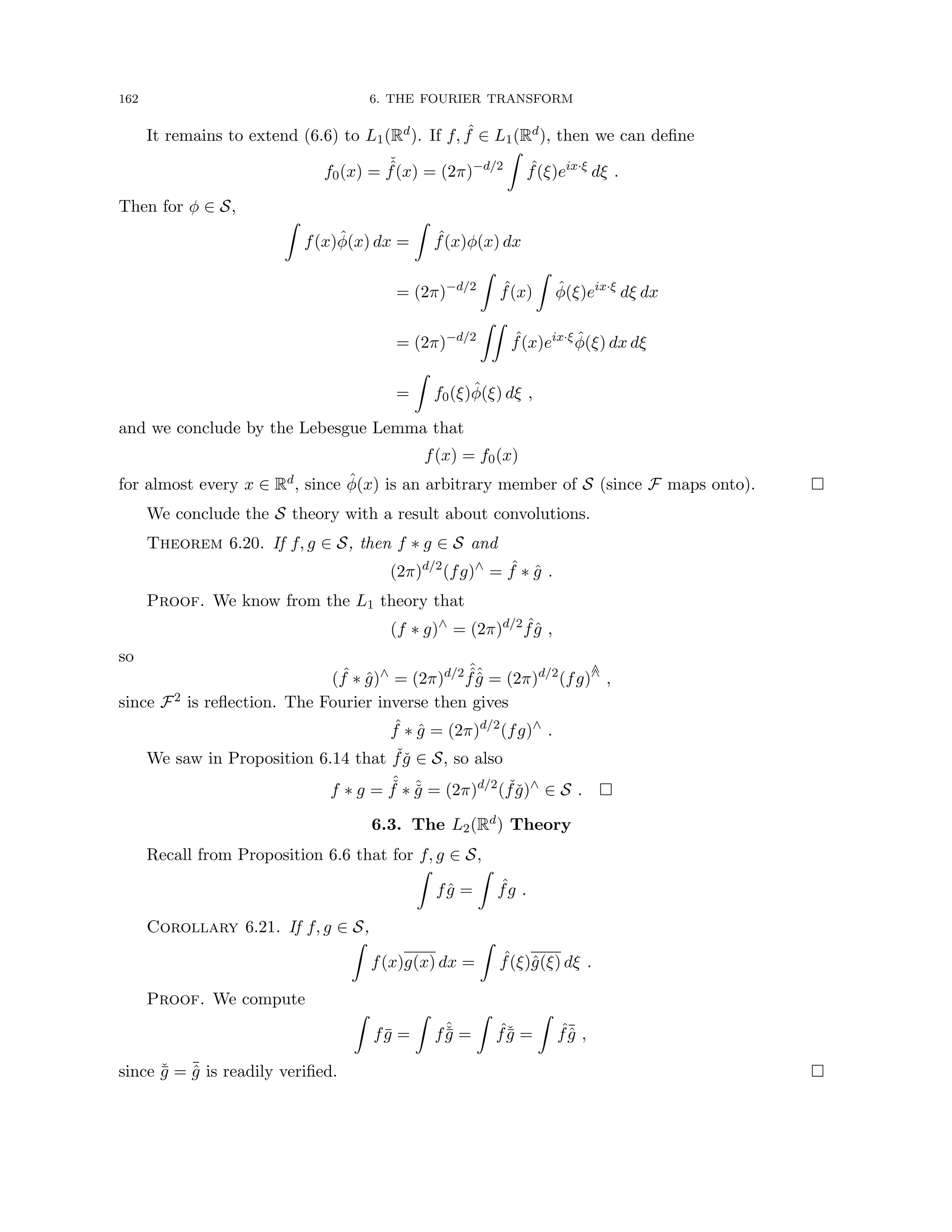
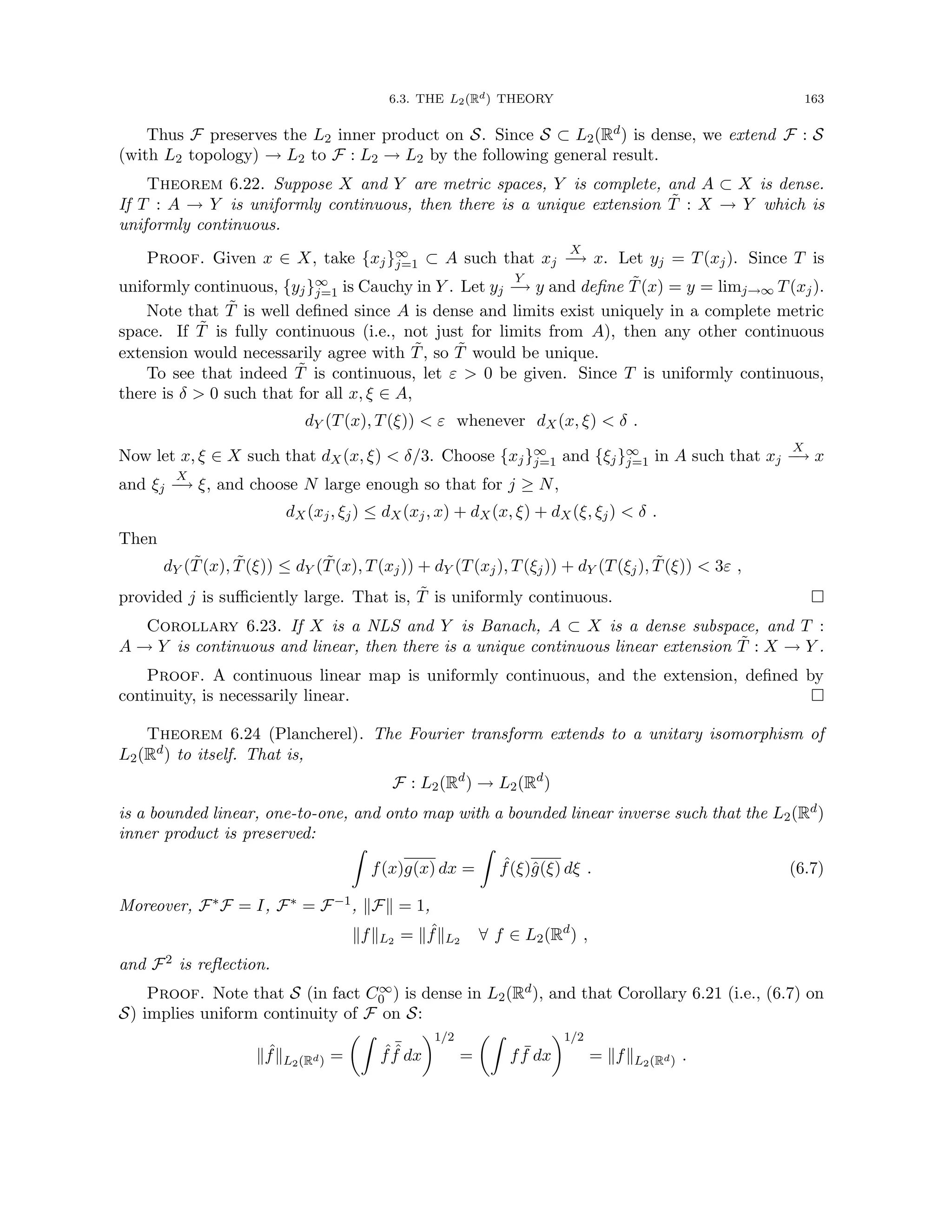
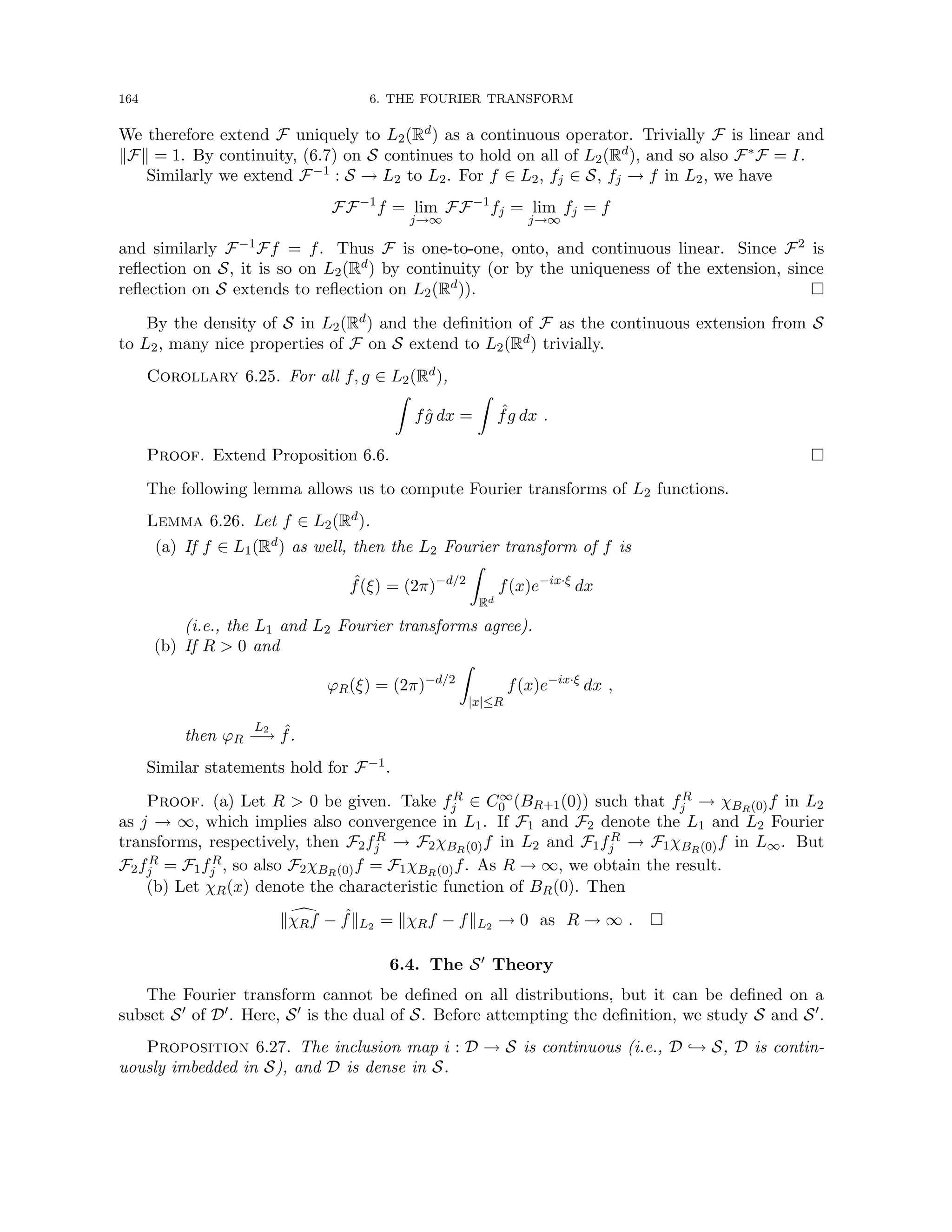

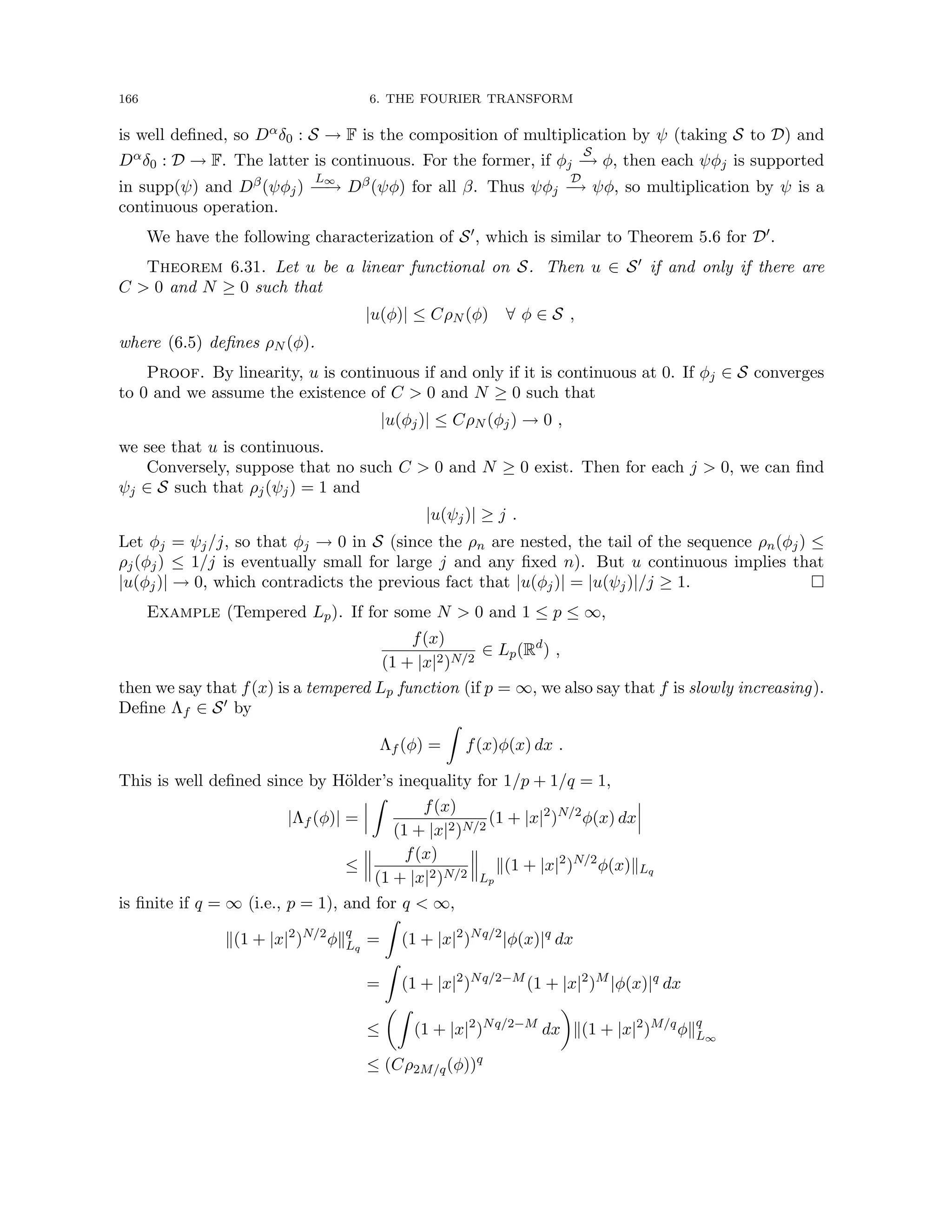
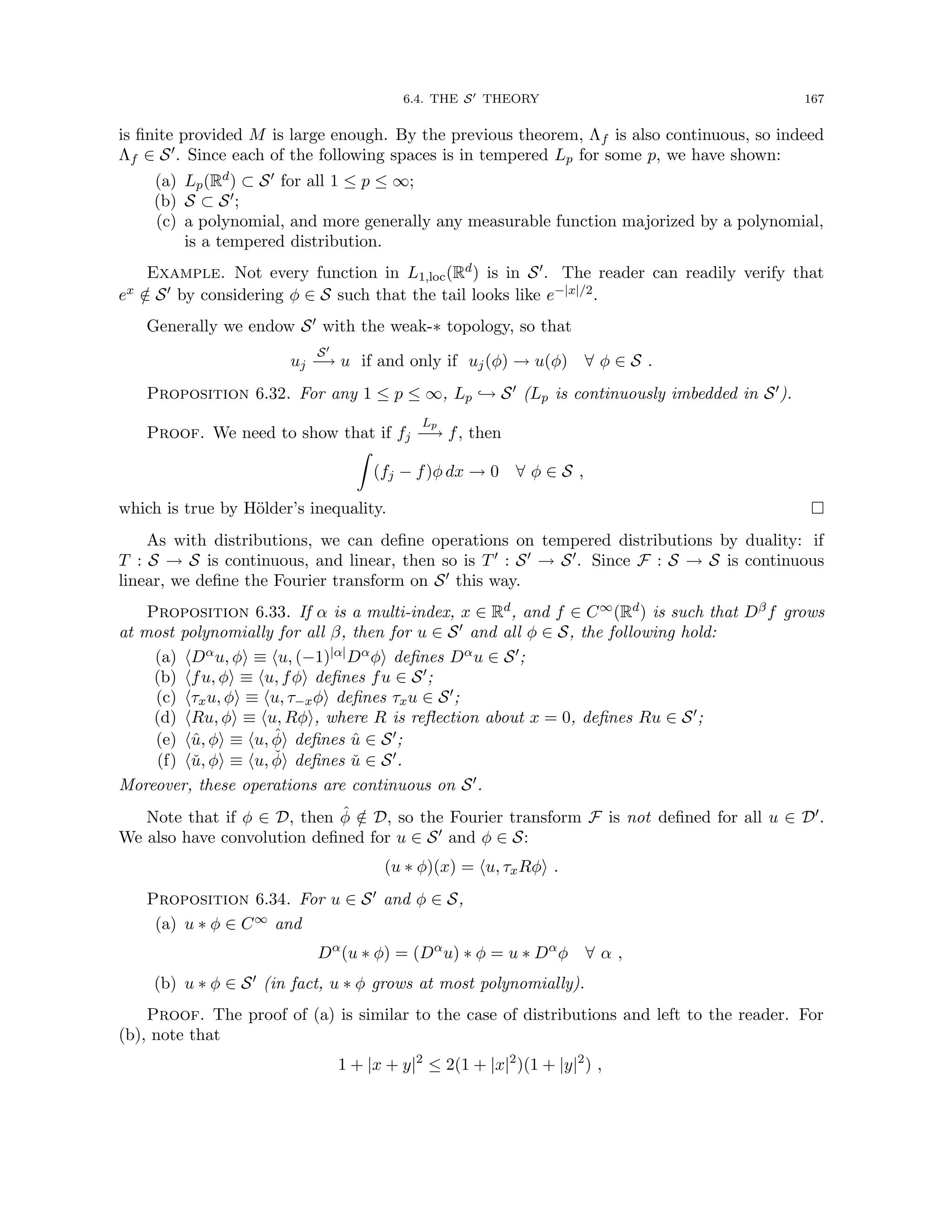
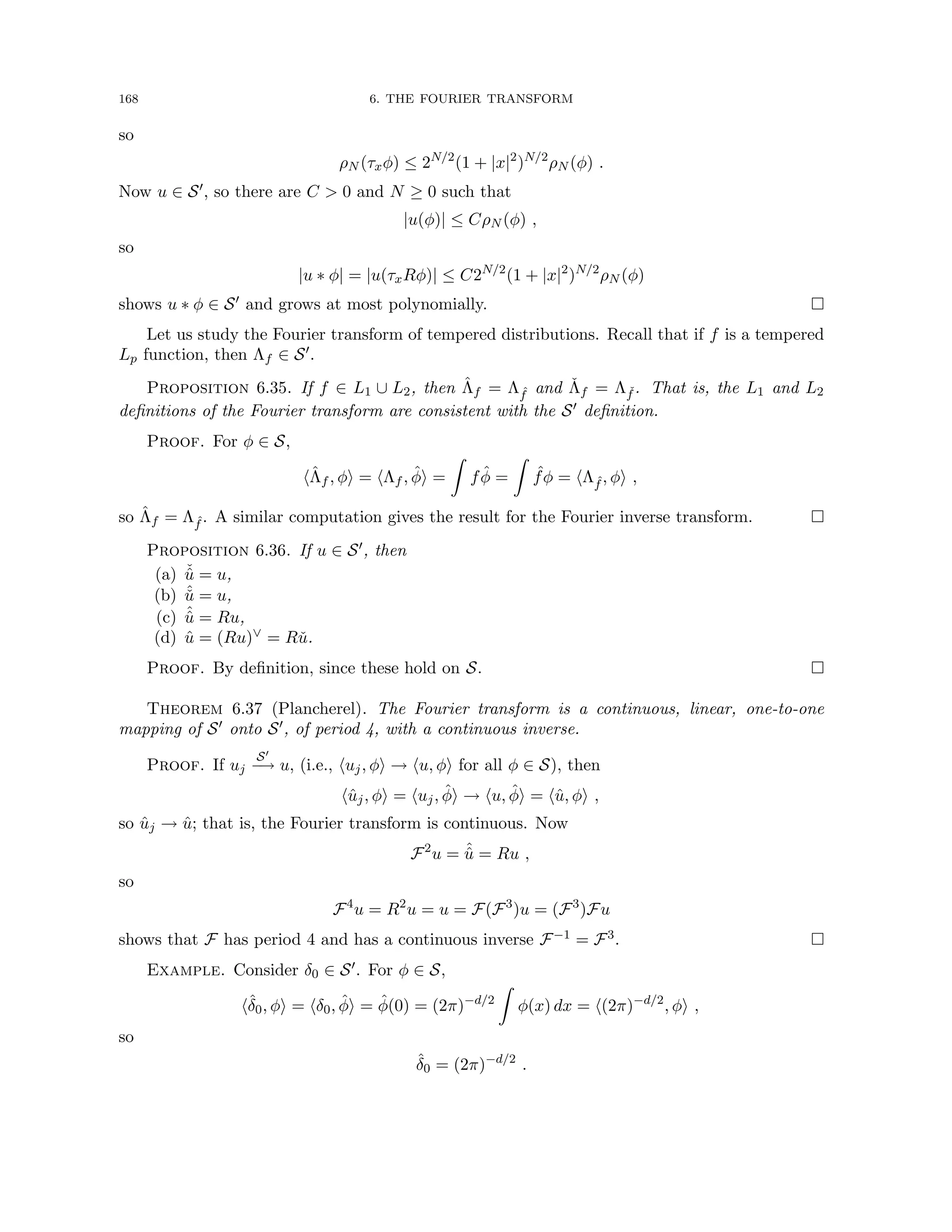
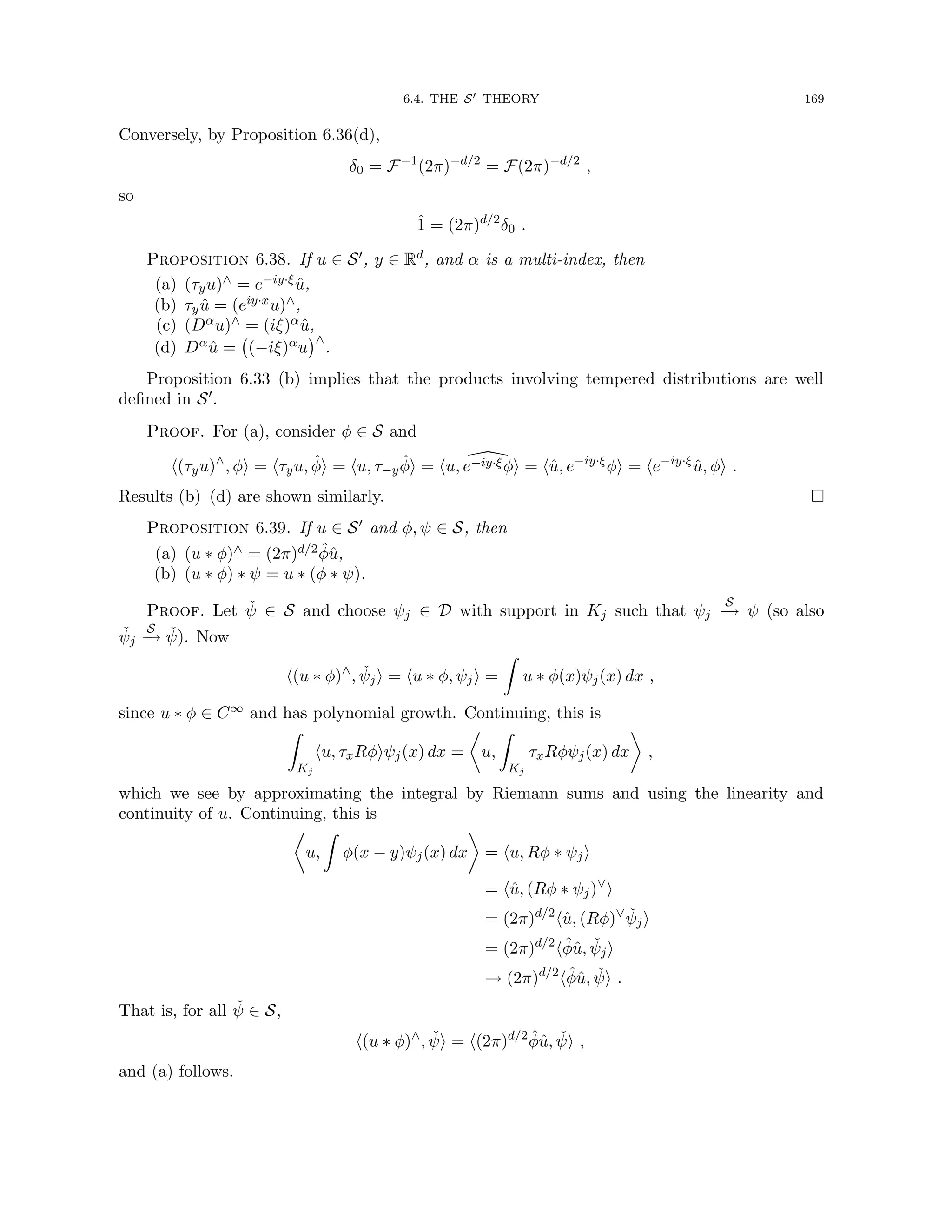

![6.5. SOME APPLICATIONS 171
In fact, K should solve the IVP with f = δ0, so it is a type of fundamental solution. It
describes the diffusion in time of an initial unit amount of heat energy at the origin. Our model
of heat flow has many interesting properties. First, the solution is self-similar, meaning that it
is given by scaling a function of a single variable:
K(x, t) = t−d/2
K(t−1/2
x, 1) .
Thus K approximates δ0 as t → 0, and the initial condition is satisfied as t → 0+. For positive
times, K controls how the initial condition (initial heat distribution) dissipates, or diffuses,
with time. The maximal temperature is (4πt)−d/2, which decreases in time. The self-simililar
structure predicts that the distance through the origin between points of half this value, say, will
increase on the order of
√
t; that is, the front will spread at a rate proportional to
√
t. Second,
even though K(x, t) → 0 as t → ∞ for each fixed x, our model conserves heat energy, since for
all time t ≥ 0,
Z
K(x, t) dx = K̂(0, t) = 1 .
Finally, our model predicts infinite speed of propagation of information, since K(x, t) 0 for all
x whenever t 0. This property is perhaps unsatisfying from the point of view of the physics.
To remove the formality of the above calculation, we start with K(x, t) defined as above,
and note that for f ∈ D and u = f ∗ K as above,
ut − ∆u = f ∗ (Kt − ∆K) = f ∗ 0 = 0 .
To extend to f ∈ Lp, we use that D is dense in Lp. See [Fo, p. 190] for details.
Example ( Schrödinger operator). In quantum mechanical theory, systems are governed by
the time-dependent Schrödinger equation,
i~
∂u
∂t
− Hu = 0 ,
where ~ is the fundamental Planck’s constant divided by 2π, H is a given self adjoint operator
(the Hamiltonian operator), and u is the unknown wave function of the system. One intreprets
|u|2 as the probability density of the system.
Consider the simple Schrödinger IVP
i
∂u
∂t
+ ∆u = 0 , (x, t) ∈ Rd × (0, ∞),
u(x, 0) = f(x), x ∈ Rd,
where f(x) is given. It formally resembles the heat equation except for the imaginary coefficient.
The Fourier transform implies that
iût − |ξ|2
û = 0 , (6.8)
so that, after multiplying by û, we obtain that
iûtû − |ξ|2
|û|2
= 0 .
Since ût = (û)t, by considering real and imaginary parts of û, it is easy to conclude that the real
part of ûtû is 1
2|û|2
t , so separating real and imaginary parts, we see that
1
2|û|2
t = 0 ,](https://image.slidesharecdn.com/appliedmathematicsmethods-230215152718-28efe5ed/75/applied-mathematics-methods-pdf-171-2048.jpg)
![172 6. THE FOURIER TRANSFORM
which implies that for all t,
|û(ξ, t)|2
= | ˆ
f(ξ)|2
,
invoking the initial condition. Integrating in space and applying the Plancherel Theorem, we
obtain the conservation principle
ku(·, t)kL2(Rd) = kf(t)kL2(Rd) ;
that is, the total probability remains constant (to the value one, if f is properly normalized).
Moreover, from (6.8), we have that
ût = −i|ξ|2
û
(which is similar to the case of the heat equation ût = |ξ|2û). As in the last example, we deduce
that
u(x, t) = f ∗ K(x, t) ,
where the Shrödinger kernel is given by
K(x, t) = (2π)−d/2
(e−i|ξ|2t
)∨
(x) = (4iπt)−d/2
ei|x|2/4t
.
This Fourier inverse transform can be computed as follows. For ≥ 0, let
g(ξ) = e−(it+)|ξ|2
.
For 0, this is a well-behaved function. The Dominated Convergence Theorem implies that
g → g0 in S0 as → 0, and so we have that ǧ → ǧ0 in S0 as well. Now, completing the square
and using contour integration to change the variable, we have that
(2π)d/2
ǧ(x) =
Z
e−(it+)|ξ|2+ix·ξ
dξ
=
Z
e−(it+)[|ξ−ix/2(it+)|2+|x|2/4(it+)2]
dξ
= e−|x|2/4(it+)
Z
e−(it+)|ξ|2
dξ
= e−|x|2/4(it+)
d
Y
j=1
Z ∞
−∞
e−(it+)ξ2
j dξj
=
π
it +
d/2
e−|x|2/4(it+)
,
wherein we take the branch of the square root giving positive real part. The result follows after
taking → 0.
6.6. Exercises
1. Compute the Fourier transform of e−|x| for x ∈ R.
2. Compute the Fourier transform of e−a|x|2
, a 0, directly, where x ∈ R. You will need to
use the Cauchy Theorem.
3. If f ∈ L1(Rd) and f 0, show that for every ξ 6= 0, | ˆ
f(ξ)| ˆ
f(0).
4. If f ∈ L1(Rd) and f(x) = g(|x|) for some g, show that ˆ
f(ξ) = h(|ξ|) for some h. Can you
relate g and h?](https://image.slidesharecdn.com/appliedmathematicsmethods-230215152718-28efe5ed/75/applied-mathematics-methods-pdf-172-2048.jpg)
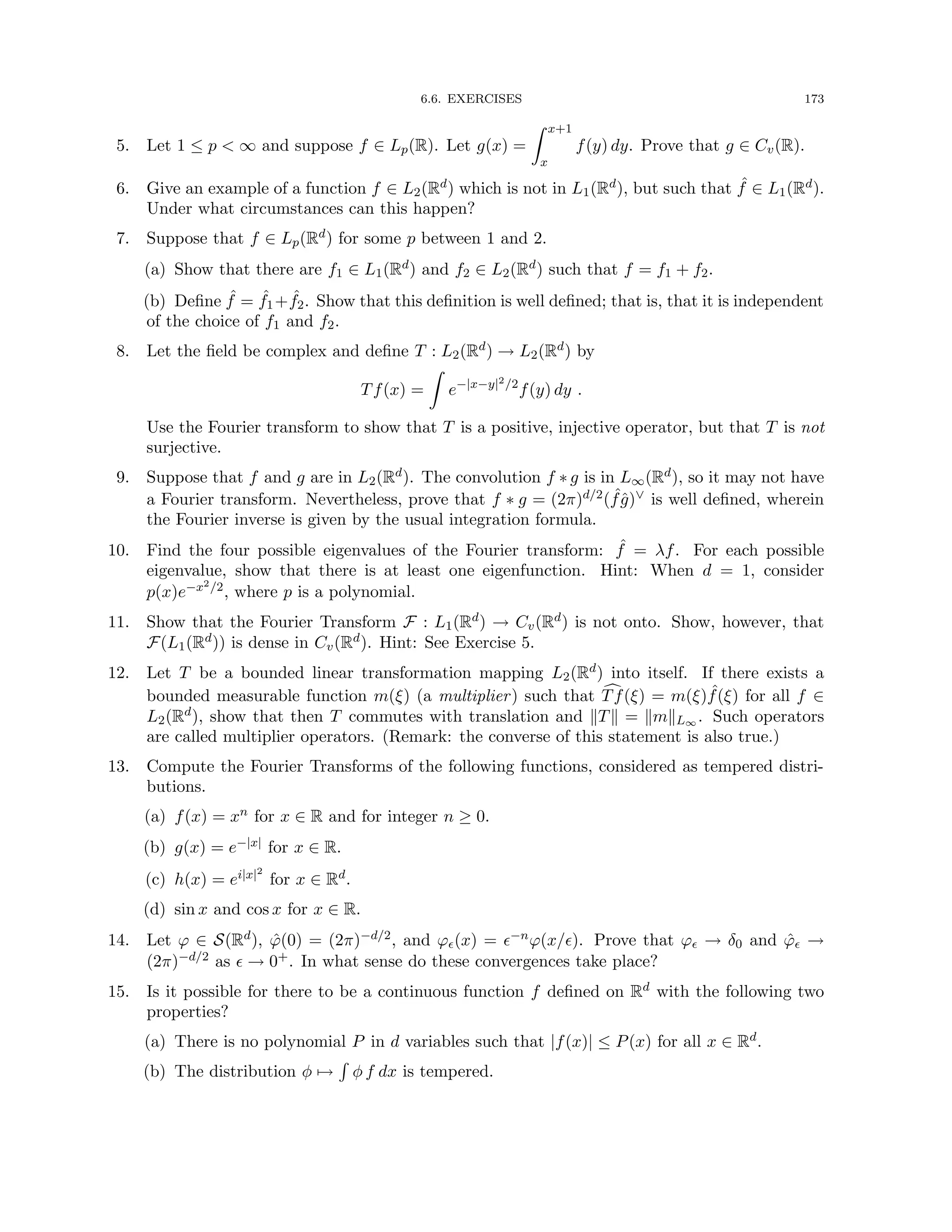

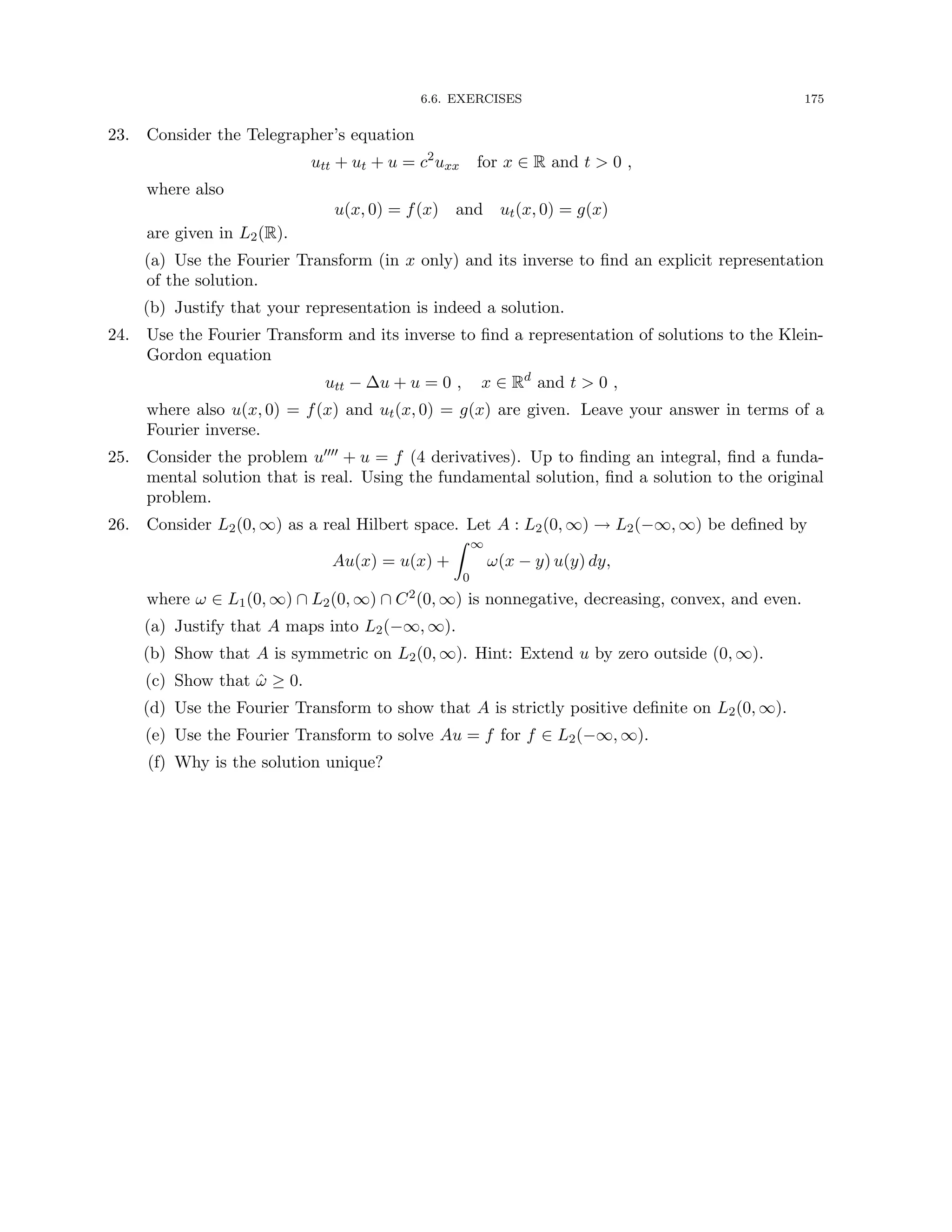


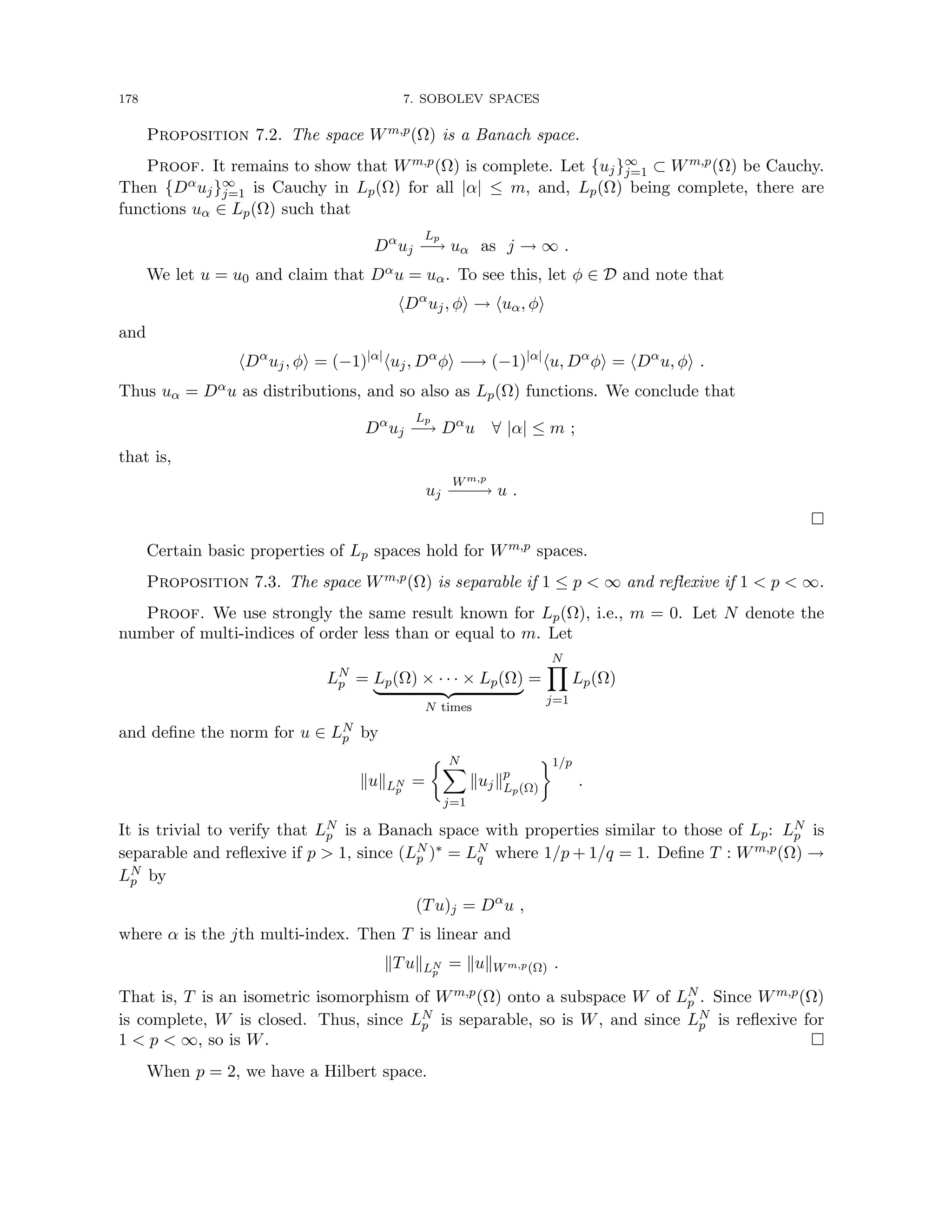

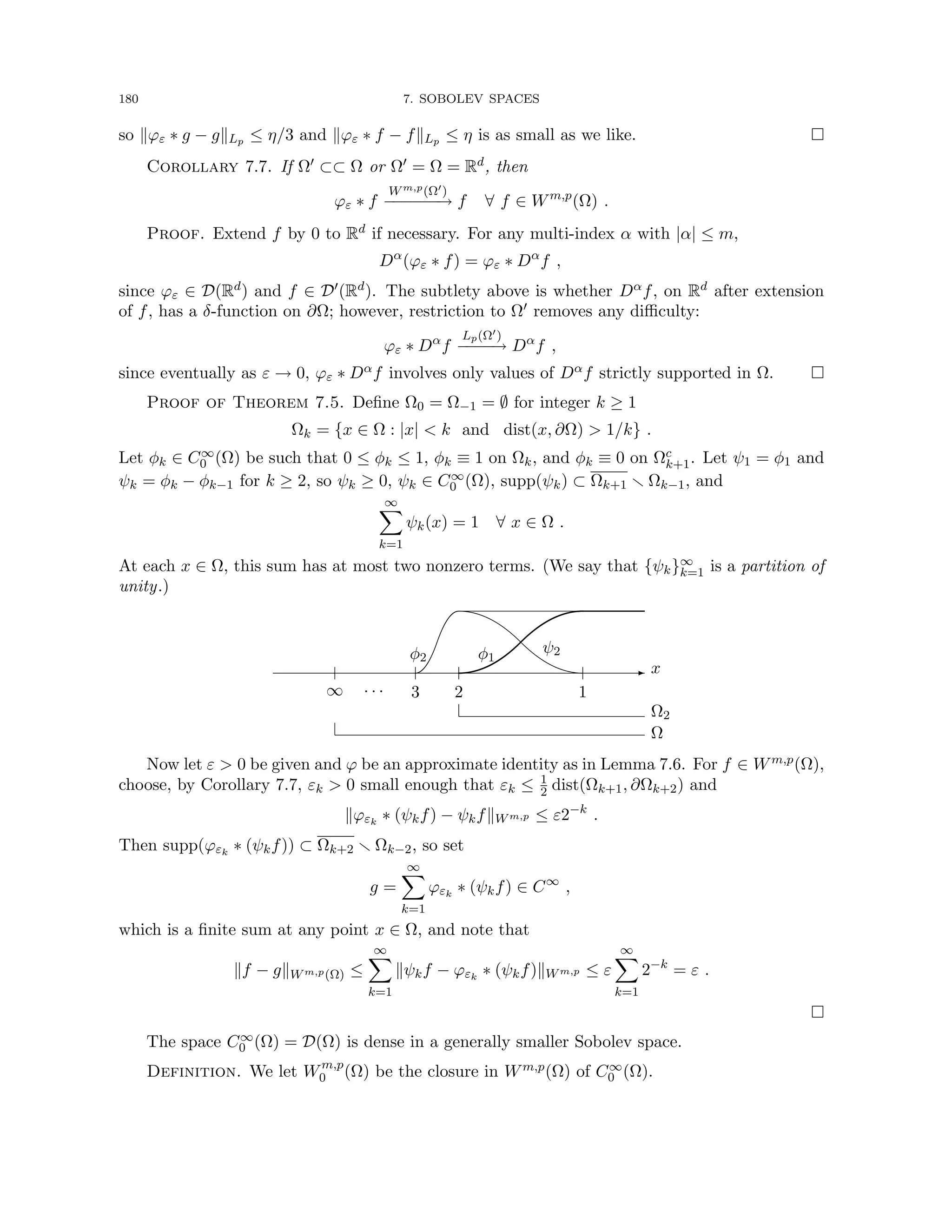
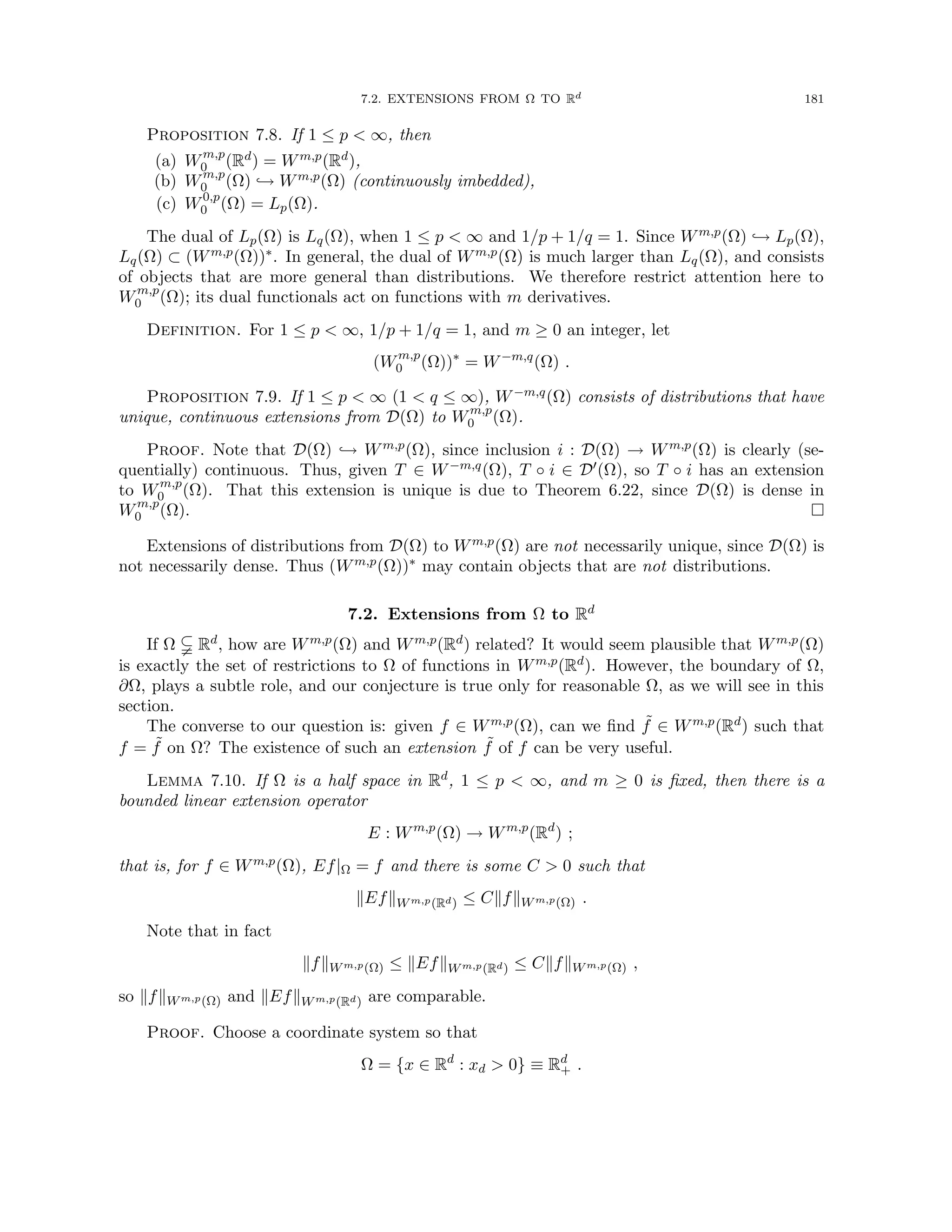
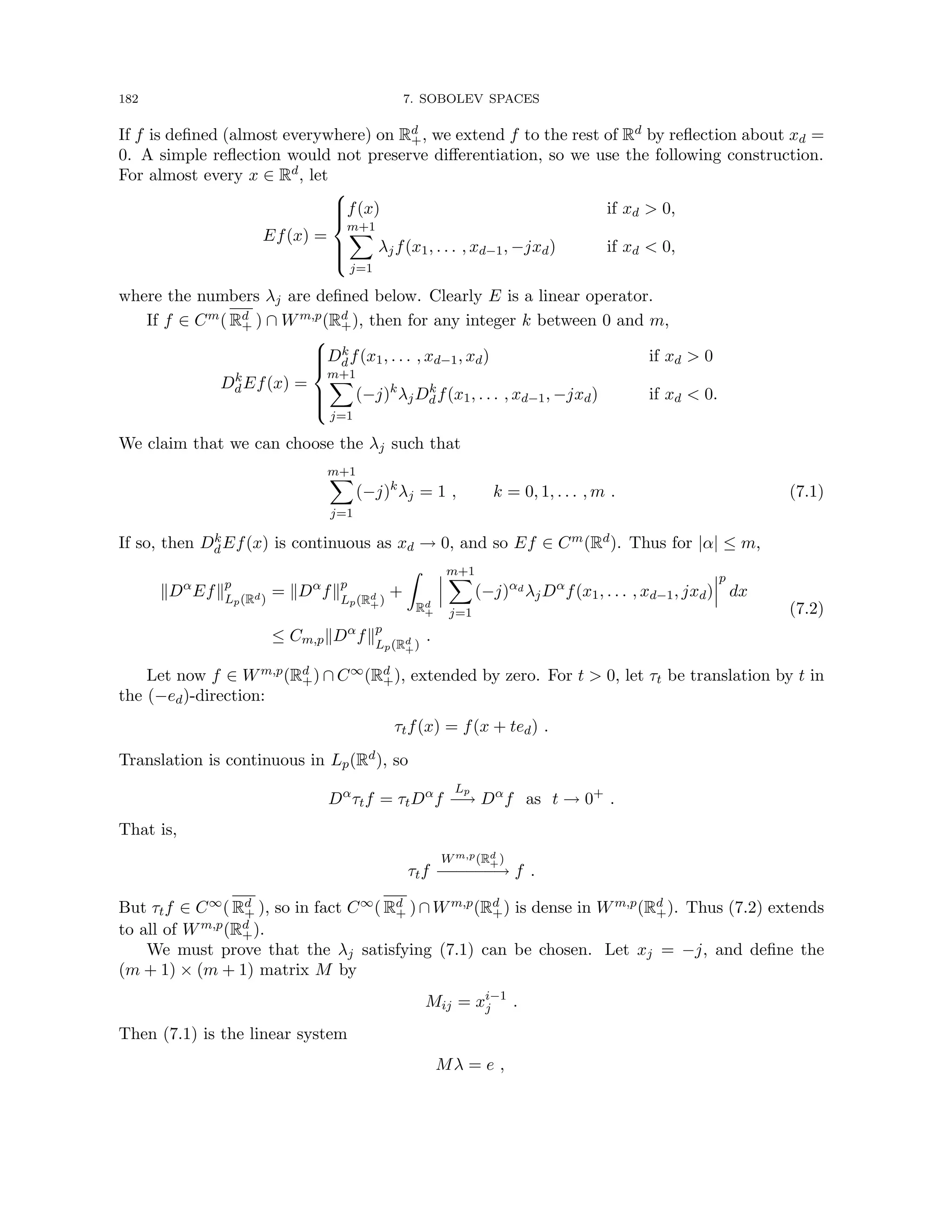
![7.2. EXTENSIONS FROM Ω TO Rd 183
where λ is the vector of the λj’s and e is the vector of 1’s. Now MT is a Vandermonde matrix,
and the jth row of MT c = 0 is
m+1
X
i=1
cixi−1
j = 0. Thus the polynomial p(x) =
m+1
X
i=1
cixi−1
of degree
m has m + 1 distinct roots, and so must be identically zero. This means that c = 0, and we
conclude that MT , and so also M, is nonsingular, and so the λj’s exist (uniquely, in fact).
We can generalize the Lemma through a smooth distortion of the boundary. We first define
what we mean by a smooth boundary.
Definition. For integer m ≥ 0, the domain Ω ⊂ Rd has a Cm,1-boundary (or a Lipschitz
boundary if m = 0) if there exit sets Ωj ⊂ Rd , j = 1, ..., N with N possibly +∞, with the
following properties:
(a) Ωj ⊂⊂ Rd, ∂Ω ⊂
S
j Ωj, and only finitely many of the sets intersect BR(0) for all R 0;
(b) There are functions ψj : Ωj → B1(0) that are one-to-one and onto such that both ψj
and ψ−1
j are of class Cm,1, i.e., ψj ∈ Cm,1(Ωj) and ψ−1
j ∈ Cm,1(B1(0));
(c) ψj(Ωj ∩ Ω) = B+ ≡ B1(0) ∩ Rd
+ and ψj(Ωj ∩ ∂Ω) = B+ ∩ ∂Rd
+.
That is, ∂Ω is covered by the Ωj, Ωj can be smoothly distorted by ψj into a ball with ∂Ω
distorted to the plane xd = 0. Note that ψ ∈ Cm,1(Ω) means that ψ ∈ Cm(Ω) and, for all
|α| = m, there is some C 0 such that
|Dα
ψ(x) − Dα
ψ(y)| ≤ C|x − y| ∀ x, y ∈ Ω ;
that is, Dαψ is Lipschitz.
Theorem 7.11. If m ≥ 0, 1 ≤ p ∞, and domain Ω ⊂ Rd has a Cm−1,1 boundary, then
there is a bounded (possibly nonlinear) extension operator
E : Wm,p
(Ω) → Wm,p
(Rd
) .
Proof. If m = 0, Ω may be any domain and we can extend by zero. If m ≥ 1, let {Ωj}N
j=1
and {ψj}N
j=1 be as in the definition of a Cm−1,1 boundary, where N = +∞ is possible. Let
Ω0 ⊂⊂ Ω be such that
Ω ⊂
N
[
j=0
Ωj .
Let {φk}M
k=1 (M possibly infinite) be a locally finite C∞ partition of unity subordinate to this
covering; that is, φk ∈ C∞(Rd), supp(φk) ⊂ Ωjk
for some jk between 0 and N, φk(x) 6= 0 for
only a finite number of k independent of x ∈ Ω, and
M
X
k=1
φk(x) = 1 ∀ x ∈ Ω .
Such a partition is relatively easy to construct (see, e.g., [Ad] or [GT] for a more general
construction, and also one of the exercises for this chapter). Then for f ∈ Wm,p(Ω), let fk =
φkf ∈ Wm,p(Ωjk
∩ Ω), which has support inside Ωjk
and can be extended by zero, maintaining
smoothness. Let E0 be the extension operator given in the lemma. If jk 6= 0,
E0(fk ◦ ψ−1
jk
) ∈ Wm,p
0 (B1(0)) ,](https://image.slidesharecdn.com/appliedmathematicsmethods-230215152718-28efe5ed/75/applied-mathematics-methods-pdf-183-2048.jpg)
![184 7. SOBOLEV SPACES
so
E0(fk ◦ ψ−1
jk
) ◦ ψjk
∈ Wm,p
0 (Ωjk
) .
Extend this by zero to all of Rd. We define E by
Ef =
M
X
k=1
(jk=0)
φkf +
M
X
k=1
(jk6=0)
E0
(φkf) ◦ ψ−1
jk
◦ ψjk
∈ Wm,p
0
N
[
j=0
Ωj
.
Note that derivatives of Ef are in Lp(Rd) because the ψj and ψ−1
j ∈ Cm−1,1 (i.e., derivatives
up to order m of ψj and ψ−1
j are bounded), and so Ef ∈ Wm,p(Rd), Ef|Ω = f, and
kEfkWm,p(Rd) ≤ CkfkWm,p(Ω) ,
where C ≥ 0 depends on m, p, and Ω through the Ωj, ψj, and φk.
We remark that if Ω̄ ⊂⊂ Ω̃ ⊂ Rd, then we can assume that Ef ∈ Wm,p
0 (Ω̃). To see this,
take any φ ∈ C∞
0 (Ω̃) with φ ≡ 1 on Ω̄, and define a new bounded extension operator by φEf.
Many generalizations of this result are possible. In 1961, Calderón gave a proof assuming
only that Ω is Lipschitz. In 1970, Stein [St] gave a proof where a single operator E can be used
for any values of m and p (and Ω is merely Lipschitz). Accepting the extension to Lipschitz
domains, we have the following characterization of Wm,p(Ω).
Corollary 7.12. If Ω has a Lipschitz boundary, 1 ≤ p ∞, and m ≥ 0, then
Wm,p
(Ω) = {f|Ω : f ∈ Wm,p
(Rd
)} .
If we restrict to the Wm,p
0 (Ω) spaces, extension by 0 gives a bounded extension operator,
even if ∂Ω is ill-behaved.
Theorem 7.13. Suppose Ω ⊂ Rd, 1 ≤ p ∞, and m ≥ 0. Let E be defined on Wm,p
0 (Ω) as
the operator that extends the domain of the function to Rd by 0; that is, for f ∈ Wm,p
0 (Ω),
Ef(x) =
(
f(x) if x ∈ Ω,
0 if x /
∈ Ω.
Then E : Wm,p
0 (Ω) → Wm,p(Rd).
Of course, then
kfkWm,p
0 (Ω) = kEfkWm,p(Rd) .
Proof. If f ∈ Wm,p
0 (Ω), then there is a sequence {fj}∞
j=1 ⊂ C∞
0 (Ω) such that
fj
Wm,p(Ω)
−−
−
−
−→ f .](https://image.slidesharecdn.com/appliedmathematicsmethods-230215152718-28efe5ed/75/applied-mathematics-methods-pdf-184-2048.jpg)
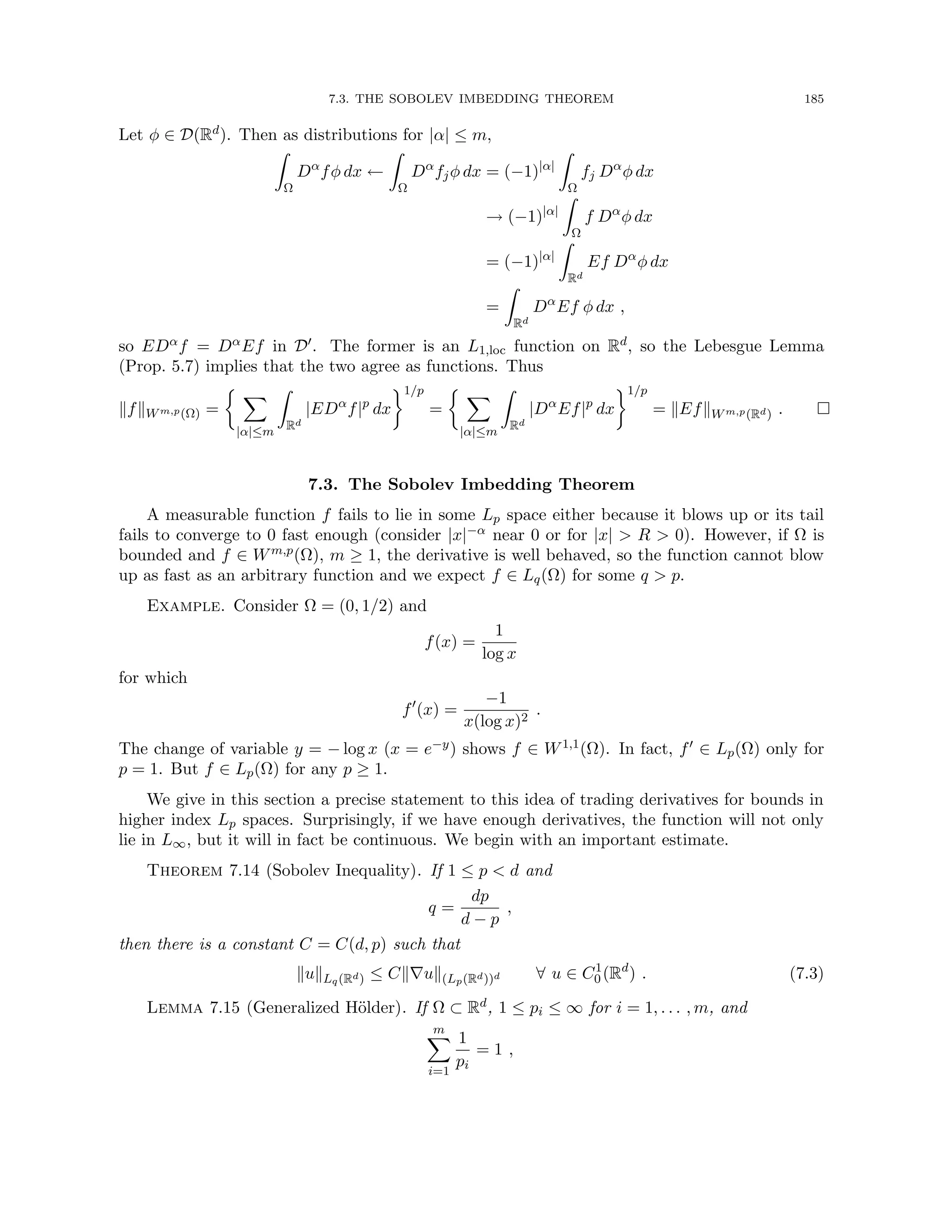

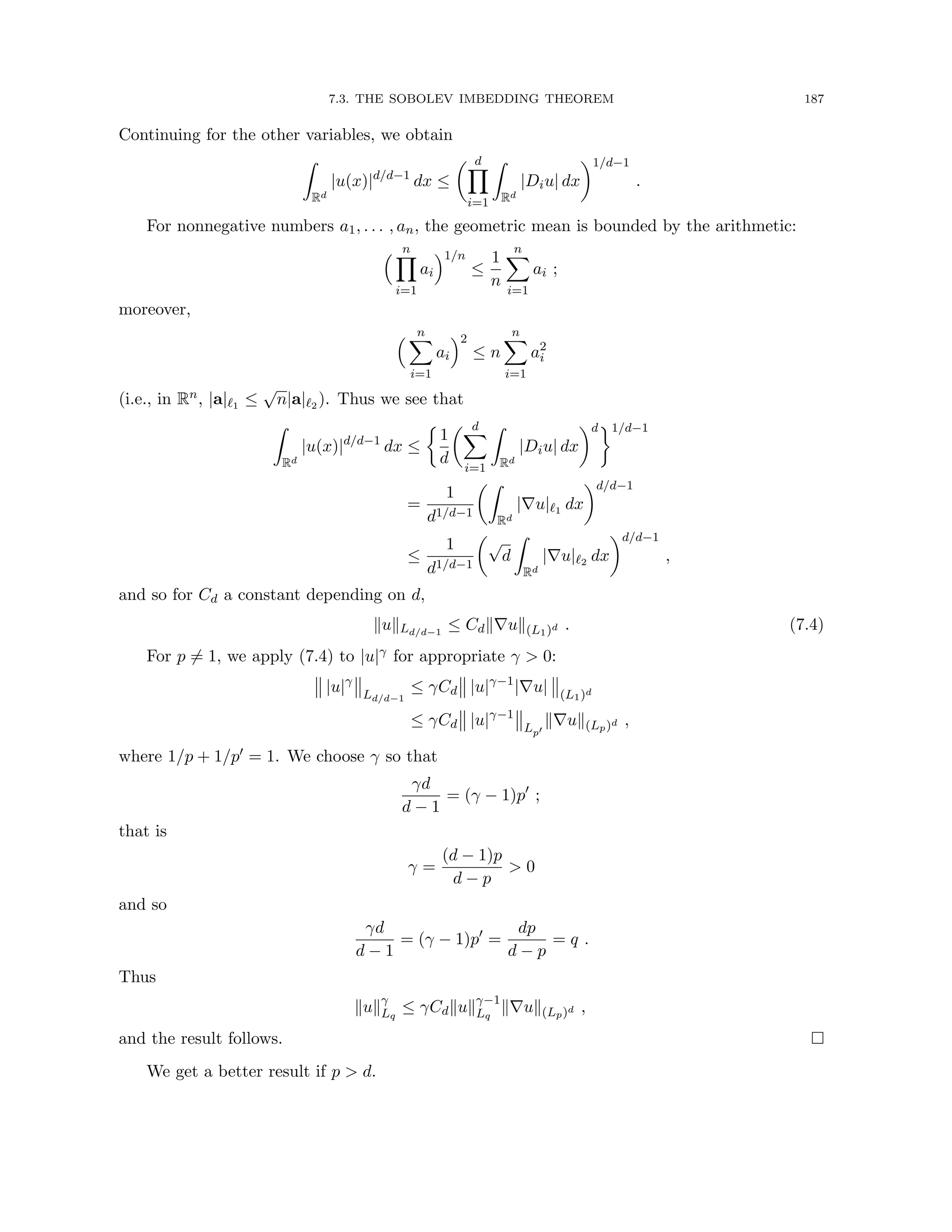
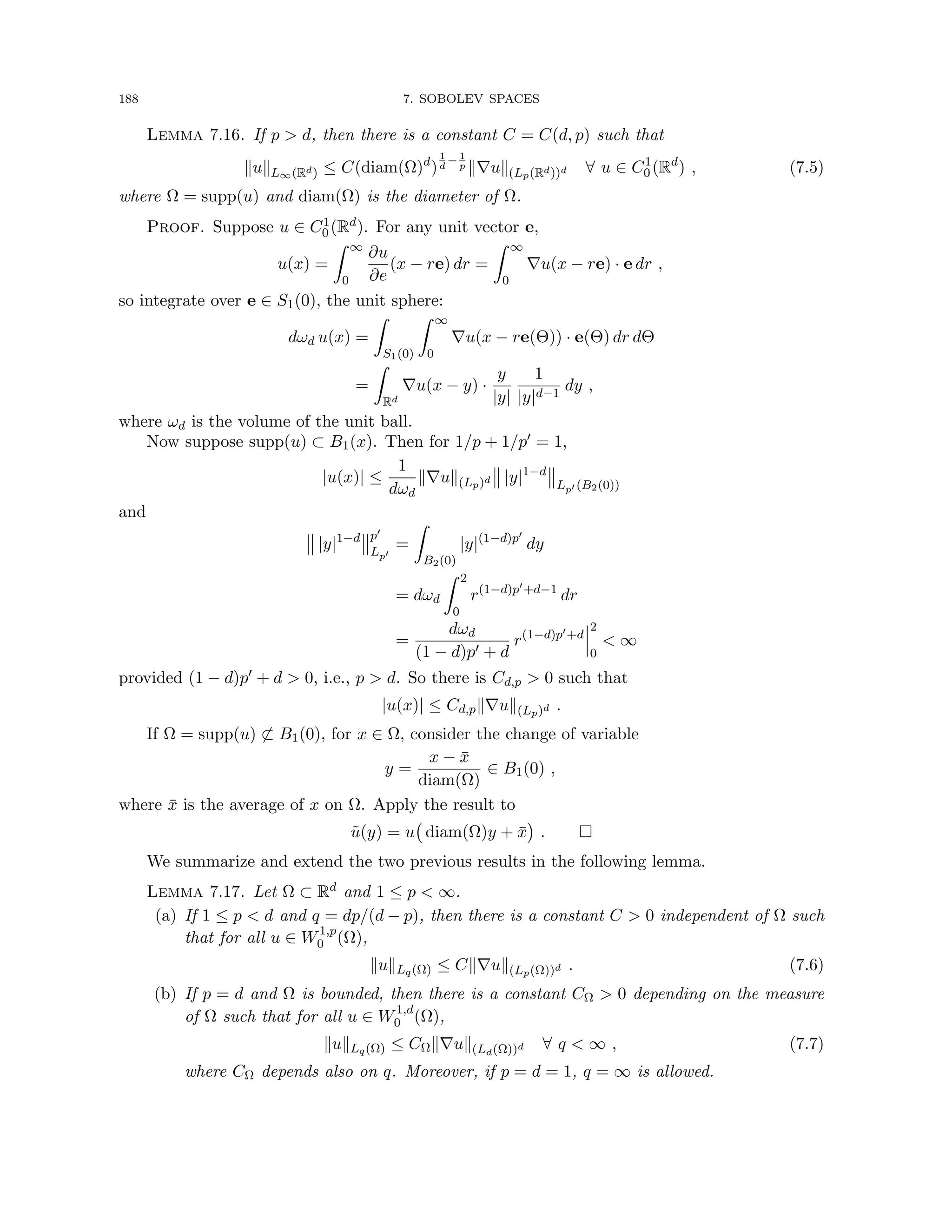
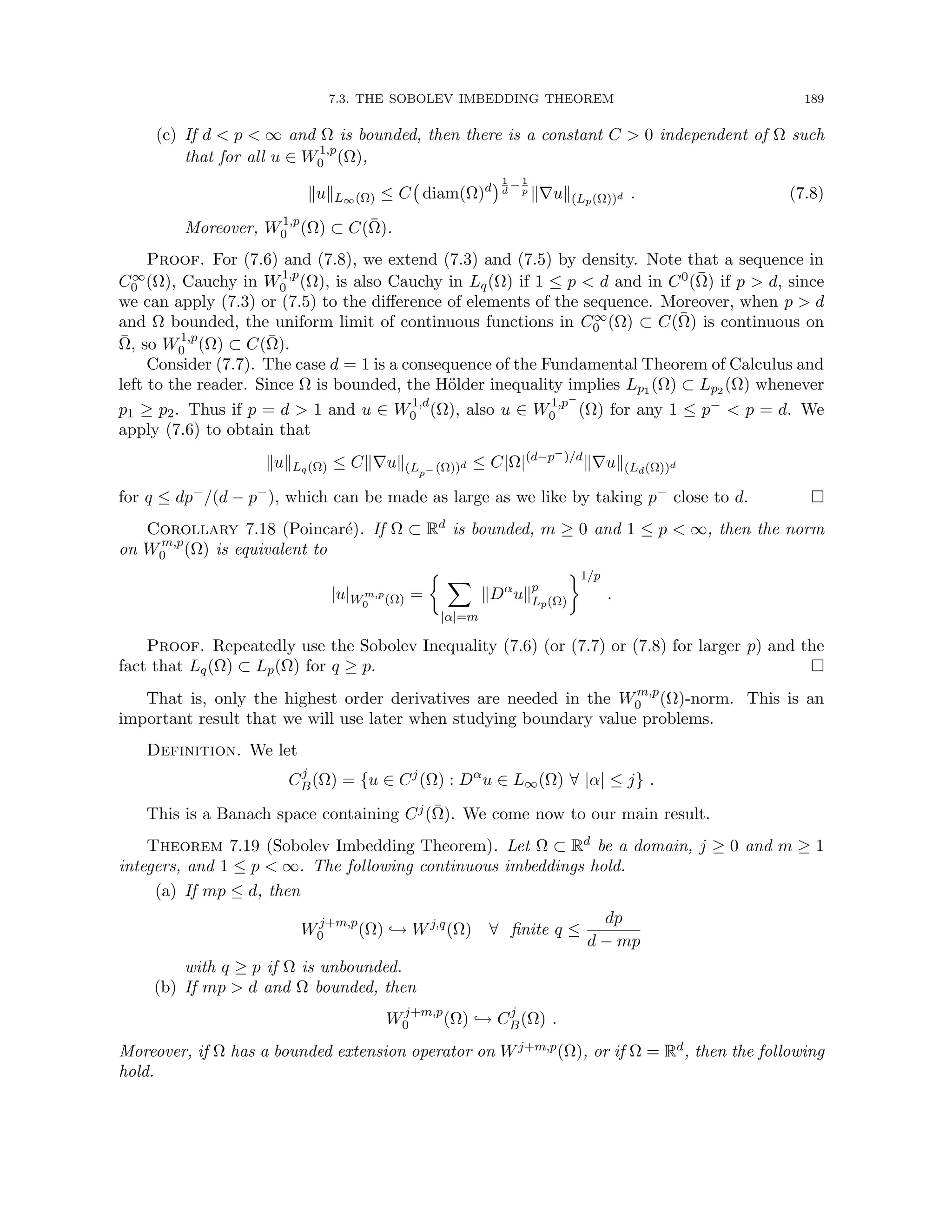
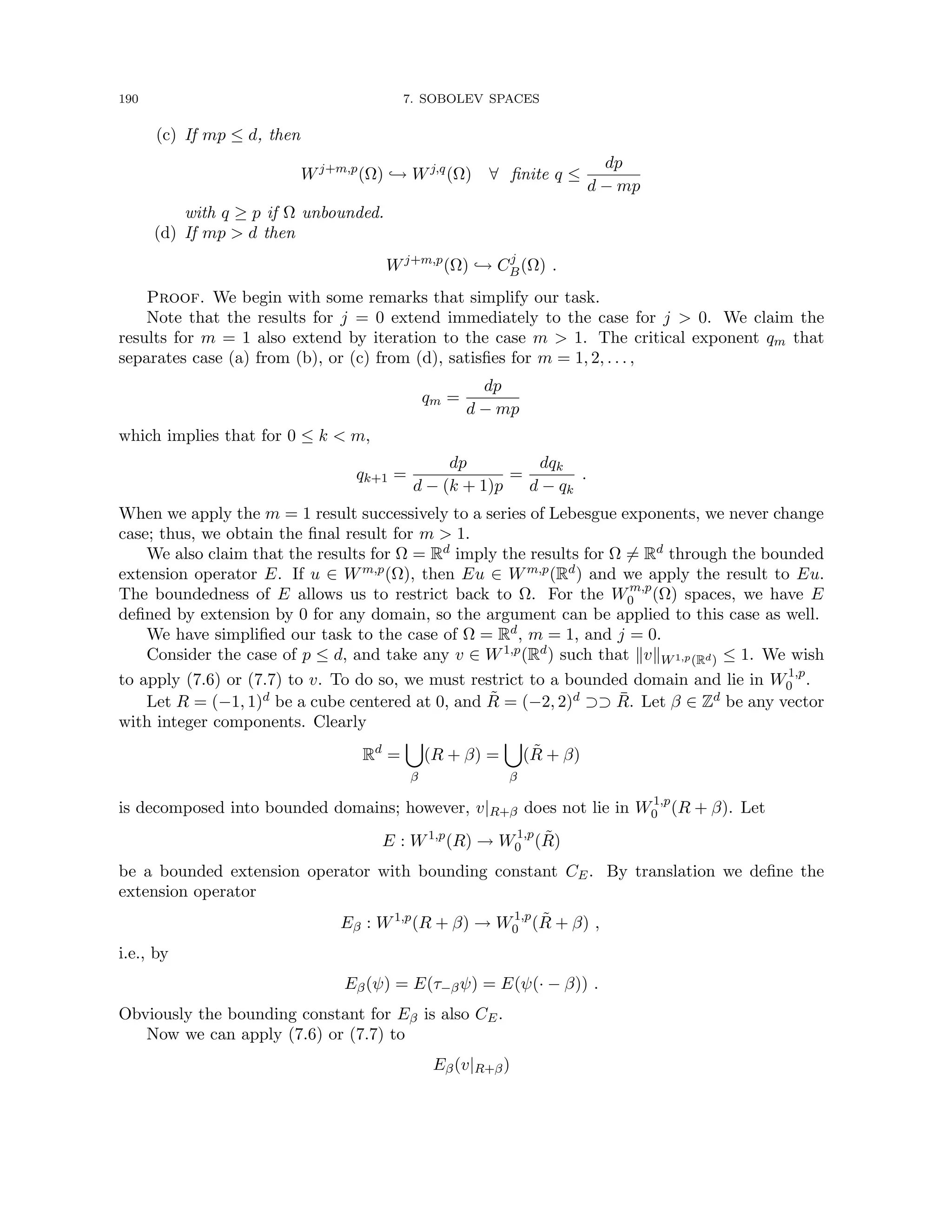
![7.4. COMPACTNESS 191
to obtain, for appropriate q,
kEβ(v|R+β)kLq(R̃+β) ≤ CSk∇Eβ(v|R+β)k(Lp(R̃+β))d ,
where CS is independent of β. Thus
kvkq
Lq(R+β) ≤ kEβ(v|R+β)kq
Lq(R̃+β)
≤ Cq
Sk∇Eβ(v|R+β)kq
(Lq(R̃+β))d
≤ Cq
SCq
Ekvkq
W1,p(R+β)
≤ Cq
SCq
Ekvkp
W1,p(R+β)
,
since p ≤ q and kvkW1,p(Rd) ≤ 1. Summing over β gives
kvkLq(Rd) ≤ C
for some C 0, since the union of the R + β cover Rd a finite number of times.
If now u ∈ W1,p(Rd), u 6= 0, let
v =
u
kukW1,p(Rd)
to obtain
kukLq(Rd) ≤ CkukW1,p(Rd) ;
thus, (a) and (c) follow.
Finally the argument for p d, i.e., (b) and (d), is similar, since again our bounding constant
in (7.8) is independent of β. This completes the proof.
Remark. The extension operator need only work for W1,p(Ω), since we iterated the one
derivative case. Thus Lipschitz domains satisfy the requirements. Most domains of interest
(e.g., any polygon or polytope) have Lipschitz boundaries.
7.4. Compactness
We have an important compactness result for Sobolev spaces.
Theorem 7.20 (Rellich-Kondrachov). Let Ω ⊂ Rd be a bounded domain, 1 ≤ p ∞, and
j ≥ 0 and m ≥ 1 be integers. Then Wj+m,p
0 (Ω) is compactly imbedded in Wj,q(Ω) ∀ 1 ≤ q
dp/(d − mp) if mp ≤ d, and in Cj(Ω̄) if mp d. Moreover, if Ω ⊂ Rd has a bounded extension
operator, then a similar statement holds for Wj+m,p(Ω).
Proof. We only sketch the proof and leave it to reader to fill out the argument (more
details may be found in, e.g., [GT, p. 167–8] or [Ad, p. 144–8]). We need only show the result
for j = 0, m = 1, and W1,p
0 (Ω). The result for general j and m follows from an iteration of the
case treated. The result for Wj+m,p(Ω) can be obtained from bounded extension to Ω̃ ⊃ Ω and
the result for Wj+m,p
0 (Ω̃).
We apply the Ascoli-Arzelà Theorem 4.30 to a bounded set A in Wm,p
0 (Ω̃). By density we
may assume A ⊂ C1
0 (Ω).
First consider the case p d. The Sobolev Imbedding Theorem gives us that A is bounded
in C0(Ω̄). For equicontinuity of A, consider u ∈ A, extended by zero to Rd. Let ε 0 be given,](https://image.slidesharecdn.com/appliedmathematicsmethods-230215152718-28efe5ed/75/applied-mathematics-methods-pdf-191-2048.jpg)
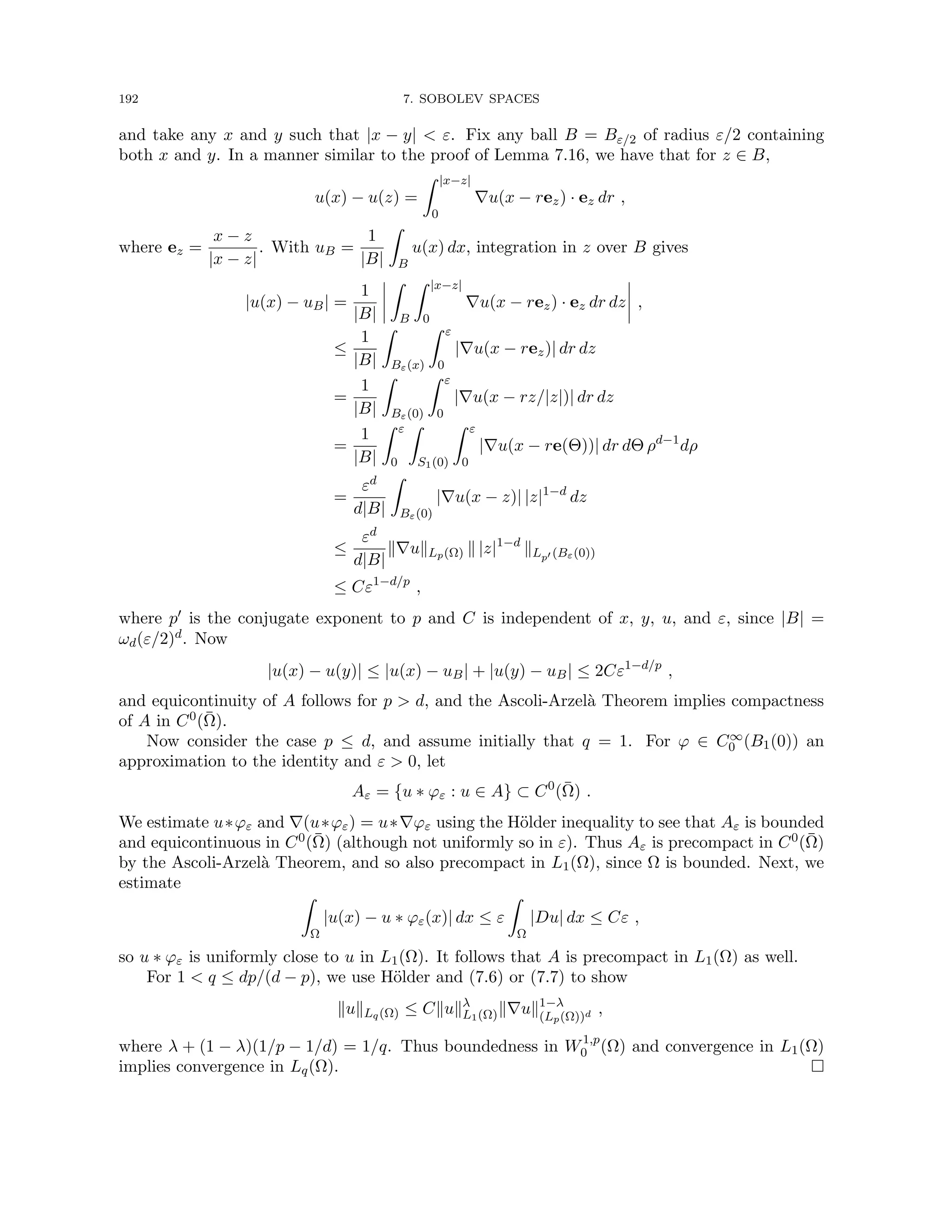
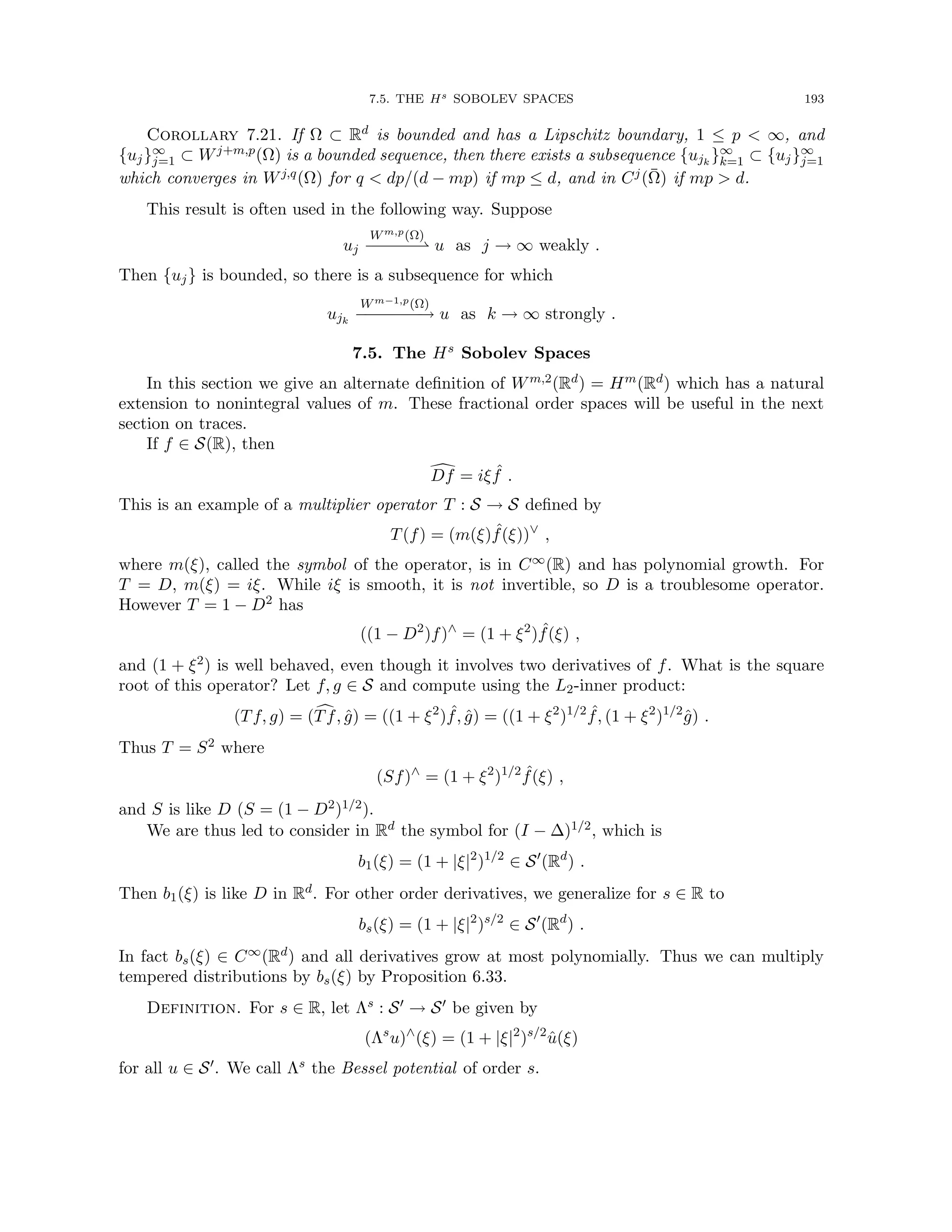
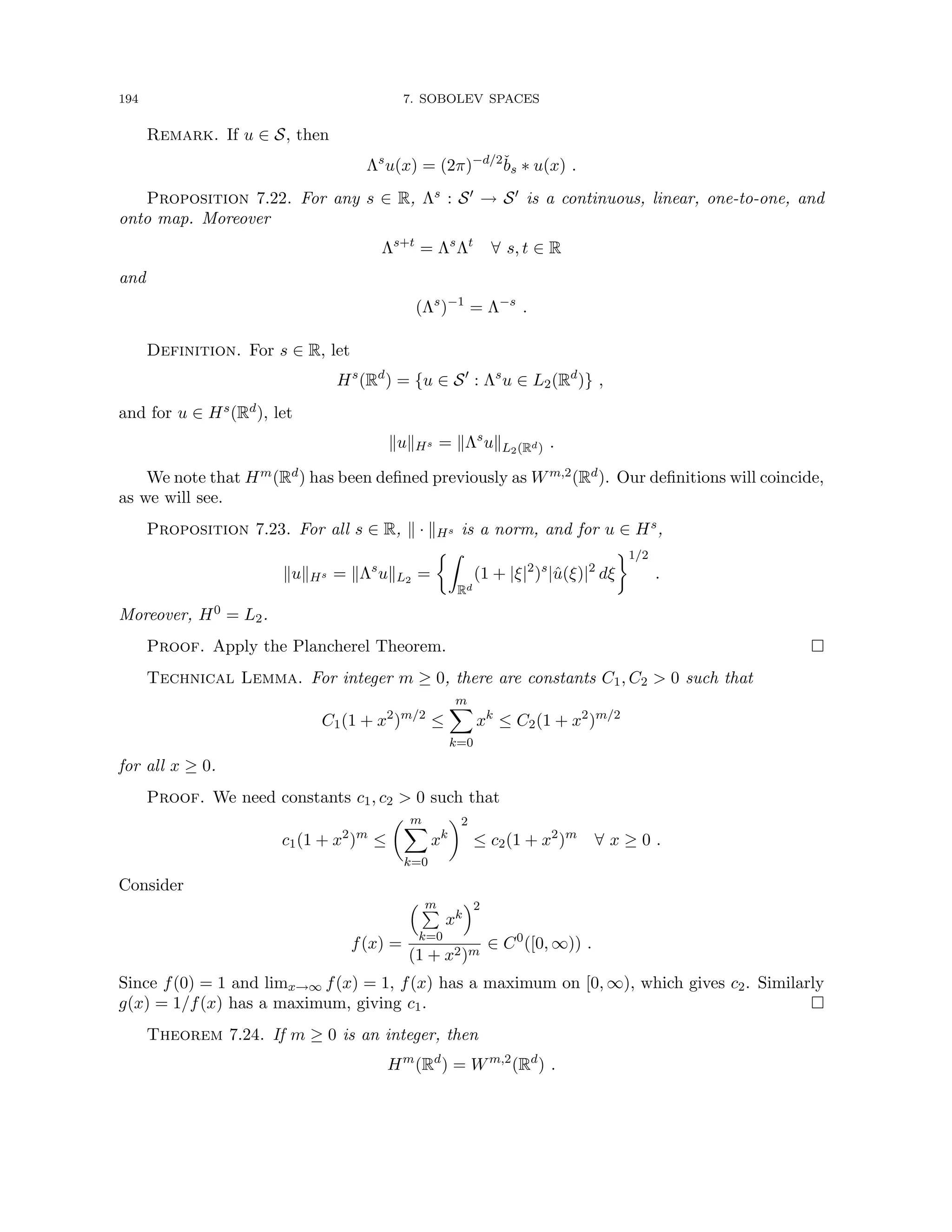
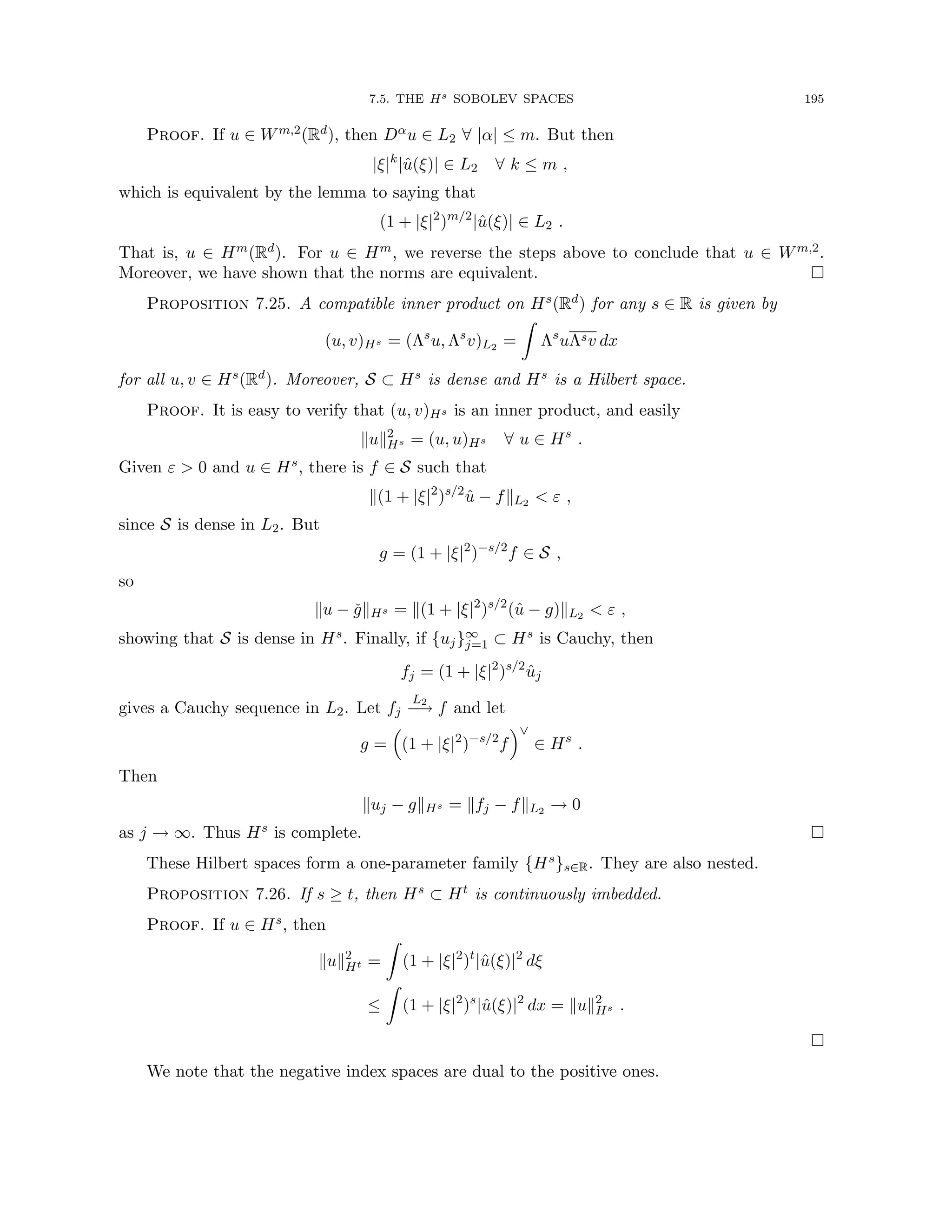

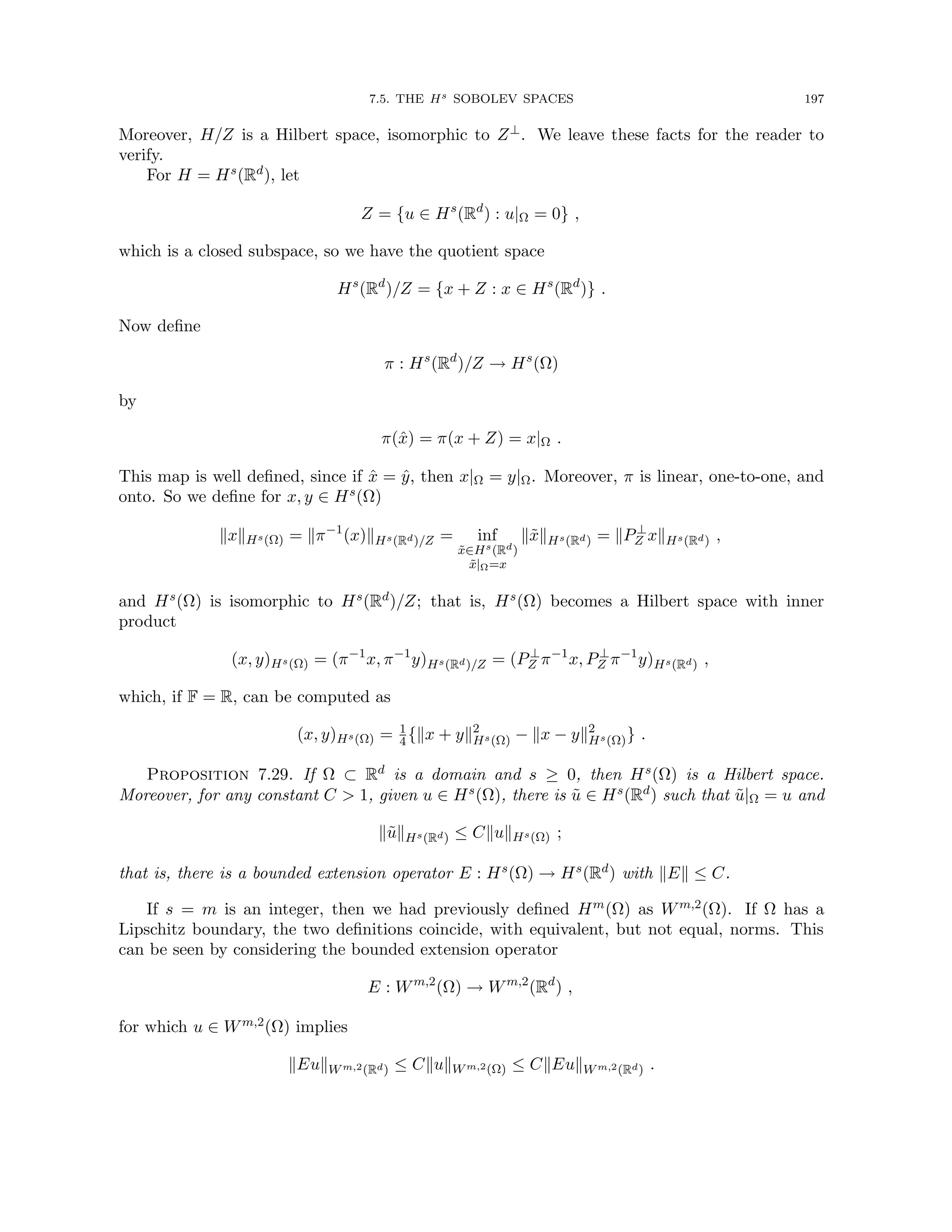
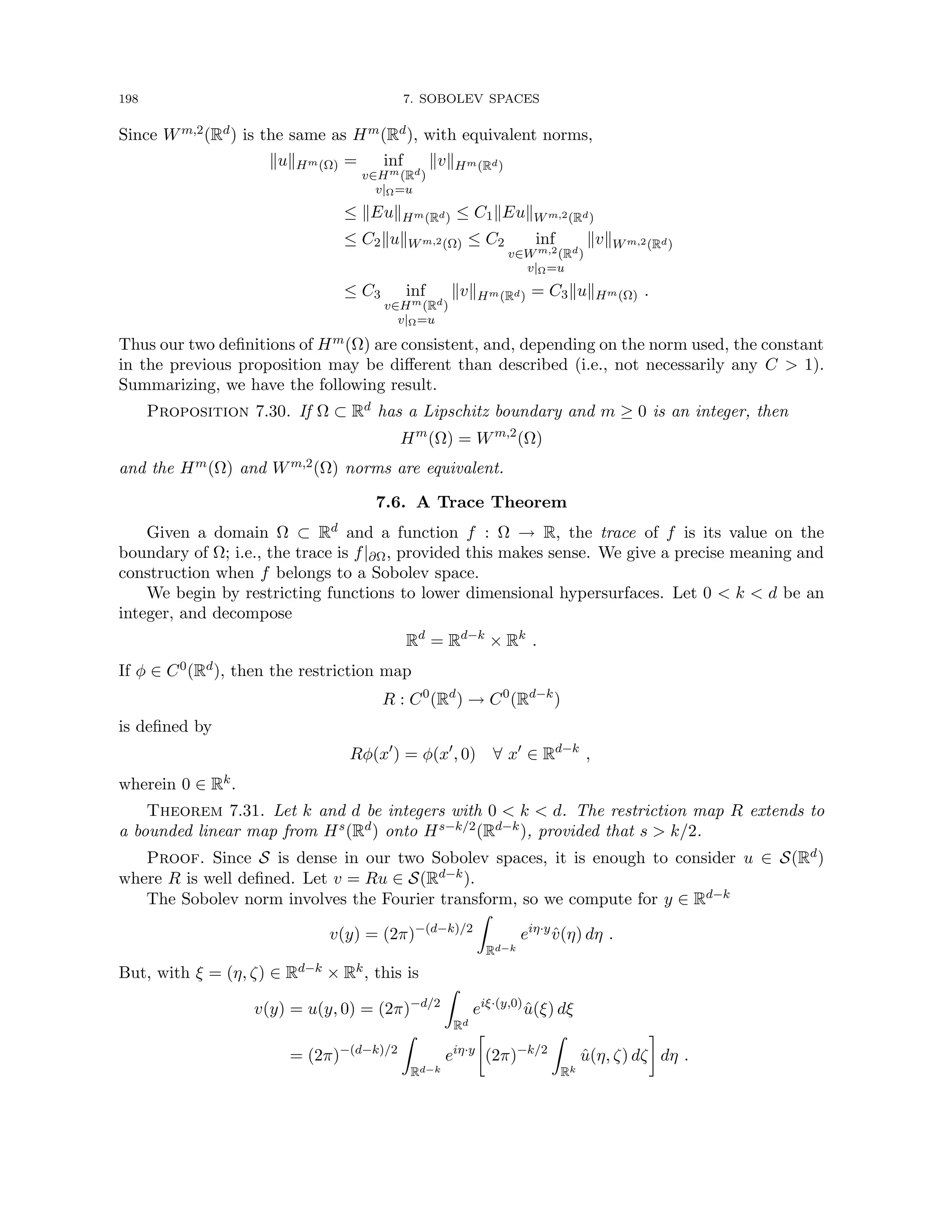

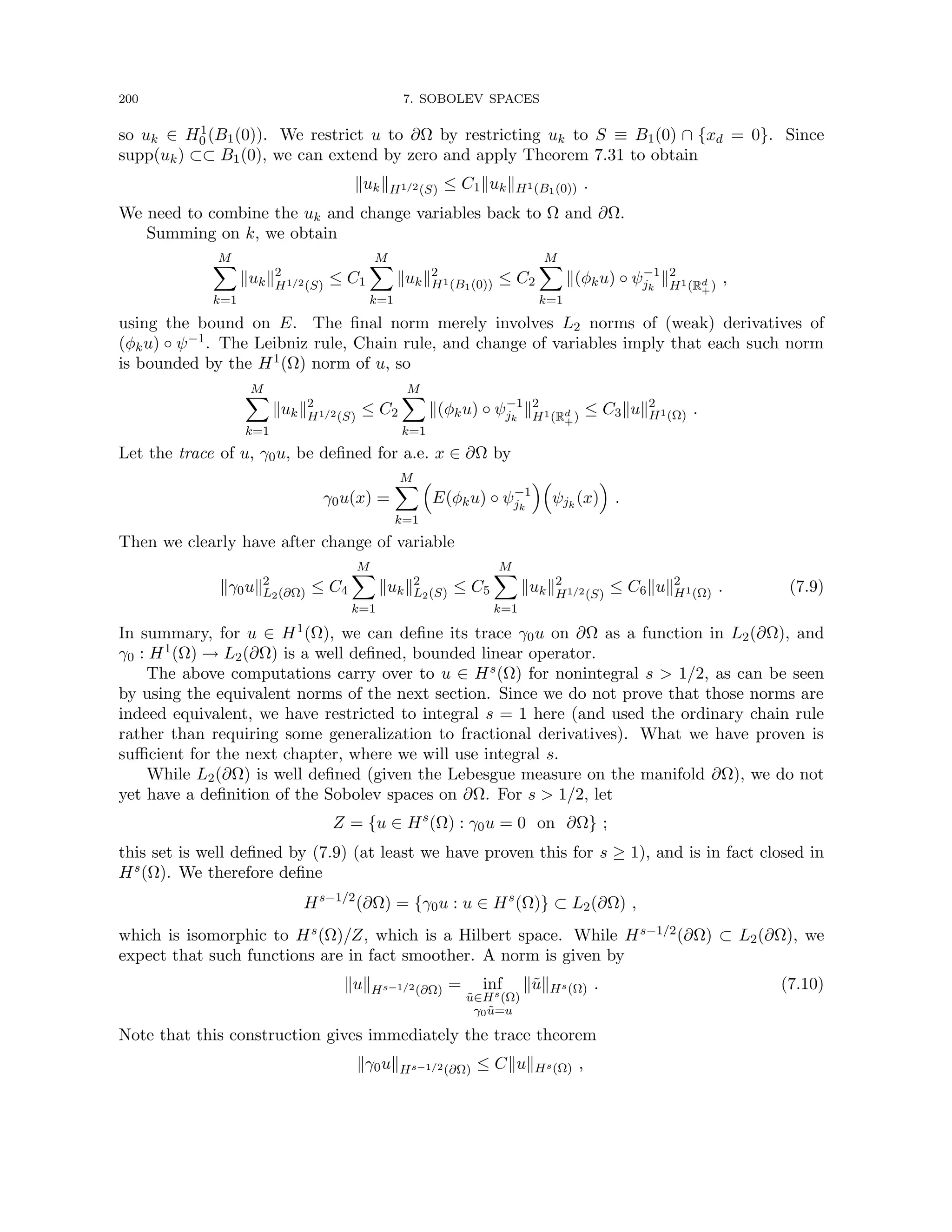
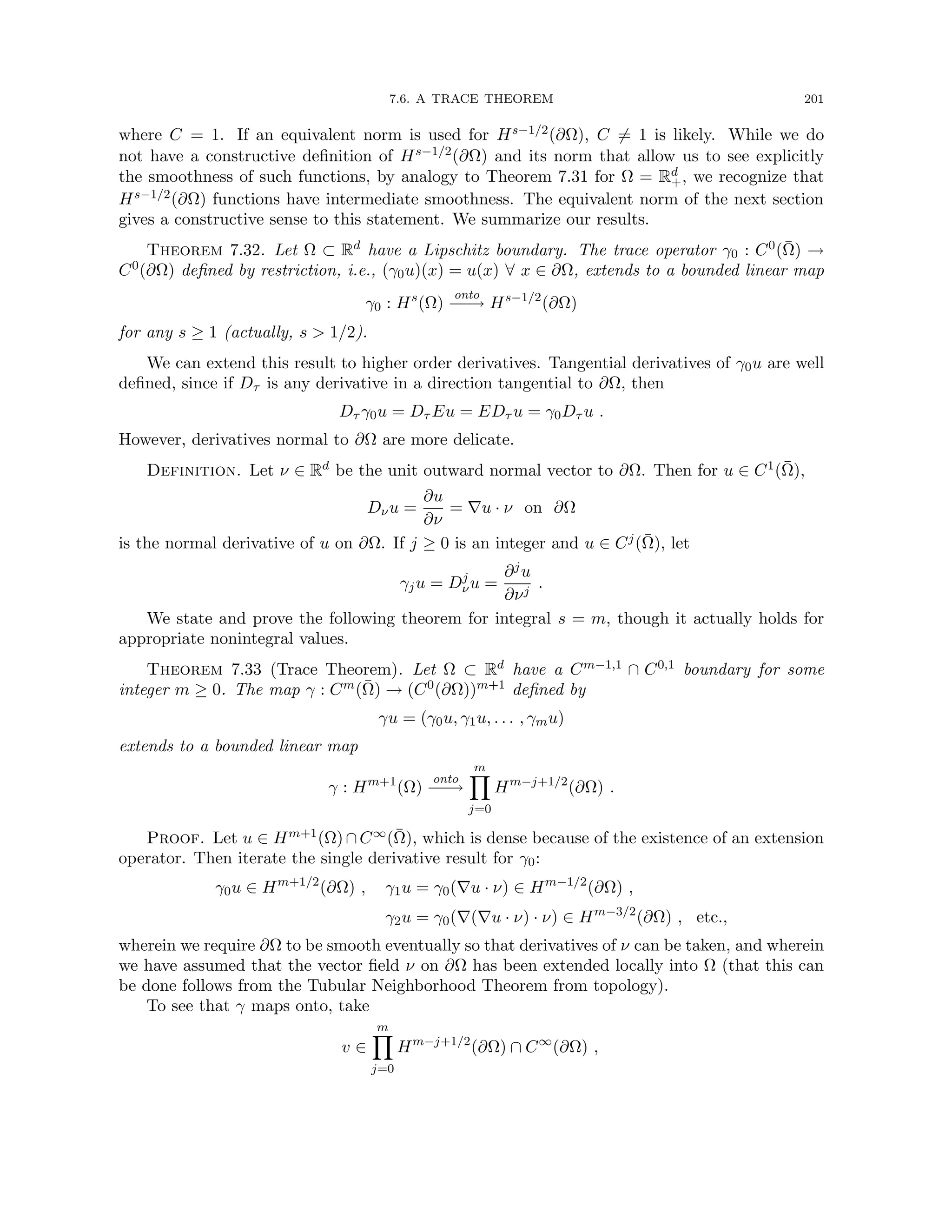
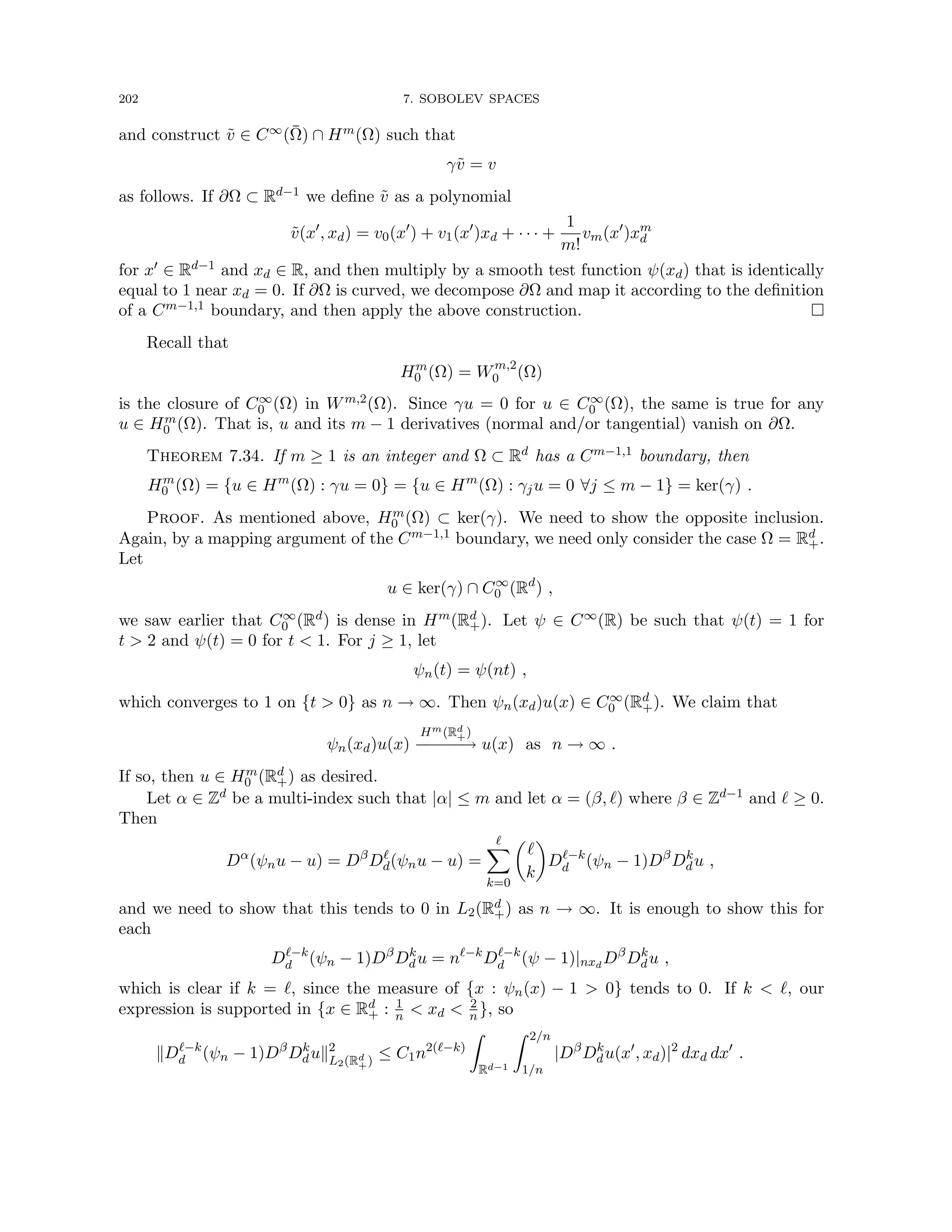
![7.7. THE Ws,p(Ω) SOBOLEV SPACES 203
Taylor’s theorem implies that for x = (x0, xd) ∈ Rd and j ≤ m,
Dk
du(x0
, xd) = Dk
du(x0
, 0) + · · · +
1
(j − k − 1)!
Dj−1
d u(x0
, 0)
+
1
(j − k − 1)!
Z xd
0
(xd − t)j−k−1
Dj
du(x0
, t) dt ,
which reduces to the last term since γu = 0. Thus for j = m − |β| = ` ≤ m,
kD`−k
d (ψn − 1)Dβ
Dk
duk2
L2(Rd
+)
≤ C2n2(`−k)
Z
Rd−1
Z 2/n
1/n
Z xd
0
(xd − t)`−k−1
Dβ
D`
du(x0
, t) dt
2
dxd dx0
≤ C3n2(`−k)
n−2(`−k−1)
Z
Rd−1
Z 2/n
1/n
Z 2/n
0
|Dβ
D`
du(x0
, t)| dt
2
dxd dx0
≤ C4n2
Z
Rd−1
1
n2
Z 2/n
0
|Dβ
D`
du(x0
, t)|2
dt dx0
→ 0 as n → ∞
since the measure of the inner integral tends to 0. Thus the claim is established and the proof
is complete.
7.7. The Ws,p(Ω) Sobolev Spaces
We can generalize some of the L2(Ω) results of the last two sections to Lp(Ω), and the results
for integral numbers of derivatives to nonintegral. We summarize a few of the important results.
See [Ad] for details and precise statements.
Definition. Suppose Ω ⊂ Rd, 1 ≤ p ≤ ∞, and s 0 such that s = m + σ where 0 σ 1
and m is an integer. Then we define for a smooth function u,
kukWs,p(Ω) =
kukp
Wm,p(Ω) +
X
|α|=m
Z
Ω
Z
Ω
|Dαu(x) − Dαu(y)|p
|x − y|d+σp
dx dy
1/p
if p ∞, and otherwise
kukWs,∞(Ω) = max
kukWm,∞(Ω), max
|α|=m
ess sup
x,y∈Ω
|Dαu(x) − Dαu(y)|
|x − y|σ
.
Proposition 7.35. For any 1 ≤ p ≤ ∞, k · kWs,p(Ω) is a norm.
Definition. We let Ws,p(Ω) be the completion of C∞(Ω) under the k · kWs,p(Ω)-norm, and
Ws,p
0 (Ω) is the completion of C∞
0 (Ω).
Proposition 7.36. If Ω = Rd or Ω has a Lipschitz boundary, then
Ws,2
(Ω) = Hs
(Ω) and Ws,2
0 (Ω) = Hs
0(Ω) .
Thus we have an equivalent norm on Hs(Ω) given above.
If 1 ≤ p ∞ and m = s is nonintegral, then we have analogues of the Sobolev Imbedding
Theorem, the Rellich-Kondrachov Theorem, and the Trace Theorem. For the Trace Theorem,
every time a trace is taken on a hypersurface of one less dimension (as from Ω to ∂Ω), 1/p
derivative is lost, rather than 1/2.](https://image.slidesharecdn.com/appliedmathematicsmethods-230215152718-28efe5ed/75/applied-mathematics-methods-pdf-203-2048.jpg)
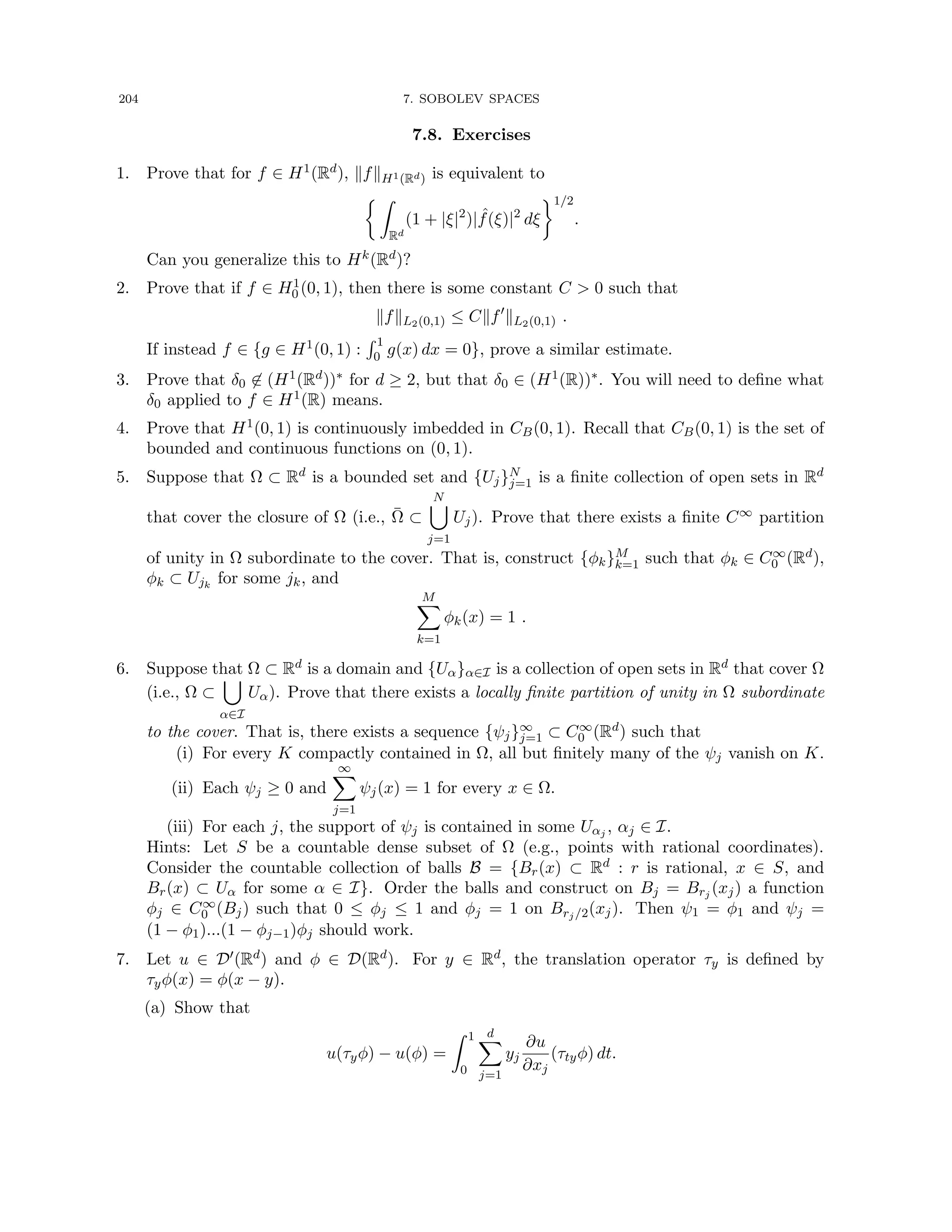
![7.8. EXERCISES 205
(b) Apply this to
f ∈ W1,1
loc (Rd
) =
f ∈ L1,loc(Rd
) :
∂f
∂xj
∈ L1,loc(Rd
) for all j
to show that
f(x + y) − f(x) =
Z 1
0
y · ∇f(x + ty) dt.
(c) Let the locally Lipschitz functions be defined as
C0,1
loc (Rd
) = {f ∈ C0
(Rd
) : ∀R 0, there is some LR,f depending on R and f
such that |f(x) − f(y)| ≤ LR,f |x − y| ∀x, y ∈ BR(0)} .
Conclude that W1,1
loc (Rd) ⊂ C0,1
loc (Rd).
8. Counterexamples.
(a) No imbedding of W1,p(Ω) ,→ Lq(Ω) for 1 ≤ p d and q dp/(d − p). Let Ω ⊂ Rd be
bounded and contain 0, and let f(x) = |x|α. Find α so that f ∈ W1,p(Ω) but f 6∈ Lq(Ω).
(b) No imbedding of W1,p(Ω) ,→ C0
B(Ω) for 1 ≤ p d. Note that in the previous case, f is
not bounded. What can you say about which (negative) Sobolev spaces the Dirac mass lies
in?
(c) No imbedding of W1,p(Ω) ,→ L∞(Ω) for 1 p = d. Let Ω ⊂ Rd = BR(0) and let
f(x) = log(log(4R/|x|)). Show f ∈ W1,p(BR(0)).
(d) C∞ ∩ W1,∞ is not dense in W1,∞. Show that if Ω = (−1, 1) and u(x) = |x|, then
u ∈ W1,∞ but u(x) is not the limit of C∞ functions in the W1,∞-norm.
9. Suppose that fj ∈ H2(Ω) for j = 1, 2, ..., fj
w
* f weakly in H1(Ω), and Dαfj
w
* gα weakly
in L2(Ω) for all multi-indices α such that |α| = 2. Show that f ∈ H2(Ω), Dαf = gα, and,
for a subsequence, fj → f strongly in H1(Ω).
10. Suppose that Ω ⊂ Rd is bounded with a Lipschitz boundary and fj
w
* f and gj
w
* g weakly
in H1(Ω) . Show that, for a subsequence, ∇(fjgj) → ∇(fg) as a distribution. Find all p in
[1, ∞] such that the convergence can be taken weakly in Lp(Ω).
11. Suppose that Ω ∈ Rd is a bounded domain with Lipschitz boundary and {uk} ⊂ H2+(Ω) is
a bounded sequence, where 0.
(a) Show that there is u ∈ H2(Ω) such that, for a subsequence, uj → u in H2(Ω).
(b) Find all q and s ≥ 0 such that, for a subsequence, uj → u in Ws,q(Ω).
(c) For a subsequence, |uj|r∇uj → |u|r∇u in L2(Ω) for certain r ≥ 1. For fixed d, how big
can r be? Justify your answer.
12. Prove that Hs(Rd) is imbedded in C0
B(Rd) if s d/2 by completing the following outline.
(a) Show that
Z
Rd
(1 + |ξ|2
)−s
dξ ∞.
(b) If φ ∈ S and x ∈ Rd, write φ(x) as the Fourier inversion integral of φ̂. Introduce
1 = (1 + |ξ|2)s/2(1 + |ξ|2)−s/2 into the integral and apply Hölder to obtain the result for
Schwartz class functions.](https://image.slidesharecdn.com/appliedmathematicsmethods-230215152718-28efe5ed/75/applied-mathematics-methods-pdf-205-2048.jpg)
![206 7. SOBOLEV SPACES
(c) Use density to extend the above result to Hs(Rd).
13. Interpolation inequalities.
(a) Show that for f ∈ H1(Rd) and 0 ≤ s ≤ 1, kfkHs(Rd) ≤ kfks
H1(Rd)
kfk1−s
L2(Rd)
. Can you
generalize this result to f ∈ Hr(Rd) for r 0?
(b) If Ω is bounded and ∂Ω is smooth, show that there is a constant C such that for all
f ∈ H1(Ω), kfkL2(∂Ω) ≤ Ckfk
1/2
H1(Ω)
kfk
1/2
L2(Ω)
. [Hint: Show for d = 1 on (0, 1) by considering
f(0)2
= f(x)2
−
Z x
0
d
dx
f(t)2
dt .
For d 1, flatten out ∂Ω and use a (d = 1)-type proof in the normal direction.]
14. Suppose f ∈ L2(R) and ω̂(ξ) =
p
|ξ|. Make sense of the definition g = ω ∗ f, and determine
s such that g ∈ Hs(R).
15. Suppose that ω ∈ L1(R), ω(x) 0, and ω is even. Moreover, for x 0, ω ∈ C2[0, ∞),
ω0(x) 0, and ω00(x) 0. Consider the following equation for u:
ω ∗ u − u00
= f ∈ L2(R).
(a) Show that ω̂(ξ) 0. [Hint: use that ω is even, integrate by parts, and consider subin-
tervals of size 2π/|ξ|.]
(b) Find a fundamental solution to the differential equation (i.e., replace f by δ0). You may
leave your answer in terms of an inverse Fourier Transform.
(c) For the original problem, find the solution operator as a convolution operator.
(d) Show that the solution u ∈ H2(R).
16. Elliptic regularity theory shows that if the domain Ω ⊂ Rd has a smooth boundary and
f ∈ Hs(Ω), then −∆u = f in Ω, u = 0 on ∂Ω, has a unique solution u ∈ Hs+2. For what
values of s will u be continuous? Can you be sure that a fundamental solution is continuous?
The answers depend on d.](https://image.slidesharecdn.com/appliedmathematicsmethods-230215152718-28efe5ed/75/applied-mathematics-methods-pdf-206-2048.jpg)
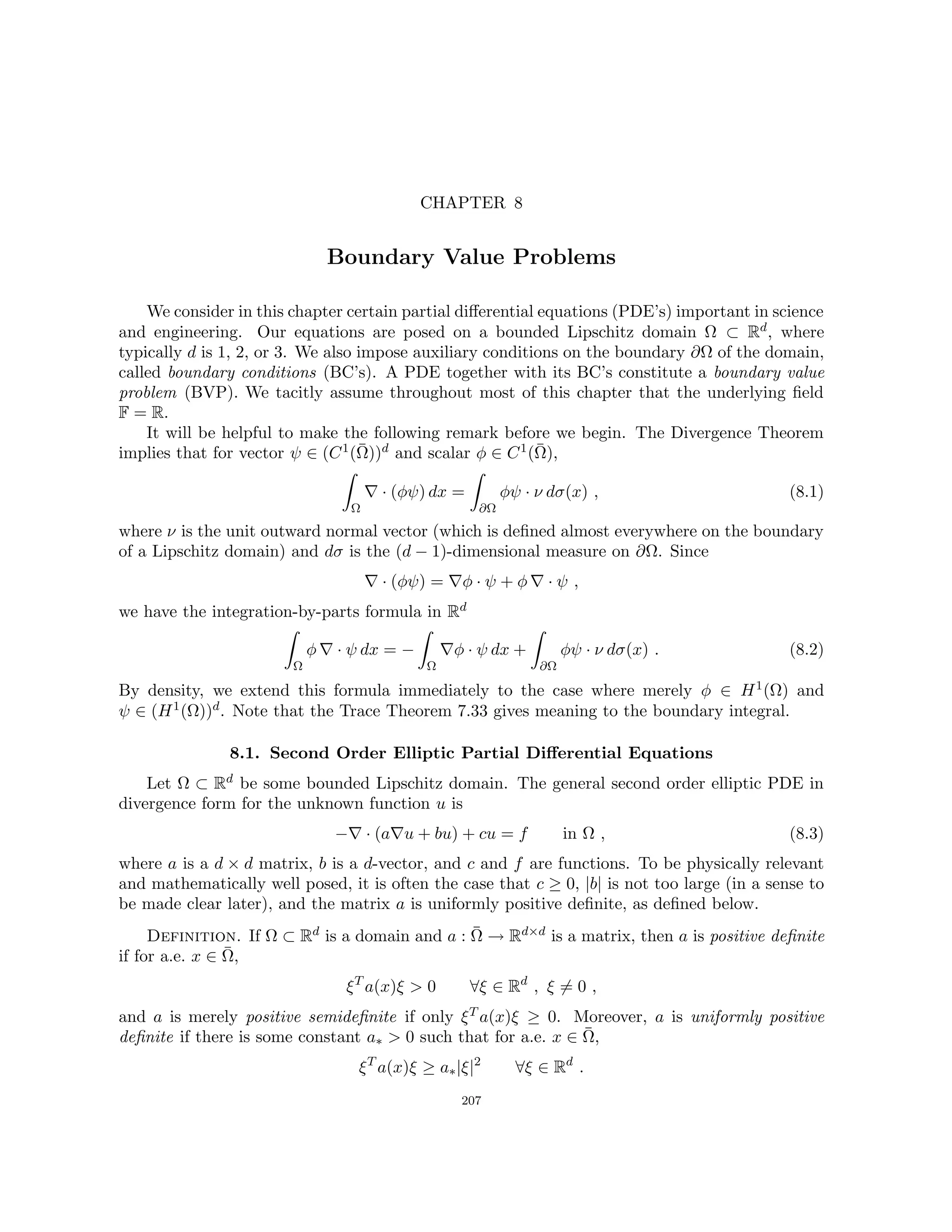
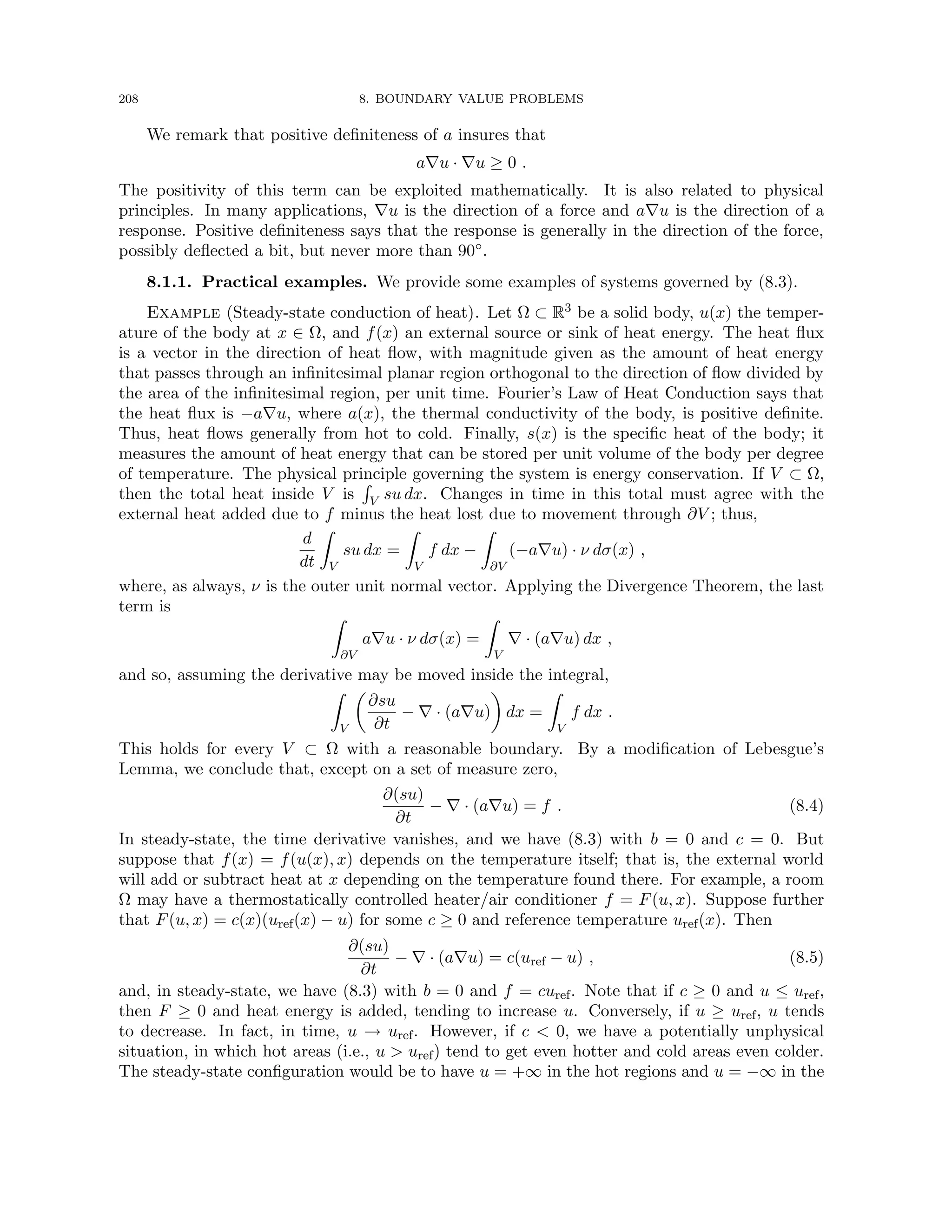
![8.1. SECOND ORDER ELLIPTIC PARTIAL DIFFERENTIAL EQUATIONS 209
cold regions! Thus c ≥ 0 should be demanded on physical grounds (later it will be required on
mathematical grounds as well).
Example (The electrostatic potential). Let u be the electrostatic potential, for which the
electric flux is −a∇u for some a measuring the electrostatic permitivity of the medium Ω.
Conservation of charge over an arbitrary volume in Ω, the Divergence Theorem, and the Lebesgue
Lemma give (8.3) with c = 0 and b = 0, where f represents the electrostatic charges.
Example (Steady-state fluid flow in a porous medium). The equations of steady-state flow
of a nearly incompressible, single phase fluid in a porous medium are similar to those for the
flow of heat. In this case, u is the fluid pressure. Darcy’s Law gives the volumetric fluid flux
(also called the Darcy velocity) as −a(∇u − gρ), where a is the permeability of the medium Ω
divided by the fluid viscosity, g is the gravitational vector, and ρ is the fluid density. The total
mass in volume V ⊂ Ω is
R
V ρ dx, and this quantity changes in time due to external sources (or
sinks, if negative, such as wells) represented by f and mass flow through ∂V . The mass flux is
given by multiplying the volumetric flux by ρ. That is, with t being time,
d
dt
Z
V
ρ dx =
Z
V
f dx −
Z
∂V
−ρa(∇u − gρ) · ν dσ(x)
=
Z
V
f dx +
Z
V
∇ · [ρa(∇u − gρ)] dx ,
and we conclude that, provided we can take the time derivative inside the integral,
∂ρ
∂t
− ∇ · [ρa(∇u − gρ)] = f .
Generally speaking, ρ = ρ(u) depends on the pressure u through an equation-of-state, so this
is a time dependent, nonlinear equation. If we assume steady-state flow, we can drop the first
term. We might also simplify the equation-of-state if ρ(u) ≈ ρ0 is nearly constant (at least over
the pressures being encountered). One choice uses
ρ(u) ≈ ρ0 + γ(u − u0) ,
where γ and u0 are fixed (note that these are the first two terms in a Taylor approximation of
ρ about u0). Substituting this in the equation above results in
−∇ · {a[(ρ0 + γ(u − u0))∇u − g(ρ0 + γ(u − u0))2
]} = f .
This is still nonlinear, so a further simplification would be to linearize the equation (i.e., assume
u ≈ u0 and drop all higher order terms involving u − u0). Since ∇u = ∇(u − u0), we obtain
finally
−∇ · {ρ0a[∇u − g(ρ0 + 2γ(u − u0))]} = f ,
which is (8.3) with a replaced by ρ0a, c = 0, b = −2ρ0agγ, and f replaced by f − ∇ · [ρ0ag(ρ0 −
2γu0)].
8.1.2. Boundary conditions (BC’s). In each of the previous examples, we determined
the equation governing the behavior of the system, given the external forcing term f distributed
over the domain Ω. However, the description of each system is incomplete, since we must also
describe the external interaction with the world through its boundary ∂Ω.
These boundary conditions generally take one of three forms, though many others are possi-
ble depending on the system being modeled. Let ∂Ω be decomposed into ΓD, ΓN , and ΓR, where
the three parts of the boundary are open, contained in ∂Ω, cover ∂Ω (i.e., ∂Ω = Γ̄D ∪ Γ̄N ∪ Γ̄R),](https://image.slidesharecdn.com/appliedmathematicsmethods-230215152718-28efe5ed/75/applied-mathematics-methods-pdf-209-2048.jpg)
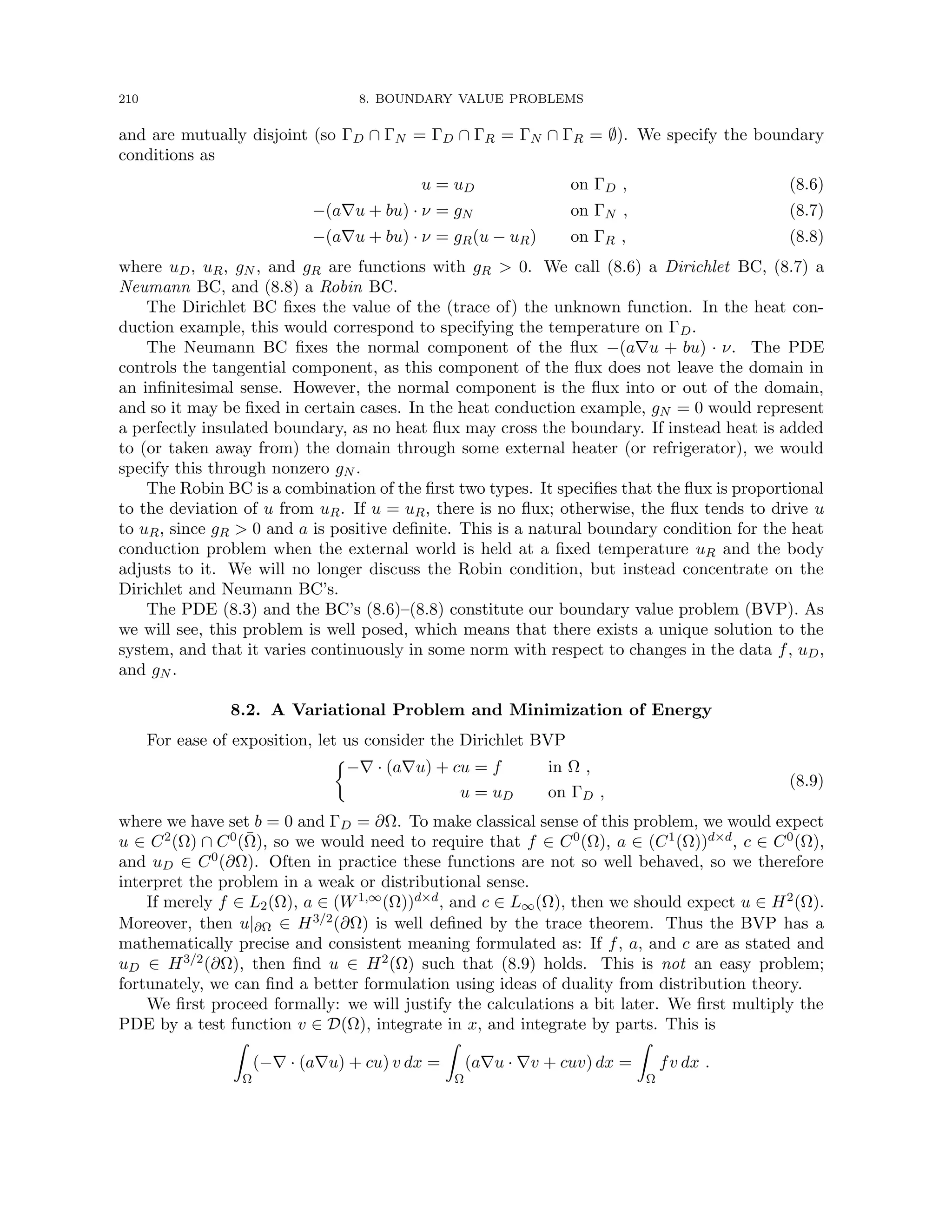

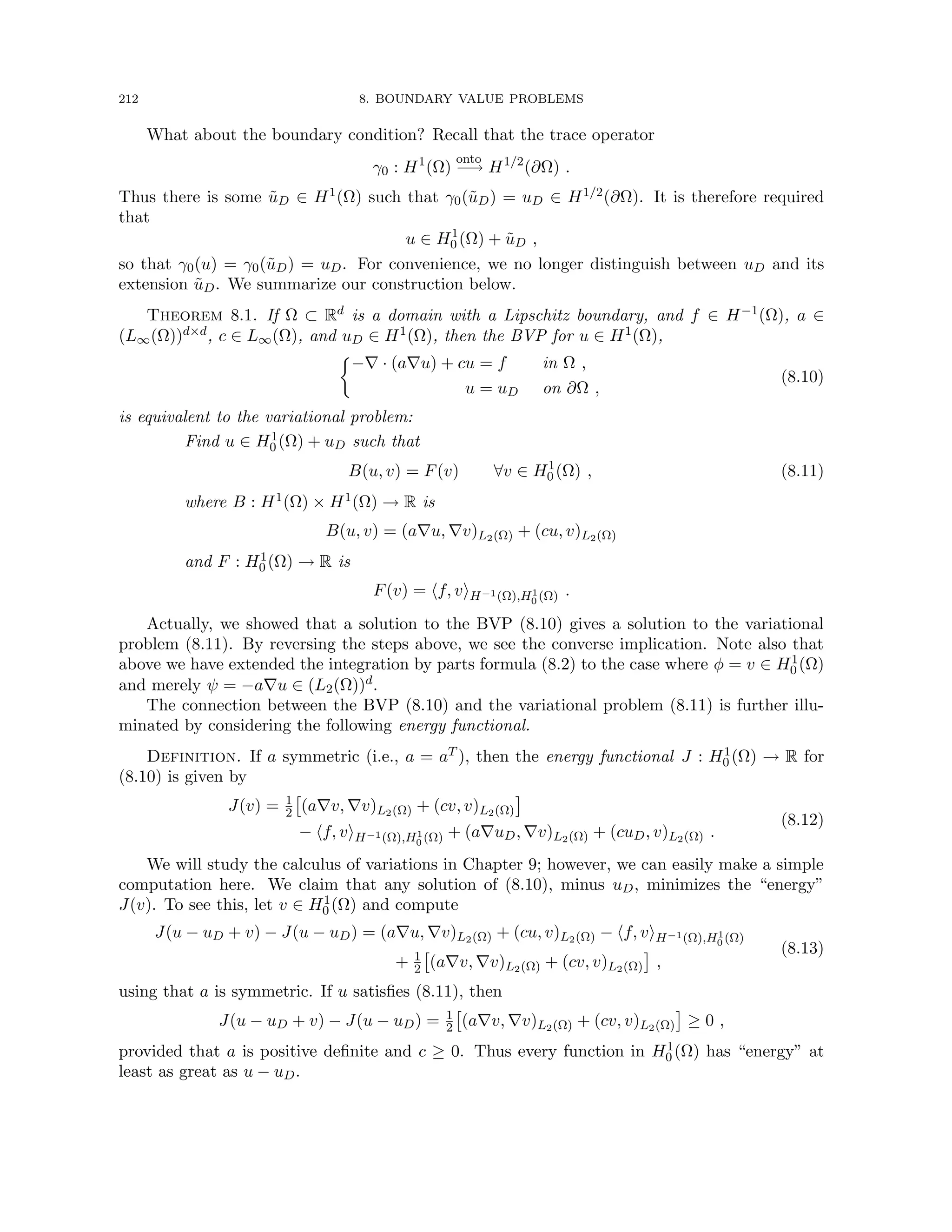
![8.3. THE CLOSED RANGE THEOREM AND OPERATORS BOUNDED BELOW 213
Conversely, if u − uD ∈ H1
0 (Ω) is to minimize the energy J(v), then replacing in (8.13) v by
v for ∈ R, 6= 0, we see that the difference quotient
1
J(u − uD + v) − J(u − uD)
= (a∇u, ∇v)L2(Ω) + (cu, v)L2(Ω) − hf, viH−1(Ω),H1
0 (Ω)
+
2
(a∇v, ∇v)L2(Ω) + (cv, v)L2(Ω)
,
(8.14)
must be nonnegative if 0 and nonpositive if 0. Taking → 0 on the right-hand side
shows that the first three terms must be both nonnegative and nonpositive, i.e., zero; thus, u
must satisfy (8.11). Note that as → 0, the left-hand side is a kind of derivative of J at u − uD.
At the minimum, we have a critical point where the derivative vanishes.
Theorem 8.2. If the hypotheses of Theorem 8.1 hold, and if c ≥ 0 and a is symmetric and
positive definite, then (8.10) and (8.11) are also equivalent to the minimization problem:
Find u ∈ H1
0 (Ω) + uD such that
J(u − uD) ≤ J(v) ∀v ∈ H1
0 (Ω) , (8.15)
where J is given above by (8.12).
The physical principles of conservation or energy minimization are equivalent in this context,
and they are connected by the variational problem: (1) it is the weak form of the BVP, given
by multiplying by a test function, integrating, and integrating by parts to even out the number
of derivatives on the solution and the test function, and (2) the variational problem also gives
the critical point of the energy functional where it is minimized.
Example. As another example of the use of energy functionals, consider a thin membrane
stretched over a rigid frame. We describe this as follows. Let Ω ∈ R2 be open in the xy-plane
and suppose that there is a function f : ∂Ω → R which describes the z-coordinate (height) of
the rigid frame. That is, the frame is
{(x, y, z) : z = f(x, y) for all (x, y) ∈ ∂Ω} .
We let u : Ω → R be the height of the membrane. The membrane will assume the shape that
minimizes the energy, subject to the constraint that it attaches to the rigid frame. If f = 0, the
energy functional E : H1(Ω) → R is a sum of the elastic energy and the gravitational potential
energy:
E(u) =
Z
Ω
[1
2a|∇u|2
+ gu] dx ,
where a is a constant related to the elasticity of the membrane and g is the gravitational constant.
We minimize E subject to the constraint that the trace of u, γ0(u), vanishes on the boundary.
This minimization problem gives rise to the partial differential equation
−∇ · a∇u = −g in Ω , u = 0 on ∂Ω ,
and, equivalently, its variational form.
8.3. The Closed Range Theorem and Operators Bounded Below
We continue with an abstract study of equation solvability that will be needed in the next
section. In this section, we do not require the field to be real. We begin with a basic definition.
Definition. Let X be a NLS and Z ⊂ X. Then the orthogonal complement of Z is
Z⊥
= {x∗
∈ X∗
: hx∗
, ziX∗,X = 0 ∀z ∈ Z} .](https://image.slidesharecdn.com/appliedmathematicsmethods-230215152718-28efe5ed/75/applied-mathematics-methods-pdf-213-2048.jpg)
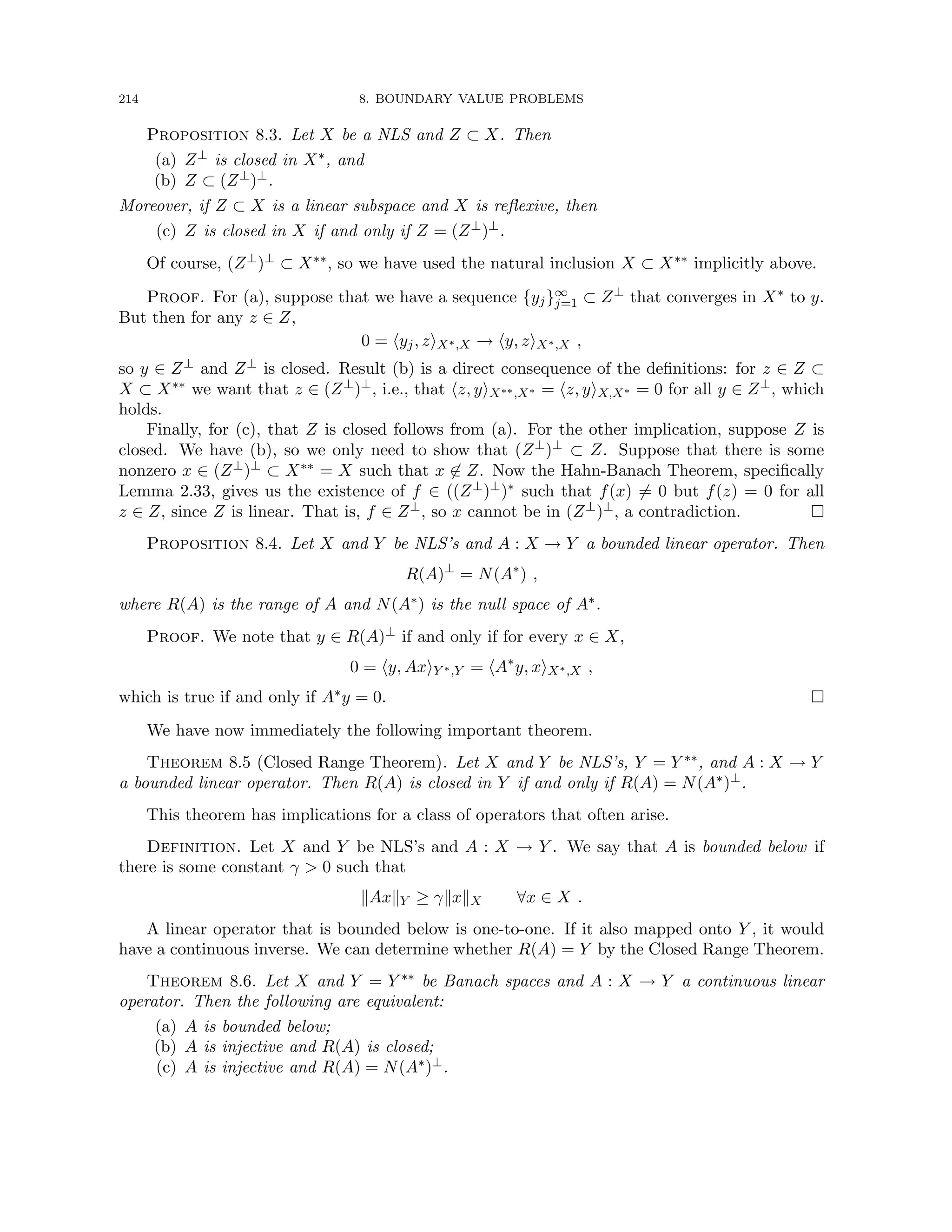
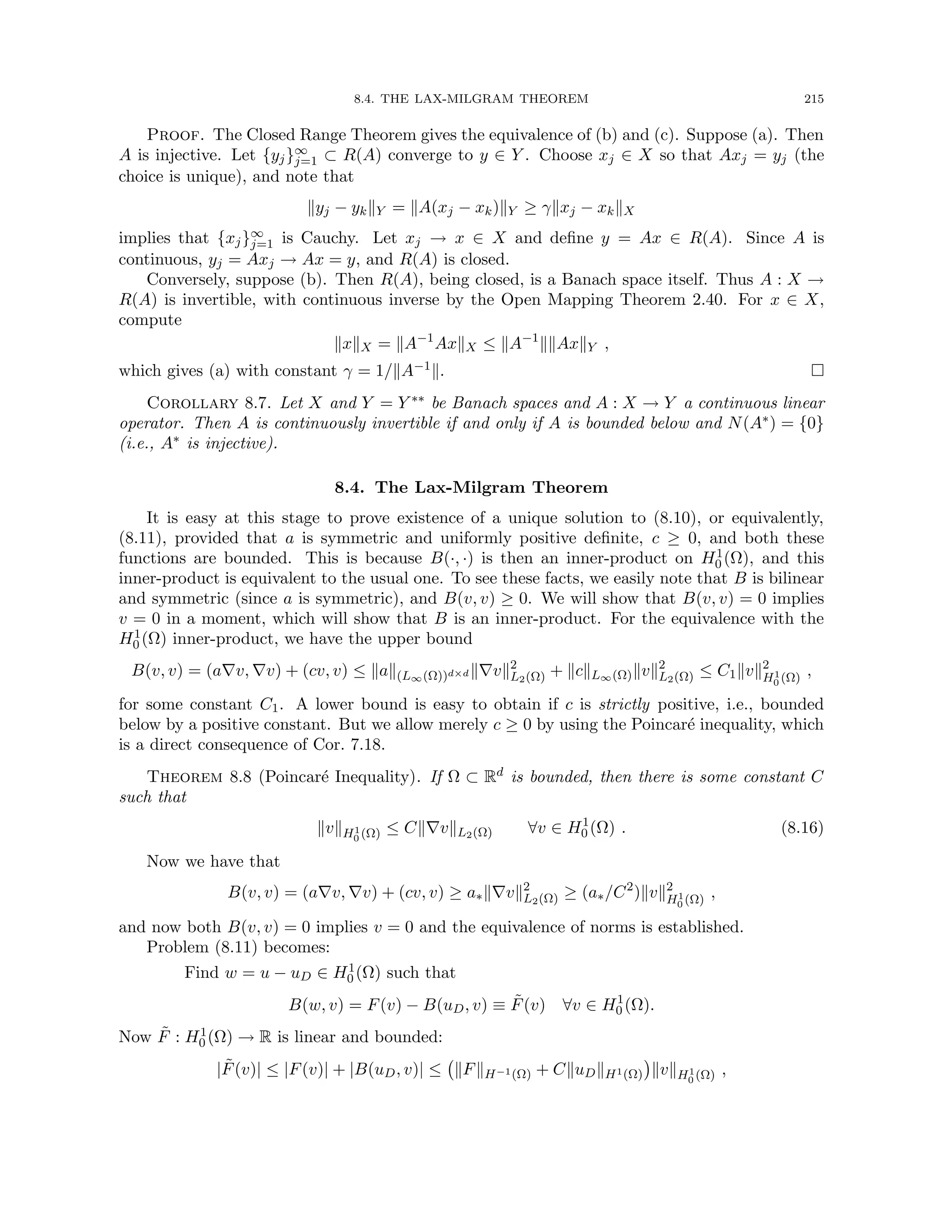
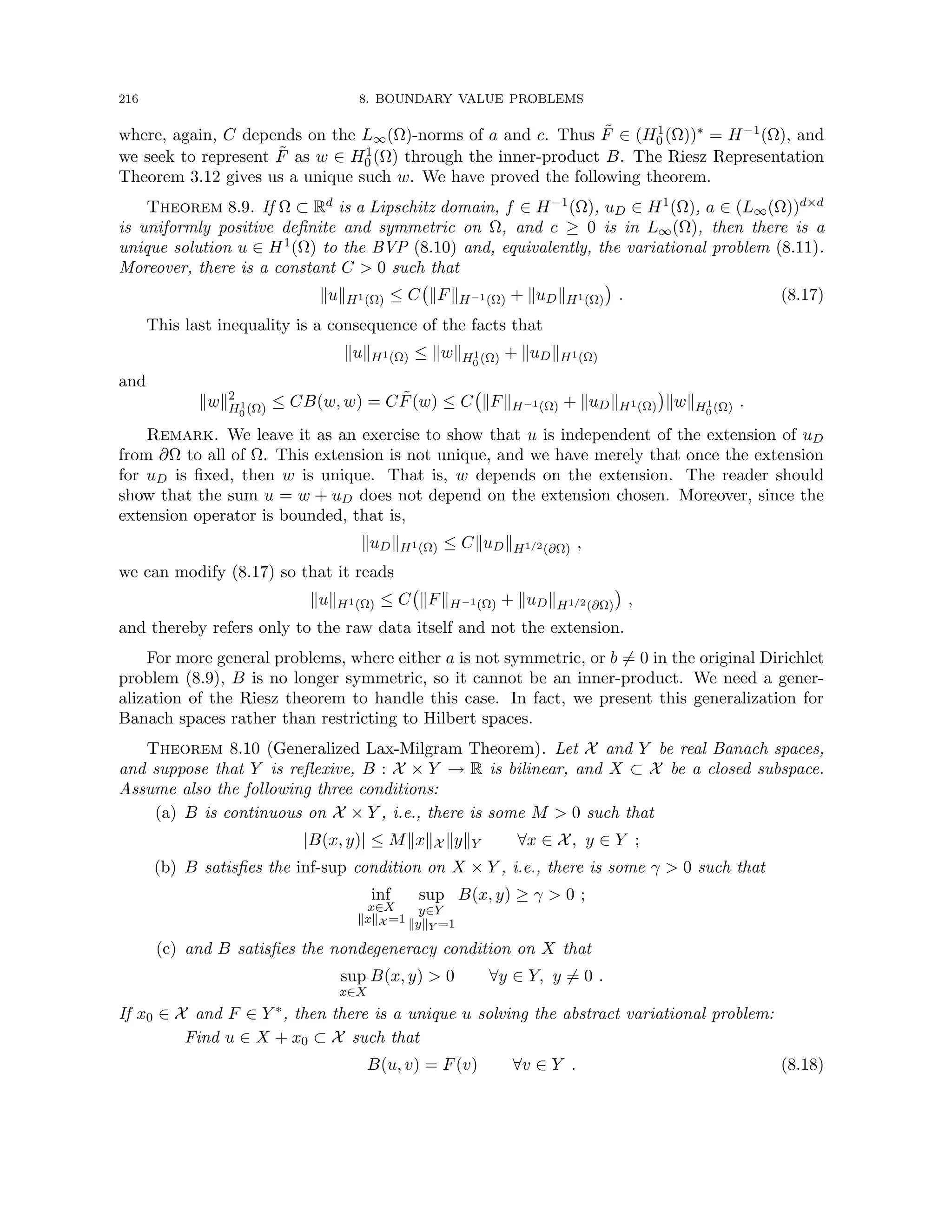
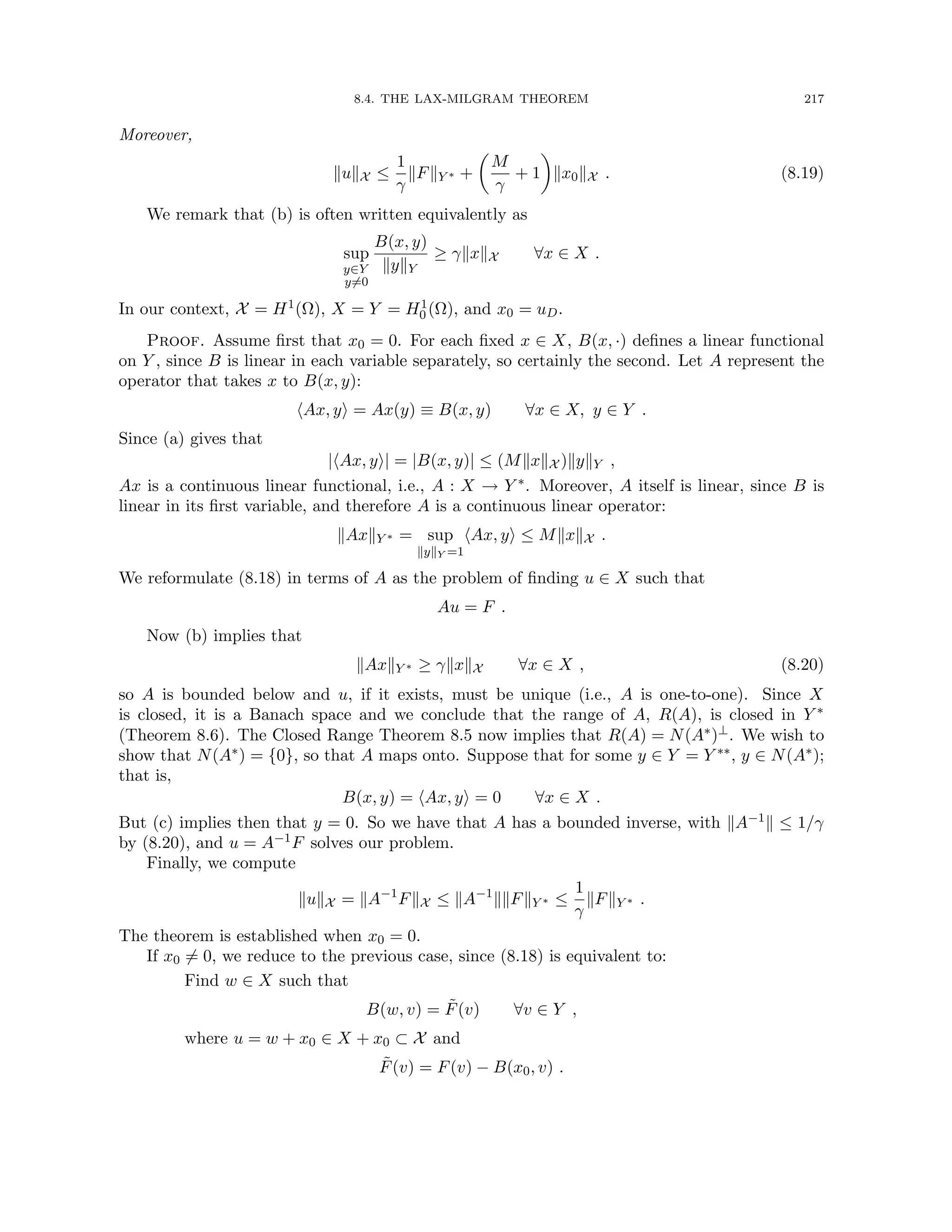
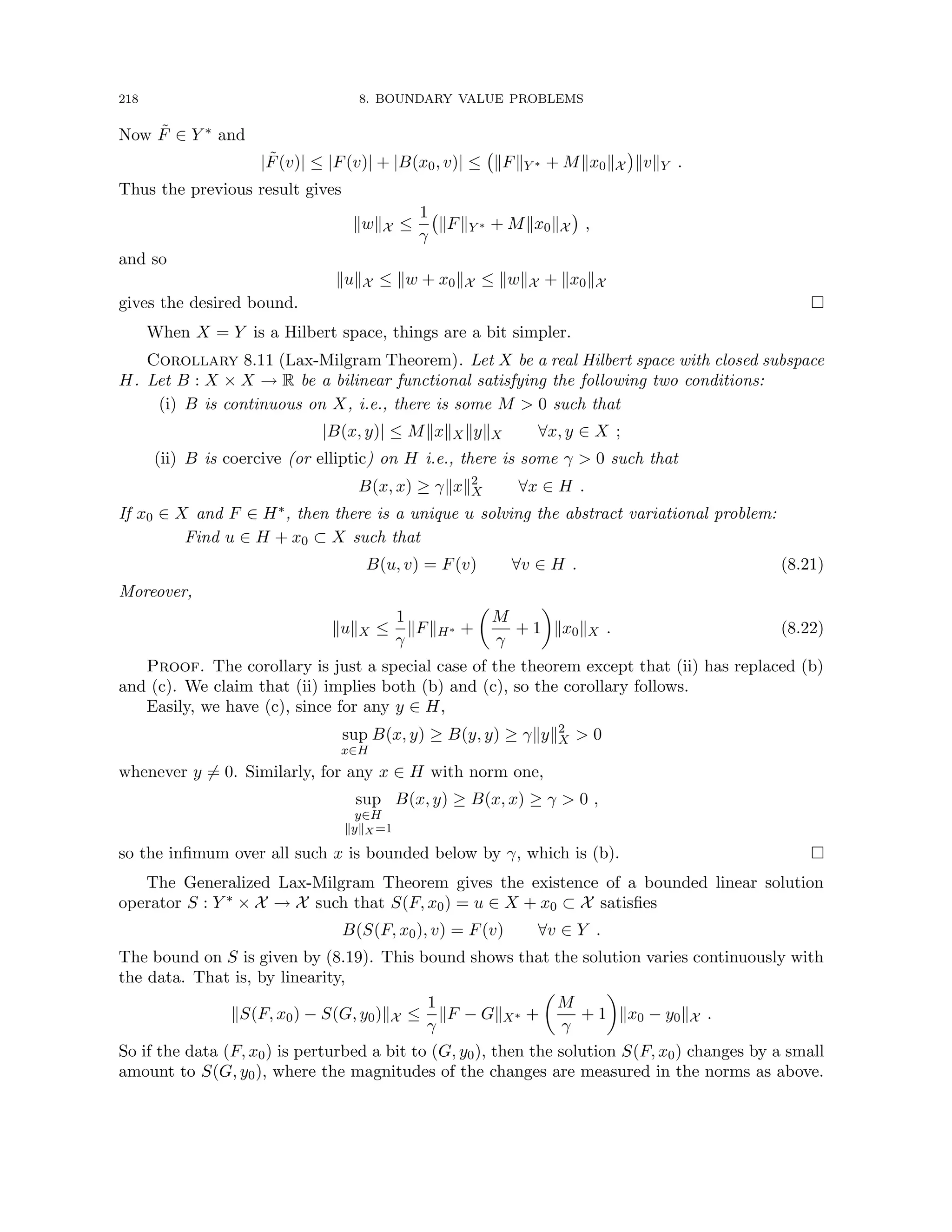

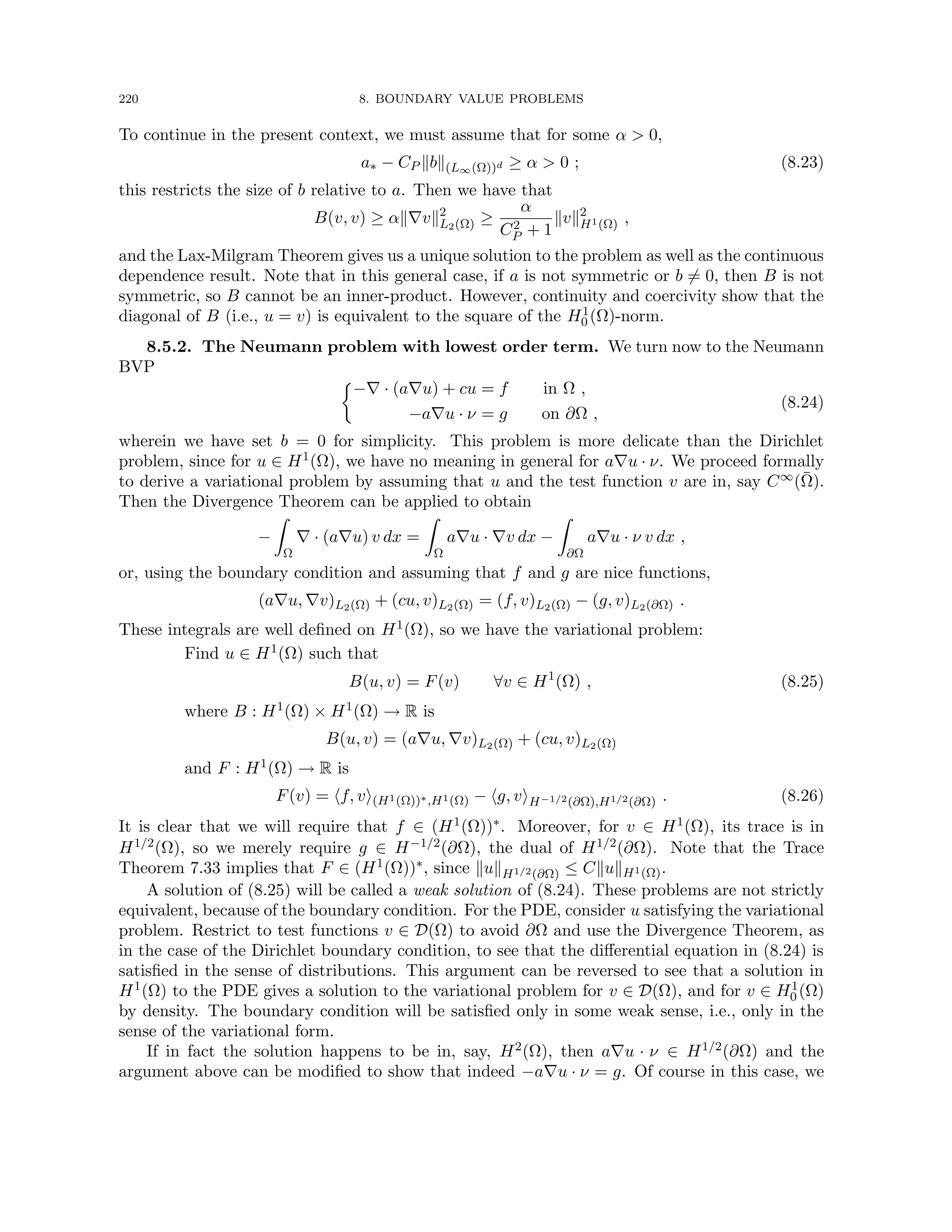
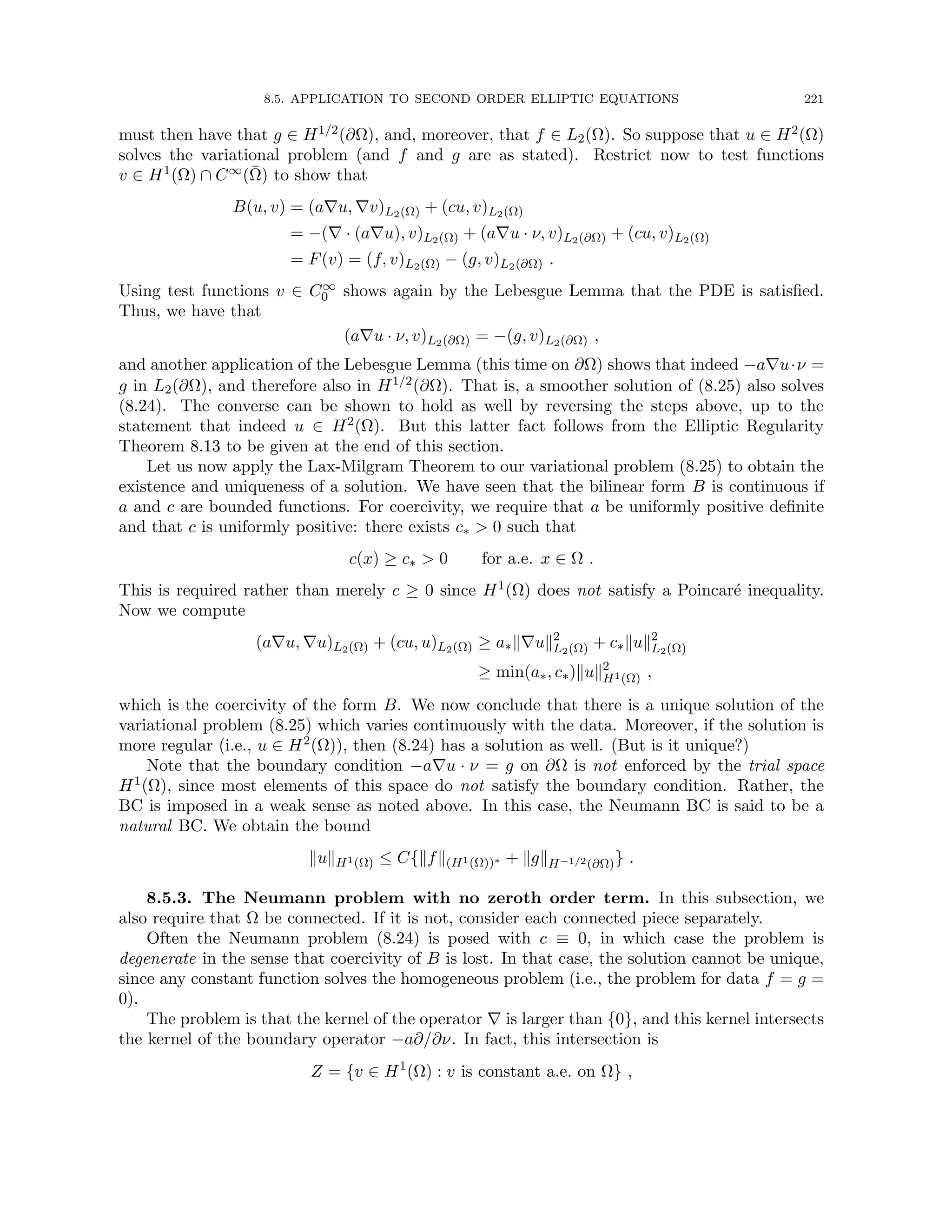
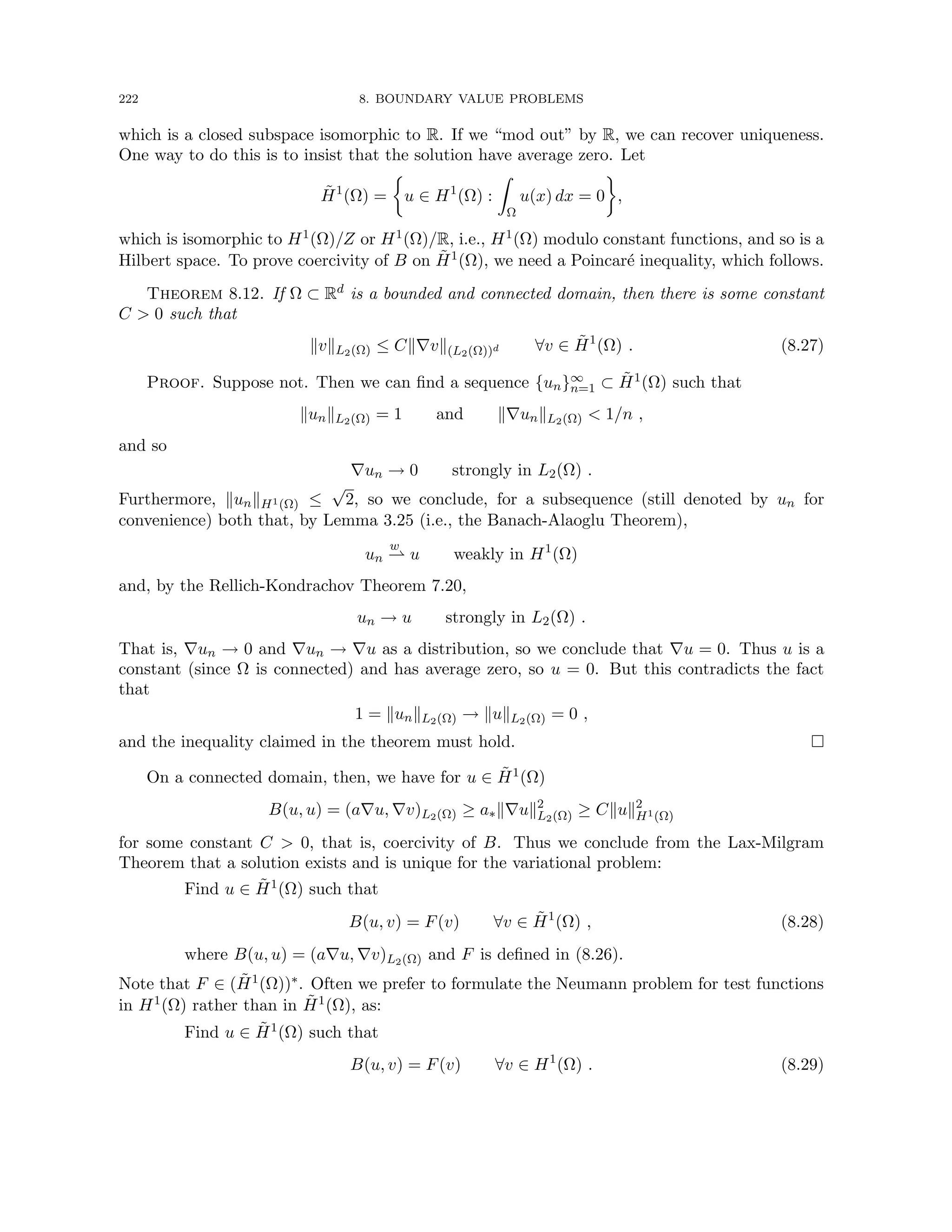
![8.5. APPLICATION TO SECOND ORDER ELLIPTIC EQUATIONS 223
In that case, for any α ∈ R,
B(u, v + α) = B(u, v) ,
so if we have a solution u ∈ H̃1(Ω), then also
F(v) = B(u, v) = B(u, v + α) = F(v + α) = F(v) + F(α)
implies that F(α) = 0 is required. That is, R ⊂ ker(F). This condition is called a compatibility
condition, and it says that the kernel of B(u, ·) is contained in the kernel of F; that is, f and g
must satisfy
hf, 1i(H1(Ω))∗,H1(Ω) − hg, 1iH−1/2(Ω),H1/2(Ω) = 0 ,
which is to say
Z
Ω
f(x) dx =
Z
∂Ω
g(x) dσ(x) ,
provided that f and g are integrable.
The compatibility condition arises from enlarging the space of test functions from H̃1(Ω) to
H1(Ω), which is necessary to prove that the solution to the variational problem also solves the
BVP. In abstract terms, we have the following situation. The problem is naturally posed for u
and v in a Hilbert space X. However, there is nonuniqueness because the set Y = {u ∈ X :
B(u, v) = 0 ∀v ∈ X} = {v ∈ X : B(u, v) = 0 ∀u ∈ X} is contained in the kernel of the natural
BC. But the problem is well behaved when posed over X/Y , which requires F|Y = 0, i.e., the
compatibility condition.
8.5.4. Elliptic regularity. We close this section with an important result from the theory
of elliptic PDE’s. See, e.g., [GT] or [Fo] for a proof. This result can be used to prove the
equivalence of the BVP and the variational problem in the case of Neumann BC’s.
Theorem 8.13 (Elliptic Regularity). Suppose that k ≥ 0 is an integer, Ω ⊂ Rd is a bounded
domain with a Ck+1,1(Ω)-boundary, a ∈ (Wk+1,∞(Ω))d×d is uniformly positive definite, b ∈
(Wk+1,∞(Ω))d, and c ∈ Wk,∞(Ω) is nonnegative. Suppose also that the bilinear form B :
H1(Ω) × H1(Ω) → R,
B(u, v) = (a∇u, ∇v)L2(Ω) + (bu, ∇v)L2(Ω) + (cu, v)L2(Ω) ,
is continuous and coercive on X, for X given below.
(a) If f ∈ Hk(Ω), uD ∈ Hk+2(Ω), and X = H1
0 (Ω), then the Dirichlet problem:
Find u ∈ H1
0 (Ω) + uD such that
B(u, v) = (f, v)L2(Ω) ∀v ∈ H1
0 (Ω) , (8.30)
has a unique solution u ∈ Hk+2(Ω) satisfying, for constant C 0 independent of f, u,
and uD,
kukHk+2(Ω) ≤ C kfkHk(Ω) + kuDkHk+3/2(∂Ω)
.
Moreover, k = −1 is allowed in this case, provided c ∈ W0,∞(Ω).
(b) If f ∈ Hk(Ω), g ∈ Hk+1/2(∂Ω), and X = H1(Ω), then the Neumann problem:
Find u ∈ H1(Ω) such that
B(u, v) = (f, v)L2(Ω) − (g, v)L2(∂Ω) ∀v ∈ H1
(Ω) , (8.31)](https://image.slidesharecdn.com/appliedmathematicsmethods-230215152718-28efe5ed/75/applied-mathematics-methods-pdf-223-2048.jpg)

![8.6. GALERKIN APPROXIMATIONS 225
(We remark that in some cases B gives an inner-product, so in that case this relation says that
the error u−un is B-orthogonal to Hn; thus, this relation is referred to as Galerkin orthogonality.)
Replace vn by (u − un) − (u − vn) ∈ Hn for any vn ∈ Hn to obtain that
B(u − un, u − un) = B(u − un, u − vn) ∀vn ∈ Hn . (8.35)
Thus,
γku − unk2
H ≤ B(u − un, u − un) = B(u − un, u − vn) ≤ Mku − unkHku − vnkH ,
and (8.33) follows. If B is symmetric, then B is an inner-product, and the Cauchy-Schwarz
inequality applied to (8.35) gives
ku − unk2
B = B(u − un, u − un) = B(u − un, u − vn) ≤ ku − unkBku − vnkB ,
and (8.34) follows.
Finally, since
∞
[
n=0
Hn is dense in H, there are φn ∈ Hn such that φn → u in H as n → ∞.
Then
ku − unkH ≤
M
γ
inf
vn∈Hn
ku − vnkH ≤
M
γ
ku − φnkH ,
so un → u in H as n → ∞.
If (8.32) represents the equation for the critical point of an energy functional J : H → R,
then for any n,
inf
vn∈Hn
J(vn) = J(un) ≥ J(u) = inf
v∈H
J(v) .
That is, we find the function with minimal energy in the space Hn to approximate u. In this
minimization form, the method is called a Ritz method.
In the theory of finite element methods, one attempts to define explicitly the spaces Hn ⊂ H
in such a way that the equations (8.32) can be solved easily and so that the optimal error
inf
vn∈Hn
ku − vnkH
is quantifiably small. Such Galerkin finite element methods are extremely effective for computing
approximate solutions to elliptic BVP’s, and for many other types of equations as well. We now
present a simple example.
Example. Suppose that Ω = (0, 1) ⊂ R and f ∈ L2(0, 1). Consider the BVP
(
−u00
= f on (0, 1) ,
u(0) = u(1) = 0 .
(8.36)
The equivalent variational problem is:
Find u ∈ H1
0 (0, 1) such that
(u0
, v0
)L2 = (f, v)L2 ∀v ∈ H1
0 (0, 1) . (8.37)
We now construct a suitable finite element decomposition of H1
0 (0, 1). Let n ≥ 1 be an
integer, and define h = hn = 1/n and a grid xi = ih for i = 0, 1, ..., n of spacing h. Let
Hn = Hh = {v ∈ C0
(0, 1) : v(0) = v(1) = 0 and v(x) is a first degree
polynomial on [xi−1, xi] for i = 1, 2, ..., n} ;
that is, Hh consists of the continuous, piecewise linear functions. Note that Hh ⊂ H1
0 (0, 1), and
Hh is a finite dimensional vector space. We leave it to the reader to show that the closure of](https://image.slidesharecdn.com/appliedmathematicsmethods-230215152718-28efe5ed/75/applied-mathematics-methods-pdf-225-2048.jpg)
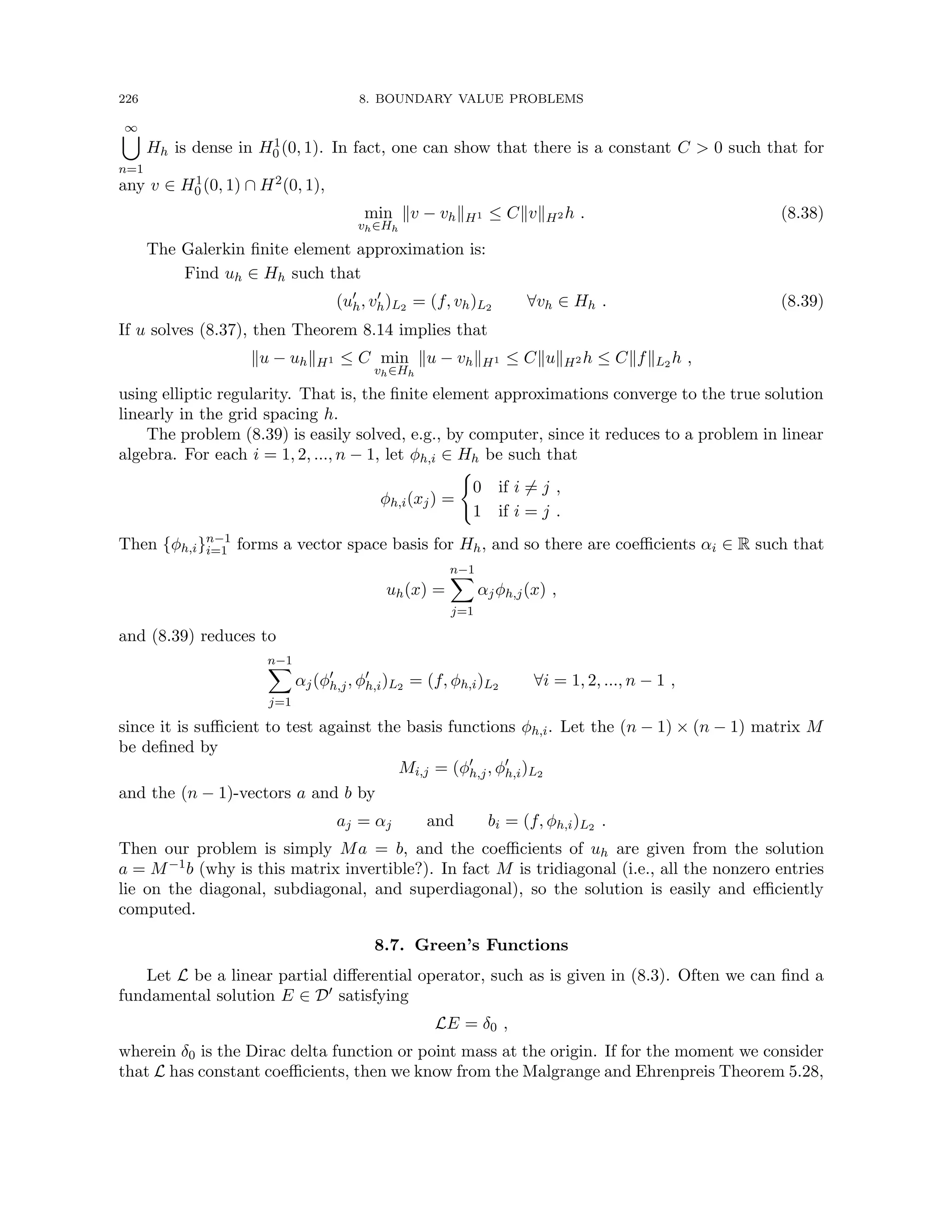
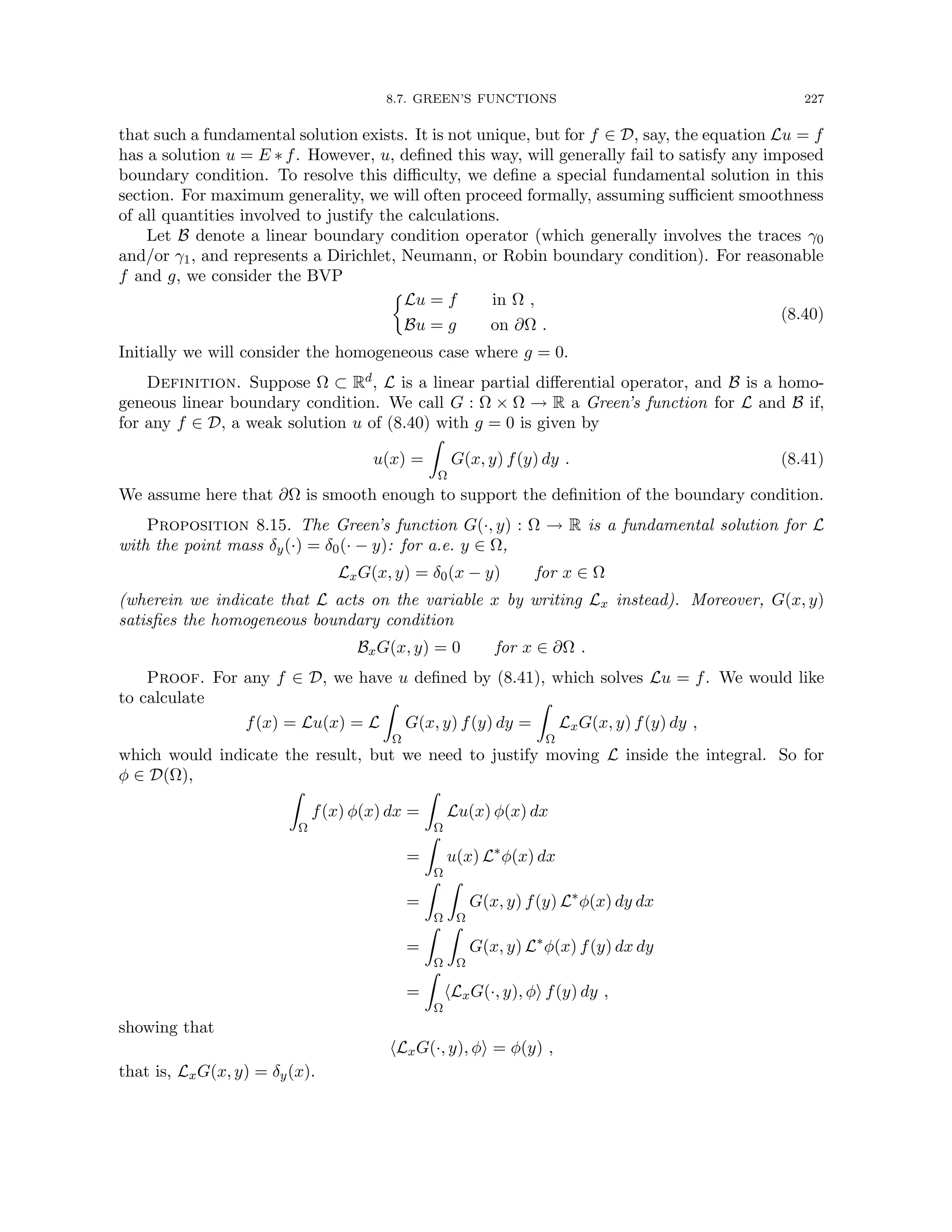

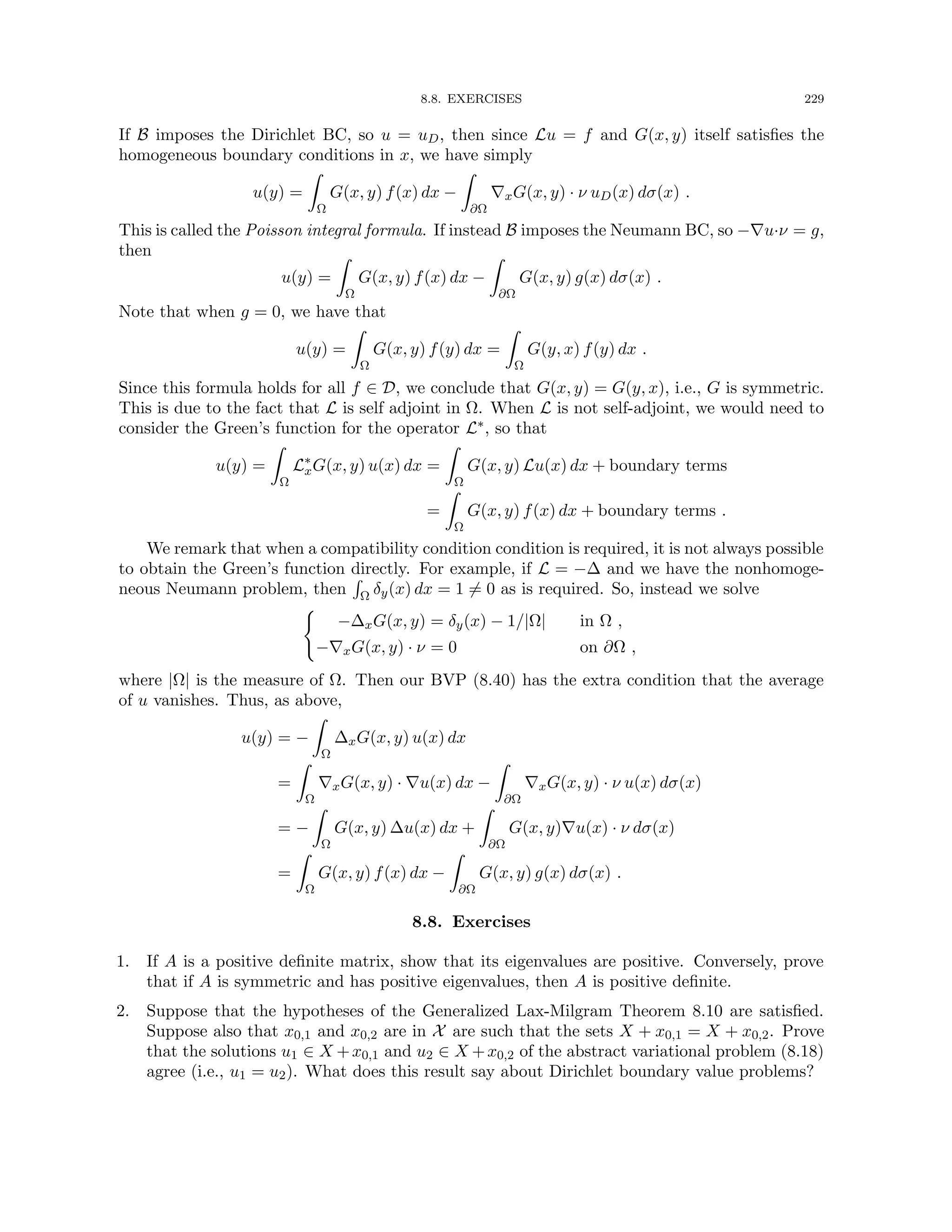
![230 8. BOUNDARY VALUE PROBLEMS
3. Suppose that we wish to find u ∈ H2(Ω) solving the nonlinear problem −∆u + cu2 = f ∈
L2(Ω), where Ω ⊂ Rd is a bounded Lipschitz domain. For consistency, we would require
that cu2 ∈ L2(Ω). Determine the smallest p such that if c ∈ Lp(Ω), you can be certain that
this is true, if indeed it is possible. The answer depends on d.
4. Suppose Ω ⊂ Rd is a connected Lipschitz domain and V ⊂ Ω has positive measure. Let
H = {u ∈ H1(Ω) : u|V = 0}.
(a) Why is H a Hilbert space?
(b) Prove the following Poincaré inequality: there is some C 0 such that
kukL2(Ω) ≤ Ck∇ukL2(Ω) ∀u ∈ H .
5. Suppose that Ω ⊂ Rd is a smooth, bounded, connected domain. Let
H =
u ∈ H2
(Ω) :
Z
Ω
u(x) dx = 0 and ∇u · ν = 0 on ∂Ω
.
Show that H is a Hilbert space, and prove that there exists C 0 such that for any u ∈ H,
kukH1(Ω) ≤ C
X
|α|=2
kDα
ukL2(Ω) .
6. Suppose Ω ⊂ Rd is a C1,1 domain. Consider the biharmonic BVP
∆2
u = f in Ω ,
∇u · ν = g on ∂Ω ,
u = uD on ∂Ω ,
wherein ∆2u = ∆∆u is the application of the Laplace operator twice.
(a) Determine appropriate Sobolev spaces within which the functions u, f, g, and uD should
lie, and formulate an appropriate variational problem for the BVP. Show that the two prob-
lems are equivalent.
(b) Show that there is a unique solution to the variational problem. [Hint: use the Elliptic
Regularity Theorem to prove coercivity of the bilinear form.]
(c) What would be the natural BC’s for this partial differential equation?
(d) For simplicity, let uD and g vanish and define the energy functional
J(v) =
Z
Ω
|∆v(x)|2
− 2f(x) v(x)
dx ,
Prove that minimization of J is equivalent to the variational problem.
7. Suppose Ω ⊂ Rd is a bounded Lipschitz domain. Consider the Stokes problem for vector u
and scalar p given by
−∆u + ∇p = f in Ω ,
∇ · u = 0 in Ω ,
u = 0 on ∂Ω ,
where the first equation holds for each coordinate (i.e., −∆uj + ∂p/∂xj = fj for each
j = 1, ..., d). This problem is not a minimization problem; rather, it is a saddle-point
problem, in that we minimize some energy subject to the constraint ∇ · u = 0. However, if](https://image.slidesharecdn.com/appliedmathematicsmethods-230215152718-28efe5ed/75/applied-mathematics-methods-pdf-230-2048.jpg)
![8.8. EXERCISES 231
we work over the constrained space, we can handle this problem by the ideas of this chapter.
Let
H = {v ∈ (H1
0 (Ω))d
: ∇ · u = 0} .
(a) Verify that H is a Hilbert space.
(b) Determine an appropriate Sobolev space for f, and formulate an appropriate variational
problem for the constrained Stokes problem.
(c) Show that there is a unique solution to the variational problem.
8. Use the Lax-Milgram Theorem to show that, for f ∈ L2(Rd), there exists a unique solution
u ∈ H1(Rd) to the problem
−∆u + u = f in Rd
.
Be careful to justify integration by parts. [Hint: D is dense in H1(Rd).]
9. Consider the boundary value problem for u(x, y) : R2 → R such that
− uxx + ey
u = f , for (x, y) ∈ (0, 1)2
,
u(0, y) = 0, u(1, y) = cos(y) , for y ∈ (0, 1) .
Rewrite this as a variational problem and show that there exists a unique solution. Be sure
to define your function spaces carefully and identify where f must lie.
10. Let Ω ⊂ Rd be a bounded domain with a Lipschitz boundary, f ∈ L2(Ω), and α 0.
Consider the Robin boundary value problem
−∆u + u = f in Ω ,
∂u
∂ν
+ α u = 0 on ∂Ω .
(a) For this problem, formulate a variational principle
B(u, v) = (f, v) ∀v ∈ H1
(Ω) .
(b) Show that this problem has a unique weak solution.
11. Let Ω = [0, 1]d, define
H1
#(Ω) =
v ∈ H1
loc(Rd
) : v is periodic of period 1 in each direction and
Z
Ω
v dx = 0
,
and consider the problem of finding a periodic solution u ∈ H1
#(Ω) of
−∆u = f on Ω ,
where f ∈ L2(Ω).
(a) Define precisely what it means for v ∈ H1(Rd) to be periodic of period 1 in each direction.
(b) Show that H1
#(Ω) is a Hilbert space.
(c) Show that there is a unique solution to the partial differential equation.
12. Consider
B(u, v) = (a∇u, ∇v)L2(Ω) + (bu, ∇v)L2(Ω) + (cu, v)L2(Ω)
(a) Derive a condition on b to insure that B is coercive on H1(Ω) when a is uniformly positive
definite and c is uniformly positive.](https://image.slidesharecdn.com/appliedmathematicsmethods-230215152718-28efe5ed/75/applied-mathematics-methods-pdf-231-2048.jpg)
![232 8. BOUNDARY VALUE PROBLEMS
(b) Suppose b = 0. If c 0, is B not coercive? Show that this is true on H1(Ω), but that
by restricting how negative c may be, B is still coercive on H1
0 (Ω).
13. Modify the statement of Theorem 8.14 to allow for nonhomogeneous essential boundary
conditions, and prove the result.
14. Let Ω ∈ Rd have a smooth boundary, Vn be the set of polynomials of degree up to n, for
n = 1, 2, ..., and f ∈ L2(Ω). Consider the problem: Find un ∈ Vn such that
(∇un, ∇vn)L2(Ω) + (un, vn)L2(Ω) = (f, vn)L2(Ω) for all vn ∈ Vn.
(a) Show that there exists a unique solution for any n, and that
kunkH1(Ω) ≤ kfkL2(Ω).
(b) Show that there is u ∈ H1(Ω) such that un
w
* u weakly in H1(Ω). Find a variational
problem satisfied by u. Justify your answer.
(c) Show that ku − unkH1(Ω) decreases monotonically to 0 as n → ∞.
(d) What can you say about u and ∇u · ν on ∂Ω?
15. Consider the finite element method in Section 8.6.
(a) Modify the method to account for nonhomogeneous Neumann conditions.
(b) Modify the method to account for nonhomogeneous Dirichlet conditions.
16. Compute explicitly the finite element solution to (8.36) using f(x) = x2(1 − x) and n = 4.
How does this approximation compare to the true solution?
17. Let Hh be the set of continuous piecewise linear functions defined on the grid xj = jh,
where h = 1/n for some integer n 0. Let the interpolation operator Ih : H1
0 (0, 1) → Hh
be defined by
Ihv(xj) = v(xj) ∀j = 1, 2, ..., n − 1 .
(a) Show that Ih is well defined, and that it is continuous. [Hint: use the Sobolev Imbedding
Theorem.]
(b) Show that there is a constant C 0 independent of h such that
kv − IhvkH1(xj−1,xj) ≤ CkvkH2(xj−1,xj)h .
[Hint: change variables so that the domain becomes (0, 1), where the result is trivial by
Poincaré’s inequality Corollary 7.18 and Theorem 8.12.]
(c) Show that (8.38) holds.
18. Consider the problem (8.36).
(a) Find the Green’s function.
(b) Instead impose Neumann BC’s, and find the Green’s function. [Hint: recall that now we
require −(∂2/∂x2)G(x, y) = δy(x) − 1.]](https://image.slidesharecdn.com/appliedmathematicsmethods-230215152718-28efe5ed/75/applied-mathematics-methods-pdf-232-2048.jpg)
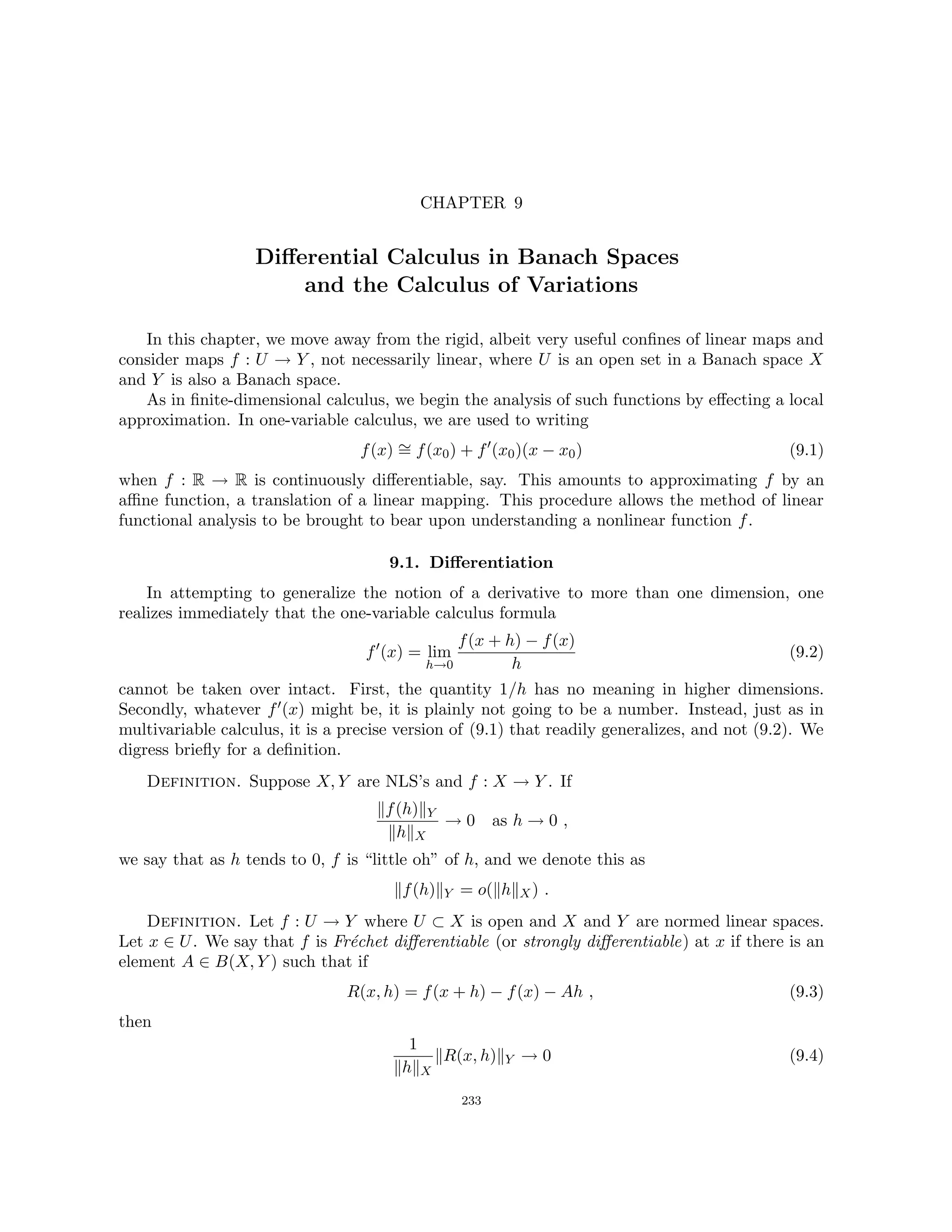

![9.1. DIFFERENTIATION 235
In fact, we have much more than mere continuity. The following result is often useful. It
says that when f is differentiable, it is locally Lipschitz.
Lemma 9.2 (Local-Lipschitz property). If f : U → Y is differentiable at x ∈ U, then given
ε 0, there is a δ = δ(x, ε) 0 such that for all h with khkX ≤ δ,
kf(x + h) − f(x)kY ≤
kDf(x)kB(X,Y ) + ε
khkX . (9.6)
Proof. Simply write
f(x + h) − f(x) = R(x, h) + Df(x)h . (9.7)
Since f is differentiable at x, given ε 0, there is a δ 0 such that khkX ≤ δ implies
kR(x, h)kY
khkX
≤ ε .
Then (9.7) implies the advertised results.
Examples. 1. If f(x) = Ax, where A ∈ B(X, Y ), then f(x+h)−f(x) = Ah, so f is Fréchet
differentiable everywhere and
Df(x) = A
for all x ∈ X.
2. Let X = H be a Hilbert-space over R. Let f(x) = (x, Ax)H where A ∈ B(H, H). Then,
f : H → R and
f(x + h) − f(x) = (x, Ah)H + (h, Ax)H + (h, Ah)H
=
(A∗
+ A)x, h
H
+ (h, Ah)H .
Hence if we define, for x, h ∈ X,
Df(x)h =
(A∗
+ A)x, h
H
,
then
kf(x + h) − f(x) − Df(x)hkY ≤ khk2
XkAkB(X,Y ) .
Thus Df(x) ∈ H∗ = B(H, R) is the Riesz-map associated with the element (A∗ + A)x.
3. Let f : Rn → R and suppose f ∈ C1(Rn), which is to say ∂if exists and is continuous on
Rn, 1 ≤ i ≤ n. Then Df(x) ∈ B(Rn, R) is defined by
Df(x)h = ∇f(x) · h .
4. Let f : Rn → Rm and suppose f ∈ C1(Rn, Rm), which is to say each of the component
functions f = (f1, . . . , fm) as a R-valued function, having all its first partial derivatives, and
each of these is continuous. Then f is Fréchet differentiable and
Df(x)h = [∂jfi(x)]h ,
where the latter is matrix multiplication and the matrix itself is the usual Jacobian matrix.
That is, Df(x) ∈ B(Rn, Rm) is an m × n matrix, and the ith component of Df(x)h is
n
X
j=1
∂jfi(x)hj .](https://image.slidesharecdn.com/appliedmathematicsmethods-230215152718-28efe5ed/75/applied-mathematics-methods-pdf-235-2048.jpg)
![236 9. DIFFERENTIAL CALCULUS IN BANACH SPACES AND THE CALCULUS OF VARIATIONS
5. Let ϕ ∈ Lp(Rd), where p ≥ 1, p an integer, and define
f(ϕ) =
Z
Rd
ϕp
(x) dx .
Then f : Lp(Rd) → R, f is Fréchet differentiable and
Df(ϕ)h = p
Z
Rd
ϕp−1
(x)h(x) dx .
To see this, we use the Binomial Theorem:
f(ϕ + h) − f(ϕ) =
Z
Rd
[(ϕ + h)p
(x) − ϕp
(x)] dx
=
Z
Rd
ϕp
(x) + pϕp−1
(x)h(x) +
p
2
ϕp−2
(x)h2
(x) + ... + hp
(x) − ϕp
(x)
dx
= p
Z
Rd
ϕp−1
(x) h(x) dx +
Z
Rd
p
2
ϕp−2
(x) h2
(x) + ... + hp
(x)
dx .
There is a differentiability notion weaker than Fréchet differentiable, but still occasionally
useful. In this conception, we only ask the function f to be differentiable in a specified direction.
Let h ∈ X and consider the Y -valued function of the real variable t:
g(t) = f(x + th) .
Definition. Suppose f : X → Y . Then f is Gateaux differentiable (or weakly differentiable)
at x ∈ X in the direction h ∈ X if there is an A ∈ B(X, Y ) such that
1
t
kf(x + th) − f(x) − tAhk → 0
as t → 0. The Gateaux-derivative is denoted by
A = Dhf(x) .
Moreover, f is Gateaux differentiable at x if it is Gateaux differentiable at x in every direction
h ∈ X.
Proposition 9.3. If f is Fréchet differentiable, then it is Gateaux differentiable.
Remark. The converse is not valid. The function f : R2 → R given by
f(x) =
(
0 , if x2 = 0 ,
x3
1/x2 , if x2 6= 0 ,
is not continuous at the origin. For instance f((t, t3)) → 1 as t → 0, but f(0) = 0. However, f
is Gateaux differentiable at (0, 0) in every direction h since
f(th) − f(0)
t
=
f(th)
t
=
(
0 if h2 = 0 ,
t(h3
1/h2) if h2 6= 0 .
The limit as t → 0 exists and is zero, whatever the value of h.
Theorem 9.4 (Chain Rule). Let X, Y, Z be NLS’s and U ⊂ X open, V ⊂ Y open, f : U → Y
and g : V → Z. Let x ∈ U and y = f(x) ∈ V . Suppose g is Fréchet differentiable at y and
f is Gateaux- (respectively, Fréchet-) differentiable at x. Then g ◦ f is Gateaux- (respectively,
Fréchet-) differentiable at x and
D(g ◦ f)(x) = Dg(y) ◦ Df(x) .](https://image.slidesharecdn.com/appliedmathematicsmethods-230215152718-28efe5ed/75/applied-mathematics-methods-pdf-236-2048.jpg)
![9.1. DIFFERENTIATION 237
X
x
h x + h
s
*
-
f
Y
u
y = f(x)
f(x + h)
s
A
A
K
-
g
Z
z = g(f(x))
g(f(x + h))
s
Figure 1. The Chain Rule.
Proof. The proof is given for the case where both maps are Fréchet differentiable. The
proof for the Gateaux case is similar. Write
Rf (x, h) = f(x + h) − f(x) − Df(x)h
and
Rg(y, k) = g(y + k) − g(y) − Dg(y)k .
By assumption,
Rf (x, h)
khk
Y
−
→ 0 as h
X
−
→ 0 (9.8)
and
Rg(y, k)
kkk
Z
−
→ 0 as k
Y
−
→ 0 . (9.9)
Define
u = u(h) = f(x + h) − f(x) = f(x + h) − y . (9.10)
By continuity, u(h) → 0 as h → 0. Now consider the difference
g(f(x + h)) − g(f(x)) = g(f(x + h)) − g(y)
= Dg(y)[f(x + h) − y] + Rg(y, u)
= Dg(y)[Df(x)h + Rf (x, h)] + Rg(y, u)
= Dg(y)Df(x)h + R(x, h) ,
where
R(x, h) = Dg(y)Rf (x, h) + Rg(y, u) .
We must show that R(x, h) = o(khkX) as h → 0. Notice that
kDg(y)Rf (x, h)kZ
khkX
≤ kDg(y)kB(Y,Z)
kRf (x, h)kY
khkX
→ 0 as h → 0
because of (9.8). The second term is slightly more interesting. We are trying to show
kRg(y, u)kZ
khkX
→ 0 (9.11)
as h → 0. This does not follow immediately from (9.9). However, the local-Lipschitz property
comes to our rescue.](https://image.slidesharecdn.com/appliedmathematicsmethods-230215152718-28efe5ed/75/applied-mathematics-methods-pdf-237-2048.jpg)
![238 9. DIFFERENTIAL CALCULUS IN BANACH SPACES AND THE CALCULUS OF VARIATIONS
If u = 0, then Rg(y, u) = 0. If not, then multiply and divide by kukY to reach
kRg(y, u)kZ
khkX
=
kRg(y, u)k
kukY
kukY
khkX
. (9.12)
Let ε 0 be given and suppose without loss of generality that ε ≤ 1. There is a σ 0 such
that if kkkY ≤ σ, then
kRg(y, k)kZ
kkkY
≤ ε . (9.13)
On the other hand, because of (9.6), there is a δ 0 such that khkX ≤ δ implies
ku(h)kY = kf(x + h) − f(x)kY ≤
kDf(x)kB(X,Y ) + 1
khkX ≤ σ (9.14)
(simply choose δ so that δ(kDf(x)kB(X,Y ) + 1) ≤ σ in addition to it satisfying the smallness
requirement in Lemma 9.2). With this choice of δ, if khkX ≤ δ, then (9.12) implies
kRg(y, u)kZ
khkX
≤ ε
kDf(x)kB(X,Y ) + 1
.
The result follows.
Proposition 9.5 (Mean-Value Theorem for Curves). Let Y be a NLS and ϕ : [a, b] → Y be
continuous, where a b are real numbers. Suppose ϕ0(t) exists on (a, b) and that kϕ0(t)kB(R,Y ) ≤
M. Then
kϕ(b) − ϕ(a)kY ≤ M(b − a) . (9.15)
Remark. Every bounded linear operator from R to Y is given by t 7→ ty for some fixed
y ∈ Y . Hence we may identify ϕ0(t) with this element y. Notice in this case that y can be
obtained by the elementary limit
y = ϕ0
(t) = lim
s→0
ϕ(t + s) − ϕ(t)
s
.
Proof. Fix an ε 0 and suppose ε ≤ 1. For any t ∈ (a, b), there is a δt = δ(t, ε) such that
if |s − t| δt, s ∈ (a, b), then
kϕ(s) − ϕ(t)kY (M + ε)|s − t| (9.16)
by the Local-Lipschitz Lemma 9.2. Let
S(t) = Bδt (t) ∩ (a, b) ,
which is open. Then if a ã b̃ b,
[ã, b̃] ⊂
[
t∈[ã,b̃]
S(t) .
Hence by compactness, there is a finite sub-cover, of, say, N intervals, S(ã), S(t2), S(t4), . . . , S(b̃),
where
ã = t0 t2 · · · t2N = b̃ ,
such that also S(t2k+2) ∩ S(t2k) 6= ∅ for all k. Choose points t2k+1 ∈ S(t2k+2) ∩ S(t2k), enrich
the partition to
ã = t0 t1 t2 · · · t2N = b̃ ,](https://image.slidesharecdn.com/appliedmathematicsmethods-230215152718-28efe5ed/75/applied-mathematics-methods-pdf-238-2048.jpg)
![9.1. DIFFERENTIATION 239
and note that
kϕ(tk+1) − ϕ(tk)kY ≤ (M + ε)|tk+1 − tk|
for all k. Hence
kϕ(b̃) − ϕ(ã)kY ≤
2N
X
k=1
kϕ(tk) − ϕ(tk−1)kY
≤ (M + ε)
2N
X
k=1
(tk − tk−1) = (M + ε)(b̃ − ã) .
By continuity, we may take the limit on b̃ → b and ã → a, and the same inequality holds. Since
ε 0 was arbitrary, (9.15) follows.
Remark. The Mean-Value Theorem for curves can be used to give reasonable conditions
under which Gateaux differentiability implies Fréchet differentiability. Here is another corollary
of this result.
Theorem 9.6 (Mean-Value Theorem). Let X, Y be NLS’s and U ⊂ X open. Let f : U → Y
be Fréchet differentiable everywhere in U and suppose the line segment
` = {tx2 + (1 − t)x1 : 0 ≤ t ≤ 1}
is contained in U. Then
kf(x2) − f(x1)kY ≤ sup
x∈`
kDf(x)kB(X,Y )kx2 − x1kX . (9.17)
Proof. Define ϕ : [0, 1] → Y by
ϕ(t) = f((1 − t)x1 + tx2) = f(x1 + t(x2 − x1)) = f(γ(t)) ,
where γ : [0, 1] → X. Certainly ϕ is differentiable on [0, 1] by the chain rule. By Proposition 9.5,
kf(x2) − f(x1)kY = kϕ(1) − ϕ(0)kY ≤ sup
0≤t≤1
kϕ0
(t)kY .
but, the chain rule insures that
ϕ0
(t) = Df(γ(t)) ◦ γ0
(t) = Df(γ(t))(x2 − x1) ,
so
kϕ0
(t)kY ≤ kDf(γ(t))kB(X,Y )kx2 − x1kX
≤ sup
x∈`
kDf(x)kB(X,Y )kx2 − x1kX .
One can generalize the discussion immediately to partial Fréchet differentiability. Suppose
X1, . . . , Xm are NLS’s over F and Y another NLS. Let
X = X1 ⊕ · · · ⊕ Xm
be a direct sum of the Xi’s. Thus, as a point set, X = X1 × · · · × Xm is the Cartesian product,
and the vector-space operations are carried out componentwise. Let the norm be any of the
equivalent functions
kxkX =
m
X
j=1
kxikp
Xi
1/p
= (kx1kX1 , · · · , kxmkXm ) `p
, (9.18)](https://image.slidesharecdn.com/appliedmathematicsmethods-230215152718-28efe5ed/75/applied-mathematics-methods-pdf-239-2048.jpg)
![240 9. DIFFERENTIAL CALCULUS IN BANACH SPACES AND THE CALCULUS OF VARIATIONS
where p ∈ [1, ∞] (modified in the usual way if p = ∞) and x = (x1, . . . , xm), which makes X into
a NLS. It is a Banach space if and only if Xi is a Banach space, 1 ≤ i ≤ m. Conversely, given
a Banach space X, we could decompose it into a direct sum of subspaces Y = X1 ⊕ · · · ⊕ Xm,
with norms k · kXi = k · kX, so that X and Y would be equivalent Banach spaces.
Definition. Let X = X1 ⊕ · · · ⊕ Xm as above. Let U ⊂ X be open and F : U → Y , Y a
NLS. Let x = (x1, . . . , xm) ∈ U and fix an integer k ∈ [1, m]. For z near xk in Xk, the point
(x1, . . . , xk−1, z, xk+1, . . . , xm) lies in U, since U is open. Define
fk(z) = F(x1, . . . , xk−1, z, xk+1, . . . , xm) .
Then fk maps an open subset of Xk into Y . If fk has a Fréchet derivative at z = xk, then we
say F has a kth-partial derivative at x and define
DkF(x) = Dfk(xk) .
Notice that DkF(x) ∈ B(Xk, Y ).
Proposition 9.7. Let X = X1 ⊕ · · · ⊕ Xm be the direct sum of NLS’s, U ⊂ X open, and
F : U → Y , another NLS. Suppose DjF(x) exists for x ∈ U and 1 ≤ j ≤ m, and that these
linear maps are continuous as a function of x at x0 ∈ U. Then F is Fréchet differentiable at x0
and for h = (h1, . . . , hm) ∈ X,
DF(x0)h =
m
X
j=1
DjF(x0)hj . (9.19)
Proof. The right-hand side of (9.19) defines a bounded linear map on X. Indeed, it may
be written as
Ah =
m
X
j=1
DjF(x0) ◦ Πjh
where Πj : X → Xj is the projection on the jth-component. So A is a sum of compositions of
bounded operators and so is itself a bounded operator. Define
R(h) = F(x0 + h) − F(x0) − Ah .
It suffices to show that R : X → Y is such that
R(h)
khkX
→ 0
as h → 0. Let ε 0 be given. Because F is partially Fréchet differentiable and A is linear, it
follows immediately from the chain rule that R is partially Fréchet differentiable in h and
DjR(h) = DjF(x0 + h) − DjF(x0) .
Since the partial Fréchet-derivatives are continuous as a function of x at x0 it follows there is a
δ 0 such that if kh0kX ≤ δ, then
kDjR(h0
)kB(Xj,Y ) ≤ ε for 1 ≤ j ≤ m . (9.20)
On the other hand,
kR(h0
)kY ≤ kR(h0
) − R(0, h0
2, . . . , h0
m)kY + kR(0, h0
2, . . . , h0
m) − R(0, 0, h0
3, . . . , h0
m)kY
+ · · · + kR(0, . . . , 0, h0
m) − R(0, . . . , 0)kY .
(9.21)](https://image.slidesharecdn.com/appliedmathematicsmethods-230215152718-28efe5ed/75/applied-mathematics-methods-pdf-240-2048.jpg)
![9.2. FIXED POINTS AND CONTRACTIVE MAPS 241
Thus, if khkX ≤ δ, then by the Mean-Value Theorem applied to the mappings
Rj(hj) = R(0, . . . , 0, hj, h0
j+1, . . . , h0
m) ,
it is determined on the basis of (9.20) that
kRj(hj) − Rj(0)kY ≤ sup
t∈[0,1]
kDRj(thj)kB(Xj,Y )khjkXj
= sup
t∈[0,1]
kDjR(0, . . . , 0, thj, h0
j+1, . . . , h0
m)kB(Xj,Y )khjkXj
≤ εkhjkXj , for 1 ≤ j ≤ m .
Choosing in (9.18) the `1-norm on X, it follows from (9.21) and the last inequalities that for
kh0kX δ,
kR(h0
)kY ≤ ε
m
X
j=1
khjkXj = εkhkX .
(If another `p-norm is used in (9.18), we merely get a fixed constant multiple of the right-hand
side above.) The result follows.
9.2. Fixed Points and Contractive Maps
Definition. Let (X, d) be a metric space and G : X → X. The mapping G is a contraction
if there is a θ with 0 ≤ θ 1 such that
d(G(x), G(y)) ≤ θd(x, y) for all x, y ∈ X .
A fixed point of the mapping G is an x ∈ X such that x = G(x).
A contraction map is a Lipschitz map with Lipschitz constant less than 1. Such maps are
also continuous.
Theorem 9.8 (Banach Contraction-Mapping Principle). Let (X, d) be a complete metric
space and G a contraction mapping of X. Then there is a unique fixed point of G in X.
Proof. If there were two fixed points x and y, then
d(x, y) = d(G(x), G(y)) ≤ θd(x, y) ,
and since d(x, y) ≥ 0 and 0 ≤ θ 1, it follows that d(x, y) = 0, whence x = y.
For existence of a fixed point, argue as follows. Fix an x0 ∈ X and let x1 = G(x0), x2 = G(x1)
and so on. We claim the sequence {xn}∞
n=0 of iterates is a Cauchy sequence.
If this {xn}∞
n=0 is Cauchy, then since (X, d) is complete, there is an x̄ such that xn → x̄.
But then G(xn) → G(x̄) by continuity. Since G(xn) = xn+1, it follows that G(x̄) = x̄.
To see {xn}∞
n=0 is a Cauchy sequence, first notice that
d(x1, x2) = d(G(x0), G(x1)) ≤ θd(x0, x1) .
Continuing in this manner,
d(xn, xn+1) = d(G(xn−1), G(xn)) ≤ θd(xn−1, xn)
for n = 1, 2, 3, . . . . In consequence, we derive by induction that
d(xn, xn+1) ≤ θn
d(x0, x1) , for n = 0, 1, 2, . . . .](https://image.slidesharecdn.com/appliedmathematicsmethods-230215152718-28efe5ed/75/applied-mathematics-methods-pdf-241-2048.jpg)
![242 9. DIFFERENTIAL CALCULUS IN BANACH SPACES AND THE CALCULUS OF VARIATIONS
Thus, if n ≥ 0 is fixed and m n, then
d(xn, xm) ≤ d(xn, xn+1) + d(xn+1, xn+2) + · · · + d(xm−1, xm)
≤ (θn
+ · · · + θm−1
)d(x0, x1)
= θn
(1 + · · · + θm−n−1
)d(x0, x1)
= θn 1 − θm−n
1 − θ
d(x0, x1)
≤
θn
1 − θ
d(x0, x1) .
As θ 1, the right-hand side of the last inequality can be made as small as desired, independently
of m, by taking n large enough.
Not only does this result provide existence and uniqueness, but the proof is constructive.
Indeed, the proof consists of generating a sequence of approximations to x = G(x).
Corollary 9.9 (Fixed Point Iteration). Suppose that (X, d) be a complete metric space, G
a contraction mapping of X with contraction constant θ, and x0 ∈ X. If the sequence {xn}∞
n=0
is defined successively by xn+1 = G(xn) for n = 0, 1, 2, ..., then xn → x, where x is the unique
fixed point of G in X. Moreover,
d(xn, x) ≤
θn
1 − θ
d(x0, x1) .
Example. Consider the initial value prooblem (IVP)
ut = cos(u(t)) , t 0 ,
u(0) = u0 .
We would like to obtain a solution to the problem, at least up to some final time T 0, using
the fixed point theorem. At the outset we require two things: a complete metric space within
which to seek a solution, and a map on that space for which a fixed point is the solution to our
problem. It is not easy to handle the differential operator directly in this context, so we remove
it through integration:
u(t) = u0 +
Z t
0
cos(u(s)) ds .
Now it is natural to seek a continuous function as a solution, say in X = C0([0, T]), for some as
yet unknown T 0. It is also natural to consider the function
G(u) = u0 +
Z t
0
cos(u(s)) ds ,
which clearly takes X to X and has a fixed point at the solution to our IVP. To see if G is
contractive, consider two functions u and v in X and compute
kG(u) − G(v)kL∞ = sup
0≤t≤T
Z t
0
cos(u(s)) − cos(v(s))
ds
= sup
0≤t≤T
Z t
0
(− sin(w(s))(u(s) − v(s)) ds
≤ Tku − vkL∞ ,](https://image.slidesharecdn.com/appliedmathematicsmethods-230215152718-28efe5ed/75/applied-mathematics-methods-pdf-242-2048.jpg)
![9.2. FIXED POINTS AND CONTRACTIVE MAPS 243
wherein we have used the ordinary mean value theorem for functions of a real variable. So, if
we take T = 1/2, we have a unique solution by the Banach Contraction Mapping Theorem.
Since T is a fixed number independent of the solution u, we can iterate this process, starting at
t = 1/2 (with “initial condition” u(1/2)) to extend the solution uniquely to t = 1, and so on, to
obtain a solution for all time.
Example. Let κ ∈ L1(R), ϕ ∈ CB(R) and consider the nonlinear operator
Φu(x, t) = ϕ(x) +
Z t
0
Z ∞
−∞
κ(x − y)(u(y, s) + u2
(y, s)) dy ds .
We claim that there exists T = T(kϕk∞) 0 such that Φ has a fixed point in the space
X = CB(R × [0, T]).
Since κ is in L1(R), Φu makes sense. If u ∈ CB(R), then it is an easy exercise to see Φu ∈ X.
Indeed, Φu is C1 in the temporal variable and continuous in x by the Dominated Convergence
Theorem. That is, Φ : X → X; however, Φ is not contractive on all of X.
Let R 0 and BR the closed ball of radius R about 0 in X. We want to show if R and T
are chosen well, Φ : BR → BR is a contraction. Let u, v ∈ BR and consider
kΦu − ΦvkX = sup
(x,t)∈R×[0,T]
Z t
0
Z ∞
−∞
κ(x − y)(u − v + u2
− v2
) dy ds
≤ T sup
(x,t)∈R×[0,T]
Z ∞
−∞
|κ(x − y)(u − v + u2
− v2
)| dy
≤ TkκkL1
ku − vkX + ku2
− v2
kX
≤ TkκkL1
1 + kukX + kvkX
ku − vkX
≤ TkκkL1 (1 + 2R)ku − vkX .
Let
θ = T(1 + 2R)kκkL1 ,
choose R = 2kϕkL∞ and then choose T so that θ = 1/2. With these choices, Φ is contractive on
BR and if u ∈ BR, then indeed
kΦukX ≤ kΦu − Φ0kX + kΦ0kX
≤ θku − 0kX + kϕkL∞
≤
1
2
R +
1
2
R = R .
That is, Φ : BR → BR, Φ is contractive, and BR, being closed, is a complete metric space. We
conclude that there exists a unique u ∈ BR such that
u = Φu .
Why do we care? Consider
∂u
∂t
+
∂u
∂x
+ 2u
∂u
∂x
−
∂3u
∂x2∂t
= 0 , (9.22)](https://image.slidesharecdn.com/appliedmathematicsmethods-230215152718-28efe5ed/75/applied-mathematics-methods-pdf-243-2048.jpg)
![244 9. DIFFERENTIAL CALCULUS IN BANACH SPACES AND THE CALCULUS OF VARIATIONS
a nonlinear, dispersive wave equation. Write it as
(1 − ∂2
x)ut = −ux − 2uux ≡ f .
The left-hand side is a nice operator, at least from the point of view of the Fourier Transform,
as we will see in a moment, while the terms defining f are more troublesome. Take the Fourier
transform on x to reach
(1 + ξ2
)ût = ˆ
f , i.e., ût =
1
1 + ξ2
ˆ
f ,
whence, by taking the inverse Fourier transform, it is formally deduced that
ut = κ̃ ∗ f = −κ̃ ∗ (ux + 2uux) = −κ̃ ∗ (u + u2
)x
where
κ̃(x) =
√
2πF−1
1
1 + ξ2
=
1
2
e−|x|
.
Let κ = −κ̃x ∈ L1(R) to conclude
ut(x, t) = κ ∗ (u + u2
) .
Now integrate over [0, t] and use the Fundamental Theorem of Calculus with constant of inte-
gration u(x, 0) = ϕ(x) ∈ CB(R) to reach
u(x, t) = ϕ(x) +
Z t
0
κ ∗ (u + u2
) ds ,
which has the form with which we started the example. Thus our fixed point Φu = u is formally
a solution to (9.22), at least up to the time T, with the initial condition u(x, 0) = ϕ(x).
Corollary 9.10. Let X be a Banach space and f : X → X a differentiable mapping.
Suppose kDf(x)kB(X,X) ≤ κ 1 for x ∈ BR(0). If there is an x0 ∈ BR(0) such that Br(x0) ⊂
BR(0) for some r ≥ kf(x0) − x0k/(1 − κ), then f has a unique fixed point in Br(x0).
That is, a map f which is locally contractive and for which we can find a point not moved
too far by f has a fixed point, and the iteration
x0, x1 = f(x0), x2 = f(x1), · · · ,
generates a sequence that converges to a fixed point.
Proof. In fact, we show that f is a contraction mapping of Br(x0). First, by the Mean-
Value Theorem, for any x, y ∈ BR(0),
kf(x) − f(y)k ≤ κkx − yk .
Hence f is contractive. The Contraction-Mapping Theorem will apply as soon as we know that
f maps Br(x0) into itself, since Br(x0) is a complete metric space. By the triangle inequality, if
x ∈ Br(x0),
kf(x) − x0k ≤ kf(x) − f(x0)k + kf(x0) − x0k
≤ κkx − x0k + (1 − κ)r ≤ r .](https://image.slidesharecdn.com/appliedmathematicsmethods-230215152718-28efe5ed/75/applied-mathematics-methods-pdf-244-2048.jpg)
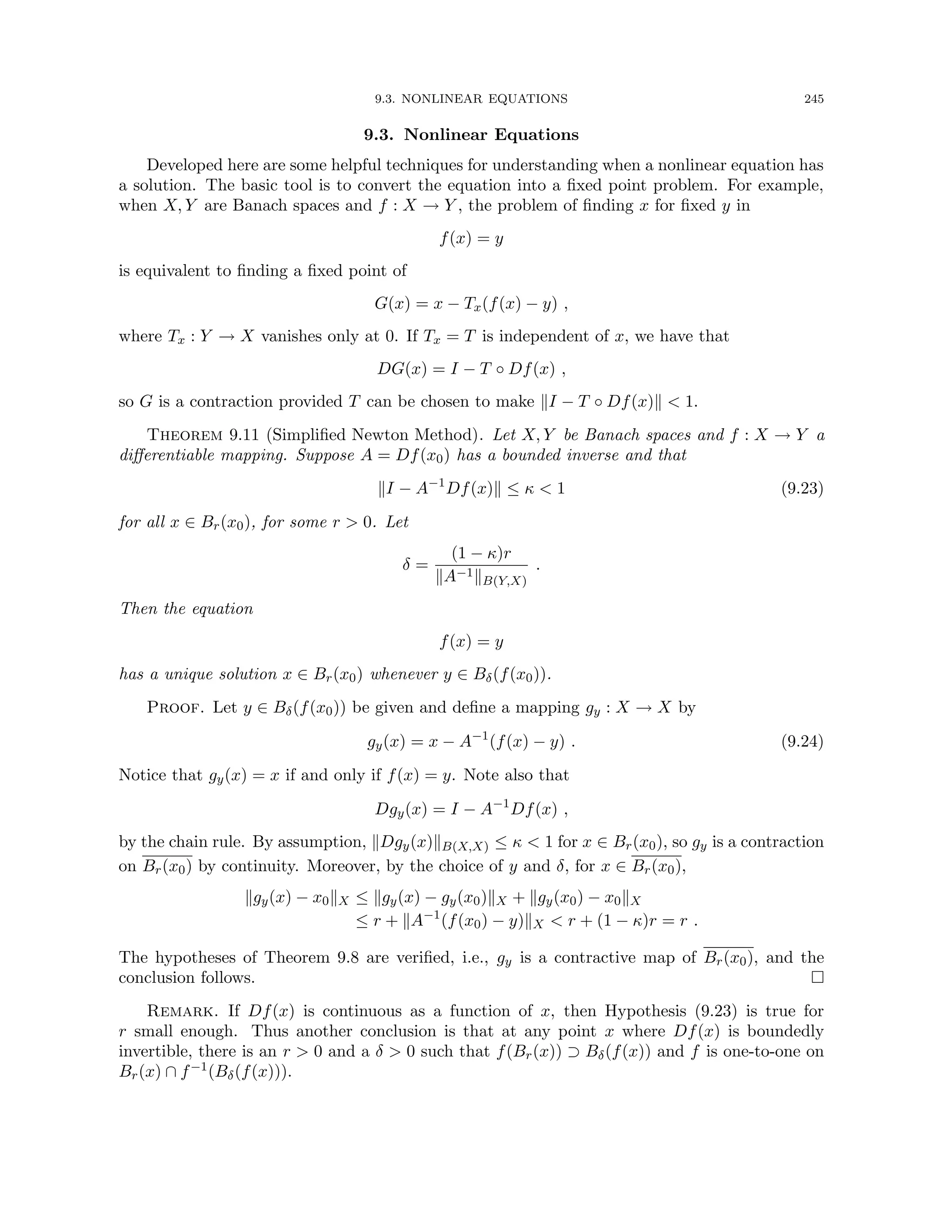
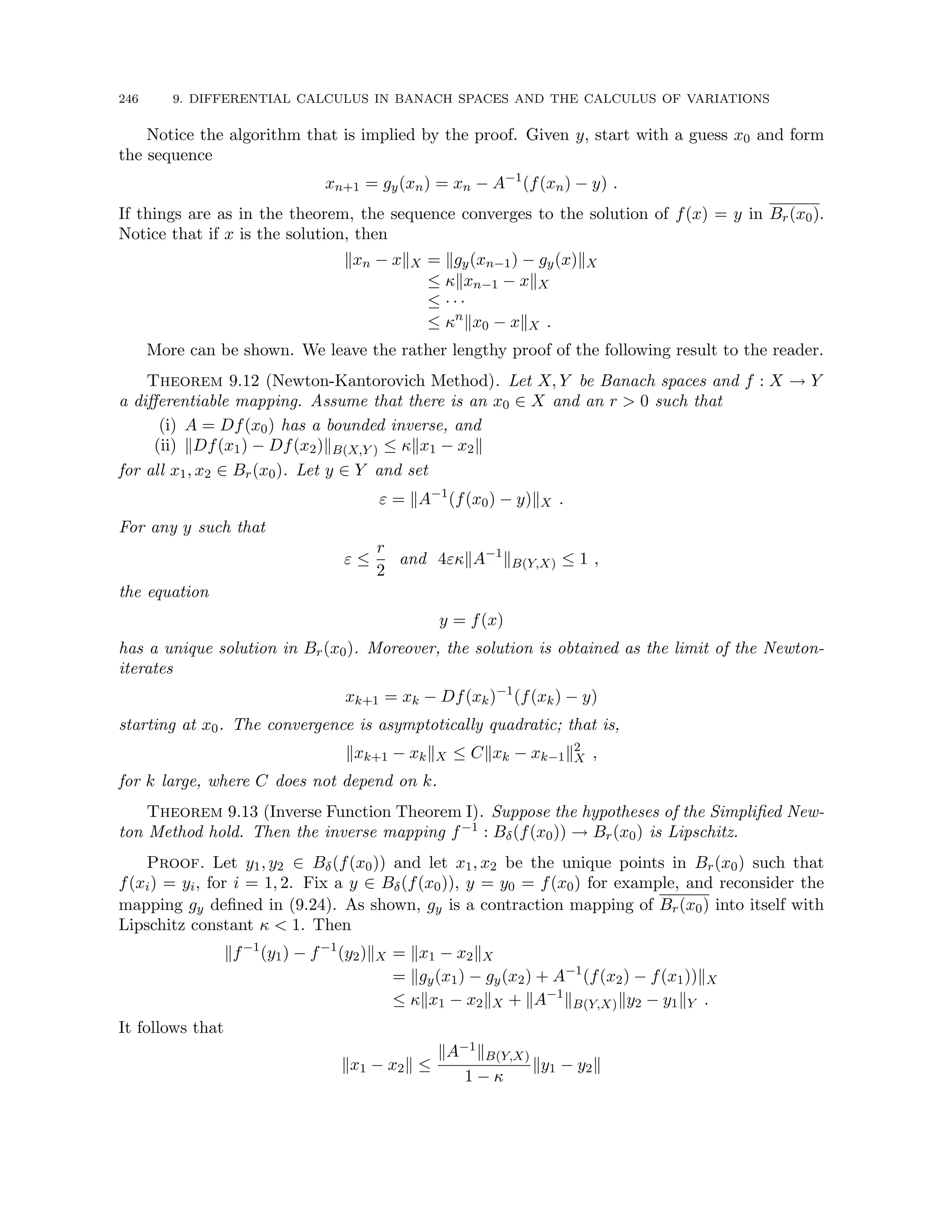
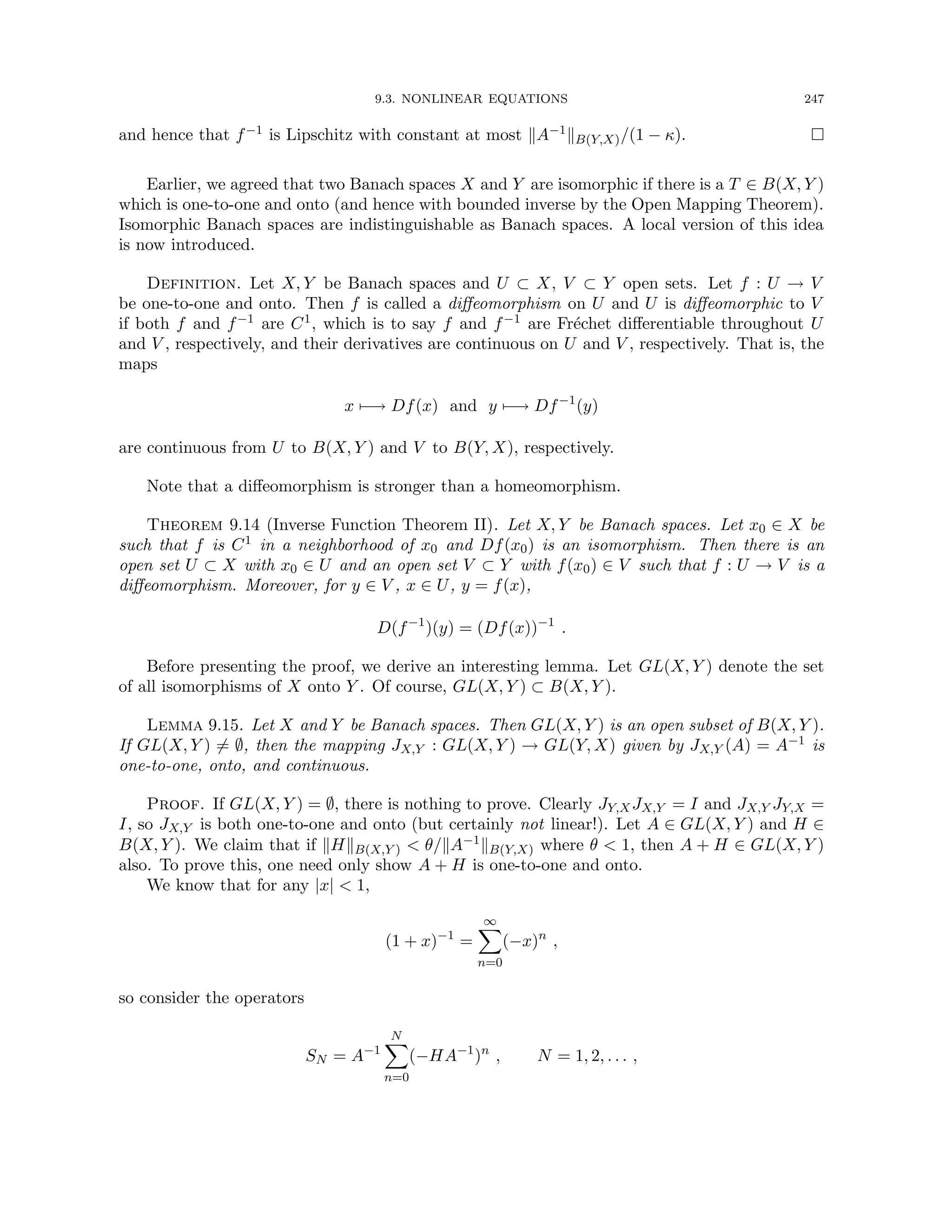
![248 9. DIFFERENTIAL CALCULUS IN BANACH SPACES AND THE CALCULUS OF VARIATIONS
in B(Y, X). The sequence {SN }∞
N=1 is Cauchy in B(Y, X) since, for M N,
kSM − SN kB(Y,X) ≤ kA−1
kB(Y,X)
M
X
n=N+1
k(HA−1
)n
k
≤ kA−1
kB(Y,X)
M
X
n=N+1
(kHkB(X,Y )kA−1
k)n
B(Y,X)
≤ kA−1
kB(Y,X)
M
X
n=N+1
θn
→ 0
(9.25)
as N → +∞. Hence SN → S in B(Y, X). Notice that
(A + H)S = lim
N→∞
(A + H)SN
= lim
N→∞
N
X
n=0
(−HA−1
)n
−
N
X
n=0
(−HA−1
)n+1
= lim
N→∞
[I − (−HA−1
)N+1
] .
But as kHA−1k ≤ θ 1, (HA−1)N → 0 in B(Y, Y ). It is concluded that (A + H)S = I, and a
similar calculation shows S(A+H) = I. Thus A+H is one-to-one and onto, hence in GL(X, Y ).
For use in a moment, notice that kSkB(Y,X) ≤ kA−1kB(Y,X)/(1 − θ), by an argument similar to
(9.25).
For continuity, it suffices to take A ∈ GL(X, Y ) and show that (A+H)−1 → A−1 in B(Y, X)
as H → 0 in B(X, Y ). But, as S = (A+H)−1, this amounts to showing S −A−1 → 0 as H → 0.
Now,
S − A−1
= (SA − I)A−1
= (S(A + H) − SH − I)A−1
= −SHA−1
.
Hence
kS − A−1
kB(Y,X) ≤ kSkB(Y,X)kHkB(X,Y )kA−1
kB(Y,X) → 0
as H → 0 since kA−1kB(Y,X) is fixed and kSkB(Y,X) ≤ kA−1kB(Y,X)/(1 − θ) is bounded indepen-
dently of H.
Proof of the Inverse Function Theorem II. Let A = Df(x0). Since f is a C1-
mapping, Df(x) → A in B(X, Y ) as x → x0 in X, so there is an r0 0 such that
kI − A−1
Df(x)kB(X,X) ≤
1
2
for all x ∈ Br0 (x0).
Because of Lemma 9.15, there is an r00 with 0 r00 ≤ r0 such that Df(x) has a bounded
inverse for all x ∈ Br00 (x0). It is further adduced that Df(x)−1 → A−1 as x → x0. In
consequence, for 0 r ≤ r00, and for x ∈ Br(x0),
kDf(x)−1
kB(Y,X) ≤ 2kA−1
kB(Y,X) .
Appealing now to the Simplified Newton Method, it is concluded that there is an r 0 and a
δ 0 such that f : U → V is one-to-one, and onto, where
V = Bδ(f(x0)) with δ =
r
2kA−1kB(Y,X)](https://image.slidesharecdn.com/appliedmathematicsmethods-230215152718-28efe5ed/75/applied-mathematics-methods-pdf-248-2048.jpg)
![9.3. NONLINEAR EQUATIONS 249
and
U = Br(x0) ∩ f−1
(V ) .
It remains to establish that f−1 is a C1 mapping with the indicated derivative. Suppose it
is known that
Df−1
(y) = Df(x)−1
, when y = f(x) , (9.26)
where x ∈ U and y ∈ V . In this case, the mapping from y to Df−1(y) is obtained in three steps,
namely
y 7−→ f−1
(y) 7−→ Df(f−1
(y)) 7−→ Df(f−1
(y))−1
= Df−1
(y) ,
Y
f−1
−
−
→ X
Df
−
−
→ B(X, Y )
J
−
→ B(Y, X) .
As all three of these components is continuous, so is the composite.
Thus it is only necessary to establish (9.26). To this end, fix y ∈ V and let k be small enough
that y + k also lies in V . If x = f−1(y) and h = f−1(y + k) − x, then
kf−1
(y + k) − f−1
(y) − Df(x)−1
kkX = kh − Df(x)−1
[f(x + h) − f(x)]kX
= kDf(x)−1
[f(x + h) − f(x) − Df(x)h]kX
≤ 2kA−1
kB(Y,X)kf(x + h) − f(x) − Df(x)hkY .
(9.27)
The right-hand side of (9.27) tends to 0 as h → 0 in X since f is differentiable at x. Hence if
we show that h → 0 as k → 0, it follows that f−1 is differentiable at y = f(x) and that
Df−1
(y) = Df(x)−1
.
The theorem is thereby established because of our earlier remarks. But,
khkX = kf−1
(y + k) − f−1
(y)kX ≤ MkkkY ,
since f−1 is Lipschitz (see Theorem 9.13).
Theorem 9.16 (Implicit Function Theorem). Let X, Y, Z be Banach spaces and suppose
f : Z × X → Y
to be a C1-mapping defined at least in a neighborhood of a point (z0, x0). Denote by y0 the image
f(z0, x0). Suppose Dxf(z0, x0) ∈ GL(X, Y ). Then there are open sets
W ⊂ Z , U ⊂ X , V ⊂ Y
with z0 ∈ W, x0 ∈ U and y0 ∈ V and a unique mapping
g : W × V → U
such that
f(z, g(z, y)) = y (9.28)
for all (z, y) ∈ W × V . Moreover, g is C1 and, with x = g(z, y),
Dg(z, y)(η, ζ) = Dxf(z, x)−1
(ζ − Dzf(z, x)η)
for (z, y) ∈ W × V and (η, ζ) ∈ Z × Y .
Remark. If Z = {0} is the trivial Banach space, this result recovers the Inverse Function
Theorem.](https://image.slidesharecdn.com/appliedmathematicsmethods-230215152718-28efe5ed/75/applied-mathematics-methods-pdf-249-2048.jpg)
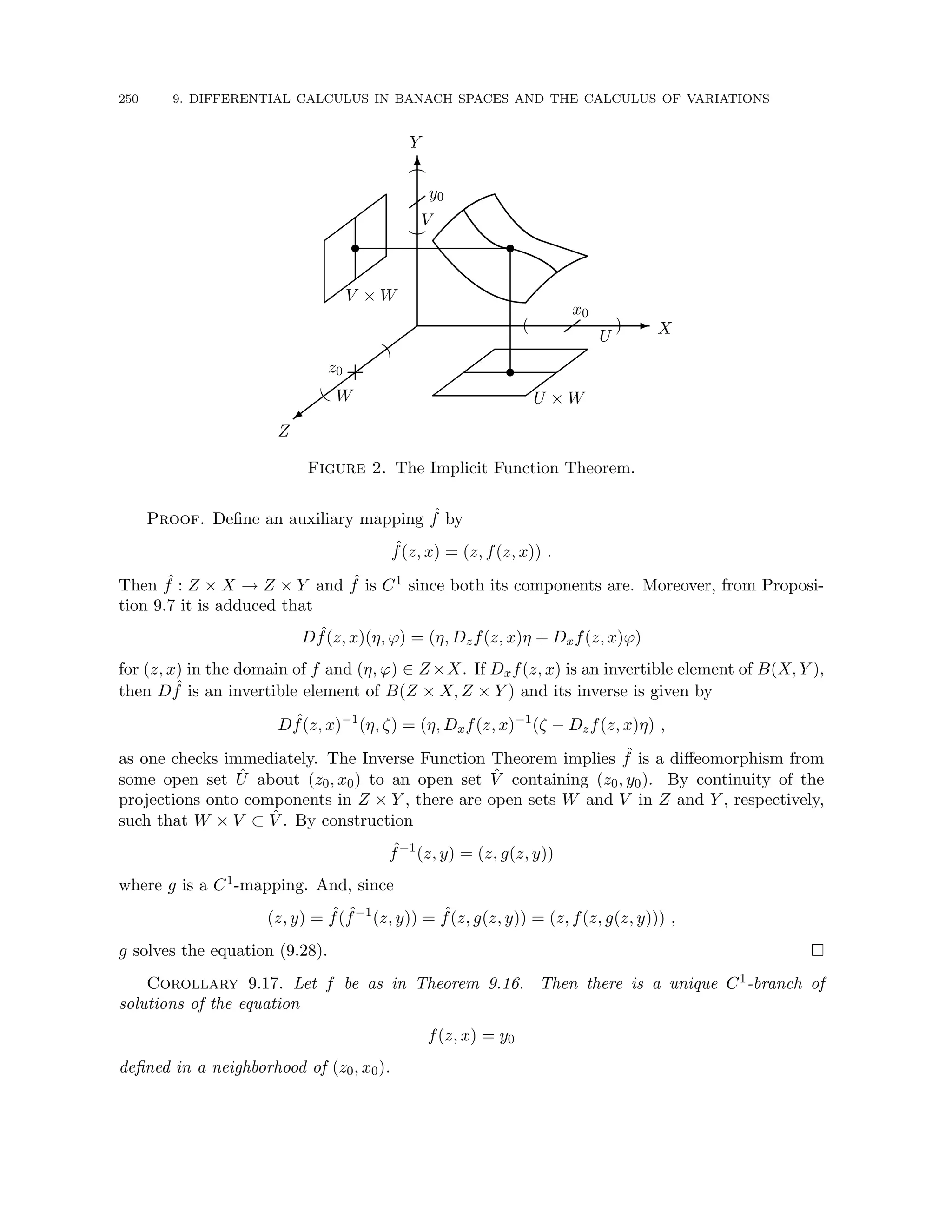
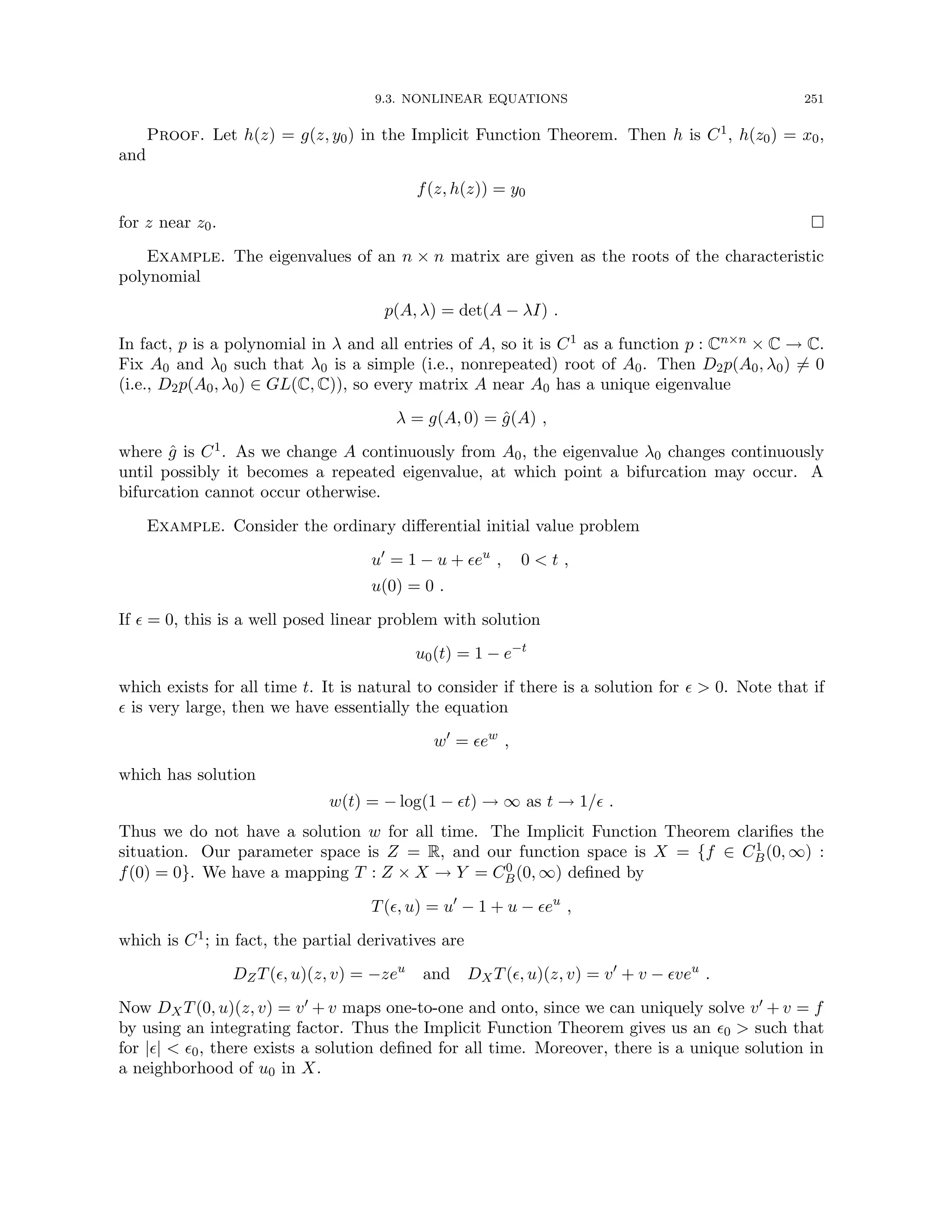
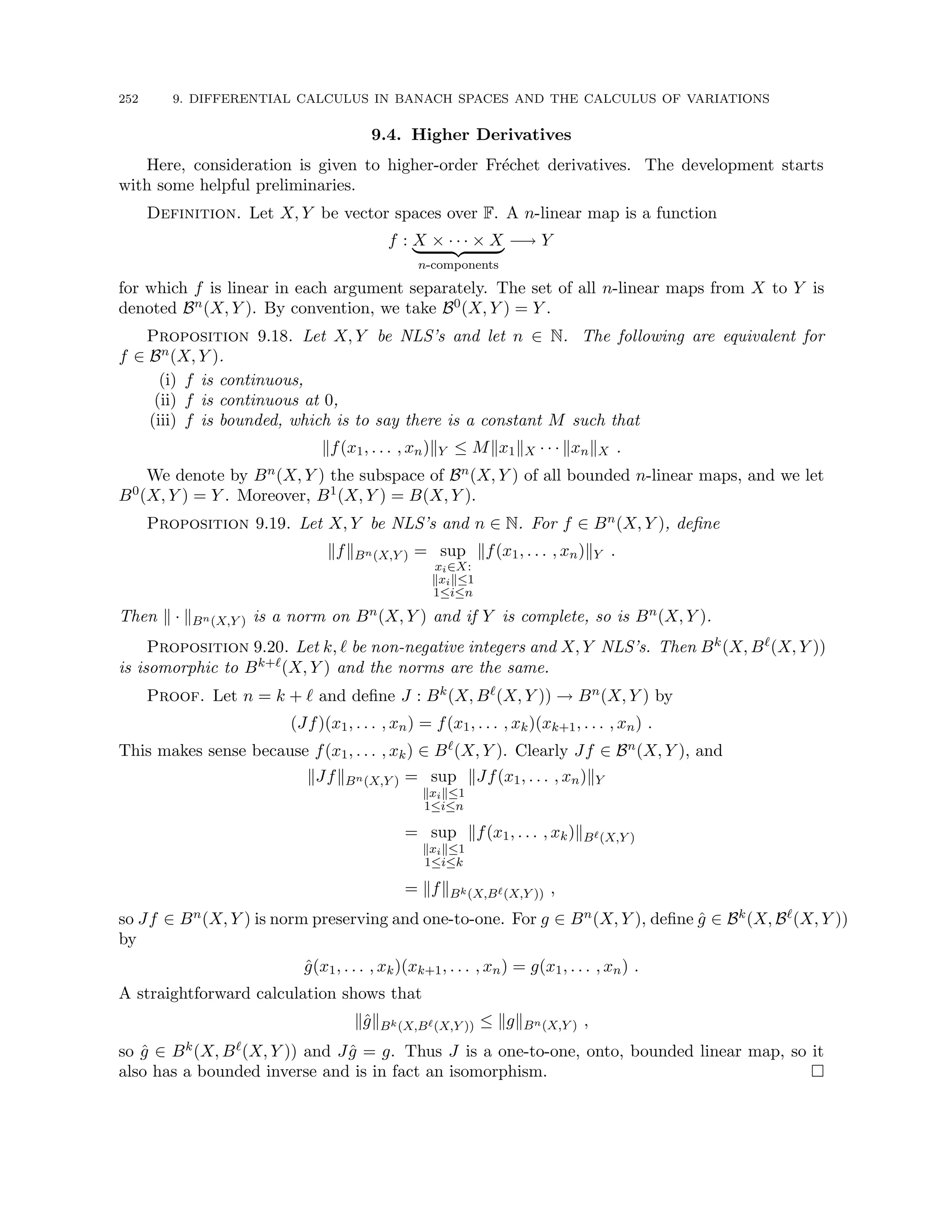
![9.4. HIGHER DERIVATIVES 253
Definition. Let X, Y be Banach spaces and f : X → Y . For n = 2, 3, . . . , define f to be
n-times Fréchet differentiable in a neighborhood of a point x if f is (n − 1)-times differentiable
in a neighborhood of x and the mapping x 7→ Dn−1f(x) is Fréchet differentiable near x. Define
Dn
f(x) = DDn−1
f(x) , n = 2, 3, . . . .
Notice that
f : X → Y ,
Df : X → B(X, Y ) ,
D2
f = D(Df) : X → B(X, B(X, Y )) = B2
(X, Y ) ,
.
.
.
Dn
f = D(Dn−1
f) : X → B(X, Bn−1
(X, Y )) = Bn
(X, Y ) .
We remark that, for n = 2 and f : X → Y , we must find D2f(x) ∈ B2(X, Y ) such that
kDf(x + h) − Df(x) − D2
f(x)(h)kB(X,Y ) = o(khkX) .
This is equivalent to showing
kDf(x + h)k − Df(x)k − D2
f(x)(h, k)kY = o(khkX)kkkX .
A similar remark holds for higher derivatives.
Examples. 1. If A ∈ B(X, Y ), then DA(x) = A for all x. Hence
D2
A(x) ≡ 0 for all x .
This is because
DA(x + h) − DA(x) ≡ 0
for all x.
2. Let X = H be a Hilbert space, F = R, and A ∈ B(H, H). Define f : H → R by
f(x) = (x, Ax)H .
Then, Df(x) = R((A+A∗)x), where R denotes the Riesz map. That is, Df(x) ∈ B(H, R) = H∗,
and for y ∈ H,
Df(x)(y) = (y, A∗
x + Ax)H .
To compute the second derivative, form the difference
[Df(x + h) − Df(x)]y = (y, (A + A∗
)(x + h) − (A + A∗
)x) = (y, (A + A∗
)h) ,
for y ∈ H. Thus it is determined that
D2
f(x)(y, h) = (y, (A + A∗
)h) .
Note that D2f(x) does not depend on x, so D3f(x) ≡ 0.
3. Let K ∈ L∞(I × I) where I = [a, b] ⊂ R. Define F : Lp(I) → Lp(I) by
F(g)(x) =
Z
I
K(x, y)gp
(y) dy
for p ∈ N and x ∈ I. Then, DF(g) ∈ B(Lp(I), Lp(I)) and
DF(g)h = p
Z
I
K(x, y)gp−1
(y)h(y) dy ,](https://image.slidesharecdn.com/appliedmathematicsmethods-230215152718-28efe5ed/75/applied-mathematics-methods-pdf-253-2048.jpg)
![254 9. DIFFERENTIAL CALCULUS IN BANACH SPACES AND THE CALCULUS OF VARIATIONS
since the Binomial Theorem gives the expansion
F(g + h) − F(g) =
Z
I
K(x, y)[(g + h)p
− gp
] dy
=
Z
I
K(x, y)
pgp−1
(y)h(y) +
p
2
gp−2
(y)h2
(y) + · · ·
dy ,
wherein all but the first term is higher-order in h. Thus it follows readily that
DF(g + h)u − DF(g)u = p
Z
I
K(x, y)
(g + h)p−1
u − gp−1
u
dy
= p(p − 1)
Z
I
K(x, y)[gp−2
hu] dy + terms cubic in h, u .
It follows formally, and can be verified under strict hypotheses, that
D2
F(g)(h, k) = p(p − 1)
Z
I
K(x, y)gp−2
(y)h(y)k(y) dy .
Lemma 9.21 (Schwarz). Let X, Y be Banach spaces, U an open subset of X and f : U → Y
have two derivatives. Then D2f(x) is a symmetric bilinear mapping.
Proof. Consider the difference
g(h, k) = f(x + h + k) − f(x + h) − f(x + k) + f(x) − D2
f(x)(k, h) ,
so that
kD2
f(x)(h, k) − D2
f(x)(k, h)kY = kg(h, k) − g(k, h)kY
≤ kg(h, k) − g(0, k)kY + kg(0, k) − g(k, h)kY
= kg(h, k) − g(0, k)kY + kg(0, h) − g(k, h)kY
since g(0, k) = g(0, h) = 0. But the right-hand side of the last equality is bounded above by the
Mean Value Theorem as
kg(h, k) − g(0, k)kY ≤ sup kD1gkB(X,Y )khkX ,
kg(k, h) − g(0, h)kY ≤ sup kD1gkB(X,Y )kkkX .
Differentiate g partially with respect to the first variable h to obtain
D1g(h, k)h̃ = Df(x + h + k)h̃ − Df(x + h)h̃ − D2
f(x)(k, h̃)
= Df(x + h + k)h̃ − Df(x)h̃ − D2
f(x)(h + k, h̃)
− [Df(x + h)h̃ − Df(x)h̃ − D2
f(x)(h, h̃)] .
For khkX, kkkX small, it follows from the definition of the Fréchet derivative of Df that
kD1g(h, k)kB(X,Y ) = o(khkX + kkkX) .
Thus we have established that
kD2
f(x)(h, k) − D2
f(x)(k, h)kY = o(kkkX + khkX) (khkX + kkkX) ,
and it follows from bilinearity that in fact
D2
f(x)(h, k) = D2
f(x)(k, h)
for all h, k ∈ X [replace (h, k) by (h, k) and take → 0].](https://image.slidesharecdn.com/appliedmathematicsmethods-230215152718-28efe5ed/75/applied-mathematics-methods-pdf-254-2048.jpg)
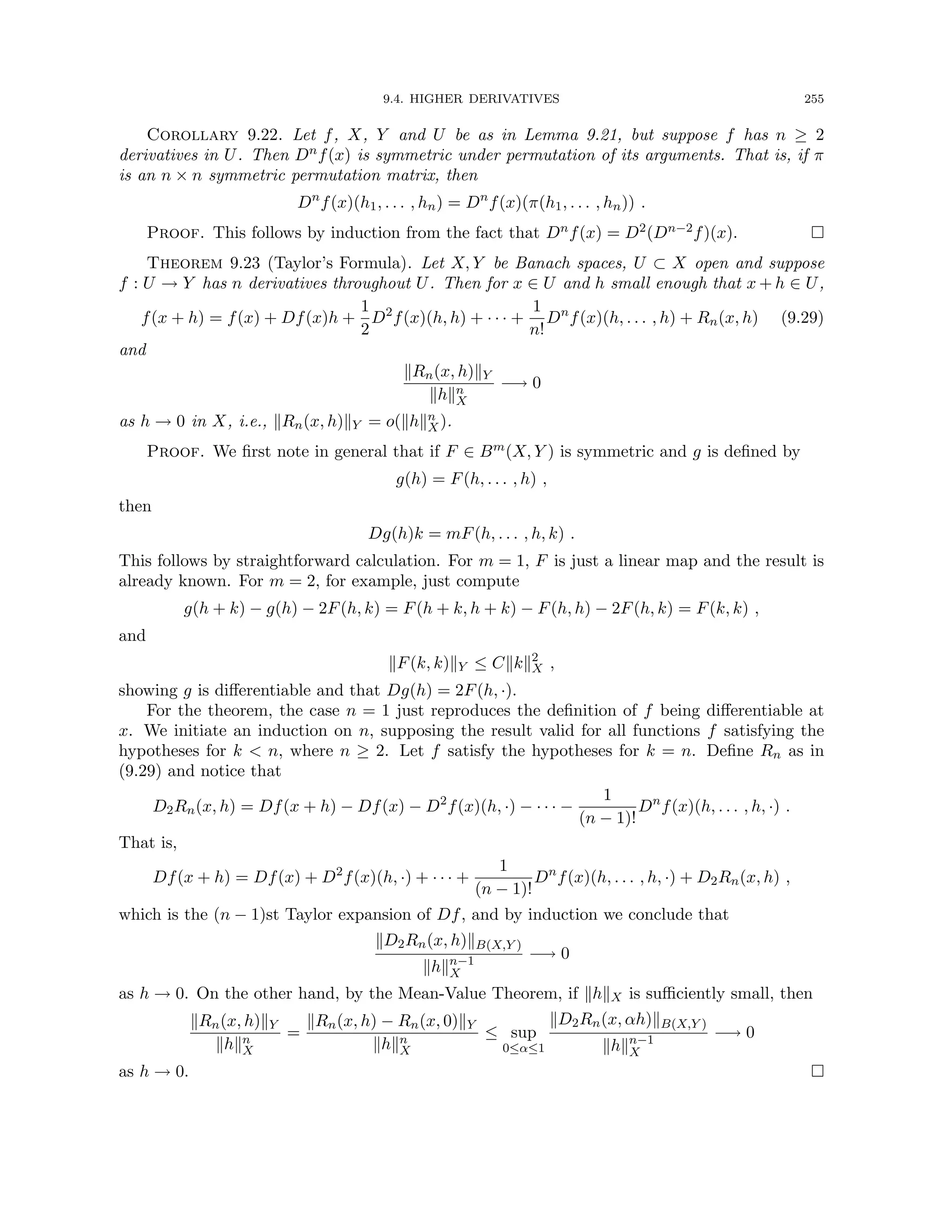
![256 9. DIFFERENTIAL CALCULUS IN BANACH SPACES AND THE CALCULUS OF VARIATIONS
9.5. Extrema
Definition. Let X be a set and f : X → R. A point x0 ∈ X is a minimum if f(x0) ≤ f(x)
for all x ∈ X; it is a maximum if f(x0) ≥ f(x) for all x ∈ X. An extrema is a point which is
a maximum or a minimum. If X has a topology, we say x0 is a relative (or local) minimum if
there is an open set U ⊂ X with x0 ∈ U such that
f(x0) ≤ f(x)
for all x ∈ U. Similarly, if
f(x0) ≥ f(x)
for all x ∈ U, then x0 is a relative maximum. If equality is disallowed above when x 6= x0, the
(relative) minimum or maximum is said to be strict.
Theorem 9.24. Let X be a NLS, let U be an open set in X and let f : U → R be differen-
tiable. If x0 ∈ U is a relative maximum or minimum, then Df(x0) = 0.
Proof. We show the theorem when x0 is a relative minimum; the other case is similar. We
argue by contradiction, so suppose that Df(x0) is not the zero map. Then there is some h 6= 0
such that Df(x0)h 6= 0. By possibly reversing the sign of h, we may assume that Df(x0)h 0.
Let t0 0 be small enough that x0 + th ∈ U for |t| ≤ t0 and consider for such t
1
t
[f(x0 + th) − f(x0)] =
1
t
[Df(x0)(th) + R1(x0, th)]
= Df(x0)h +
1
t
R1(x0, th) .
The quantity R1(x0, th)/t → 0 as t → 0. Hence for t1 ≤ t0 small enough and |t| ≤ t1,
1
t
R1(x0, th) ≤
1
2
|Df(x0)h| .
It follows that for |t| t1,
f(x0 + th) = f(x0) + t
Df(x0)h +
1
t
R1(x0, th)
f(x0) ,
provided we choose t 0. This contradiction proves the result for relative minima. Similar
ruminations establish the conclusion for relative maxima.
Definition. A critical point of a mapping f : U → Y , where U is open in X, is a point x0
where Df(x0) = 0. This is also referred to as a stationary point by some authors.
Corollary 9.25. If f : U → R is differentiable, then the relative extrema of f in U are
critical points of f.
Definition. Let X be a vector space over R, U ⊂ X a convex subset, and f : U → R. We
say that f is convex if whenever x1, x2 ∈ U and λ ∈ (0, 1), then
f(λx1 + (1 − λ)x2) ≤ λf(x1) + (1 − λ)f(x2) .
We say that f is concave if the opposite inequality holds. Moreover, we say that f is strictly
convex or concave if equality is not allowed above.
Proposition 9.26. Linear functionals on X are both convex and concave (but not strictly
so). If a, b 0 and f, g are convex, then af +bg is convex, and if at least one of f or g is strictly
convex, then so is af + bg. Furthermore, f is (strictly) convex if and only if −f is (strictly)
concave.](https://image.slidesharecdn.com/appliedmathematicsmethods-230215152718-28efe5ed/75/applied-mathematics-methods-pdf-256-2048.jpg)
![9.5. EXTREMA 257
We leave the proof as an easy exercise of the definitions.
Proposition 9.27. Let X be a NLS, U a convex subset of X, and f : U → R convex and
differentiable. Then, for x, y ∈ U,
f(y) ≥ f(x) + Df(x)(y − x) ,
and, if Df(x) = 0, then x is a minimum of f in U. Moreover, if f is strictly convex, then for
x 6= y,
f(y) f(x) + Df(x)(y − x) ,
and Df(x) = 0 implies that f has a strict and therefore unique minimum.
Proof. By convexity, for λ ∈ [0, 1],
λf(y) + (1 − λ)f(x) ≥ f(x + λ(y − x)) ,
whence
f(y) − f(x) ≥
f(x + λ(y − x)) − f(x)
λ
.
Take the limit as λ → 0 on the right-hand side to obtain the desired result.
We leave the proof of the strictly convex case to the reader.
Example. Let Ω ⊂ Rd, f ∈ L2(Ω), and assume that the underlying field is real. Define
J : H1
0 (Ω) → R by
J(v) = 1
2k∇vk2
L2(Ω) − (f, v)L2(Ω) .
We claim that k∇vk2
L2(Ω) is strictly convex. To verify this, let v, w ∈ H1
0 (Ω) and λ ∈ (0, 1).
Then
k∇(λv + (1 − λ)w)k2
L2(Ω)
= λ2
k∇vk2
L2(Ω) + (1 − λ)2
k∇wk2
L2(Ω) + 2λ(1 − λ) (∇v, ∇w)L2(Ω)
= λk∇vk2
L2(Ω) + (1 − λ)k∇wk2
L2(Ω) − λ(1 − λ)[k∇vk2
L2(Ω) + k∇wk2
L2(Ω) − 2(∇v, ∇w)L2(Ω)]
= λk∇vk2
L2(Ω) + (1 − λ)k∇wk2
L2(Ω) − λ(1 − λ) (∇(v − w), ∇(v − w))L2(Ω)
λk∇vk2
L2(Ω) + (1 − λ)k∇wk2
L2(Ω) ,
unless v − w is identically constant on each connected component of Ω. As v − w ∈ H1
0 (Ω),
v = w on ∂Ω, and so v = w everywhere. That is, we have strict inequality whenever v 6= w, and
so we conclude that kvk2
L2(Ω) is strictly convex. By Prop. 9.26, we conclude that J(v) is also
strictly convex. Moreover,
DJ(u, v) = (∇u, ∇v)L2(Ω) − (f, v)L2(Ω) .
We conclude that u ∈ H1
0 (Ω) satisfies the boundary value problem
(∇u, ∇v)L2(Ω) = (f, v)L2(Ω)
if and only if u minimizes the “energy functional” J(v) over H1
0 (Ω):
J(u) J(v) for all v ∈ H1
0 (Ω), v 6= u .
Moreover, such a function u is unique.
Local convexity suffices to verify that a critical point is a relative extrema. More generally,
we can examine the second derivative.](https://image.slidesharecdn.com/appliedmathematicsmethods-230215152718-28efe5ed/75/applied-mathematics-methods-pdf-257-2048.jpg)
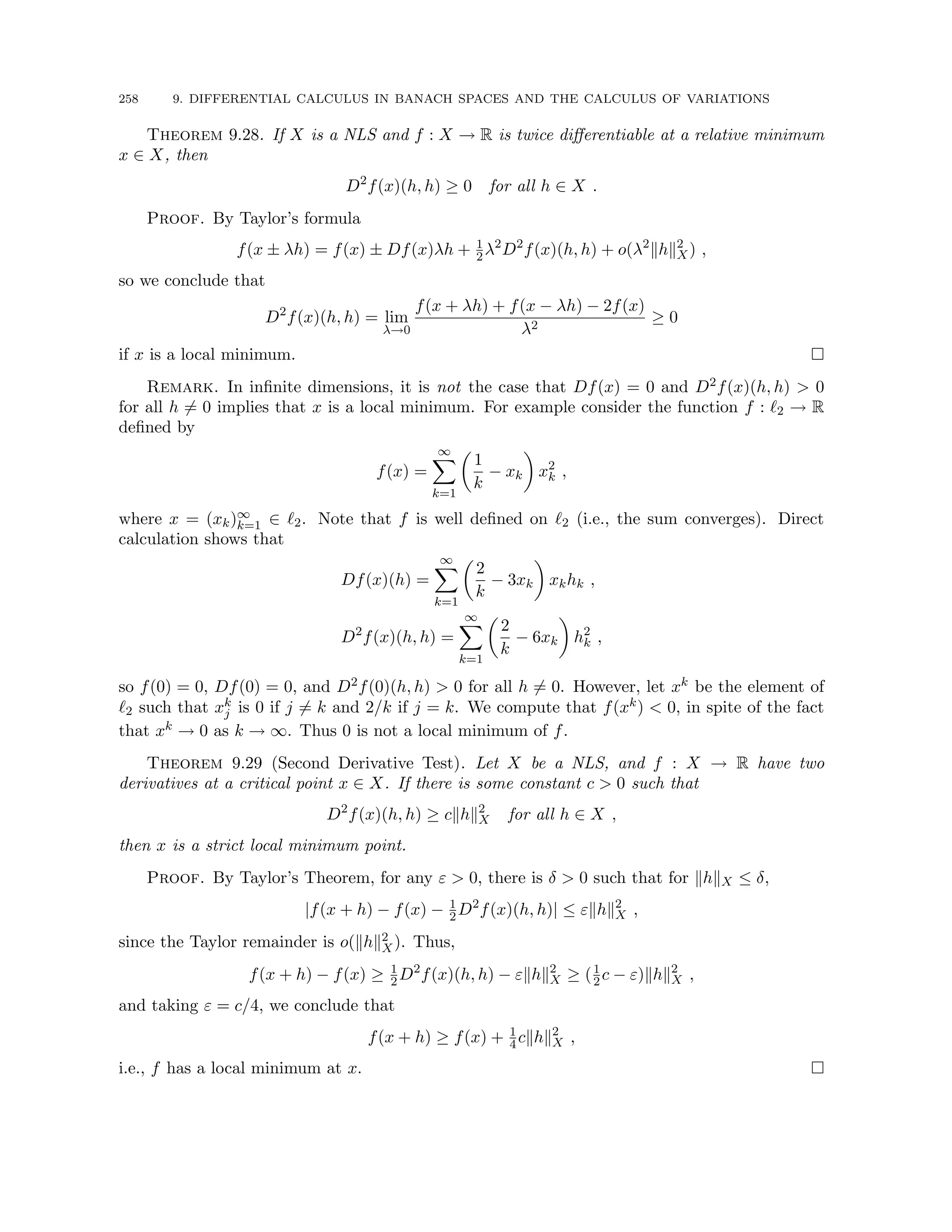
![9.6. THE EULER-LAGRANGE EQUATIONS 259
Remark. This theorem is not as general as it appears. If we define the bilinear form
(h, k)X = D2
f(x)(h, k) ,
we easily verify that, with the assumption of the Second Derivative Test, that in fact (h, k)X is
an inner product, which induces a norm equivalent to the original. Thus in fact X must be a
pre-Hilbert space, and it makes no sense to attempt use of the theorem when X is known not
to be pre-Hilbert.
9.6. The Euler-Lagrange Equations
A common problem in science and engineering applications is to find extrema of a functional
that involves an integral of a function. We will consider this situation via the following problem.
Let a b,
f : [a, b] × Rn
× Rn
→ R
and define the functional F : C1([a, b]) → R by
F(y) =
Z b
a
f(x, y(x), y0
(x)) dx .
With α and β given in Rn, let
C1
α,β([a, b], Rn
) = {v : [a, b] → Rn
| v has a continuous first derivative,
v(a) = α, and v(b) = β} .
Our goal is to find y ∈ C1
α,β([a, b], Rn) such that
F(y) = min
v∈C1
α,β([a,b],Rn)
F(v) .
Example. Find y(x) ∈ C1([a, b]) such that y(a) = α 0 and y(b) = β 0 and the surface
of revolution of the graph of y about the x-axis has minimal area. Recall that a differential of
arc length is given by
ds =
p
1 + (y0(x))2 dx ,
so our area as a function of the curve y is
A(y) =
Z b
a
2πy(x)
p
1 + (y0(x))2 dx , (9.30)
since clearly y(x) ≥ 0 for all x ∈ [a, b].
If α and β are zero, C1
0,0([a, b], Rn) = C1
0 ([a, b], Rn) is a Banach space with the W1,1([a, b])
(Sobolev space) maximum norm, and our minimum is found at a critical point. However, in
general C1
α,β([a, b], Rn) is not a linear vector space. Rather it is an affine space, a translate of a
vector space. To see this, let
`(x) =
1
b − a
[α(b − x) + β(x − a)]
be the linear function connecting (a, α) to (b, β). Then
C1
α,β([a, b], Rn
) = C1
0 ([a, b], Rn
) + ` .
To solve our problem, then, we need to consider any fixed element of C1
α,β, such as `(x), and
all possible “admissible variations” h of it that lie in C1
0 ; that is, we minimize F(v) by searching](https://image.slidesharecdn.com/appliedmathematicsmethods-230215152718-28efe5ed/75/applied-mathematics-methods-pdf-259-2048.jpg)
![260 9. DIFFERENTIAL CALCULUS IN BANACH SPACES AND THE CALCULUS OF VARIATIONS
among all possible “competing functions” v = ` + h ∈ C1
α,β, where h ∈ C1
0 , for the one that
minimizes F(v), if any. On C1
0 , we can find the derivative of F(` + h) as a function of h, and
thereby restrict our search to the critical points. We call such a point y = ` + h a critical point
for F defined on C1
α,β. We present a general result on the derivative of F of the form considered
in this section.
Theorem 9.30. If f ∈ C1([a, b] × Rn × Rn) and
F(y) =
Z b
a
f(x, y(x), y0
(x)) dx ,
then F : C1([a, b]) → R is continuously differentiable and
DF(y)(h) =
Z b
a
[D2f(x, y(x), y0
(x)) h(x) + D3f(x, y(x), y0
(x)) h0
(x)] dx
for all h ∈ C1([a, b]).
Proof. Let A be defined by
Ah =
Z b
a
[D2f(x, y(x), y0
(x)) h(x) + D3f(x, y(x), y0
(x)) h0
(x)] dx ,
which is clearly a bounded linear functional on C1, since the norm of any v ∈ C1 is
kvk = max(kvkL∞ , kv0
kL∞ ) .
Now
F(y + h) − F(y) =
Z b
a
Z 1
0
d
dt
f(x, y + th, y0
+ th0
) dt dx
=
Z b
a
Z 1
0
D2f(x, y + th, y0
+ th0
) h + D3f(x, y + th, y0
+ th0
) h0
dt dx ,
so
|F(y + h) − F(y) − Ah| ≤
Z b
a
Z 1
0
|[D2f(x, y + th, y0
+ th0
) − D2f(x, y, y0
)] h| dt dx
+
Z b
a
Z 1
0
|[D3f(x, y + th, y0
+ th0
) − D3f(x, y, y0
)] h0
| dt dx .
Since D2f and D3f are uniformly continuous on compact sets, the right-hand side is o(khk),
and we conclude that DF(y) = A.
It remains to show that DF(y) is continuous. But this follows from uniform continuity of
D2f and D3f, and from the computation
|DF(y + h)k − DF(y)k| ≤
Z b
a
|[D2f(x, y + h, y0
+ h0
) − D2f(x, y, y0
)] k| dx
+
Z b
a
|[D3f(x, y + h, y0
+ h0
) + D3f(x, y, y0
)] k0
| dx ,
which tends to 0 as khk → 0 for any k ∈ C1([a, b]) with kkk ≤ 1.](https://image.slidesharecdn.com/appliedmathematicsmethods-230215152718-28efe5ed/75/applied-mathematics-methods-pdf-260-2048.jpg)
![9.6. THE EULER-LAGRANGE EQUATIONS 261
Theorem 9.31. Suppose f ∈ C1([a, b] × Rn × Rn), y ∈ C1
α,β([a, b]), and
F(y) =
Z b
a
f(x, y(x), y0
(x)) dx .
Then y is a critical point for F if and only if the curve x 7→ D3f(x, y(x), y0(x)) is C1([a, b]) and
y satisfies the Euler-Lagrange Equations
D2f(x, y, y0
) −
d
dx
D3f(x, y, y0
) = 0 .
In component form, the Euler-Lagrange Equations are
∂f
∂yk
=
d
dx
∂f
∂y0
k
, k = 1, ..., n ,
or
fyk
=
d
dx
fy0
k
, k = 1, ..., n .
The converse implication of the Theorem is easily shown from the previous result after
integrating by parts, since h ∈ C1
0 . The direct implication follows easily from the previous result
and the following Lemma, which can be proved by classical methods, but is also trivial to prove
from the Lebesgue Lemma 5.7. We leave the details to the reader.
Lemma 9.32 (Dubois-Reymond). Let ϕ and ψ lie in C0([a, b], Rn). Then
(i)
R b
a ϕ(x) · h0(x) dx = 0 for all h ∈ C1
0 if and only if ϕ is identically constant.
(ii)
R b
a [ϕ(x) · h(x) + ψ(x) · h0(x)] dx = 0 for all h ∈ C1
0 if and only if ψ ∈ C1 and ψ0 = ϕ.
Proof. Both converse implications are trivial after integrating by parts. For the direct
implication of (i), let
ϕ̄ =
1
b − a
Z b
a
ϕ(x) dx ,
and note that then
0 =
Z b
a
ϕ(x) · h0
(x) dx =
Z b
a
(ϕ(x) − ϕ̄) · h0
(x) dx .
Take
h =
Z x
a
(ϕ(s) − ϕ̄) ds ∈ C1
0 ,
so that h0 = ϕ − ϕ̄. We thereby demonstrate that
kϕ − ϕ̄kL2 = 0 ,
and conclude that ϕ = ϕ̄ (almost everywhere, but both functions are continuous, so everywhere).
For the direct implication of (ii), let
Φ =
Z x
a
ϕ(s) ds ,
so that Φ0 = ϕ. Then the hypothesis of (ii) shows that
Z b
a
[Φ − ψ] · h0
dx =
Z b
a
[Φ · h0
(x) + ϕ · h] dx =
Z b
a
d
dx
(Φ · h) dx = 0 ,](https://image.slidesharecdn.com/appliedmathematicsmethods-230215152718-28efe5ed/75/applied-mathematics-methods-pdf-261-2048.jpg)
![262 9. DIFFERENTIAL CALCULUS IN BANACH SPACES AND THE CALCULUS OF VARIATIONS
since h vanishes at a and b. We conclude from (i) that Φ − ψ is constant. Since Φ is C1, so is
ψ, and ψ0 = Φ0 = ϕ.
Definition. Solutions of the Euler-Lagrange equations are called extremals.
Example. We illustrate the theory by finding the shortest path between two points. Suppose
y(x) is a path in C1
α,β([a, b]), which connects (a, α) to (b, β). Then we seek to minimize the length
functional
L(y) =
Z b
a
p
1 + (y0(x))2 dx
over all such y. The integrand is
f(t, y, y0
) =
p
1 + (y0(x))2 ,
so the Euler-Lagrange equations become simply
(D3f)0
= 0 ,
and so we conclude that for some constant c,
y0(x)
p
1 + (y0(x))2
= c .
Thus,
y0
(x) = ±
r
c2
1 − c2
,
if c2 6= 1, and there is no solution otherwise. In any case, y0(x) is constant, so the only critical
paths are lines, and there is a unique such line in C1
α,β([a, b]). Since L(y) is convex, this path is
necessarily a minimum, and we conclude the well-known maxim: the shortest distance between
two points is a straight line.
Example. Many problems have no solutions. For example, consider the problem of min-
imizing the length of the curve y ∈ C1([0, 1]) such that y(0) = y(1) = 0 and y0(0) = 1. The
previous example shows that extremals would have to be lines. But there is no line satisfying
the three boundary conditions, so there are no extremals. Clearly the minimum approaches 1,
but is never attained by a C1-function.
It is generally not easy to solve the Euler-Lagrange equations. They constitute a nonlinear
second order ordinary differential equation for y(x). To see this, suppose that y ∈ C2([a, b]) and
compute
D2f = (D3f)0
= D1D3f + D2D3f y0
+ D2
3f y00
.
We note that D2
3f(x, y, y0) ∈ B2(Rn, R), which is isomorphic to B(Rn, Rn), so, provided D2
3f(x, y, y0)
is invertible,
y00
= (D2
3f)−1
(D2f − D1D3f − D2D3f y0
) .
Definition. If y is an extremal and D2
3f(x, y, y0) is invertible for all x ∈ [a, b], then we call
y a regular extremal.
Proposition 9.33. If f ∈ C2([a, b]×Rn ×Rn) and y ∈ C1([a, b]) is a regular extremal, then
y ∈ C2([a, b]).
In this case, we can reduce the problem to first order.](https://image.slidesharecdn.com/appliedmathematicsmethods-230215152718-28efe5ed/75/applied-mathematics-methods-pdf-262-2048.jpg)
![9.6. THE EULER-LAGRANGE EQUATIONS 263
Theorem 9.34. If f ∈ C2([a, b] × Rn × Rn), f(x, y, z) = f(y, z) only, and y ∈ C1([a, b]) is
a regular extremal, then D3f y0 − f is constant.
Proof. Simply compute
(D3f y0
− f)0
= D3f y00
+ (D3f)0
y0
− f0
= D3f y00
+ D2f y0
− (D2f y0
+ D3f y00
) = 0 ,
using the Euler-Lagrange equation for the extremal.
Example. We reconsider the problem of finding y(x) ∈ C1([a, b]) such that y(a) = α 0
and y(b) = β 0 and the surface of revolution of the graph of y about the x-axis has minimal
area. The area as a function of the curve is given in (9.30), so
f(y, y0
) = 2πy(x)
p
1 + (y0(x))2 .
Note that
D2
3f(y, y0
) =
2πy(x)
(1 + (y0(x))2)3/2
6= 0 ,
unless y(x) = 0. Clearly y(x) 0, so our extremals are regular, and we can use the theorem to
find them. For some constant C,
2πy (y0)2
(1 + (y0)2)1/2
− 2πy(1 + (y0
)2
)1/2
= 2πC ,
which implies that
y0
=
1
C
p
y2 − C2 .
Applying separation of variables, we need to integrate
dy
p
y2 − C2
=
dx
C
,
which, for some constant λ, gives us the solution
y(x) = C cosh(x/C + λ) ,
which is called a catenary. Suppose that a = 0, so that C = α/ cosh λ and
y(b) = β =
α
cosh λ
cosh
cosh λ
α
b + λ
.
That is, we determine C once we have λ, which must solve the above equation. There may or
may not be solutions λ (i.e., there may not be regular extremals). It is a fact, which we will
not prove (see [Sa, pp. 62ff.]), that the minimal area is given either by a regular extremal or
the Goldschmidt solution, which is the piecewise graph that uses straight lines to connect the
points (0, α) to (0, 0), (0, 0) to (b, 0), and finally (b, 0) to (b, β). This is not a C1 curve, so it is
technically inadmissible, but it has area AG = π(α2 +β2). If there are no extremals, then, given
0, we have C1 curves approximating the Goldschmidt solution such that the area is greater
than but within of AG.
Example (The Brachistochrone problem with a free end). Sometimes one does not impose
a condition at one end. An example is the Brachistochrone problem. Consider a particle moving
under the influence of gravity in the xy-plane, where y points upwards. We assume that the
particle starts from rest at the position (0, 0) and slides frictionlessly along a curve y(x), moving](https://image.slidesharecdn.com/appliedmathematicsmethods-230215152718-28efe5ed/75/applied-mathematics-methods-pdf-263-2048.jpg)
![264 9. DIFFERENTIAL CALCULUS IN BANACH SPACES AND THE CALCULUS OF VARIATIONS
t
b
t
β
S
S
S
S
S
S
S
S
S
θ
dx
dy
ds
Figure 3. The Brachistochrone problem.
in the x-direction a distance b 0 and falling an unspecified distance (see Fig. 3). We wish to
minimize the total travel time. Let the final position be (b, β), where β 0 is unspecified. We
assume that the curve y ∈ C1
∗ ([0, b]), where
C1
∗ ([a, b]) = {v ∈ C1
([a, b]) : v(a) = 0} .
The steeper the curve, the faster it will move; however, it must convert some of this speed into
motion in the x-direction to travel distance b. To derive the travel time functional T(y), we
note that Newton’s Law implies that for a mass m traveling on the arc s with angle θ from the
downward direction (see Fig. 3),
m
d2s
dt2
= −mg cos θ = −mg
dy
ds
,
where g is the gravitational constant. The mass cancels and
1
2
d
dt
ds
dt
2
=
d2s
dt2
ds
dt
= −g
dy
dt
,
so we conclude that for some constant C,
ds
dt
2
= −2gy + C .
But at t = 0, both the speed and y(0) are zero, so C = 0, and
ds
dt
=
p
−2gy .
Now the travel time is given by
T(y) =
Z
dt =
Z
ds
√
−2gy
=
Z b
0
s
1 + (y0(x))2
−2gy(x)
dx .
We need a general result to deal with the free end.
Theorem 9.35. If y ∈ C2([a, b]) minimizes
F(y) =
Z b
a
f(x, y(x), y0
(x)) dx
subject only to the single constraint that y(a) = α ∈ R, then y must satisfy the Euler Lagrange
equations and D3f(b, y(b), y0(b)) = 0.](https://image.slidesharecdn.com/appliedmathematicsmethods-230215152718-28efe5ed/75/applied-mathematics-methods-pdf-264-2048.jpg)
![9.7. CONSTRAINED EXTREMA AND LAGRANGE MULTIPLIERS 265
Proof. We simply compute for y ∈ C1
∗ ([a, b]) + α and h ∈ C1
∗ ([a, b])
DF(y) h =
Z b
a
(D2f h + D3f h0
) dx =
Z b
a
(D2f h − (D3f)0
h) dx + D3f(b, y(b), y0
(b)) h(b) .
If h ∈ C1
0,0([a, b]), we derive the Euler-Lagrange equations, and otherwise we obtain the second
condition at x = b.
Example (The Brachistochrone problem with a free end, continued). Since we are looking
for a minimum, we can drop the factor
√
2g and concentrate on
f(y, y0
) =
s
1 + (y0(x))2
−y(x)
.
This is independent of x, so we solve
y0
D3f − f = C1 =
1
√
−y
(y0)2
p
1 + (y0)2
−
p
1 + (y0)2
,
or
Z s
−y
C−2
1 + y
dy = x − C2 .
This is solved using a trigonometric substitution, so we let
y = −C−2
1 sin2
(φ/2) = −(1 − cos φ)/2C2
1 ,
where 0 ≤ φ ≤ π, and then
x = −(φ − sin φ)/2C2
1 + C2 .
Applying the initial condition (φ = 0), we determine that the curve is
(x, y) = C(φ − sin φ, 1 − cos φ)
for some constant C. This is a cycloid. Now C is determined by the auxiliary condition
0 = D3f(y(b), y0
(b)) =
1
p
y(b)
y0(b)
p
1 + (y0(b))2
,
which requires
0 = y0
(b) =
dy
dφ
dx
dφ
−1
=
sin φ(b)
1 − cos φ(b)
.
Thus φ(b) = π (since φ ∈ [0, π]), so C = b/π and the solution is complete.
9.7. Constrained Extrema and Lagrange Multipliers
When discussing the Euler-Lagrange equations, we considered the problem of finding relative
extrema of a nonlinear functional in C1
α,β, which is an affine translate of a Banach space. We can
phrase this differently: we found extrema in the Banach space C1 subject to the linear constraint
that the function agrees with α and β at its endpoints. We consider now the more general
problem of finding relative extrema of a nonlinear functional subject to a possibly nonlinear
constraint.
Let X be a Banach space, U ⊂ X open, and f : U → R. To describe our constraint, we
assume that there are functions gi : X → R for i = 1, ..., m that define the set M ⊂ U by
M = {x ∈ U : gi(x) = 0 for all i} .](https://image.slidesharecdn.com/appliedmathematicsmethods-230215152718-28efe5ed/75/applied-mathematics-methods-pdf-265-2048.jpg)
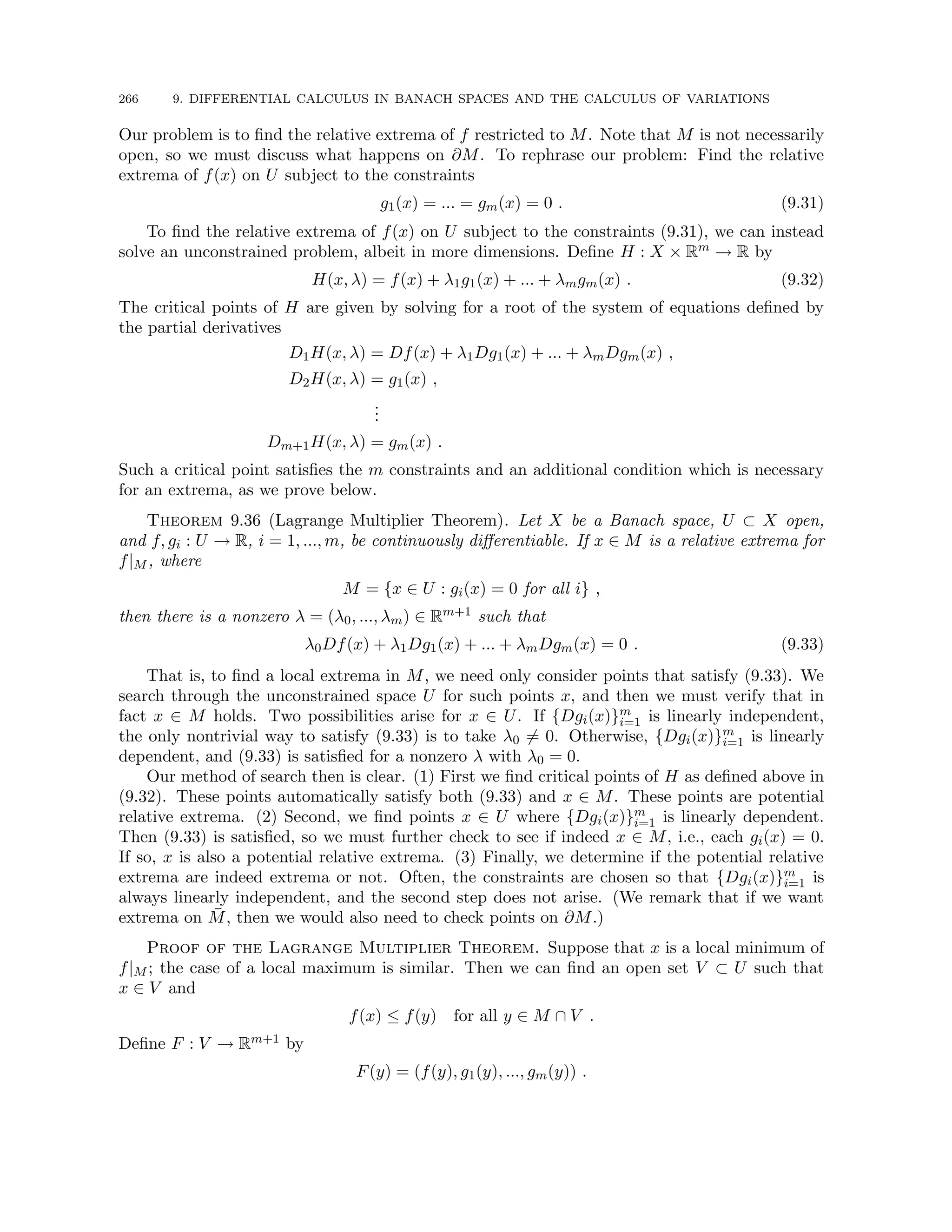
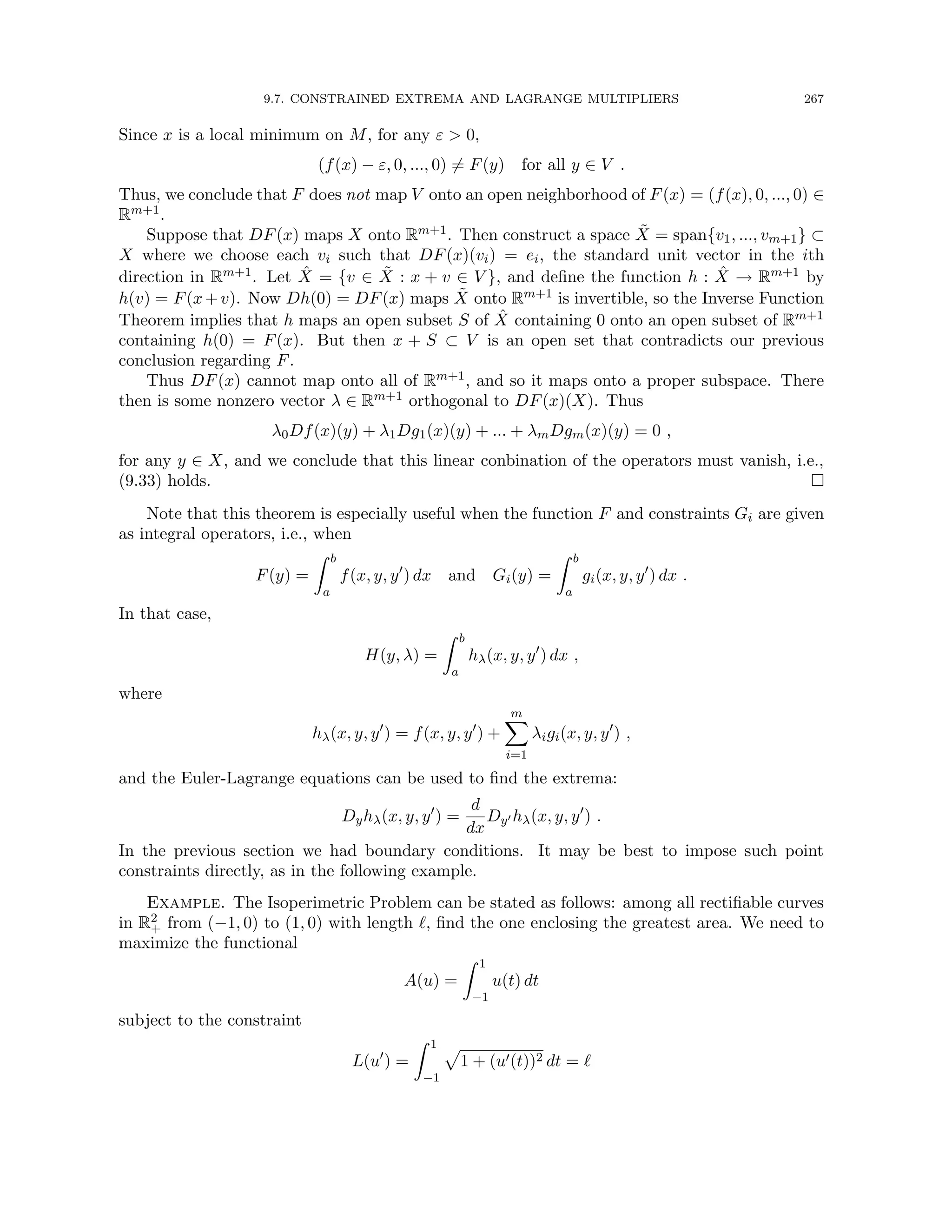
![268 9. DIFFERENTIAL CALCULUS IN BANACH SPACES AND THE CALCULUS OF VARIATIONS
over the set u ∈ C1
0,0([−1, 1]) with u ≥ 0. Let
H(u, λ) = A(u) + λ[L(u0
) − `] =
Z 1
−1
hλ(u, u0
) dt ,
where
hλ(u, u0
) = u + λ
p
1 + (u0(t))2 − `/2
.
To find a critical point of the system, we need to find both DuH and DλH. For the former, it is
given by considering λ fixed and solving the Euler-Lagrange equations: D2hλ = (D3hλ)0. That
is,
1 = λ
d
dt
u0
p
1 + (u0(t))2
!
,
so for some constant C1,
t = λ
u0
p
1 + (u0(t))2
+ C1 .
Solving for u0 yields
u0
(t) =
t − C1
p
λ2 − (t − C1)2
.
Another integration gives a constant C2 and
u(t) =
p
λ2 − (t − C1)2 + C2 ,
or, rearranging, we obtain the equation of a circular arc
(u(t) − C2)2
+ (t − C1)2
= λ2
with center (C1, C2) of radius λ. The partial derivative DλH simply recovers the constraint that
the arc length is `, and the requirement that u ∈ C0,0([−1, 1]) says that it must go through the
points u(−1) = (−1, 0) and u(1) = (1, 0). We leave it to the reader to complete the example
by showing that these conditions uniquely determine C1 = 0, C2, and λ =
p
1 + C2
2 , where C2
satisfies the transcendental equation
q
1 + C2
2 =
`
2[π − tan−1(1/C2)]
.
Moreover, the reader may justify that a maximum is obtained at this critical point.
We also need to check the condition DL(u0) = 0. Again the Euler-Lagrange equations allow
us to find these points easily. The result, left to the reader, is that for some constant C of
integration,
u0
=
C
√
1 − C
,
which means that u is a straight line. The fixed ends imply that u ≡ 0, and so we do not satisfy
the length constraint unless ` = 2, a trivial case to analyze.
As a corollary, among curves of fixed lengths, the circle encloses the region of greatest area.](https://image.slidesharecdn.com/appliedmathematicsmethods-230215152718-28efe5ed/75/applied-mathematics-methods-pdf-268-2048.jpg)
![9.8. LOWER SEMI-CONTINUITY AND EXISTENCE OF MINIMA 269
9.8. Lower Semi-Continuity and Existence of Minima
Whether there exists a minimum of a functional is an important question. If a minimum
exists, we can locate it by analyzing critical points. Perhaps the simplest criterion for the
existence of a minimum is to consider convex functionals, as we have done previously. Next
simplest is perhaps to note that a continuous function on a compact set attains its minimum.
However, in an infinite dimensional Banach space X, bounded sets are not compact; that
is, compact sets are very small. This observation suggests that, at least when X is reflexive,
we consider using the weak topology, since then the Banach-Alaoglu Theorem 2.51 implies that
bounded sets are weakly compact. The problem now is that many interesting functionals are
not weakly continuous, such as the norm itself. For the norm, it is easily seen that:
If un
w
* u, then lim inf
n→∞
kunk ≥ kuk ,
with inequality possible. We are lead to consider a weaker notion of continuity.
Definition. Let X be a topological space. A function f : X → (−∞, ∞] is said to be lower
semicontinuous (l.s.c.) if whenever limn→∞ xn = x, then
lim inf
n→∞
f(xn) ≥ f(x) .
Proposition 9.37. Let X be a topological space and f : X → (−∞, ∞]. Then f is lower
semicontinuous if and only if the sets
Aα = {x ∈ X : f(x) ≤ α}
are closed for all α ∈ R.
Proof. Suppose f is l.s.c. Let xn ∈ Aα be such that xn → x ∈ X. Then
f(x) ≤ lim inf
n→∞
f(xn) ≤ α ,
so x ∈ Aα and Aα is closed.
Suppose now each Aα is closed. Then
Ac
α = {x ∈ X : f(x) α}
is open. Let xn → x ∈ X, and suppose that x ∈ Ac
α for some α (i.e., f(x) α). Then there is
some Nα 0 such that for all n ≥ Nα, xn ∈ Ac
α, and so lim infn→∞ f(xn) ≥ α. In other words,
whenever f(x) α, lim infn→∞ f(xn) ≥ α, so we conclude that
lim inf
n→∞
f(xn) ≥ sup{α : f(x) α} = f(x) .
Theorem 9.38. If M is compact and f : M → (−∞, ∞] is lower semicontinuous, then f is
bounded below and takes on its minumum value.
Proof. Let
A = inf
x∈M
f(x) ∈ [−∞, ∞] .
If A = −∞, choose a sequence xn ∈ M such that f(xn) ≤ −n for all n ≥ 1. Since M is compact,
there is x ∈ M such that, for some subsequence, xni → x as i → ∞. But
f(x) ≤ lim inf
i→∞
f(xni ) = −∞ ,
contradicting that f maps into (−∞, ∞]. Thus A −∞, and f is bounded below.](https://image.slidesharecdn.com/appliedmathematicsmethods-230215152718-28efe5ed/75/applied-mathematics-methods-pdf-269-2048.jpg)
![270 9. DIFFERENTIAL CALCULUS IN BANACH SPACES AND THE CALCULUS OF VARIATIONS
Now choose a sequence xn ∈ M such that f(xn) ≤ A + 1/n, and again extract a convergent
subsequence xni → x ∈ M as i → ∞. We compute
A ≤ f(x) ≤ lim inf
i→∞
f(xni ) ≤ lim inf
i→∞
(A + 1/n) = A ,
and we conclude that f(x) = A attains its minimum at x.
The previous results apply to general topological spaces. For reflexive Banach spaces, we
have both the strong (or norm) and weak topologies.
Theorem 9.39. Let M be a weakly closed subspace of a reflexive Banach space X. If f :
M → (−∞, ∞] is weakly lower semicontinuous and, for some α, Aα = {x ∈ X : f(x) ≤ α} is
bounded and nonempty, then f is bounded from below and there is some x0 ∈ M such that
f(x0) = min
x∈M
f(x) .
Proof. By the Banach-Alaoglu Theorem 2.51, Āα is compact, so f|Āα
attains its minimum.
But for x ∈ M Āα, f(x) α ≥ minx∈Āα
f(x), and the theorem follows.
It is important to determine when a function is weakly lower semicontinuous. The following
requirement is left to the reader, and its near converse follows.
Proposition 9.40. If X is a Banach space and f : X → (−∞, ∞] is weakly lower semicon-
tinuous, then f is strongly lower semicontinuous.
Theorem 9.41. Suppose X is a Banach space and f : X → (−∞, ∞]. If V = {x ∈ X :
f(x) ∞} is a subspace of X, and if f is both convex on V and strongly lower semicontinuous,
then f is weakly lower semicontinuous.
Proof. For α ∈ R, let Aα = {x ∈ X : f(x) ≤ α} be as usual. Since f is strongly l.s.c.,
Prop. 9.37 implies that Aα is closed in the strong (i.e., norm) topology. But f being convex on V
implies that Aα is also convex. A strongly closed convex set is weakly closed (see Corollary 2.57),
so we conclude that f is weakly l.s.c.
Lemma 9.42. Let f : C → [0, ∞) be convex, Ω a domain in Rd, and 1 ≤ p ∞. Then
F : Lp(Ω) → [0, ∞], defined by
F(u) =
Z
Ω
f(u(x)) dx ,
is norm and weak l.s.c.
Proof. Since F is convex, it is enough to prove the norm l.s.c. property. Let un → u in
Lp(Ω) and choose a subsequence such that
lim
i→∞
F(uni ) = lim inf
n→∞
F(un)
and uni (x) → u(x) for almost every x ∈ Ω. Then f(uni (x)) → f(u(x)) for a.e. x, since f being
convex is also continuous. Fatou’s lemma finally implies that
F(u) ≤ lim inf
i→∞
F(uni ) = lim inf
n→∞
F(un) .
Corollary 9.43. If Ω is a domain in Rd and 1 ≤ p, q ∞, then the Lq(Ω)-norm is weakly
l.s.c. on Lp(Ω).](https://image.slidesharecdn.com/appliedmathematicsmethods-230215152718-28efe5ed/75/applied-mathematics-methods-pdf-270-2048.jpg)
![9.8. LOWER SEMI-CONTINUITY AND EXISTENCE OF MINIMA 271
We close this section with two examples that illustrate the concepts.
Example. Let f ∈ C∞
0 (Rn) and consider the differential equation
−∆u + u|u| + u = f .
Let us show that there is a solution. Let
F(u) =
Z
Rd
1
2|∇u|2
+ 1
3|u|3
+ 1
2|u|2
− fu
dx ,
which may be +∞ for some u. Now if v ∈ C∞
0 (Rd),
DF(u)(v) =
Z
Rd
∇u · ∇v + |u|uv + uv − fv
dx
=
Z
Rd
− ∆u + u|u| + u − f
v dx
which vanishes if and only if the differential equation is satisfied. Since F is clearly convex, there
will be a solution to the differential equation if F takes on its minimum.
Now
F(u) ≥ 1
2k∇uk2
L2(Rd) − kfkL2(Rd)kukL2(Rd) ≥ 1
4k∇uk2
L2(Rd) − kfk2
L2(Rd) ,
so the set {u ∈ L2(Rd) : F(u) ≤ 1} is bounded by 4(1 + kfk2
L2(Rd)
), and nonempty (since it
contains u ≡ 0). We will complete the proof if we can show that F is l.s.c.
The last term of F is weakly continuous, and the second and third terms are weakly l.s.c.,
since they are norm l.s.c. and the space is convex. For the first term, let un
w
* u in L2. Then
k∇ukL2 = sup
ψ∈(C∞
0 )d, kψkL2 =1
|(ψ, ∇u)L2 |
= sup
ψ∈(C∞
0 )d, kψkL2 =1
|(∇ · ψ, u)L2 |
≤ sup
ψ∈(C∞
0 )d, kψkL2 =1
lim
n→∞
|(∇ · ψ, un)L2 |
= sup
ψ∈(C∞
0 )d, kψkL2 =1
lim
n→∞
|(ψ, ∇un)L2 |
≤ lim inf
n→∞
k∇unkL2
by Cauchy-Schwartz. Thus the first term is l.s.c. as well.
Example (Geodesics). Let M ⊂ Rd be closed and let γ : [0, 1] → M be a rectifiable curve
(i.e., γ is continuous and γ0, as a distribution, is in L1([0, 1]; Rd)). The length of γ is
L(γ) =
Z 1
0
|γ0
(s)| ds .
Theorem 9.44. Suppose M ⊂ Rd be closed. If x, y ∈ M and there is at least one rectifiable
curve γ : [0, 1] → M with γ(0) = x and γ(1) = y, then there exists a rectifiable curve γ̃ : [0, 1] →
M such that γ̃(0) = x, γ̃(1) = y, and
L(γ̃) = inf{L(γ)|γ : [0, 1] → M is rectifiable and γ(0) = x, γ(1) = y} .
Such a minimizing curve is called a geodesic.](https://image.slidesharecdn.com/appliedmathematicsmethods-230215152718-28efe5ed/75/applied-mathematics-methods-pdf-271-2048.jpg)
![272 9. DIFFERENTIAL CALCULUS IN BANACH SPACES AND THE CALCULUS OF VARIATIONS
Note that a geodesic is the shortest path on some manifold M (i.e., surface in Rd) between
two points. One exists provided only that the two points can be joined within M. Note that
a geodesic may not be unique (e.g., consider joining points (−1, 0) and (1, 0) within the unit
circle).
Proof. We would like to use Theorem 9.39; however, L1 is not reflexive. We need two key
ideas to resolve this difficulty. We expect that γ0 is constant along a geodesic, so define
E(γ) =
Z 1
0
|γ0
(s)|2
ds
and let us try to minimize E in L2([0, 1]). This is the first key idea.
Define
Y =
f ∈ L2
([0, 1]; Rd
) : γf (s) ≡ x +
Z s
0
f(t) dt ∈ M for all s ∈ [0, 1] and γf (1) = y
.
These are the derivatives of rectifiable curves from x to y. Since the map f 7→
R s
0 f(t) dt
is a continuous linear functional, Y is weakly closed in L2([0, 1]; Rd). Since γ0
f = f, define
Ẽ : Y → [0, ∞) by
Ẽ(f) = E(γf ) =
Z 1
0
|f(s)|2
ds .
Clearly | · | is convex, so Ẽ is weakly l.s.c. by Lemma 9.42. Let
Aα = {f ∈ Y : Ẽ(f) ≤ α} ,
so that by definition Aα is bounded for any α. If Aα is not empty for some α, then there is a
minimizer f0 of Ẽ, by Theorem 9.39.
Now we need the second key idea. Given any rectifiable γ, define its geodesic reparameteri-
zation γ∗ by
T(s) =
1
L(γ)
Z s
0
|γ0
(t)| dt ∈ [0, 1] and γ∗
(T(s)) = γ(s) ,
which is well defined since T is nondecreasing and T(s) is constant only where γ is also constant.
But
γ0
(s) = γ∗
(T(s))
0
= γ∗0
(T(s)) T0
(s) = γ∗0
(T(s))
|γ0(s)|
L(γ)
,
so
|γ∗0
(s)| = L(γ)
is constant. Moreover, L(γ∗) = L(γ), and so
E(γ∗
) = L(γ∗
)2
.
Now at least one γ exists by hypothesis, so the reparameterized γ∗ has E(γ∗) ∞. Thus,
for some α, Aα is nonempty, and we conclude that we have a minimizer f0 of Ẽ.
Finally, for any rectifiable curve,
E(γ) ≥ L(γ)2
= L(γ∗
)2
= E(γ∗
) .
Thus a curve of minimal energy E must have |γ0| constant. So, for any rectifiable γ = γf (where
f = γ0),
L(γ) = E(γ∗)1/2
= Ẽ(f)1/2
≥ Ẽ(f0)1/2
= E(γf0 )1/2
= L(γf0 ) ,](https://image.slidesharecdn.com/appliedmathematicsmethods-230215152718-28efe5ed/75/applied-mathematics-methods-pdf-272-2048.jpg)
![9.9. EXERCISES 273
and γf0 is our geodesic.
9.9. Exercises
1. Let X, Y1, Y2, and Z be normed linear spaces and P : Y1 × Y2 → Z be a continuous bilinear
map (so P is a “product” between Y1 and Y2).
(a) Show that for yi, ŷi ∈ Yi,
DP(y1, y2)(ŷ1, ŷ2) = P(y1, ŷ2) + P(ŷ1, y2) .
(b) If f : X → Y1 × Y2 is differentiable, show that for h ∈ X,
D(P ◦ f)(x) h = P(Df1(x) h, f2(x)) + P(f1(x), Df2(x) h) .
2. Let X be a real Hilbert space and A1, A2 ∈ B(X, X), and define f(x) = (x, A1x)XA2x.
Show that Df(x) exists for all x ∈ X by finding an explicit expression for it.
3. Let X = C([0, 1]) be the space of bounded continuous functions on [0, 1] and, for u ∈ X,
define F(u)(x) =
Z 1
0
K(x, y) f(u(y)) dy, where K : [0, 1] × [0, 1] → R is continuous and f is
a C1-mapping of R into R. Find the Fréchet derivative DF(u) of F at u ∈ X. Is the map
u 7→ DF(u) continuous?
4. Suppose X and Y are Banach spaces, and f : X → Y is differentiable with derivative
Df(x) ∈ B(X, Y ) being a compact operator for any x ∈ X. Prove that f is also compact.
5. Set up and apply the contraction mapping principle to show that the problem
−uxx + u − u2
= f(x) , x ∈ R ,
has a smooth bounded solution if 0 is small enough, where f(x) ∈ S(R).
6. Use the contraction-mapping theorem to show that the Fredholm Integral Equation
f(x) = ϕ(x) + λ
Z b
a
K(x, y)f(y) dy
has a unique solution f ∈ C([a, b]), provided that λ is sufficiently small, wherein ϕ ∈ C([a, b])
and K ∈ C([a, b] × [a, b]).
7. Suppose that F is defined on a Banach space X, that x0 = F(x0) is a fixed point of F,
DF(x0) exists, and that 1 is not in the spectrum of DF(x0). Prove that x0 is an isolated
fixed point.
8. Consider the first-order differential equation
u0
(t) + u(t) = cos(u(t))
posed as an initial-value problem for t 0 with initial condition
u(0) = u0 .
(a) Use the contraction-mapping theorem to show that there is exactly one solution u cor-
responding to any given u0 ∈ R.
(b) Prove that there is a number ξ such that lim
t→∞
u(t) = ξ for any solution u, independent
of the value of u0.](https://image.slidesharecdn.com/appliedmathematicsmethods-230215152718-28efe5ed/75/applied-mathematics-methods-pdf-273-2048.jpg)
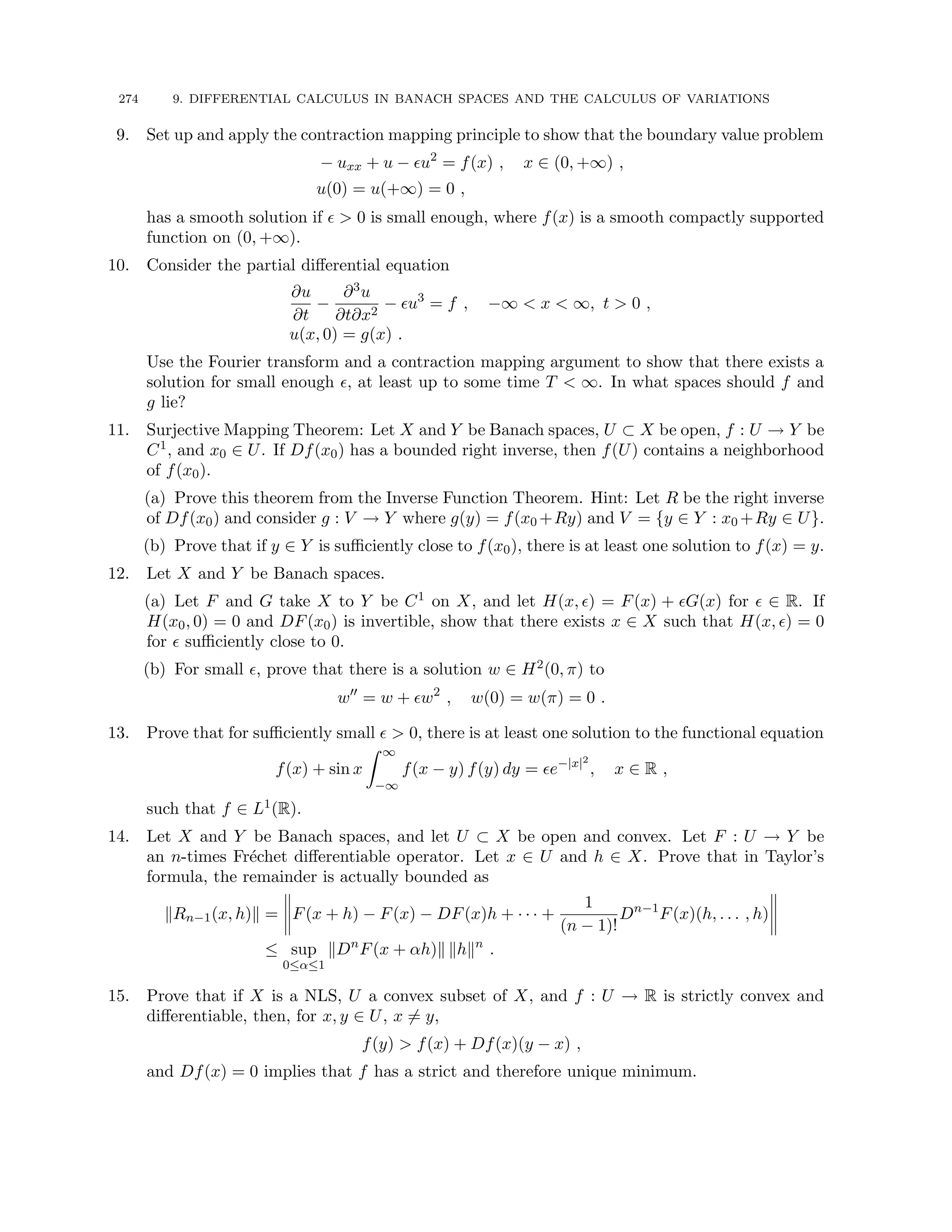
![9.9. EXERCISES 275
16. Let Ω ⊂ Rd have a smooth boundary, and let g(x) be real with g ∈ H1(Ω). Consider the
BVP
− ∆u + u = 0, in Ω ,
u = g, on ∂Ω .
(a) Write this as a variational problem.
(b) Define an appropriate energy functional J(v) and find DJ(v).
(c) Relate the BVP to a constrained minimization of J(v).
17. Let Ω ⊂ Rn have a smooth boundary, A(x) be an n × n real matrix with components in
L∞(Ω), and let c(x), f(x) be real with c ∈ L∞(Ω) and f ∈ L2(Ω). Consider the BVP
− ∇ · A∇u + cu = f, in Ω ,
u = 0, on ∂Ω .
(a) Write this as a variational problem.
(b) Assume that A is symmetric and uniformly positive definite and c is uniformly positive.
Define the energy functional J : H1
0 → R by J(v) =
1
2
Z
Ω
|A1/2
∇v|2
+ c|v|2
− 2fv dx. Find
DJ(v).
(c) Prove that for u ∈ H1
0 , the following are equivalent: (i) u is the solution of the BVP; (ii)
DJ(u) = 0; (iii) u minimizes J(v).
18. Suppose we wish to find the surface u(x, y) above the square Q = [−1, 1]2, with u = 0 on
∂Q, that encloses the greatest volume, subject to the constraint that the surface area is fixed
at s 4.
(a) Formulate the problem, and reformulate it incorporating the constraint as a Lagrange
multiplier. [Hint: the surface area is
RR
Q
p
1 + |∇u|2 dx dy.]
(b) Using the definition of the Fréchet derivative, find the conditions for a critical point.
(c) Find a partial differential equation that u must satisfy to be an extremal of this problem.
[Remark: a solution of this differential equation, that also satisfies the area constraint, gives
the solution to our problem.]
19. Let X and Y be Banach spaces, U ⊂ X an open set, and f : U → Y Fréchet differentiable.
Suppose that f is compact, in the sense that for any x ∈ U, if Br(x) ⊂ U, then f(Br(x)) is
precompact in Y . If x0 ∈ U, prove that Df(x0) is a compact linear operator.
20. Let F(u) =
Z 5
−1
[(u0
(x))2
− 1]2
dx.
(a) Find all extremals in C1([−1, 5]) such that u(−1) = 1 and u(5) = 5.
(b) Decide if any extremal from (a) is a minimum of F. Consider u(x) = |x|.
21. Consider the functional
F(y) =
Z 1
0
[(y(x))2
− y(x) y0
(x)] dx,
defined for y ∈ C1([0, 1]).
(a) Find all extremals.](https://image.slidesharecdn.com/appliedmathematicsmethods-230215152718-28efe5ed/75/applied-mathematics-methods-pdf-275-2048.jpg)
![276 9. DIFFERENTIAL CALCULUS IN BANACH SPACES AND THE CALCULUS OF VARIATIONS
(b) If we require y(0) = 0, show by example that there is no minimum.
(c) If we require y(0) = y(1) = 0, show that the extremal is a minimum. Hint: note that
y y0 = (1
2y2)0.
22. Find all extremals of Z π/2
0
y0
(t)
2
+ y(t)
2
+ 2 y(t)
dt
under the condition y(0) = y(π/2) = 0.
23. Suppose that we wish to minimize
F(y) =
Z 1
0
f(x, y(x), y0
(x), y00
(x)) dx
over the set of y(x) ∈ C2([0, 1]) such that y(0) = α, y0(0) = β, y(1) = γ, and y0(1) = δ. That
is, with C2
0 ([0, 1]) = {u ∈ C2([0, 1]) : u(0) = u0(0) = u(1) = u0(1) = 0}, y ∈ C2
0 ([0, 1])+p(x),
where p is the cubic polynomial that matches the boundary conditions.
(a) Find a differential equation, similar to the Euler-Lagrange equation, that must be satis-
fied by the minimum (if it exists).
(b) Apply your equation to find the extremal(s) of
F(y) =
Z 1
0
(y00
(x))2
dx ,
where y(0) = y0(0) = y0(1) = 0 but y(1) = 1, and justify that each extremal is a (possibly
nonstrict) minimum.
24. Prove the theorem: If f and g map R3 to R and have continuous partial derivatives up to
second order, and if u ∈ C2([a, b]), u(a) = α and u(b) = β, minimizes
Z b
a
f(x, u(x), u0
(x)) dx ,
subject to the constraint
Z b
a
g(x, u(x), u0
(x)) dx = 0 ,
then there is a nontrivial linear combination h = µf + λg such that u(x) satisfies the Euler-
Lagrange equation for h.
25. Consider the functional
Φ(x, y, y0
) =
Z b
a
F(x, y(x), y0
(x)) dx .
(a) If F = F(y, y0) only, prove that the Euler-Lagrange equations reduce to
d
dx
(F − y0
Fy0 ) = 0 .
(b) Among all continuous curves y(x) joining the points (0, 1) and (1, cosh(1)), find the one
which generates the minimum area when rotated about the x-axis. Recall that this area is
A = 2π
Z 1
0
y
p
1 + (y0)2 dx .](https://image.slidesharecdn.com/appliedmathematicsmethods-230215152718-28efe5ed/75/applied-mathematics-methods-pdf-276-2048.jpg)
![9.9. EXERCISES 277
Hint:
Z
dt
√
t2 − C2
= ln(t +
p
t2 − C2).
26. Consider the functional
J[x, y] =
Z π/2
0
[(x0
(t))2
+ (y0
(t))2
+ 2x(t)y(t)] dt
and the boundary conditions
x(0) = y(0) = 0 and x(π/2) = y(π/2) = 1 .
(a) Find the Euler-Lagrange equations for the functional.
(b) Find all extremals.
(c) Find a global minimum, if it exists, or show it does not exist.
(d) Find a global maximum, if it exists, or show it does not exist.
27. Consider the problem of finding a C1 curve that minimizes
Z 1
0
(y0
(t))2
dt
subject to the conditions that y(0) = y(1) = 0 and
Z 1
0
(y(t))2
dt = 1 .
(a) Remove the integral constraint by incorporating a Lagrange multiplier, and find the
Euler equations.
(b) Find all extremals to this problem.
(c) Find the solution to the problem.
(d) Use your result to find the best constant C in the inequality
kykL2(0,1) ≤ Cky0
kL2(0,1)
for functions that satisfy y(0) = y(1) = 0.
28. Find the C2 curve y(t) that minimizes the functional
Z 1
0
(y(t))2
+ (y0
(t))2
dt
subject to the endpoint constraints
y(0) = 0 and y(1) = 1
and the constraint Z 1
0
y(t) dt = 0 .
29. Find the form of the curve in the plane (not the curve itself), of minimal length, joining
(0, 0) to (1, 0) such that the area bounded by the curve, the x and y axes, and the line x = 1
has area π/8.
30. Solve the constrained Brachistochrone problem: In a vertical plane, find a C1-curve joining
(0, 0) to (b, β), b and β positive and given, such that if the curve represents a track along
which a particle slides without friction under the influence of a constant gravitational force](https://image.slidesharecdn.com/appliedmathematicsmethods-230215152718-28efe5ed/75/applied-mathematics-methods-pdf-277-2048.jpg)
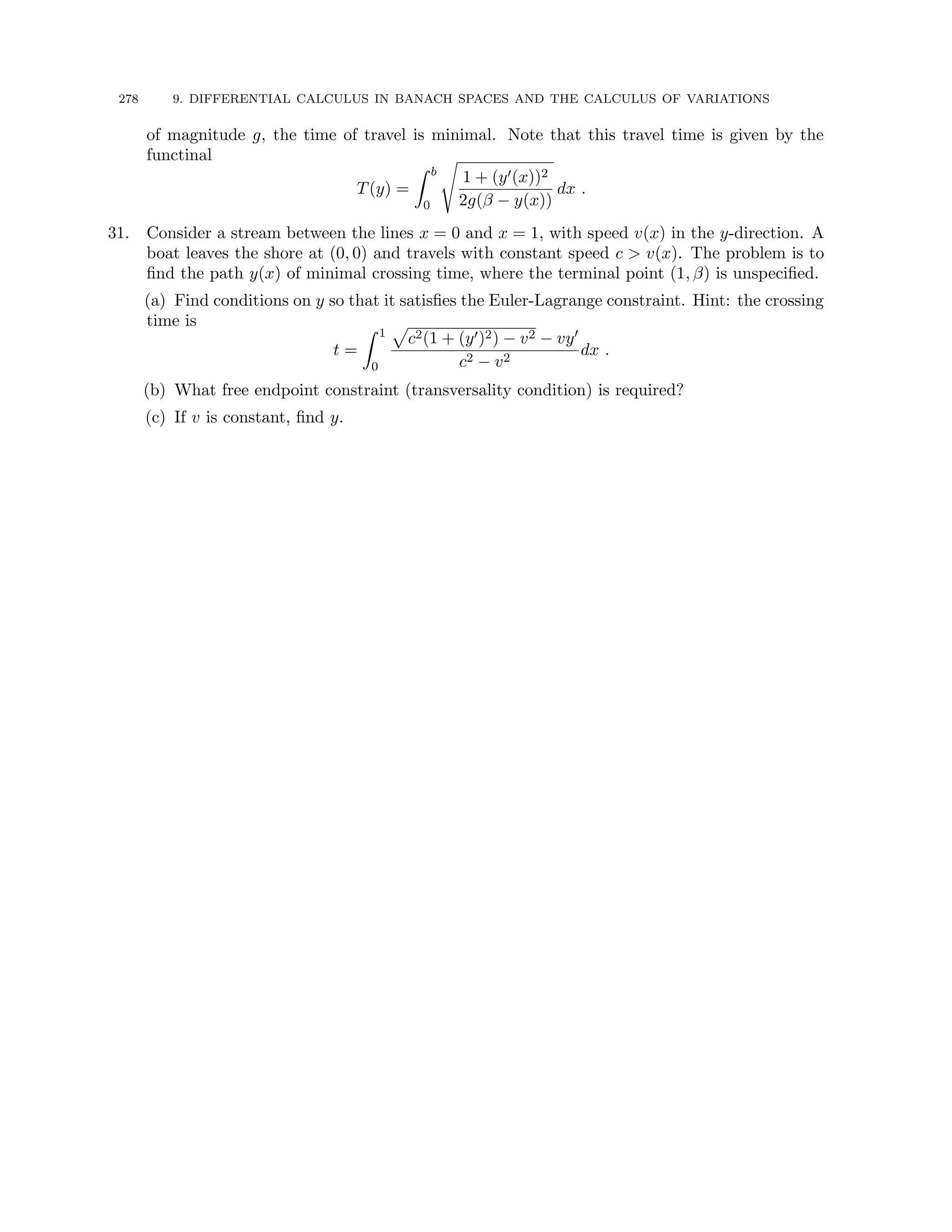
![Bibliography
[Ad] R.A. Adams, Sobolev Spaces, Academic Press, 1975.
[Au] J.-P. Aubin, Applied Functional Analysis, Wiley, 1979.
[Car] C. Carathéodory, Calculus of Variations and Partial Differential Equations of the first Order, 1982.
[Ch] E.W. Cheney, Notes on Applied Mathematics, Department of Mathematics, The University of Texas at
Austin, Austin, TX, 1998.
[DM] L. Debnath P. Mikusiński, Introduction to Hilbert Spaces with Applications, Academic Press, 1990.
[Fo] G.B. Folland, Introduction to Partial Differential Equations, Princeton, 1976.
[GF] I.M. Gelfand S.V. Fomin, Calculus of Variations, Prentice Hall, 1963.
[GT] D. Gilbarg N.S. Trudinger, Elliptic Partial Differential Equations of Second Order, Spring-Verlag,
1983.
[Ho] M.H. Holmes, Introduction to Perturbation Methods, Springer-Verlag, New York, 1995.
[JLJ] J. Jost X. Li-Jost, Calculus of Variations, Cambridge, 1998.
[Ko] H.A. Koch, Notes on Applied Mathematics, Department of Mathematics, The University of Texas at
Austin, Austin, TX, 1998.
[Kr] E. Kreyszig, Introductory Functional Analysis with Applications, Wiley, 1978.
[LL] E.H. Lieb M. Loss, Analysis, AMS, 1977.
[MZ] D. Mitrović and D. Žubrinić, Fundamentals of Applied Functional Analysis, Addison Wesley Longman,
1998.
[OD] J.T. Oden L.F. Demkowicz, Applied Functional Analysis, CRC Press, 1996.
[Ol] F.W.J. Olver, Asymptotics and Special Functions, Academic Press, 1974.
[RS] M. Reed B. Simon, Methods of Modern Physics, Vol. 1, Functional analysis, Academic Press, 1980.
[Roy] H.L. Royden, Real Analysis, 3rd ed., MacMillan Publishing Co., New York, 1988.
[Ru0] W. Rudin, Principles of Mathematical Analysis, 3rd ed., McGraw-Hill, New York, 1976.
[Ru1] W. Rudin, Functional Analysis, McGraw-Hill, New York, 1991.
[Ru2] W. Rudin, Real and Complex Analysis, 3rd Ed., McGraw-Hill, New York, 1987.
[Sa] H. Sagan, Introduction to the Calculus of Variations, Dover, 1969.
[Sho] R.E. Showalter, Hilbert Space Methods for Partial Differential Equations, 1994 (available on the internet
at http://ejde.math.swt.edu/mono-toc.html).
[Si] A.H. Siddiqi, Applied Functional Analysis, Marcel Dekker, New York, 2004.
[St] E. Stein, Singular Integrals and Differentiability Properties of Functions, Princeton University Press,
1970.
[SW] E. Stein G. Weiss, Introduction to Fourier Analysis on Euclidean Spaces, Princeton University Press,
1971.
[Yo] K. Yosida, Functional Analysis, Springer-Verlag, New York, 1980.
279](https://image.slidesharecdn.com/appliedmathematicsmethods-230215152718-28efe5ed/75/applied-mathematics-methods-pdf-279-2048.jpg)